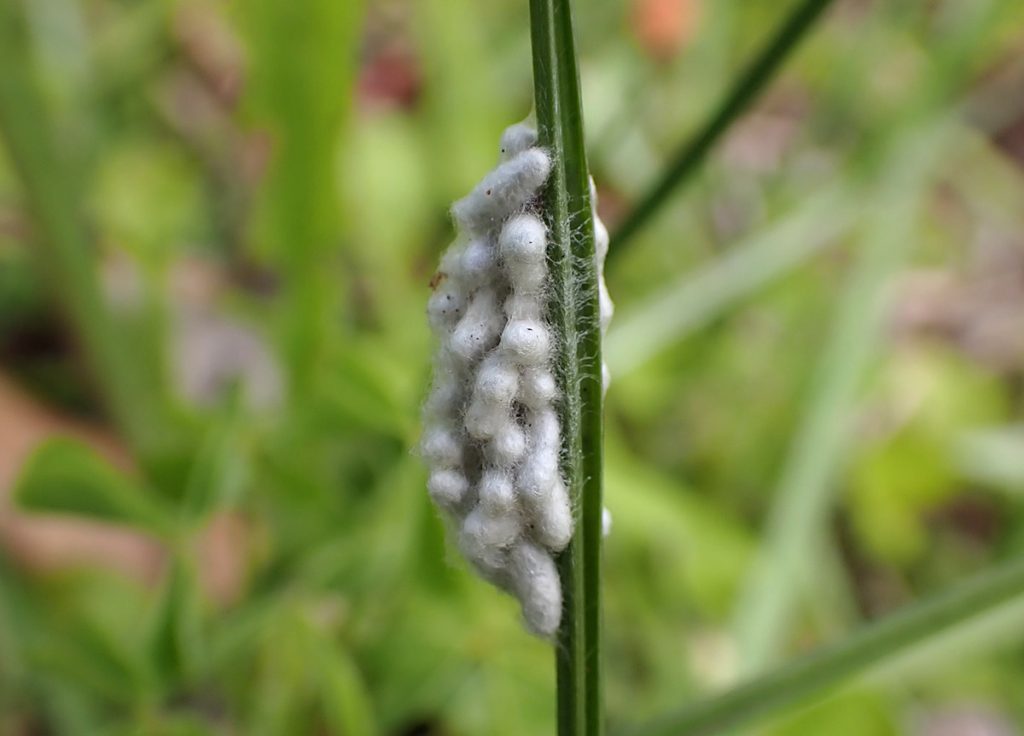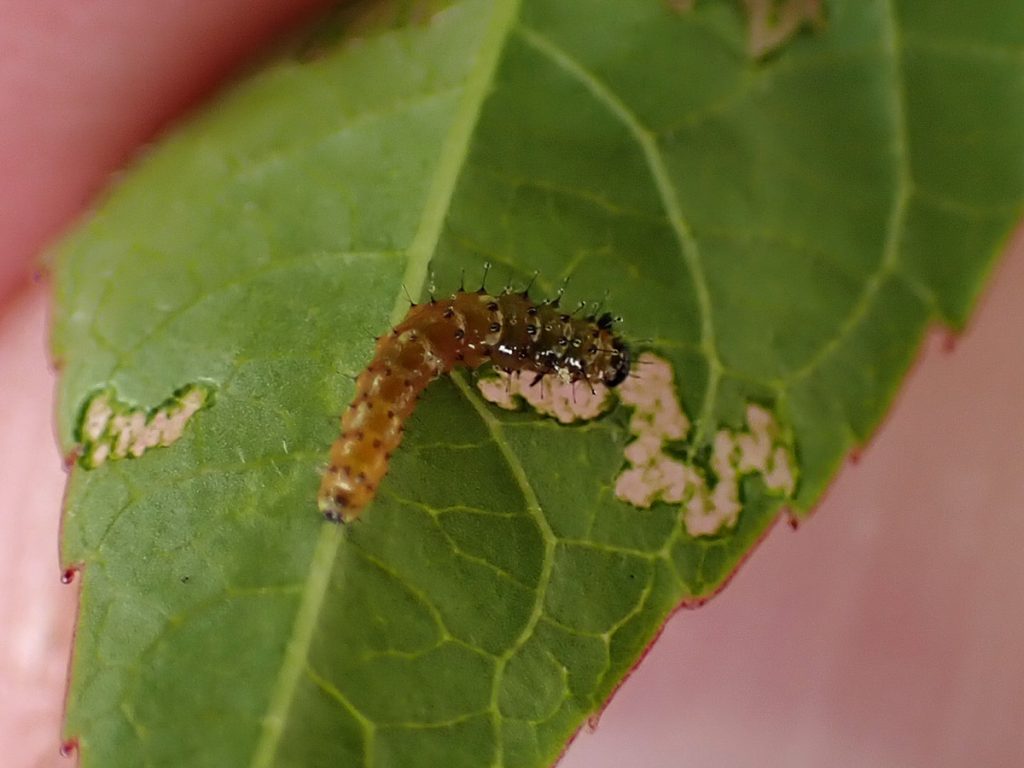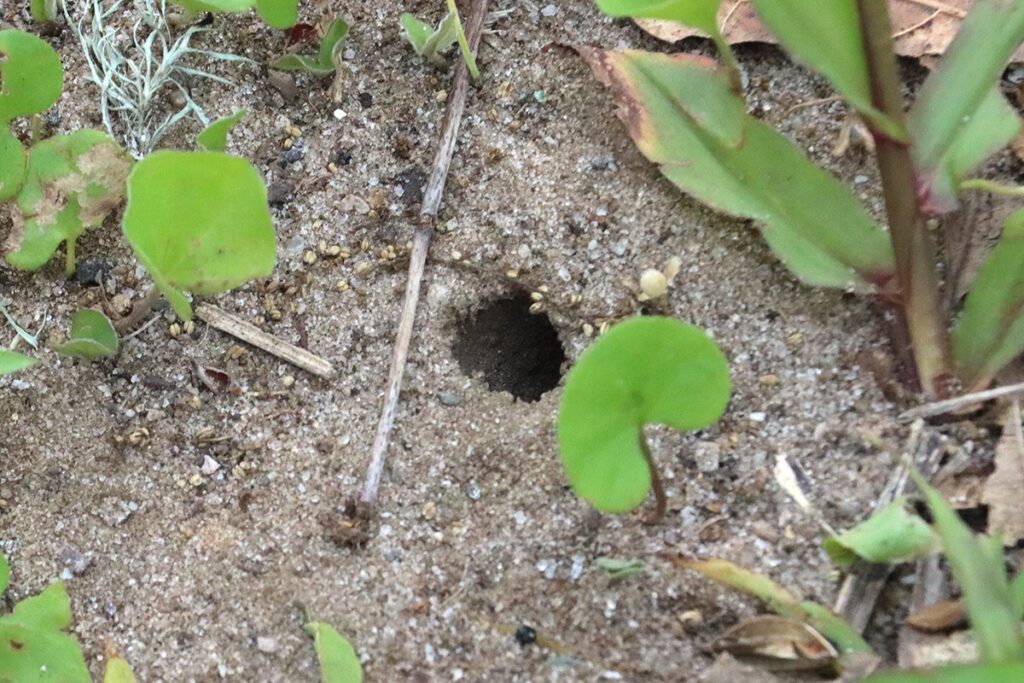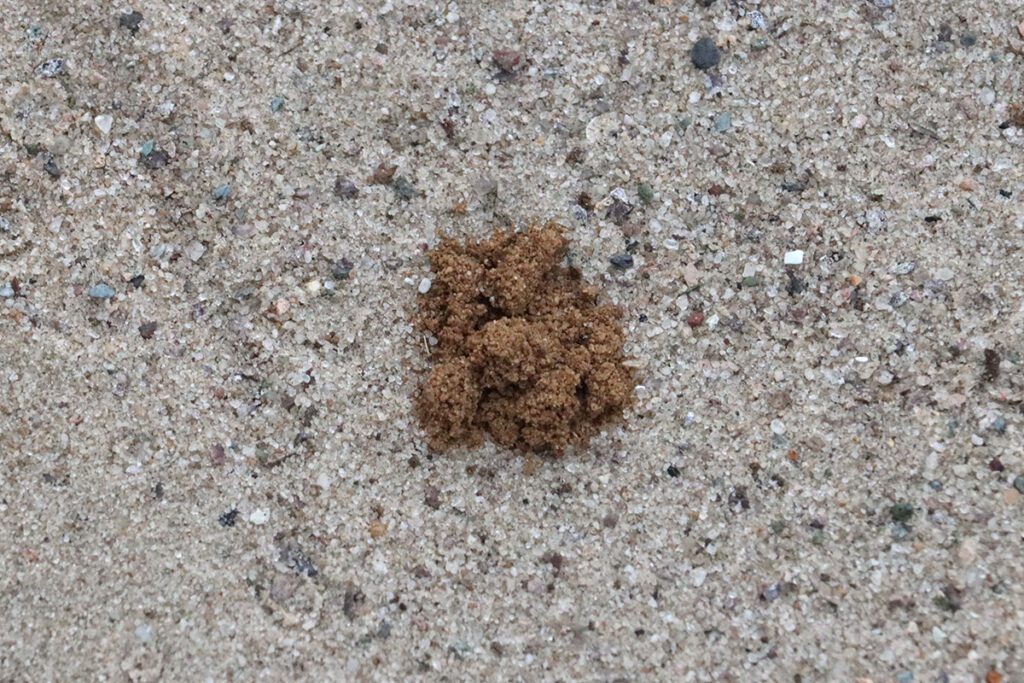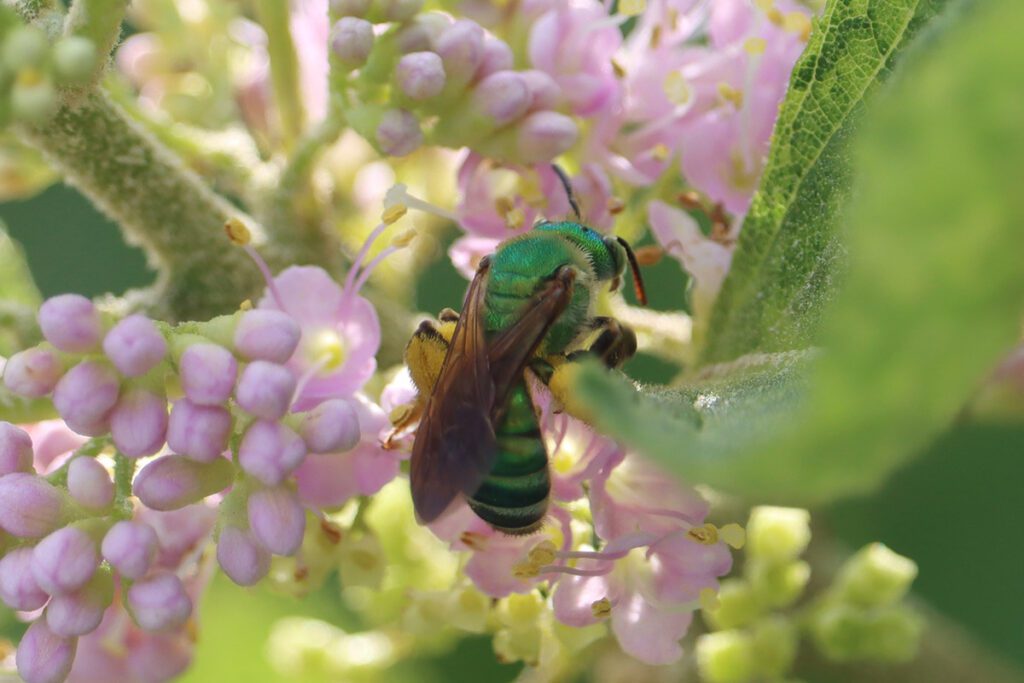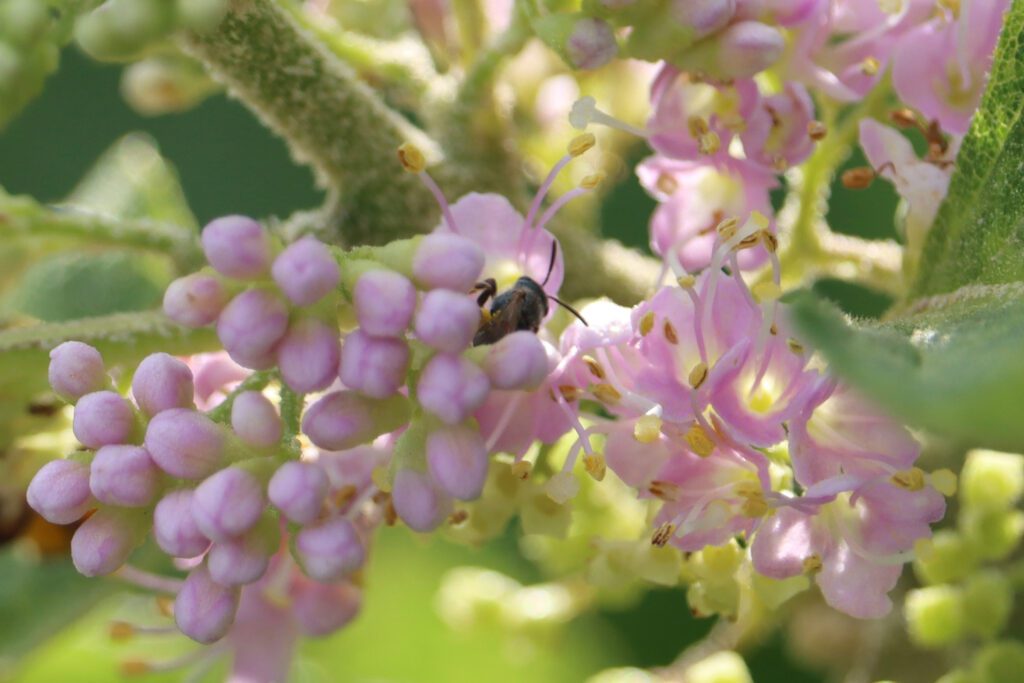Welcome to year six of the Backyard Blog. This is a continuously updated space- until December 31, 2023- where I keep track of insects, plants, birds, and more in my backyard habitat.
When you keep a yard as a habitat, it’s a dynamic space. Changes in plants- whether they’re weeds or planted by you- mean changes in the insects and other animals that inhabit your yard. Little dramas play out- mating, predating, and metamorphosis; everything is trying to survive and make a new generation of themselves. Everything you see crawling on a plant makes ripples in the backyard food web.
And then there’s seasonality. The yard is on a clock, and every plant and animal has its time. Some characters in our drama only have the stage for a week or two, if that.
We begin on a New Year’s Day devoid of human noises.
January 1, 2023
I have trouble sleeping in, even on the one morning when more people are likely to do so.
Not wanting to wake the family by stirring in the house, I went out into a grey morning. I didn’t hear the usual cars driving by, or yard work, or even so much as a dog barking. All I heard was birds.
We live not too far from downtown, and so I relish the quiet that comes from people sleeping off New Years parties. And I sat and listened. Were there more birds out than usual? It’s not the first Jan. 1 where birds have been active here. Either there’s less noise to compete with their songs, or they’re emboldened by having free reign of our yards.
I thought to myself, “this is a good time to use the Merlin app.”
Using Merlin to identify backyard birds
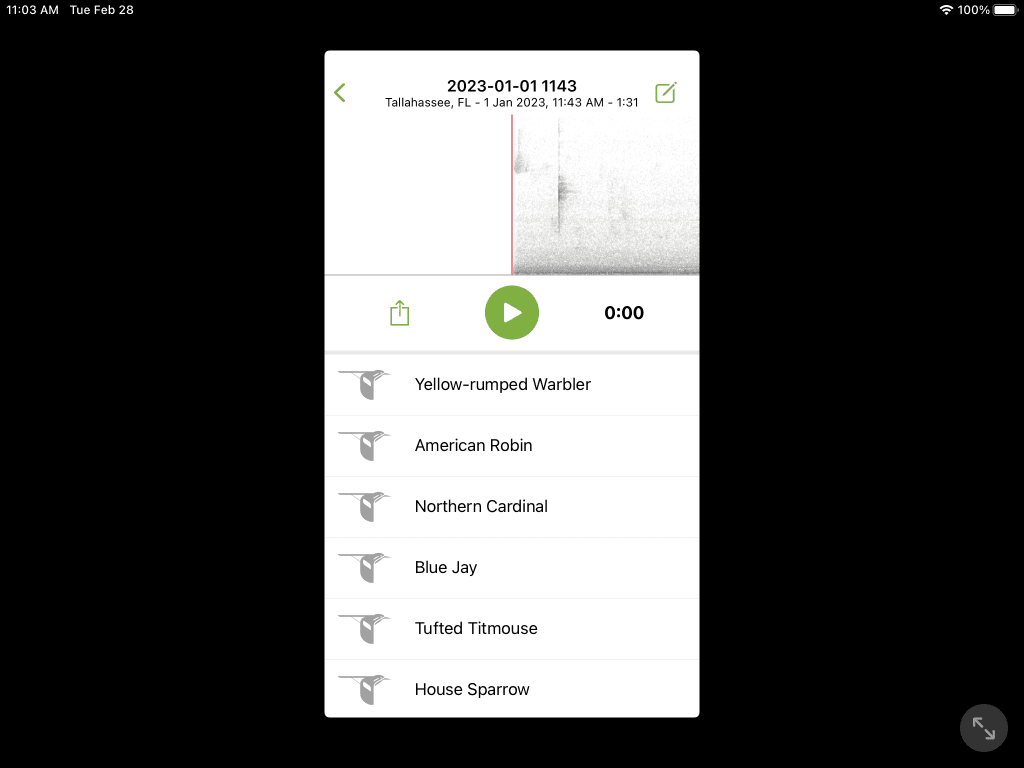
Merlin is a free app from the Cornell Lab of Ornithology. You can upload a photo as you would on iNaturalist, and see a list of possible matches. I’ve never used this function. To me, the Sound ID is both informative and fun to watch.
After you start the recording, Merlin generates a waveform- the image at the top. As it picks out individual bird calls, the species shows up on the list.

The top two on the list are migratory birds here for the winter- Robins and yellow-rumped warblers.
One bird I saw briefly was one I’d not seen in the yard before:

And then this red-bellied woodpecker had found something to eat while dangling from Spanish moss:
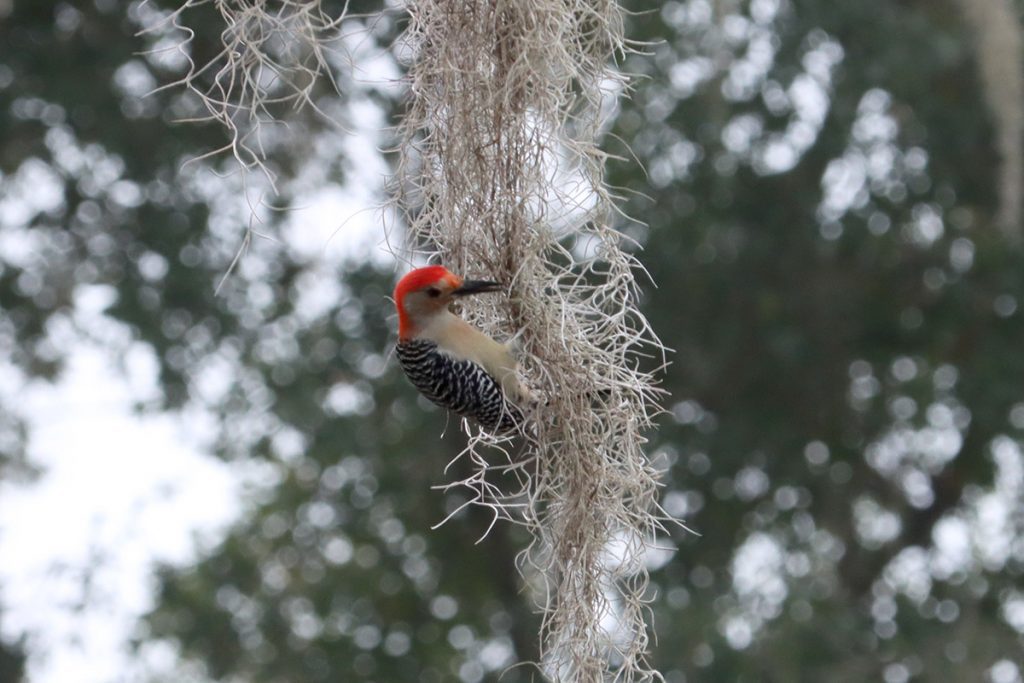
I remembered then the black dahana moth, which visits beebalm and Brickellia in the late summer. Its caterpillars host on Spanish moss. Perhaps its larva or pupa, or some other insect, is overwintering within it.
January 2, 2023
At this time of year, insects and other invertebrates are largely dormant. Some overwinter as adults, but the adults of many species have died. These species overwinter as eggs, larvae, or pupae. Many of these are in fallen leaves, dead wood, or beneath the ground.
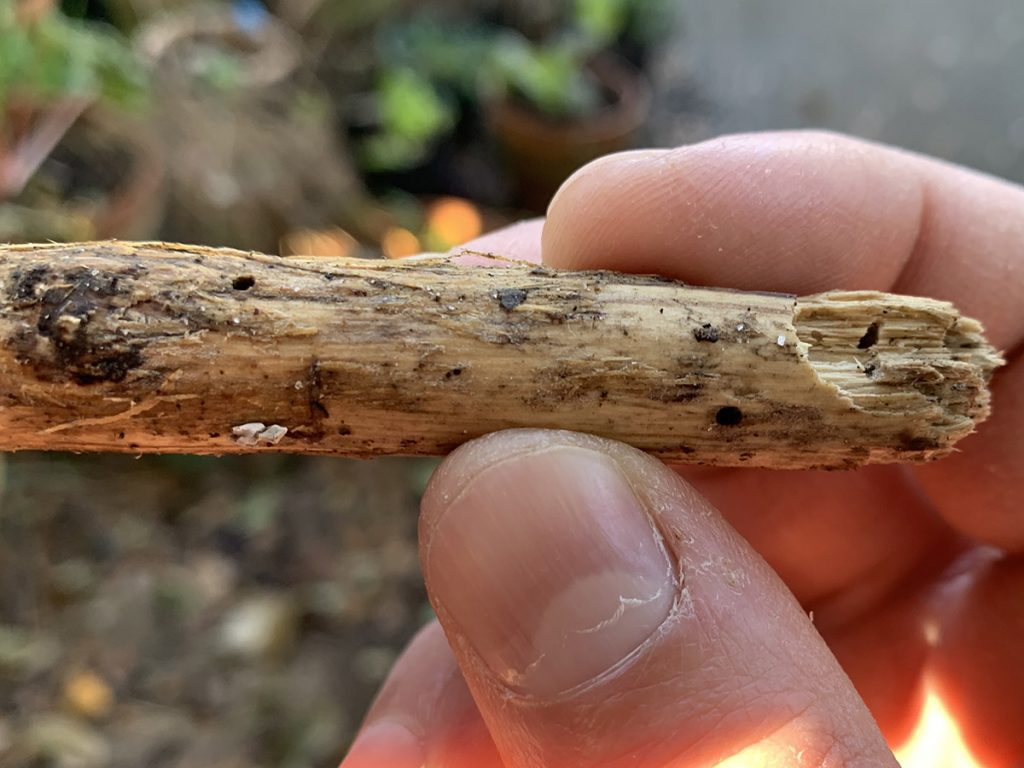
So who are the invertebrates I saw active on January 2? Garden pests.
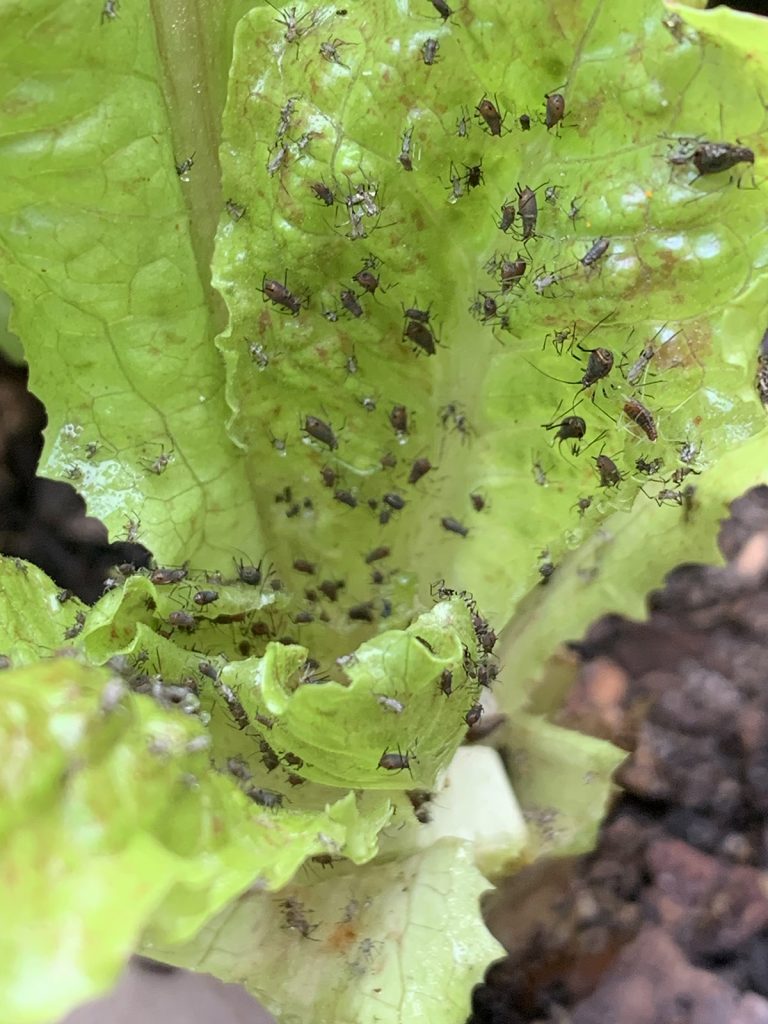
For much of the year, aphids in our yard are kept in check by predatory insects. As fall transitioned to winter, hoverflies were active on flowers as bees began to hunker down. They were also active laying eggs; their larvae are ace aphid predators.
Perhaps that last round of hoverfly larvae fed for a few weeks and made pupae to overwinter, leaving my plants defenseless. If hoverflies and other aphid predators are dormant in January, then it’s an advantage to be active then.

My slug knowledge is minimal, and if anyone chimes in on my iNaturalist ID, I’ll update. Anyhow, slugs are another common pest in our yard. They especially love seedlings, as do:

People love roly-polies. Kids love playing with them, and lately people have extolled their services as detritivores. Basically, they help turn leaves into soil. And they’re crustaceans that live in your garden.
They are also nonnatives, and watch out if you start seeds in raised beds. I’ve learned to clear leaves from around seedlings, as slugs and woodlice shelter there and have an affinity for the young, tender leaves of seedlings.
January 7, 2023
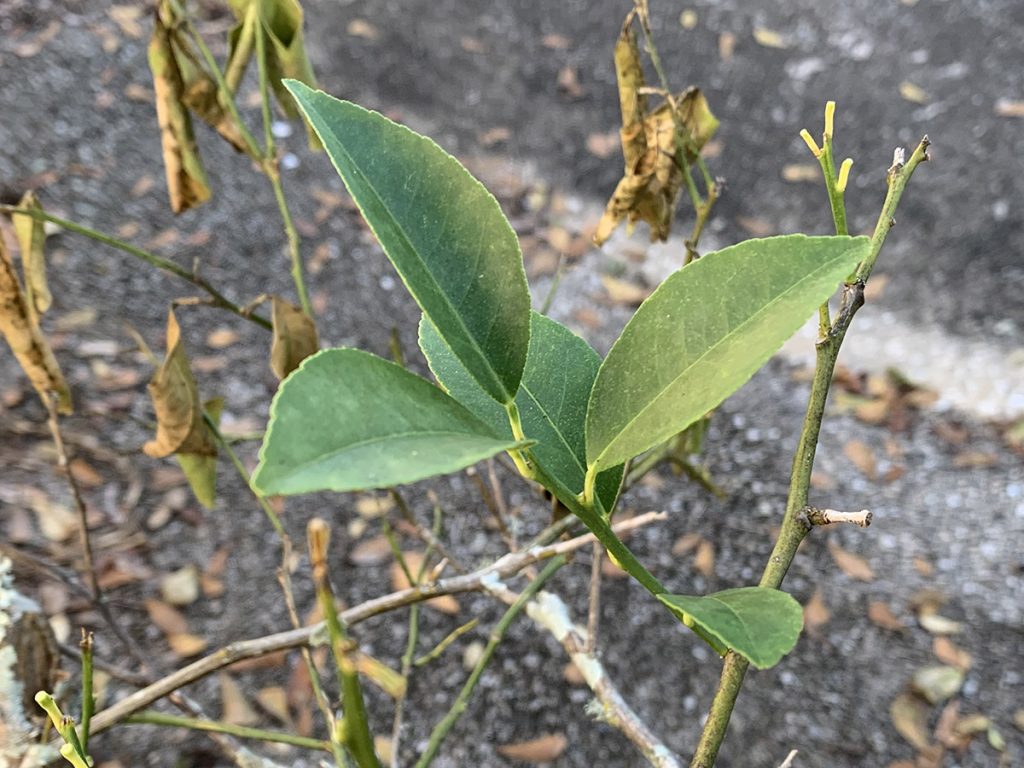
Over the last couple of weeks after our frozen Christmas week, I’d been watching leaves fall from our Meyer lemon tree. Anyone I know who has citrus trees wondered whether those trees survived. These five green leaves were my hope for this small potted tree.
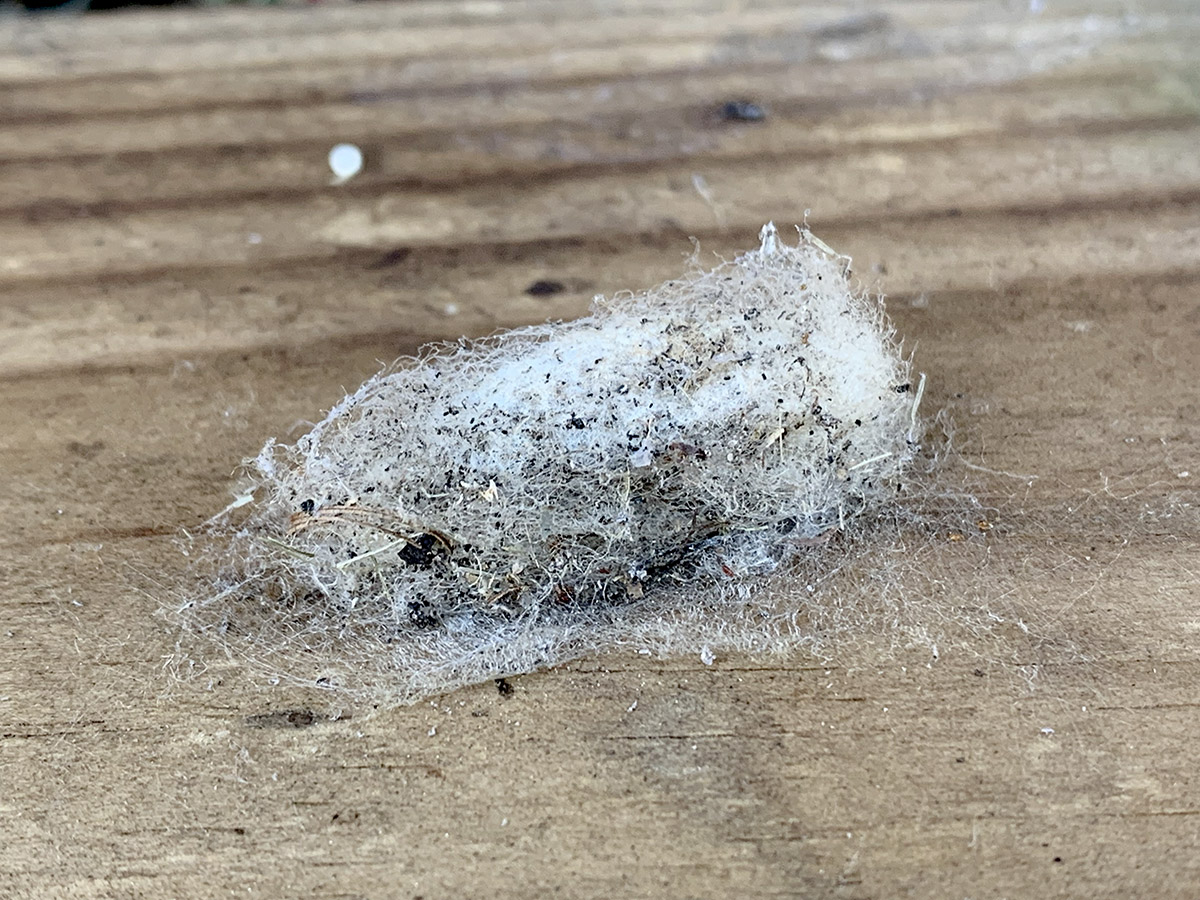
I pulled this board off of our fence, and found this chrysalis wedged between it and another behind it. During the winter months, overwintering insects find all sorts of places to pupate, or leave eggs, or hide as adults or larvae. They often do this in soil or decaying vegetation, but any hard to reach place in your yard may be home to next spring’s creepy crawlies. I kept this board out of the trash pile.
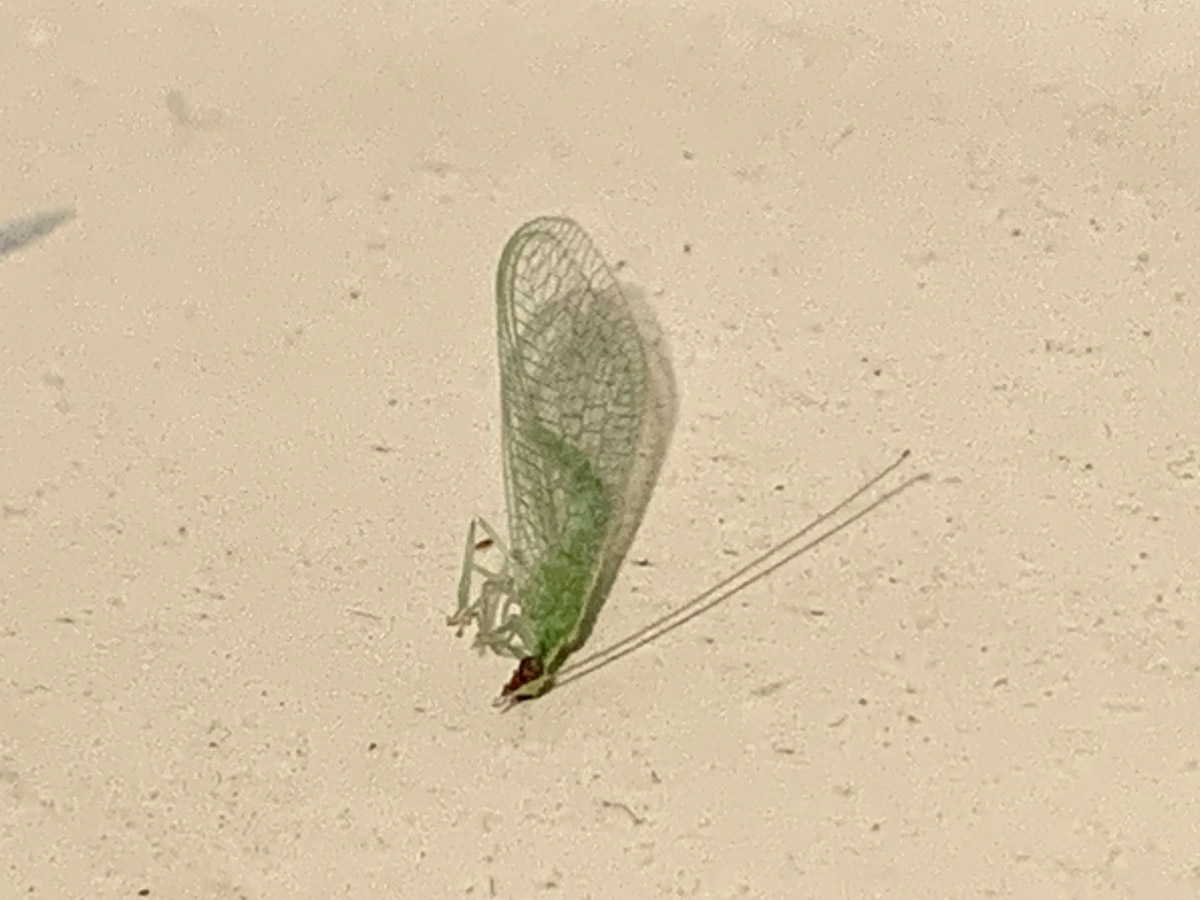
As I was washing dishes that night, I saw this dead insect on the hood over our stove. I had seen lacewing eggs late last summer, but did not see this well camouflaged adult until it came out of the yard and into our kitchen. Its larva is one of the many aphid hunting insects I see in our yard, and there was food for it in our yard.
January 11, 2023
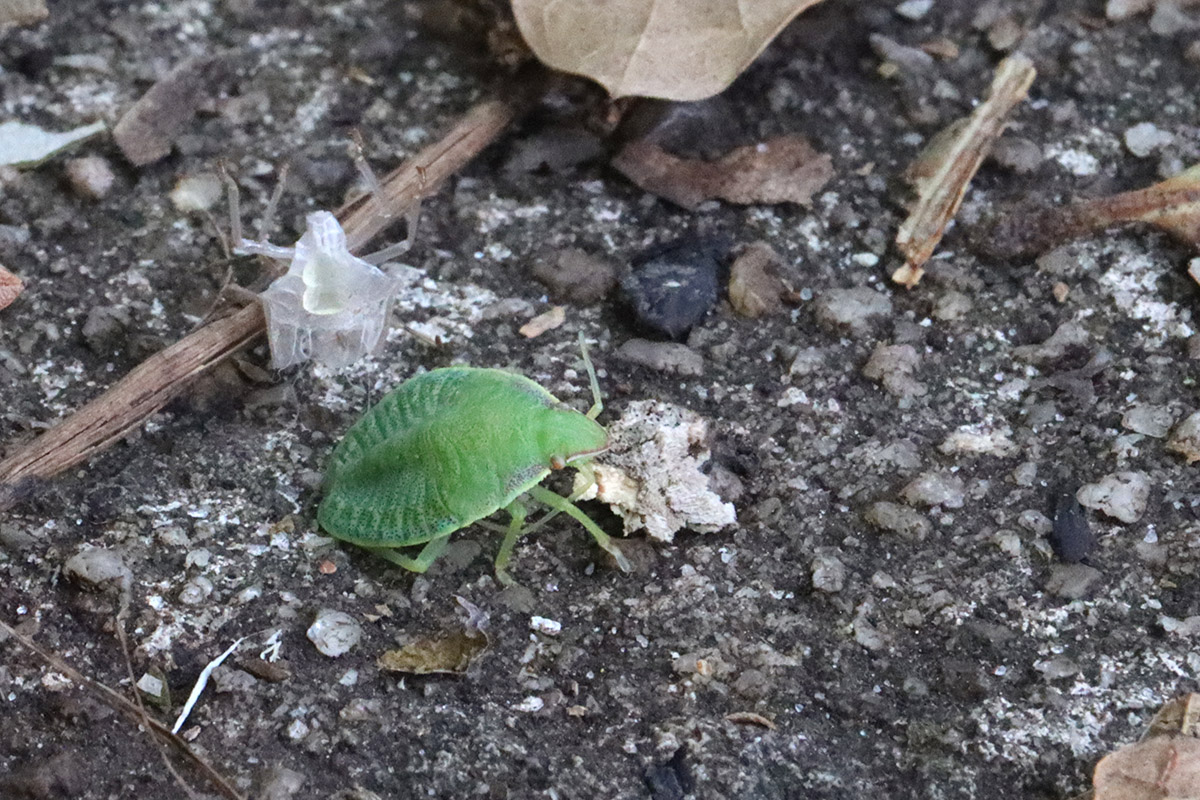
I was raking some leaves off of a paved area of the yard, and I found this little stink bug. After I took the photo, I saw that it had recently molted. It lacks the pointed shoulders of an adult, and its round bottom tells us this is a larva. Like caterpillars, stink bugs have 5 instar phases. I’m not as up on these instar phases as I am those of caterpillars, but this is likely between phase 3-5.
True bugs are some of the insects I see most over the winter. This includes stink bugs, leaf footed bugs, and assassin bugs.
January 12, 2023
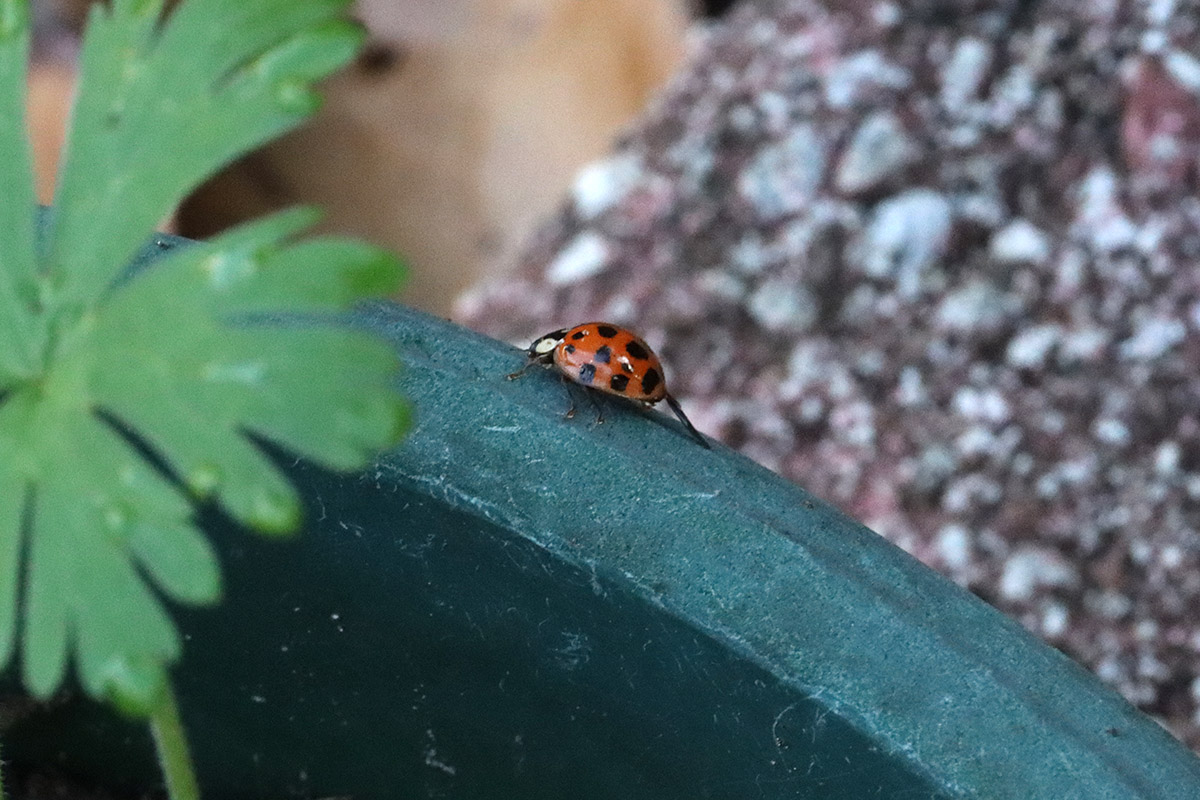
So far in 2023, we’ve seen aphids and at least one aphid predator, the green lacewing. Here’s another predator. It provides a service in that it hunts insects that harm my food plants, but it’s also invasive. They eat native lady beetles and have largely taken over their niche in the garden. I wonder about the effects of the reduced diversity of lady beetle species long term.
January 30, 2023
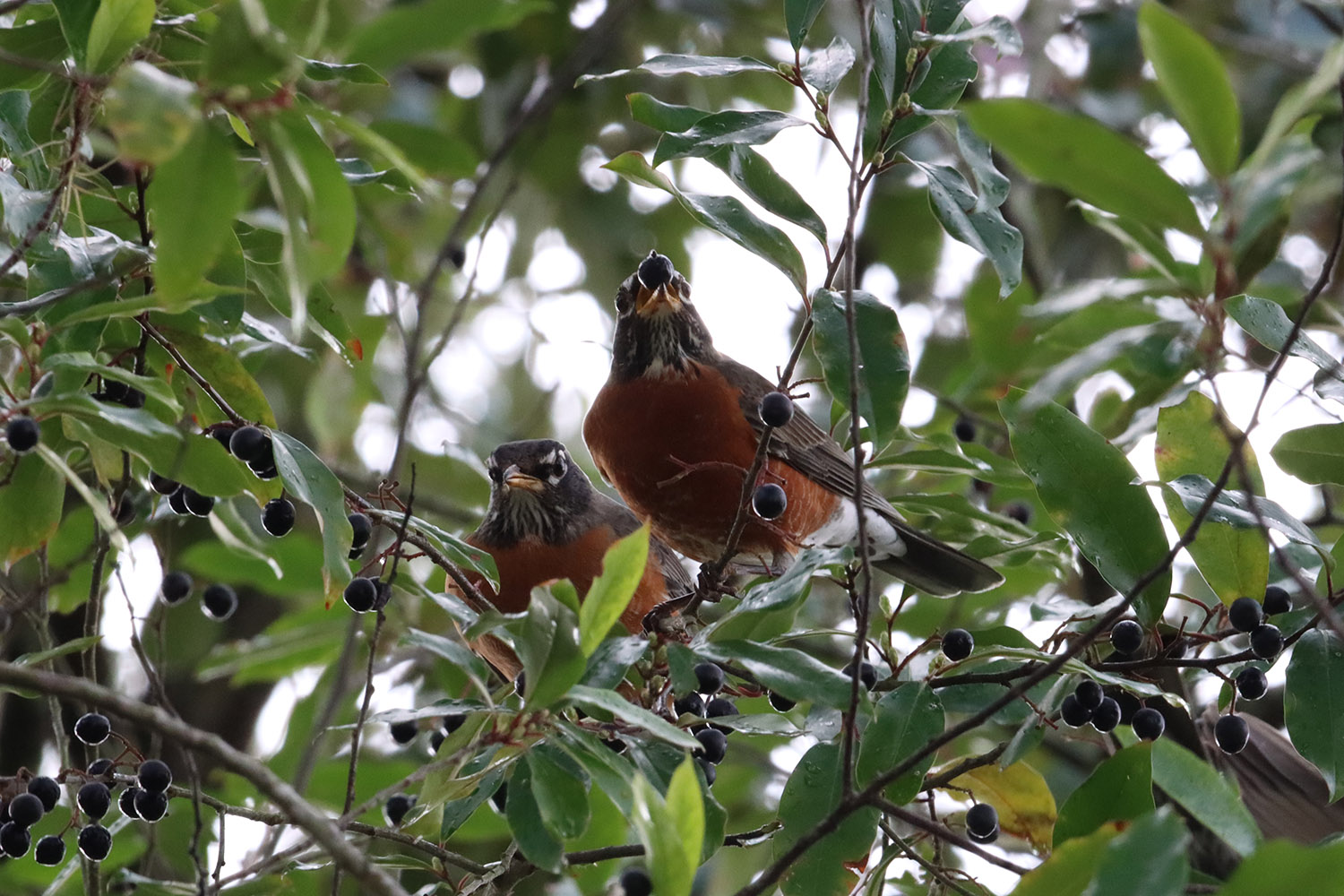
Robins came through on this day to help clear out the cherry laurel fruit. Soon, the tree will flower, and the earliest flying bees will seeks its nectar. As that happens, migratory birds like these robins will begin their return north. It’s the dead of winter but I can feel spring preparing.
February 2, 2023

This plant was indeed alive! I think of the giant swallowtail caterpillars that eat these leaves; small caterpillars like young, tender leaves because they’re easier to eat. This plant will be almost all soft leaves this year.
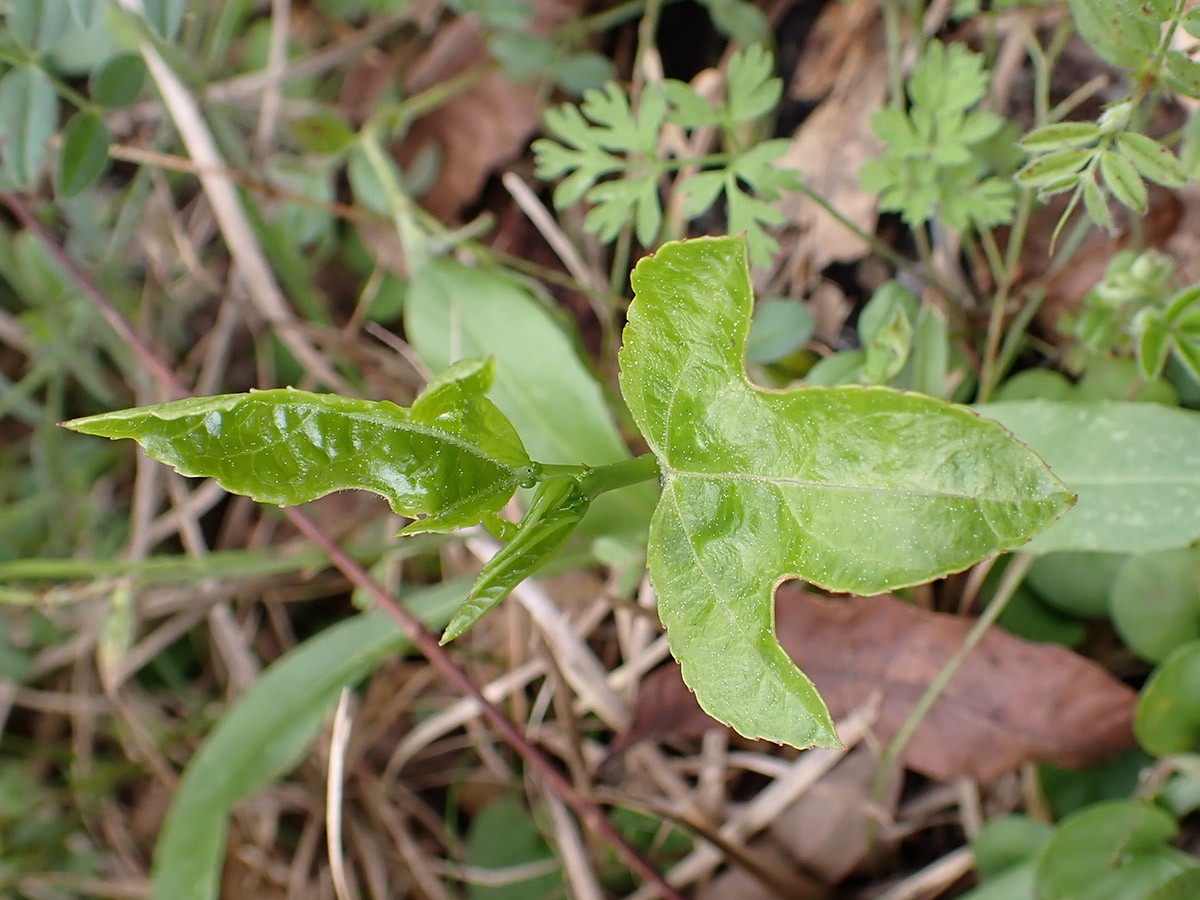
The garden at this time was filling with caterpillar food. The pink swamp milkweed was leafing out, and here was the first passionvine sprout of the year. I planted two last year, and I had heard that they spread underground. This is several feet away from those plantings, and I wondered how many more would pop up.
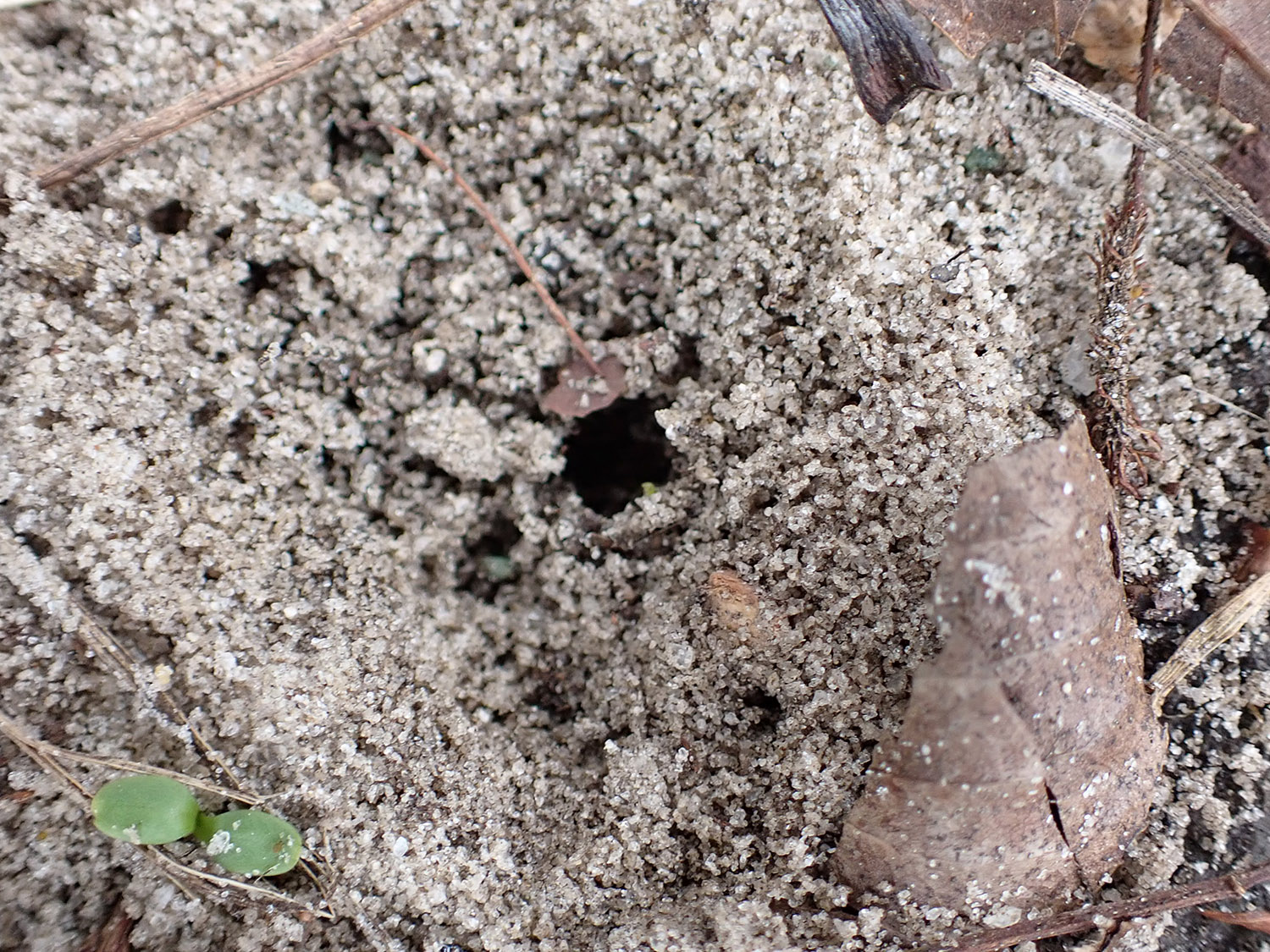
This is also the time when ground nesting insects start to emerge. This is the right size for mining bees, which fly earlier in the year when native trees are in bloom. But these aren’t the only insects that nest in soil.
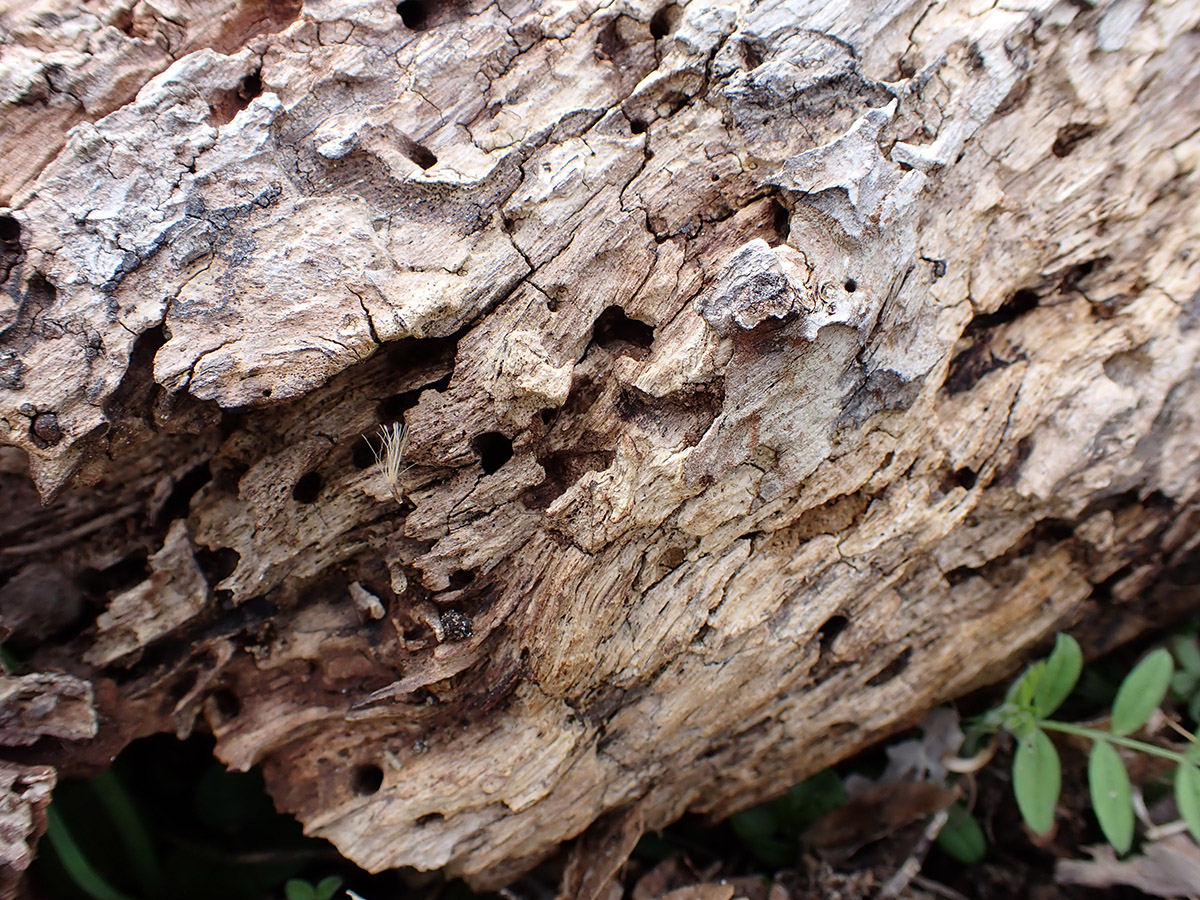
After I produced a segment on creating habitat for nesting bees, I took an idea from Leon County Extension agent Mark Tancig. I started lining flower beds with fallen branches and other dead wood. While some bee species nest in the ground, other nest in decaying wood or dead wildflower stalks. We plant flowers to see bees in the spring, summer, and fall; but if they don’t have a place to spend the winter, who will visit our flowers?
February 8, 2023
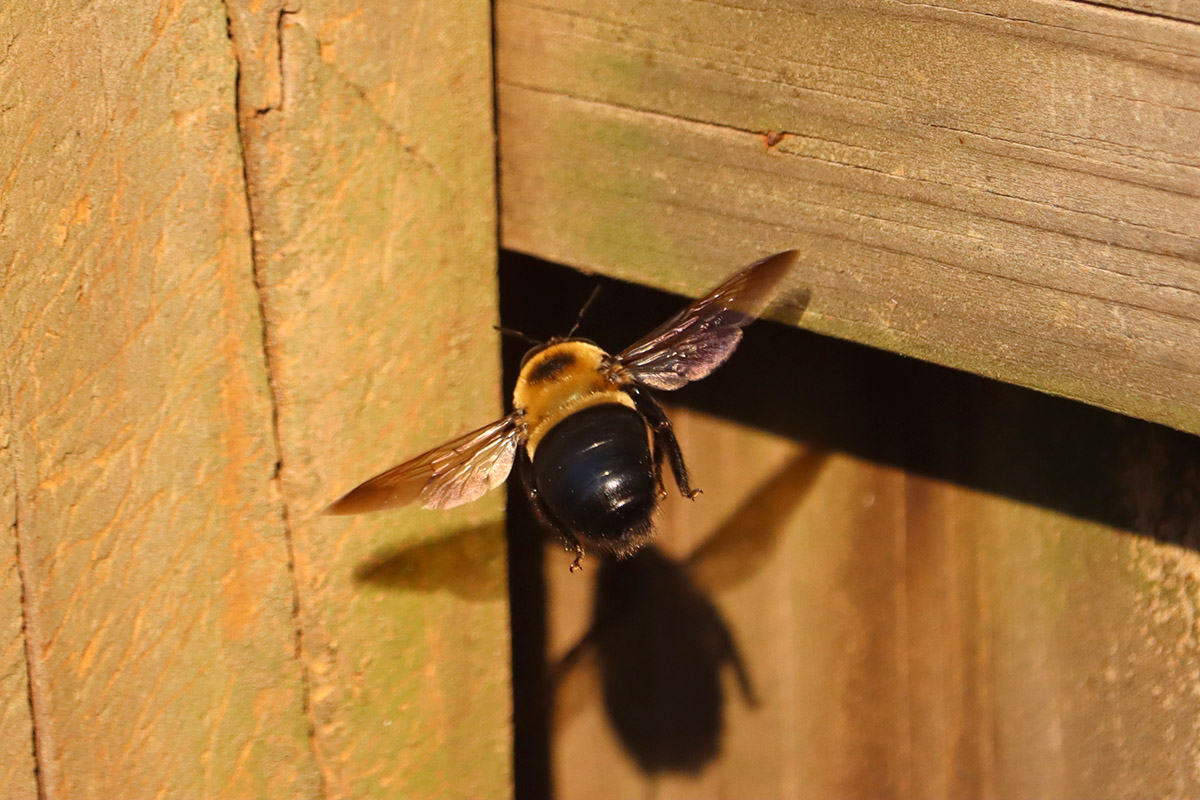
The first native bees I see in a given year are either carpenter bees or mining bees. And before I ever see them on flowers, I see carpenters head for fence posts to start new nests.
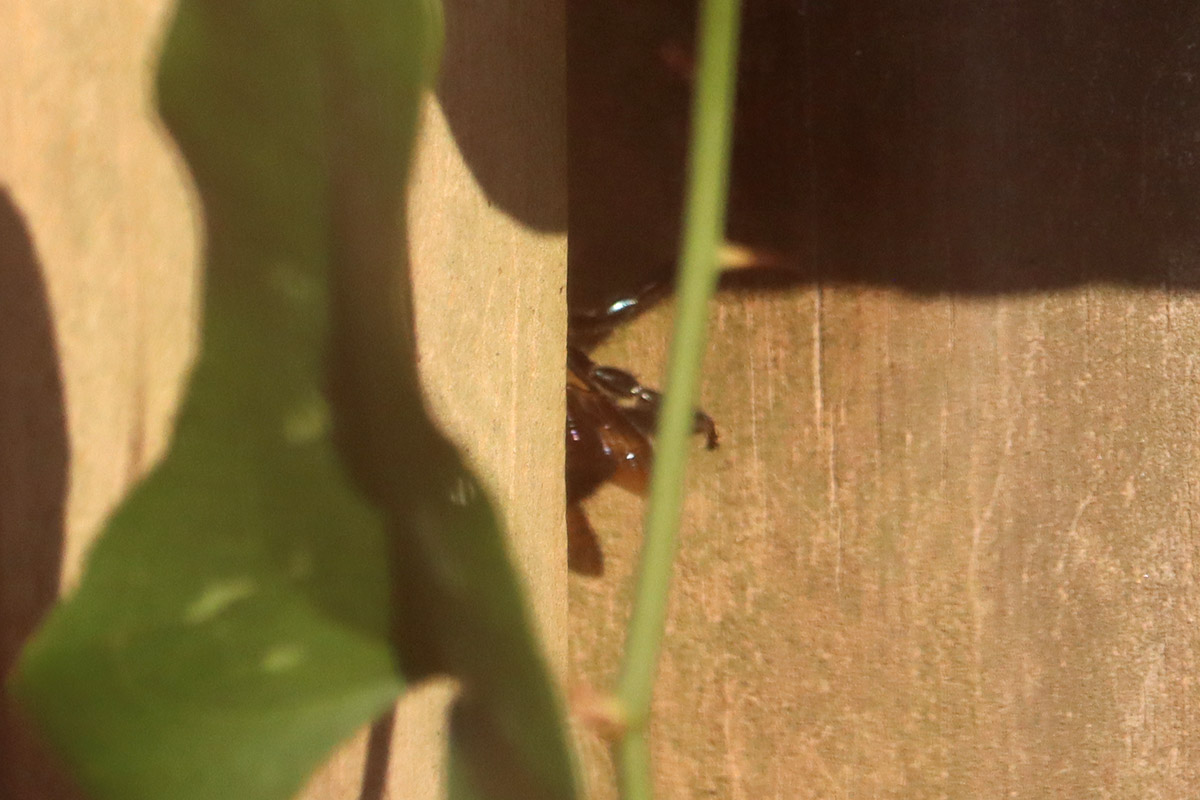
I also see pairs meet high above. Mating and nesting are the first order of business after resting over the winter.
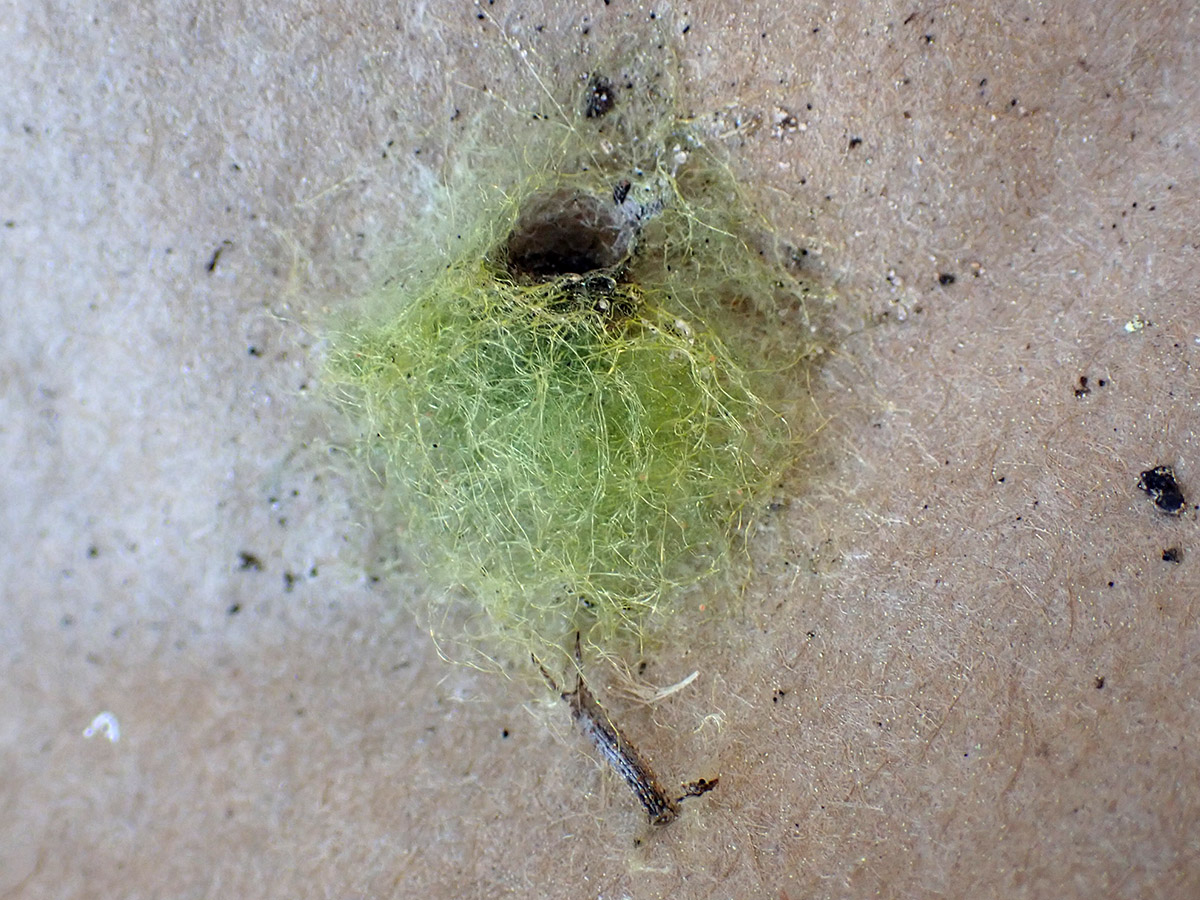
I found another moth chrysalis tucked away, one with an opening. The adult is likely out in the world, but as I look at this photo now, I wonder what that menacing looking insect at the bottom of the frame might be.
February 10, 2023
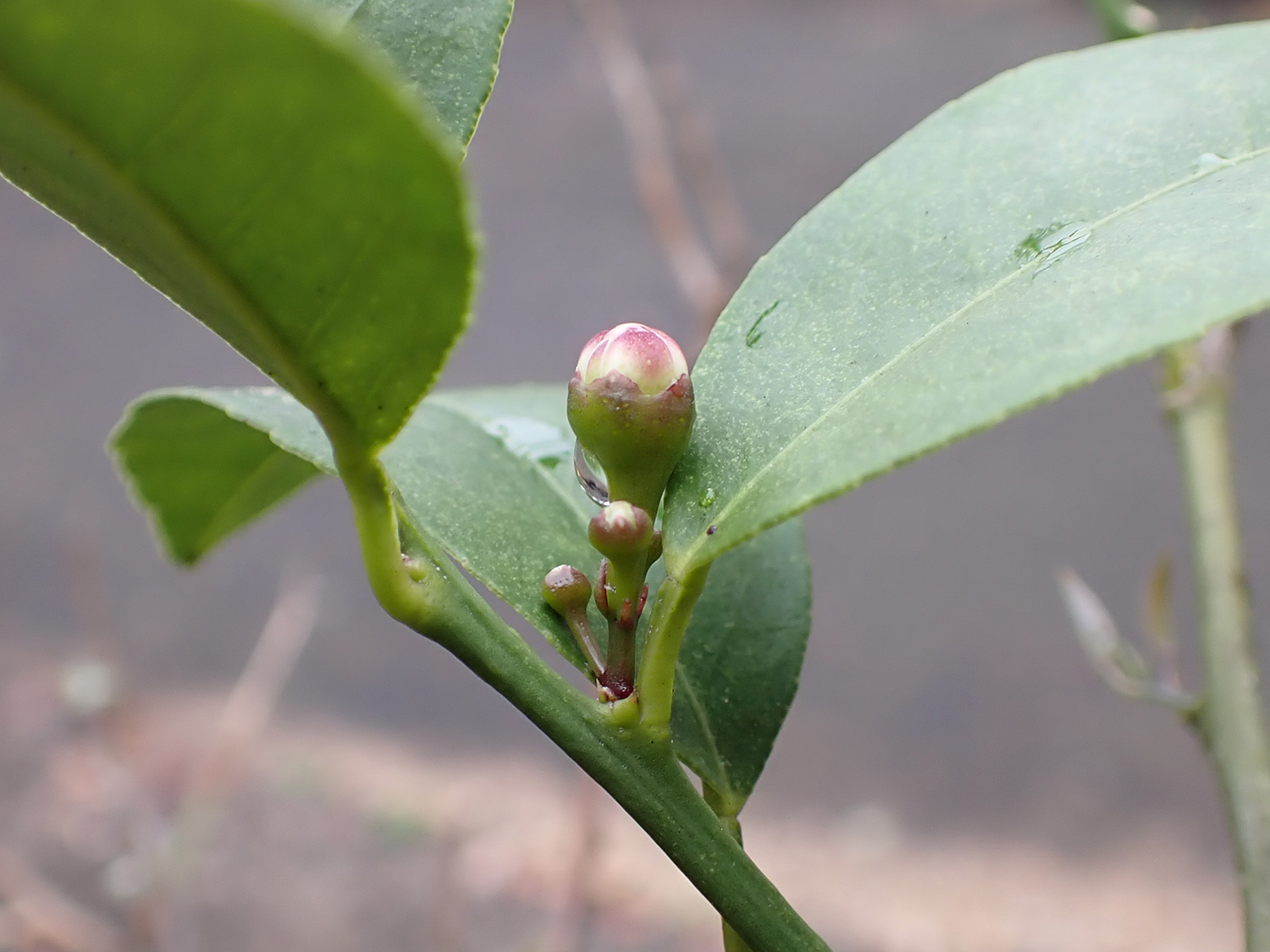
The Meyer lemon tree not only survived the December freezes, but a little over a month later, it started to make flowers.
February 16, 2023
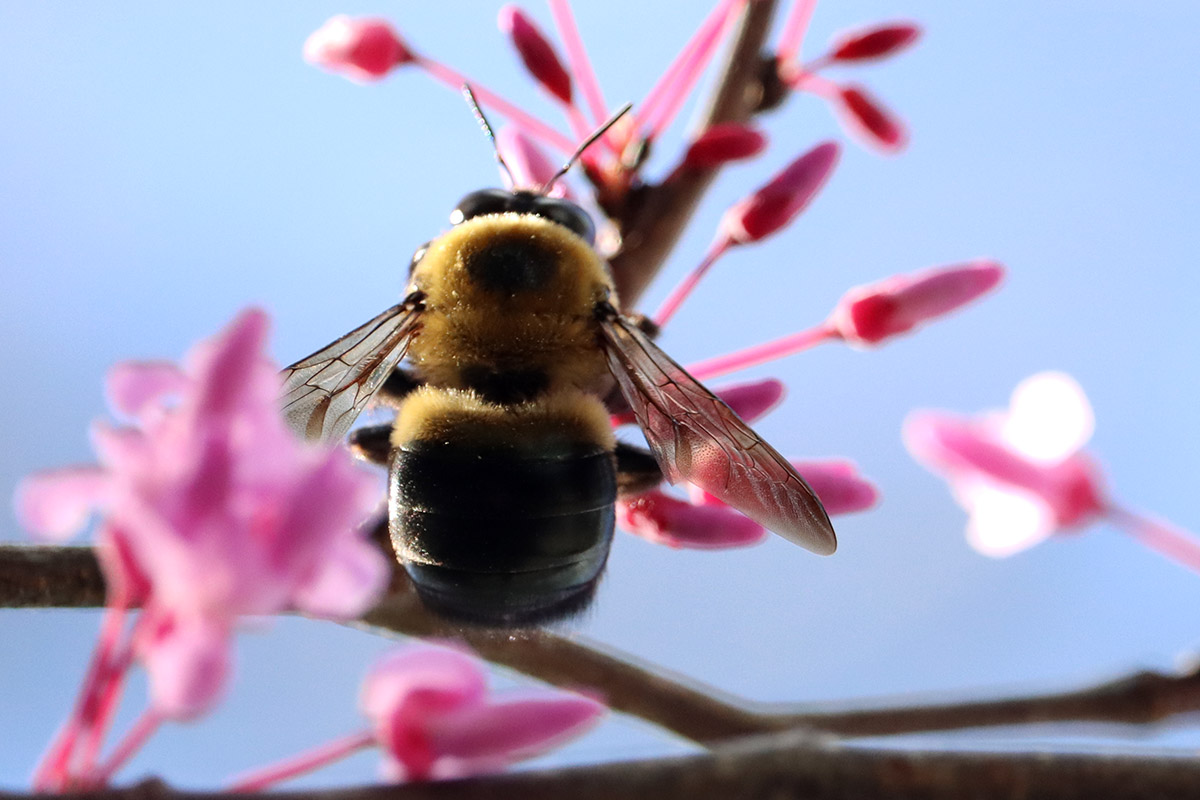
The first of the native trees around our house was blooming, and was visited by the first native bee I saw flying.

Nonnative honeybees also fly early in the year, and make good use of lawn weeds like Ohio spiderwort.
February 20, 2023

I saw this small beetle on a passionvine sprout. By this point 2-3 had popped up in the yard. The best iNaturalist suggestion for the beetle was Parchicola tibialis, a type of flea beetle. Flea beetles eat the surfaces of leaves, ceating holes. This would explain why I was seeing holes before gulf fritillaries or zebra longwings laid any eggs on them.
February 21, 2023

And what was eating the fennel I planted for black swallowtails? I buy a lot of plants specifically for butterfly caterpillars, but I can’t get mad when other insects eat them (I am allowed to be furious when squirrels eat all of my chard). There is an overall benefit to my backyard ecosystem in having a diversity of plant eating insects. Some of them are considered garden pests, but this is a yard of predators and prey. Studies have shown benefits to monarch caterpillars when other plant eaters are present on milkweed– could not the same dynamic be in play on fennel and passionvine?
February 27, 2023
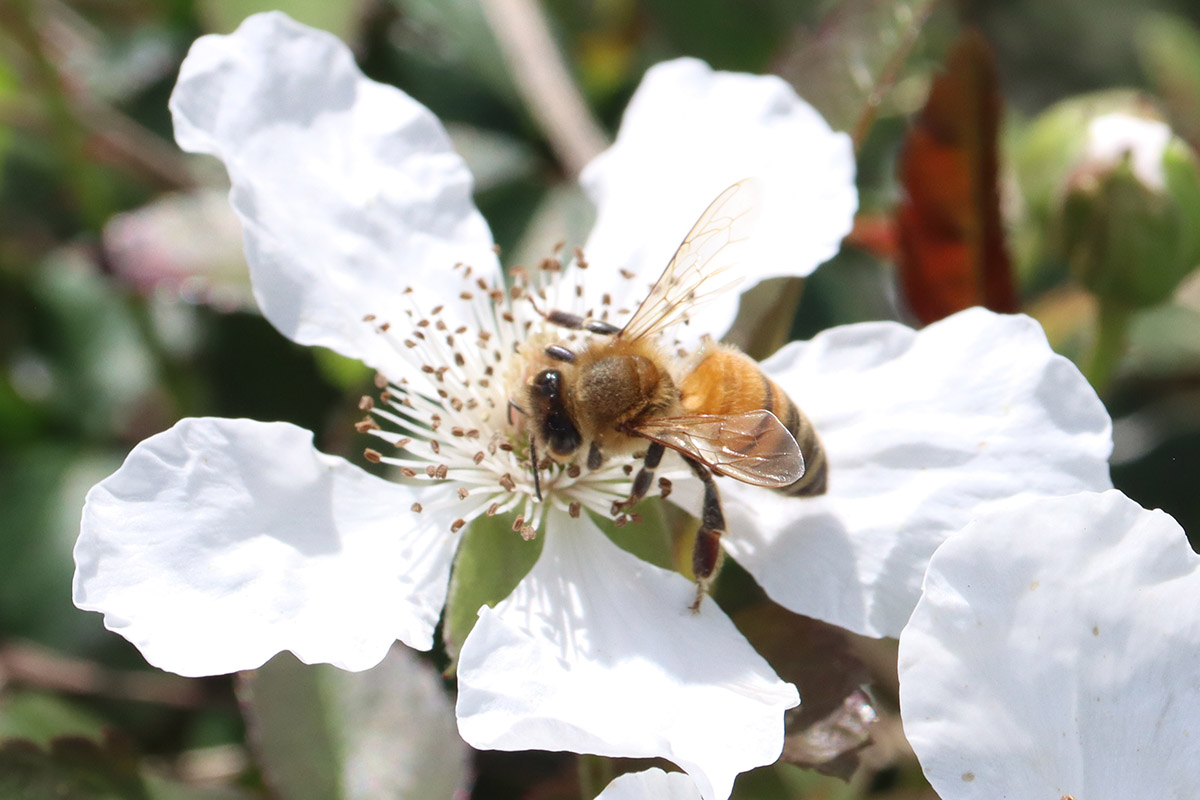
Right when many native trees start to flower, so do many of the “weedy” natives down low. Thorny dewberry vines can spread over your yard, and over plants you might like better, but I always leave some space for them. Their flowers are the reason why.
February 28, 2023
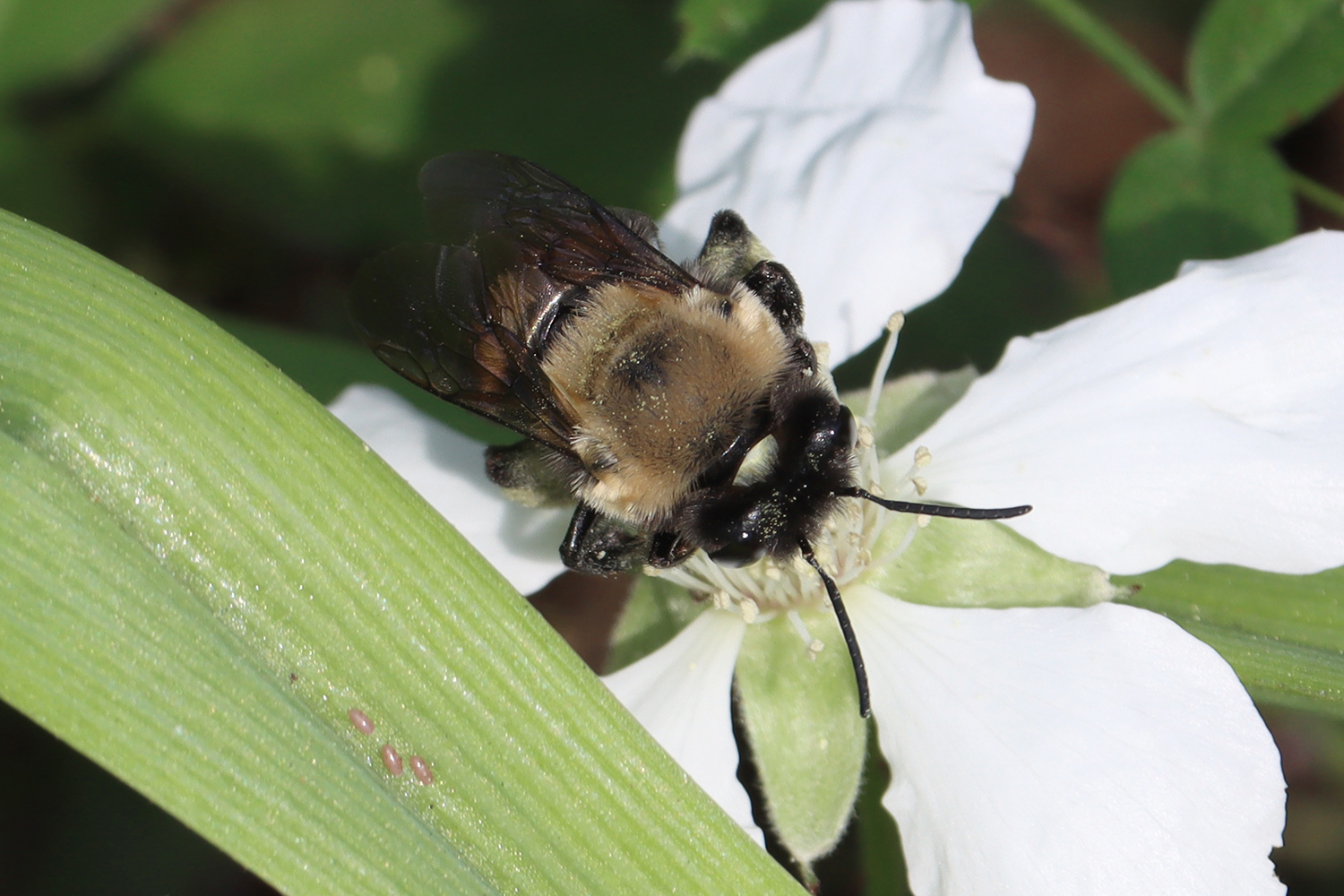
Blueberry diggers are supposed to be specialist bees. But it turned out that my blueberry bushes didn’t survive the winter. When their bee showed up and there were no blueberry flowers, it settled for dewberry while I made a trip to the nursery. Last year was the first year I’d seen the bee in our yard, and I wanted it to become a regular. Also, I love blueberries.
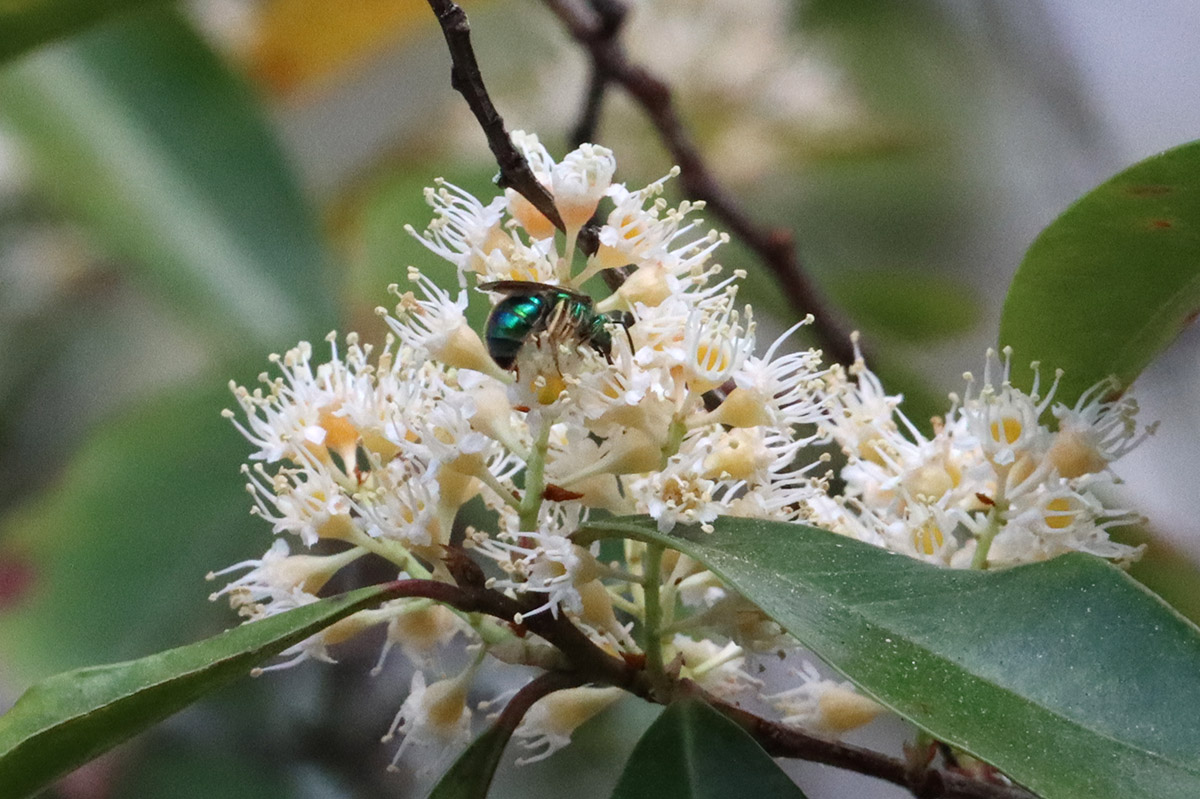
Between the dewberry and cherry laurels starting to bloom in full, our bee diversity increased in late February.

I took a few photos of this bee and uploaded it to iNaturalist. It doesn’t look as hairy as the mining bees I see, and maybe more like a Dialictus sweat bee. Of all the bees I uploaded around this time, this is the one for which no one offered an ID.
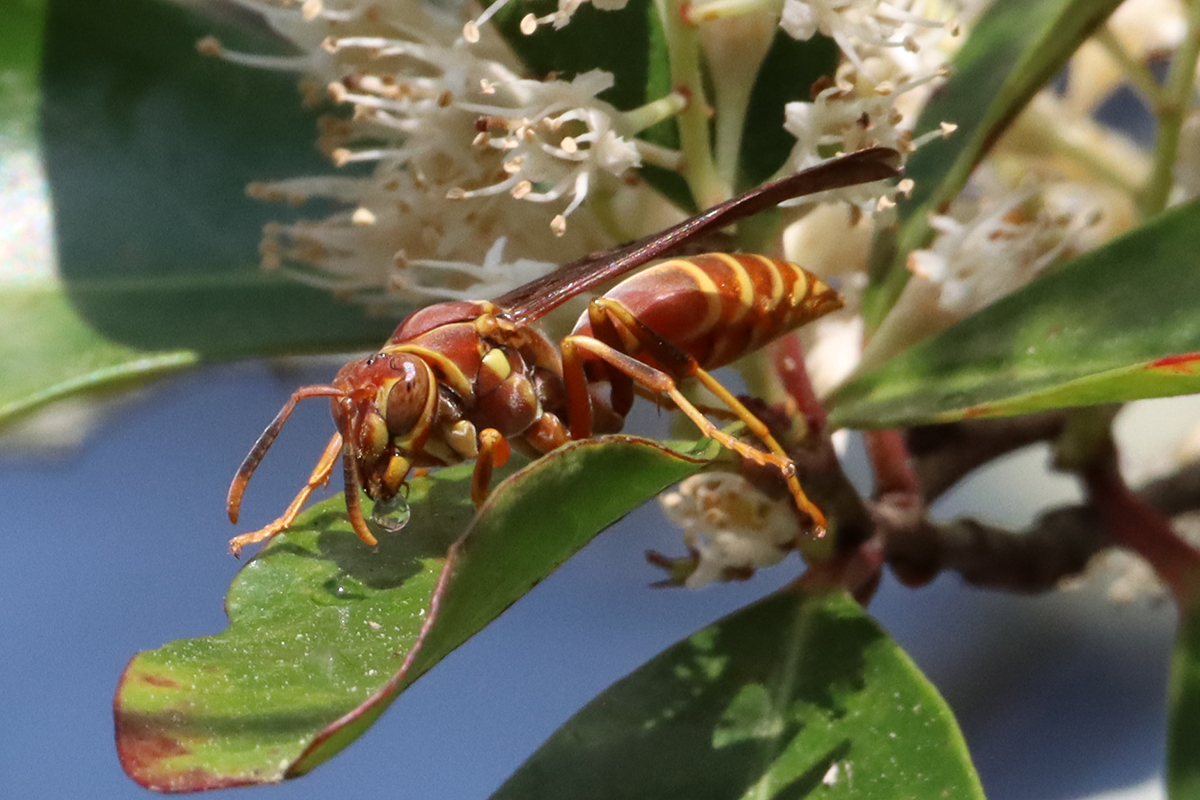
I saw this wasp roaming the flowers as well. Is that flower nectar hanging from its mouth?
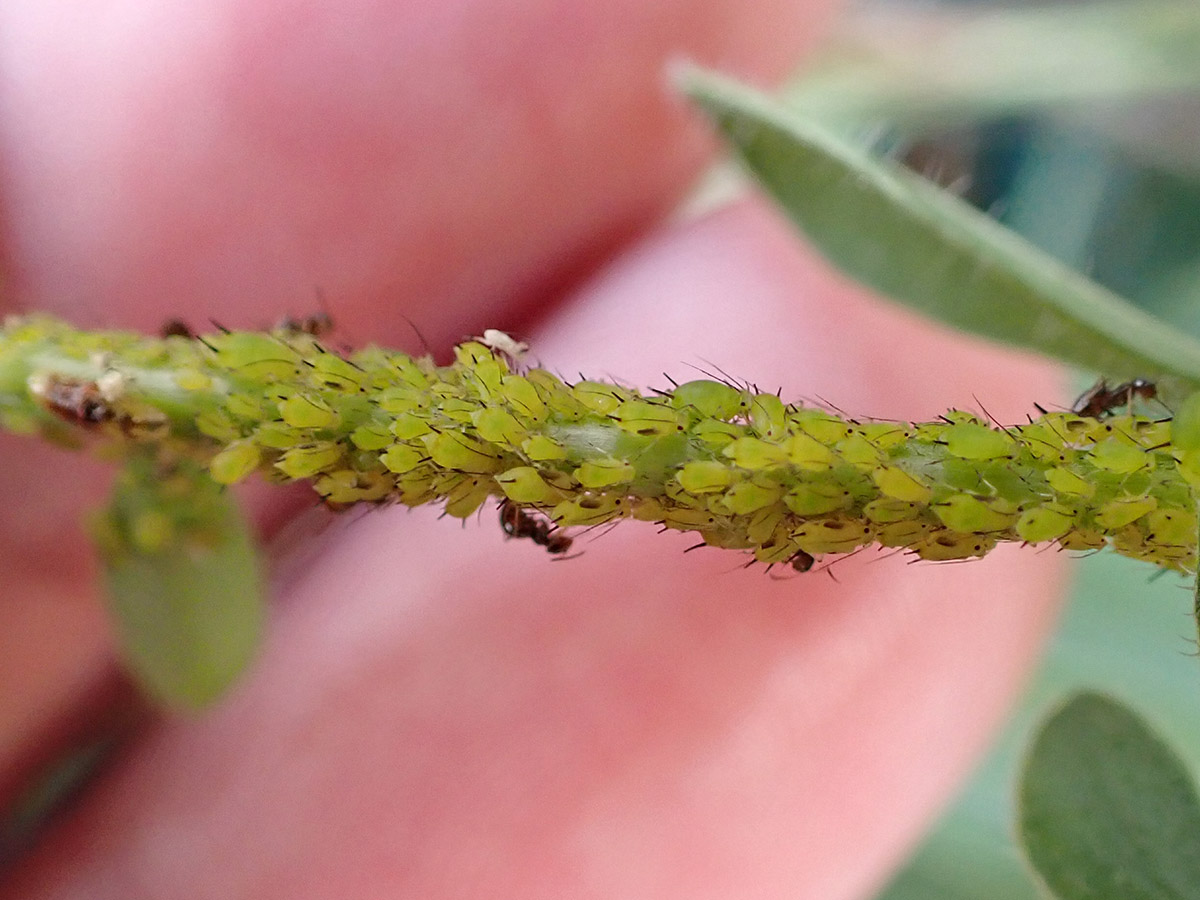
And here are milkweed aphids on not milkweed. This is the first time I’d seen this in the yard. The milkweed had already started to leaf out, but maybe not enough to feed these guys. The ants here are eating aphid excretions- honeydew. To secure this food source, they protect the aphids from predators, which in our yard are numerous. This colony didn’t last, and the plant is fine as of this writing (March 30). Did the predators prevail?

And finally, a surprise in my yard. Tucked into a weedy area next to a wildflower patch, the only violet I’ve ever seen in our yard. It was the only violet flower in the yard this year, and I wonder if there’ll be more next year.
March 1, 2023
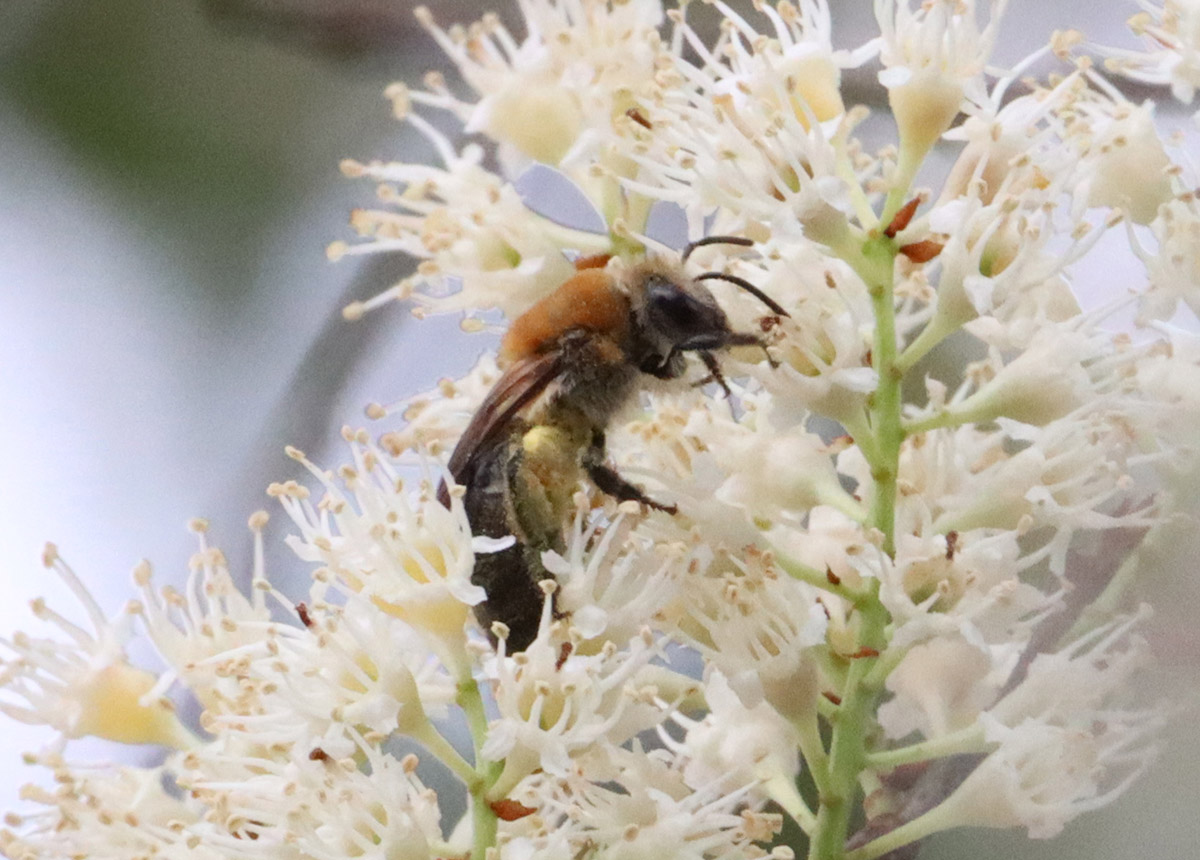
Here’s our first new bee species of the year. In 2022, we had six new species visit the yard (since I started planting wildflowers and photographing bees). I admit this one might not necessarily be new. I used a higher powered lens to zoom into the cherry laurel above and was able to see what bees where up there; previously, I had only noticed mining bees and carpenter bees.
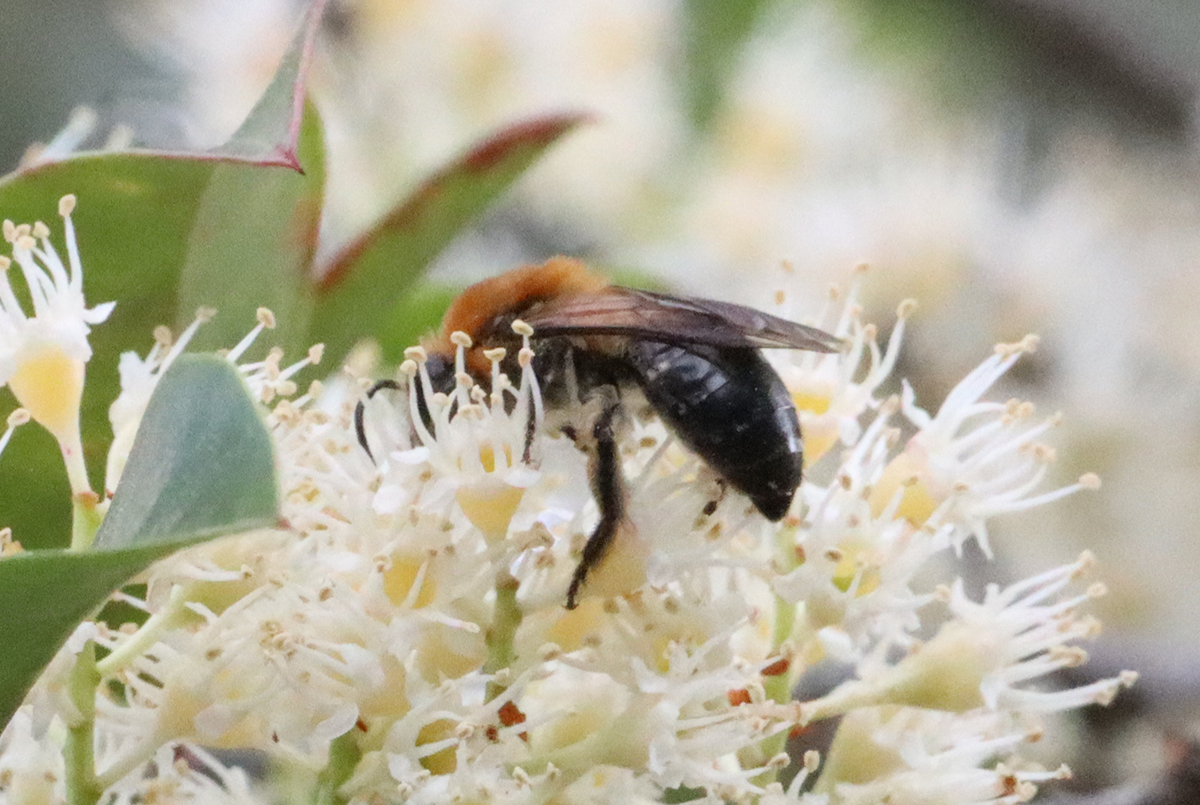
Here’s another angle. Reddish hair, smooth abdomen. Like mining bees, they only fly early in the year.
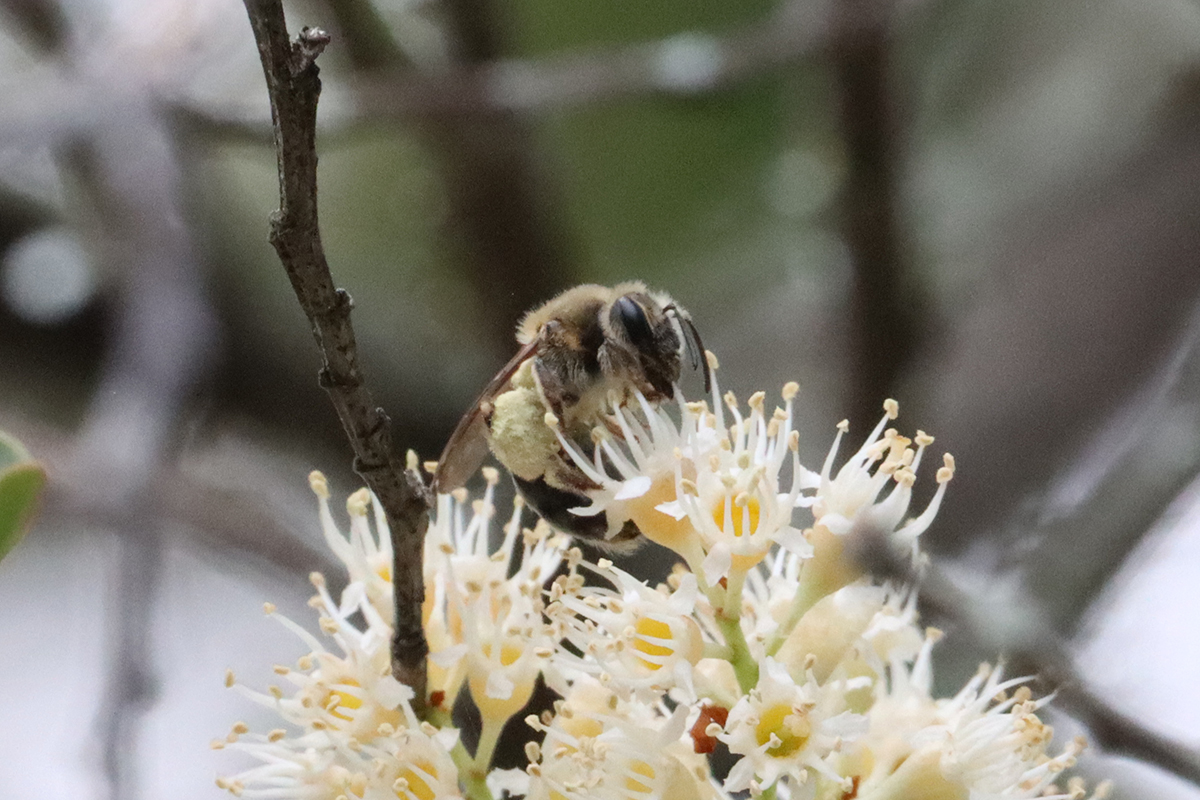
These are the bees I always see in trees in February and March. And I’ve seen them dig nests in April. I never get an ID more specific than subgenus-level in iNaturalist for Andrena; like Lasioglossum (subgenus Dialictus), many of the species are so similar you need to dissect them to tell them apart.
March 2, 2023
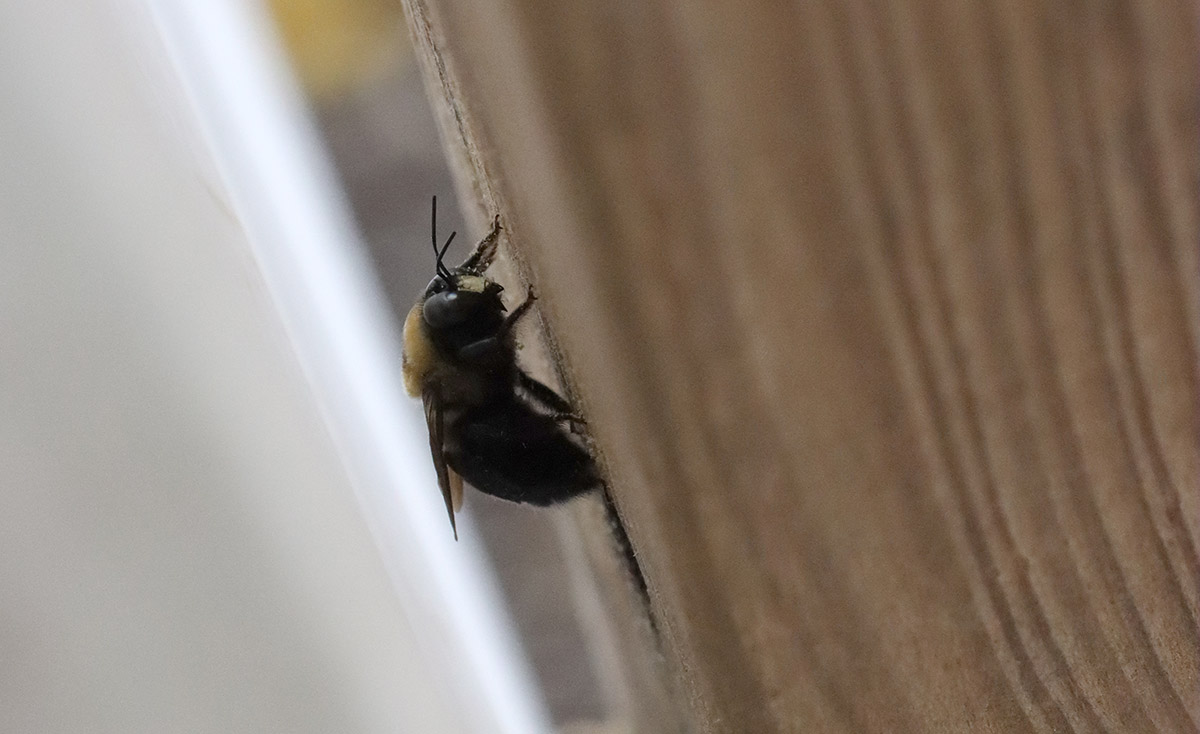
I rarely see a carpenter bee nest in our yard that faces outward. They’re often behind fenceposts, or under railings. This one is between a post and the outside wall of our house. It was a weird angle to shoot it, but you can see its round hole.
It has white on its face and no pollen on its legs. This is the male defending the nest.
Males are the carpenter bees that fly at you. It can be scary, but they have no stingers.
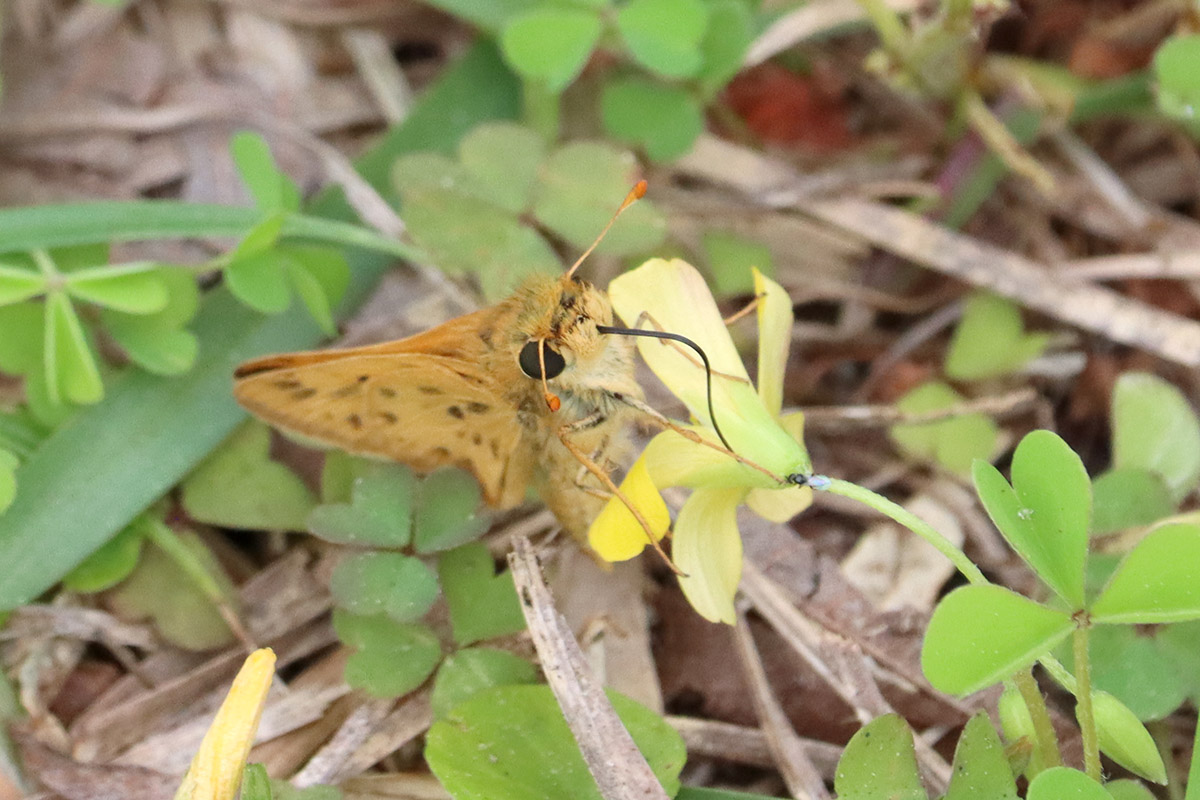
I’ve seen a few sulphurs and swallowtails pass overhead, but this was the first butterfly I saw sipping nectar in the yard.
March 3, 2023
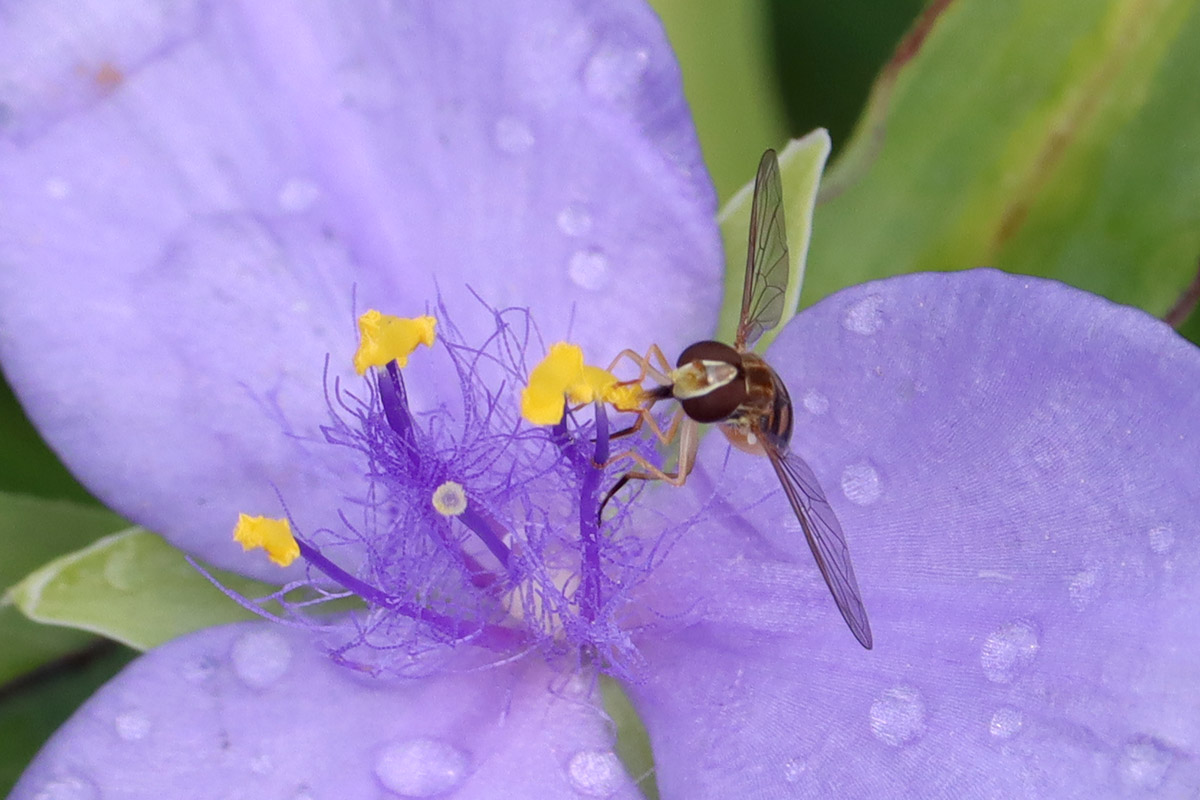
I didn’t get a good shot of its topside before it flew off, but this could be an oblique streaktail, which had been common in the yard last year as the last flowers faded.
March 4, 2023
Two new bee species today- making three for 2023, and all in the span of three days. The two bee genera (plural for genus) I mentioned on March 1 as being difficult to ID without dissection- each of these is a member of one of those.
A day for bees
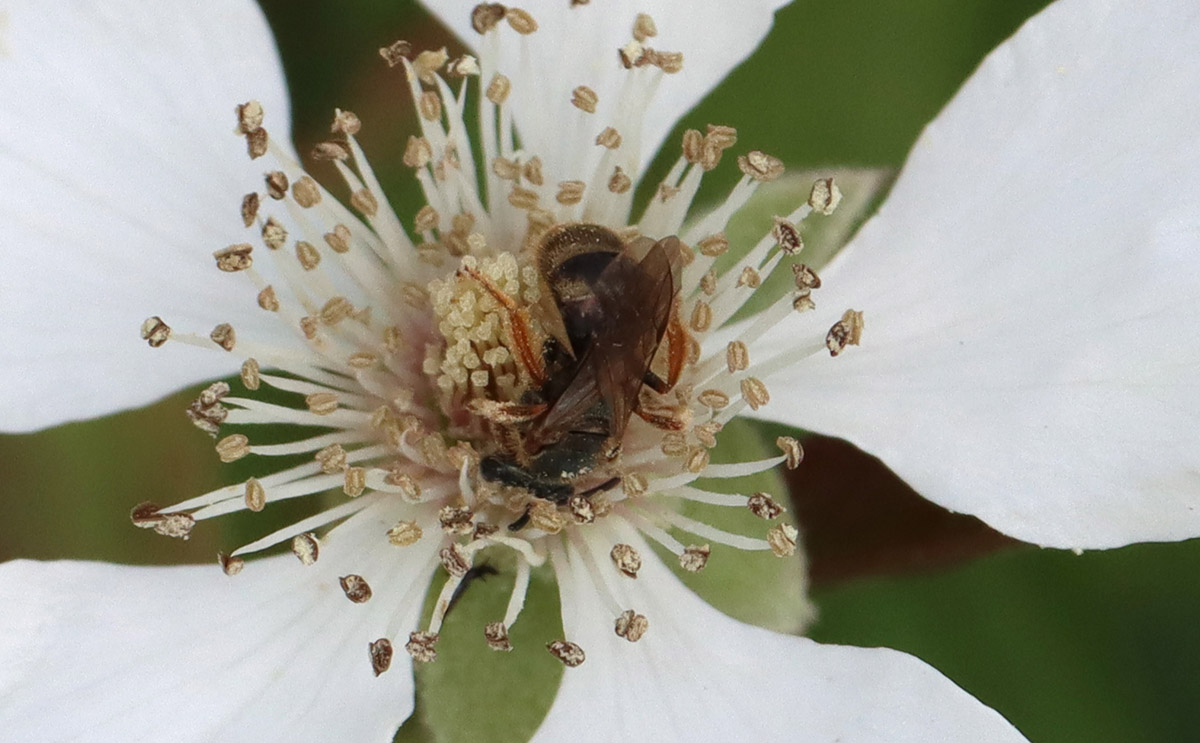
This is a Lasioglossum subgenus Dialictus bee. There are over 500 members of this subgenus in the US. This one has reddish legs and more pronounced abdominal stripes than the all-black ones I normally see.
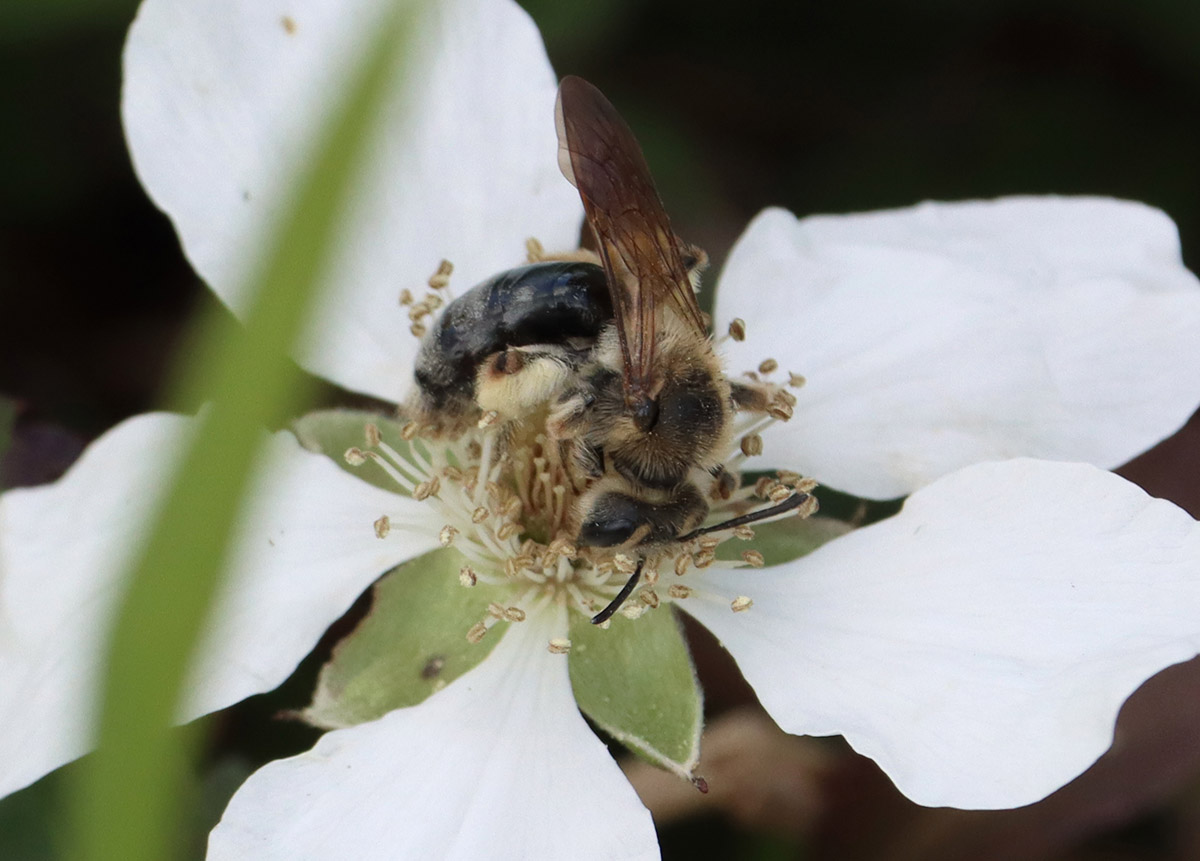
This was a bee-filled day. I’d been watching honeybees and sweatbees visit these flowers, when I noticed what looked like mining bees. I’d only ever seen Andrena in trees, so I took a few photos and uploaded to iNaturalist. Looking at the photos, I could see this had lighter hair than our other mining bees.

This is what most of our Dialictus look like. Some are larger and some are smaller, but I never get a species level ID on iNaturalist. You may have these tiny yellow Oxalis flowers in your yard- Oxalis is wood sorrel, though they look like little three leaved clovers. Think of how small these flowers are, and you can see how small a bee this is.
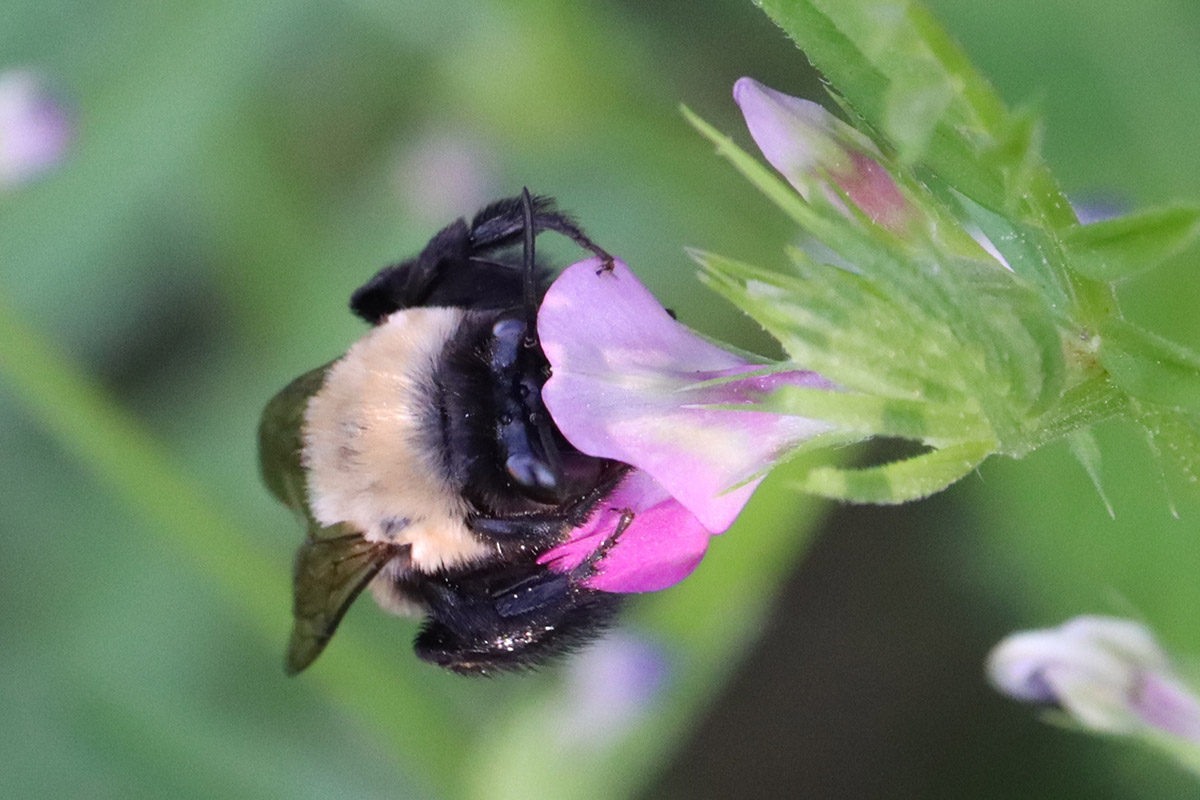
The day before I had planted five new blueberry bushes. They were all for you! I’m not sure I’ve ever even seen a bee on a vetch flower before.
A day for caterpillars, too
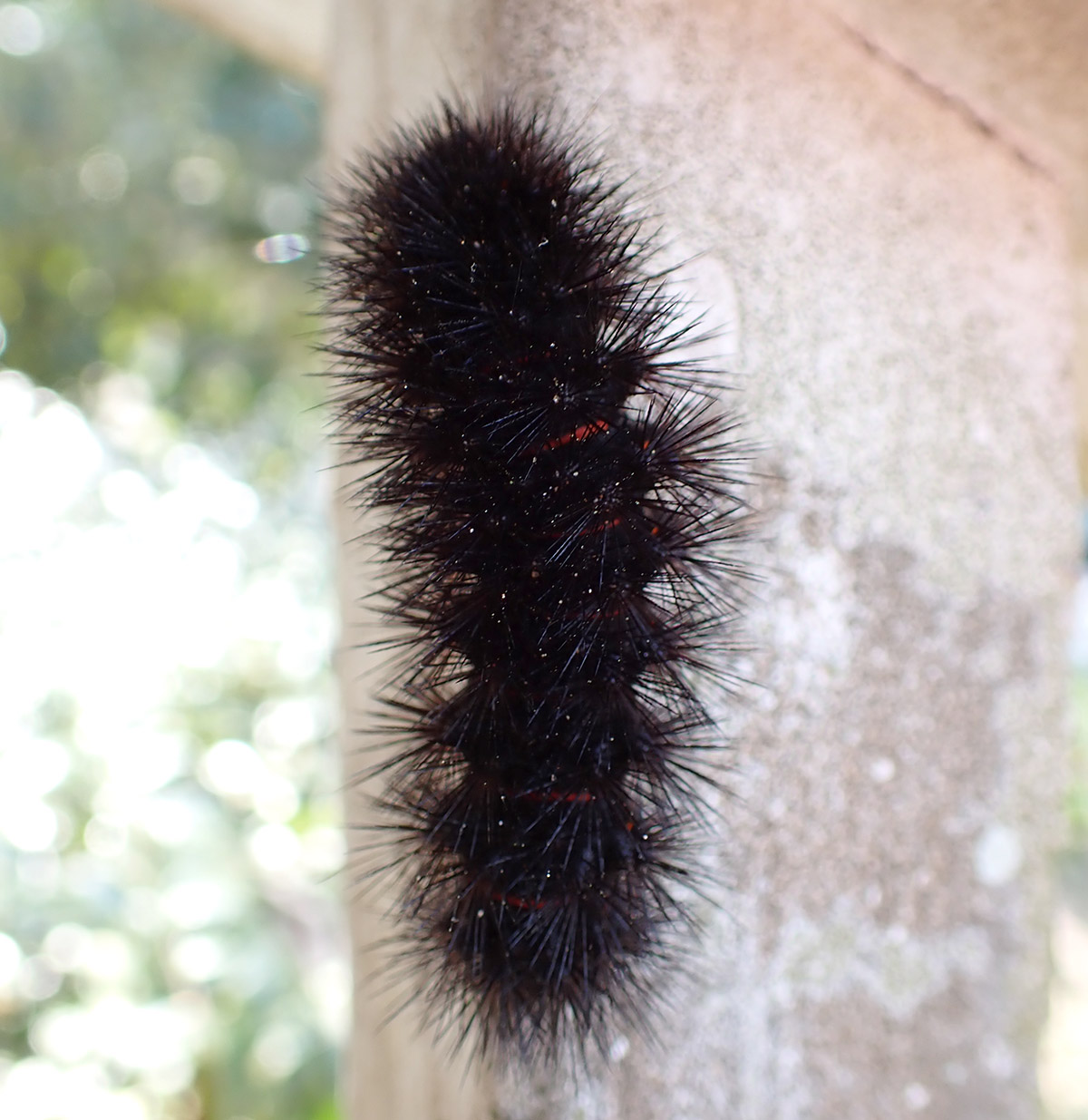
One day I’ll see an adult giant tiger moth. The photos I’ve seen look cool. Here, once again, though, is its caterpillar.
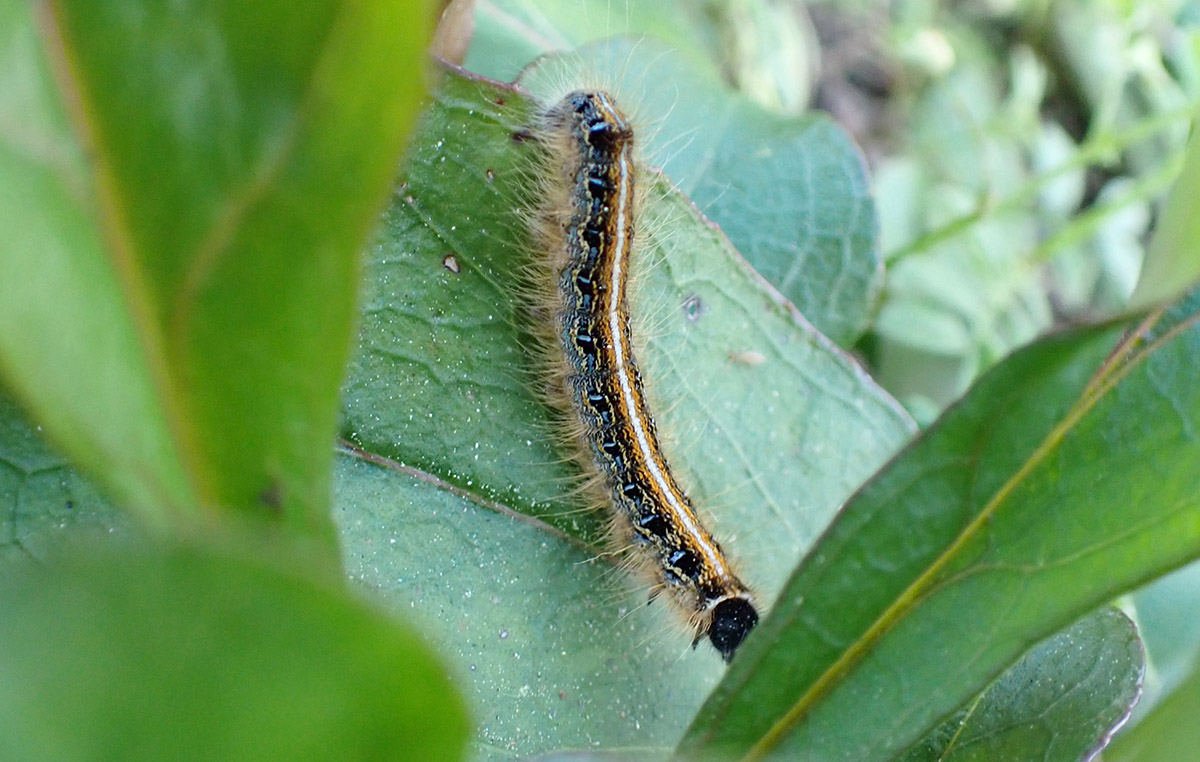
This is the time of year where you see your first tent caterpillar, and then you see them everywhere. I saw many in the garden, but I won’t overwhelm you with pics. There’s plenty else to see.

I spotted a milkweed assassin in the front flower bed last fall, and here is a younger assassin. That adult was lurking in the flower bed when our passionvine was covered in caterpillars, and this was when I was seeing new passionvine sprouts daily. I planted two last year, and ended up with about twenty in March. It’ll be wild.
March 6, 2023

I don’t remember Oxalis blooming as profusely as it did in March of 2023. And I don’t remember seeing small butterflies making use of it like I’ve seen this year.
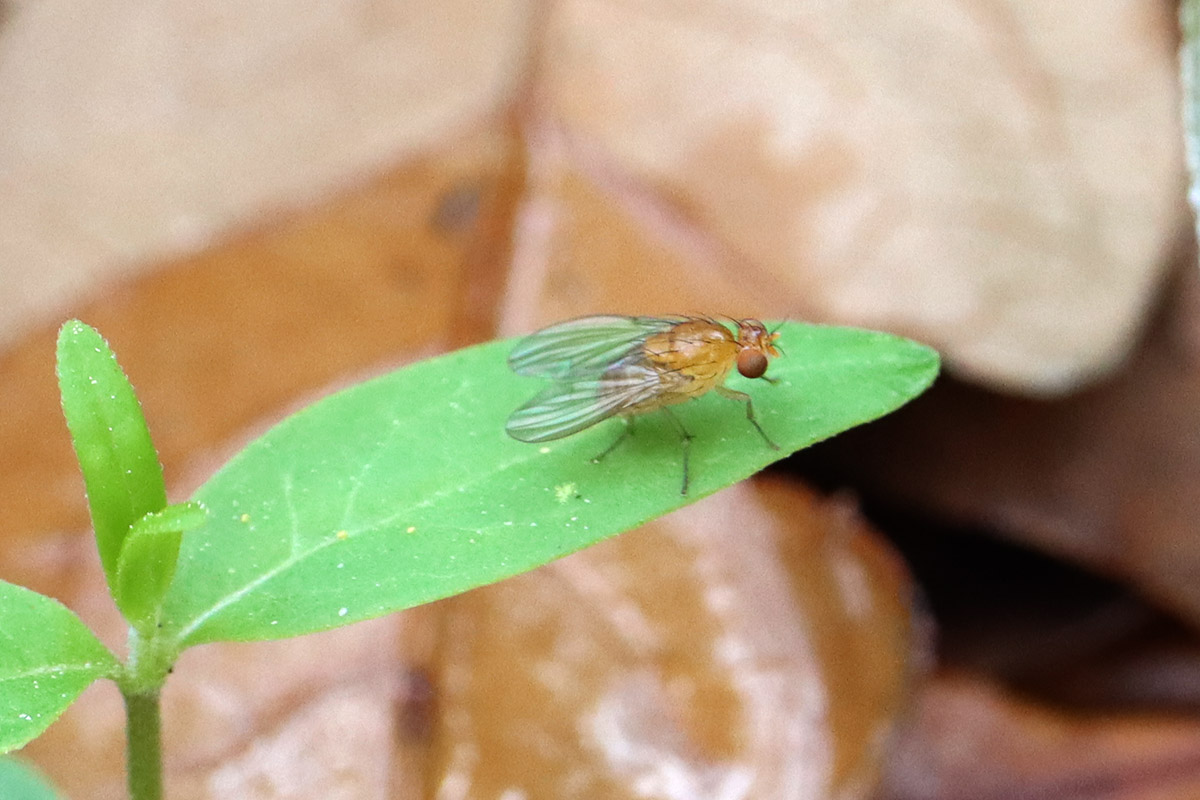
I don’t have much information on this insect, other than it’s an acalyptrate fly. This group of flies ypically feeds on leaf litter or decomposing wood.
March 9, 2023
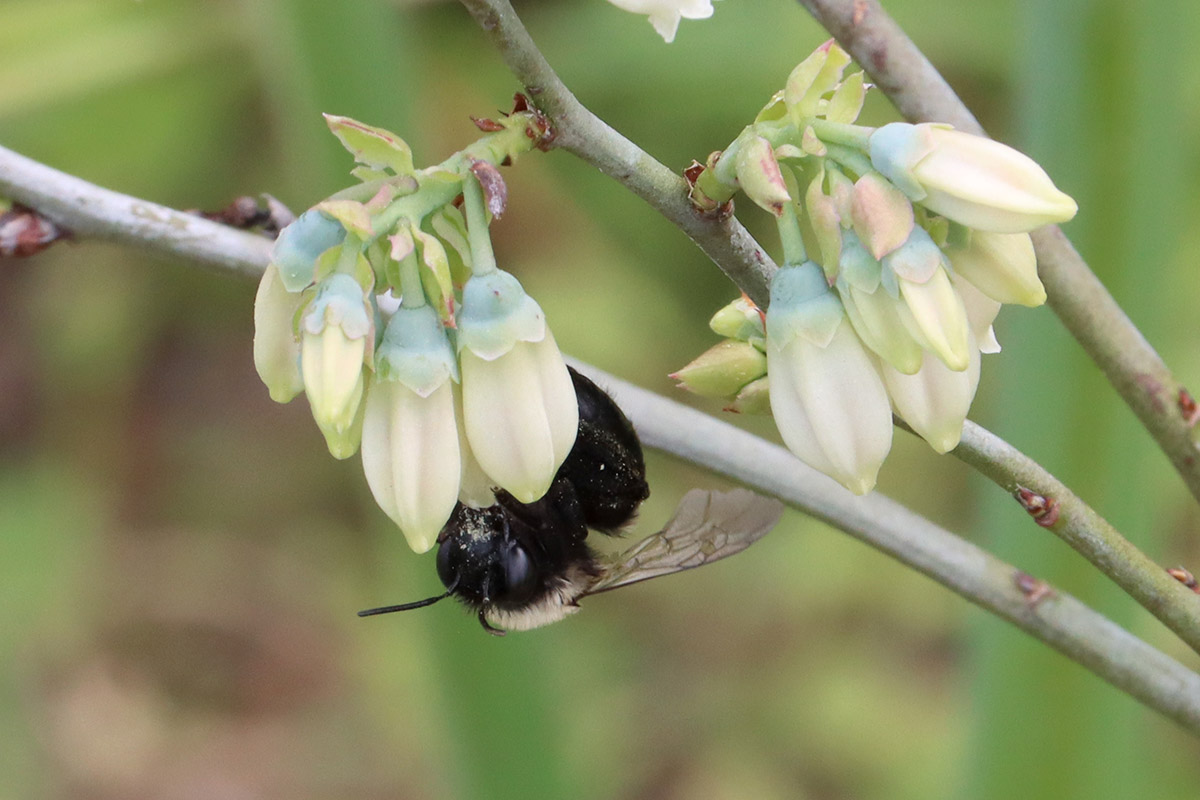
And finally, here is the bee on its flower. Last year we had one, and since I planted the new bushes, we’re up to four at a time this year. They love the betony, but do visit the blueberries. They visit almost every flower in the area around the bushes.
March 11, 2023
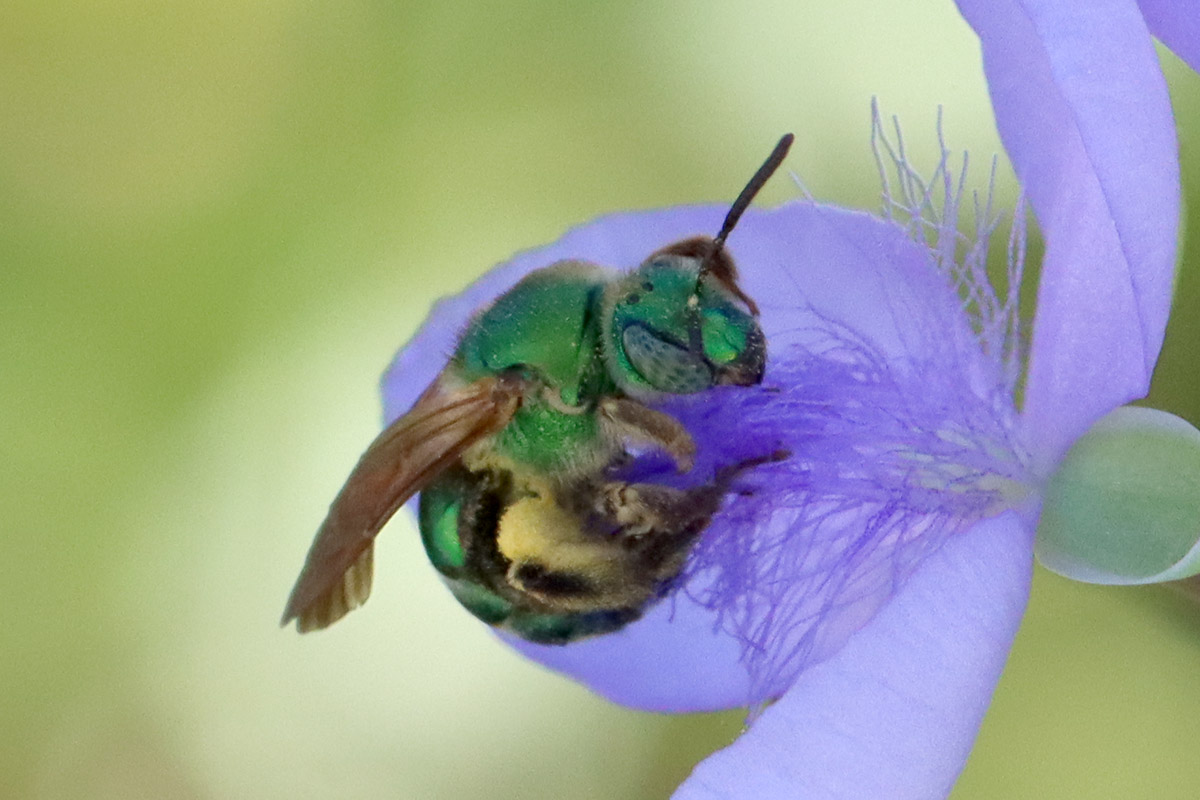
Here’s a bee I saw on tree flowers, and now on ground weeds. We see one or two females for months, and then there’s an explosion of males and females in August.
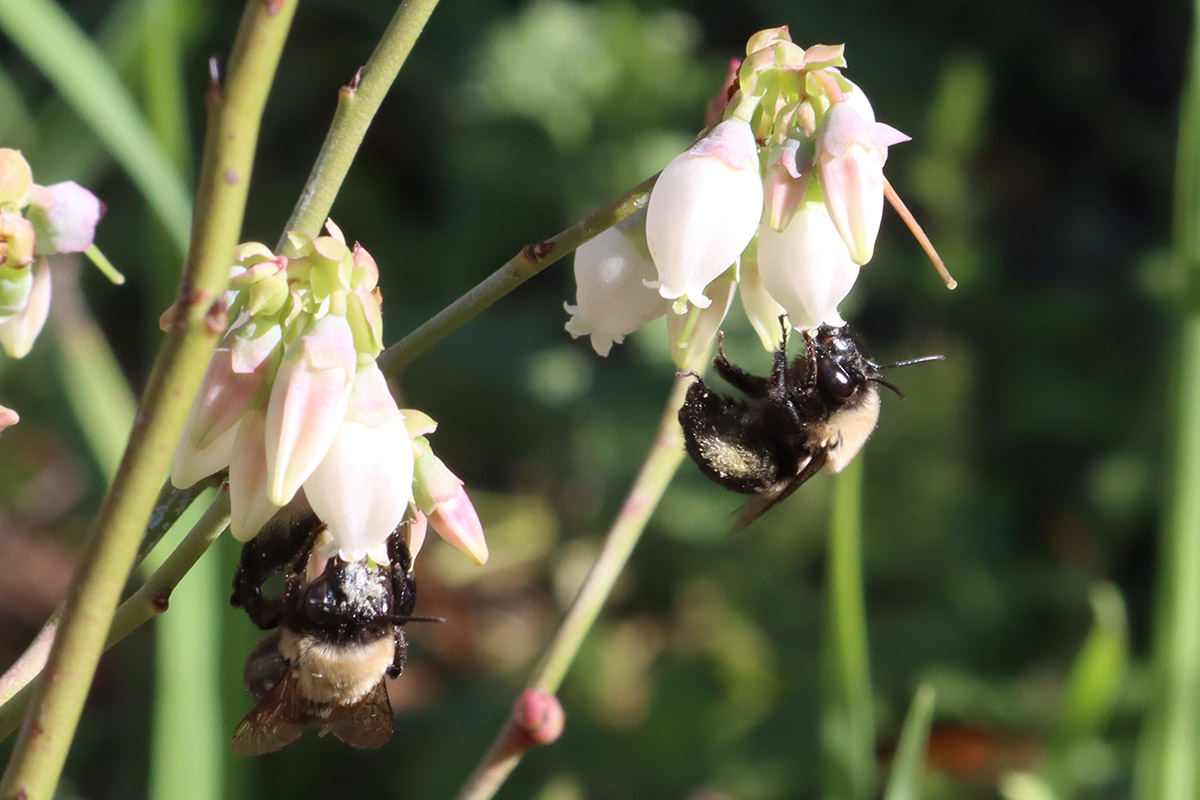
Native blueberries bloom just after native trees, so I like them in the yard for bees. The goals is to have flowers for every season, to attract the bees that fly during specific seasons- like blueberry diggers.
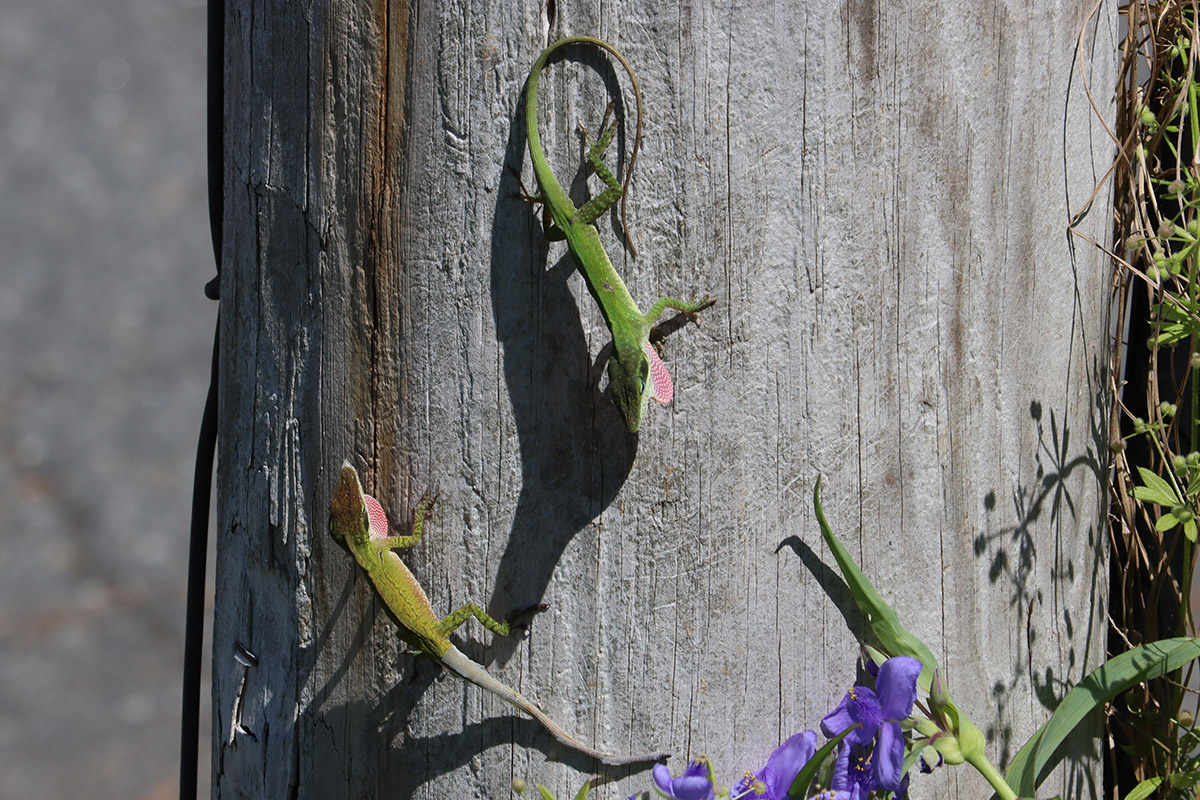
Lizards extend their dewlaps to wad off rivals or woo mates. I didn’t have time to see which this was.
March 12, 2023
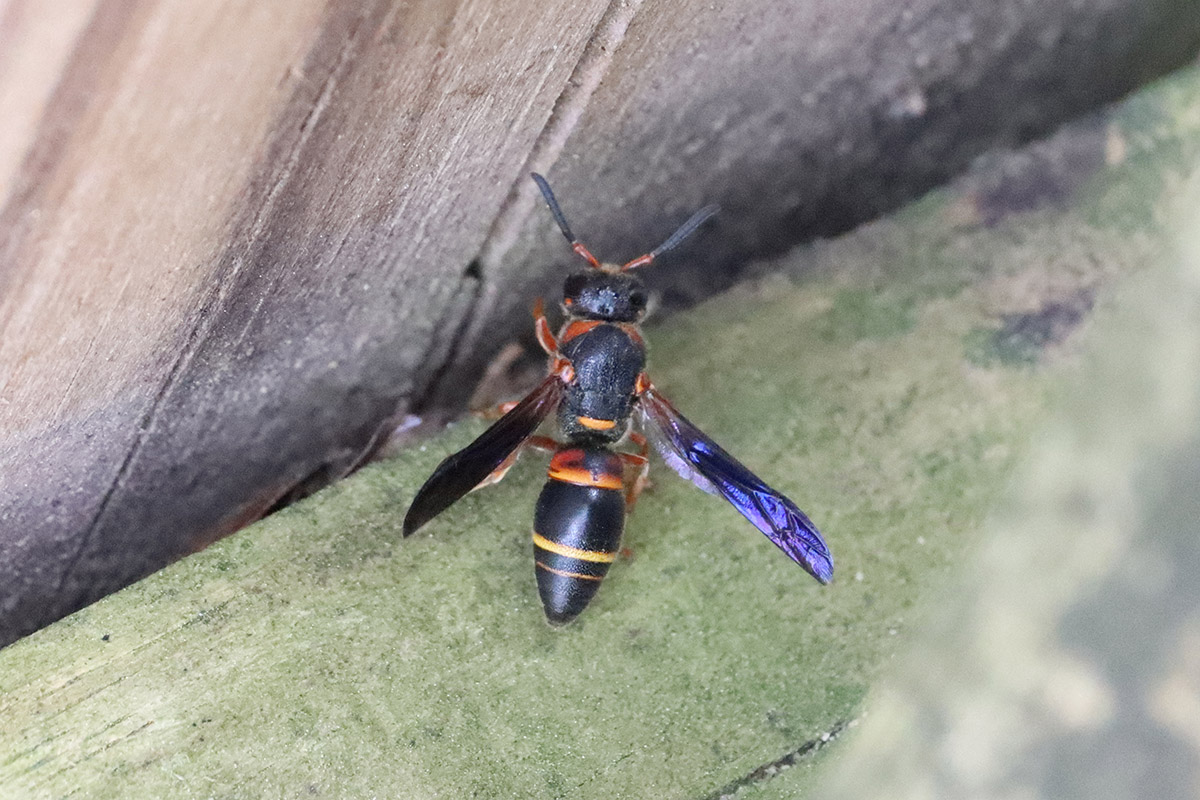
This mason wasp appears in our yard most years, though I didn’t notice it in 2022. This one had stumped wasp experts on iNaturalist, but it has since been classified as a part of the Euodynerus foraminatus species complex. Species complexes are groups of closely related species, where sometimes individual species have not all been identified.

Here’s another hoverfly species in the yard. I had also been seeing plenty of dusky hoverflies in the air, but rarely on a plant.
March 13, 2023

Here’s a dragonfly I almost didn’t see.
March 16, 2023
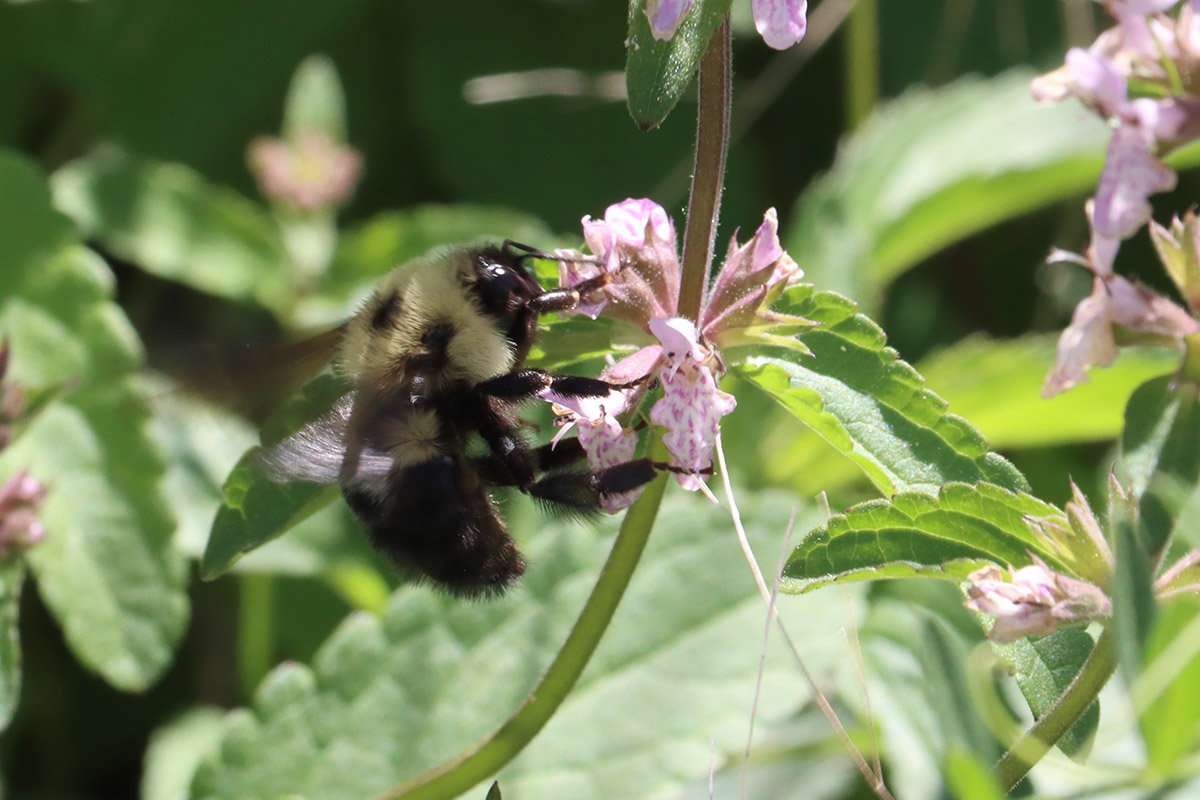
And this was our first bumblebee of the year, that I had seen, anyway.

I’ve not seen caterpillars in the front flower patch yet, but the area is bursting with plant life. Within there, I imagine, is plenty for an assassin bug to eat.
March 17, 2023
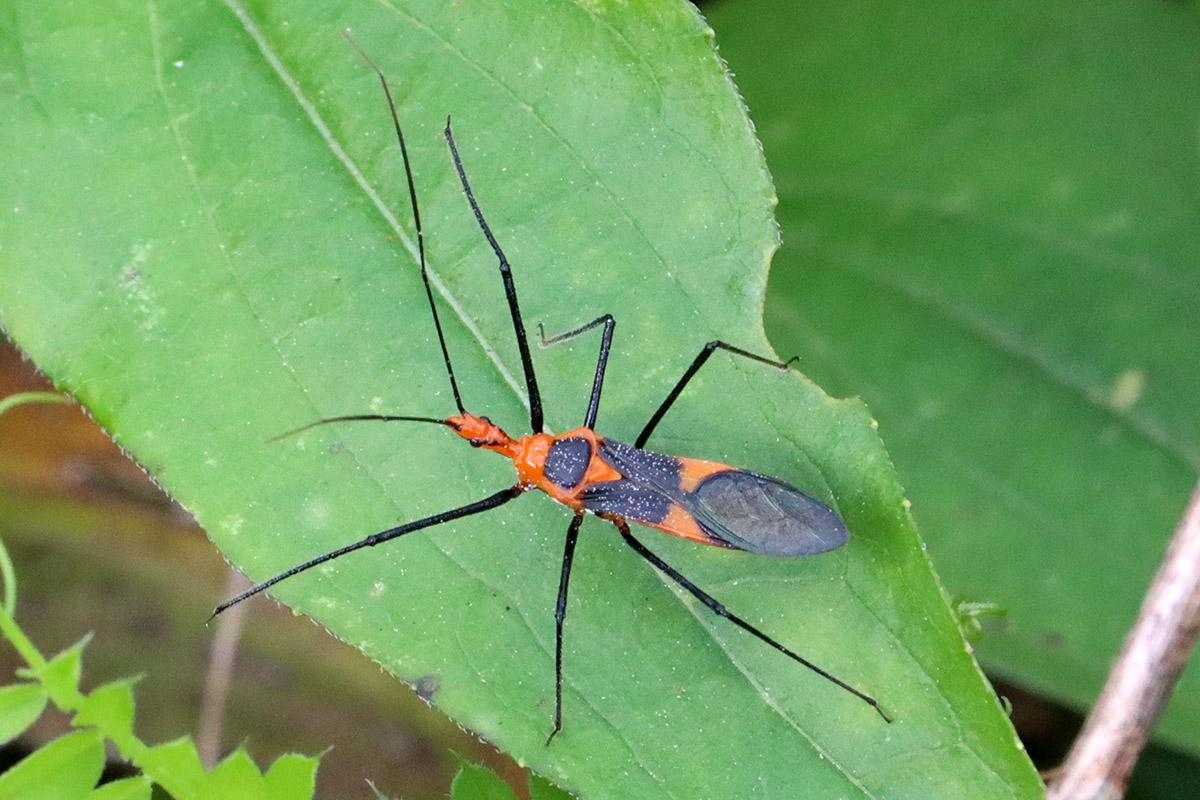
I don’t know if this is the same individual I had seen the day before, now molted into adulthood. Or maybe we have multiple assassins.
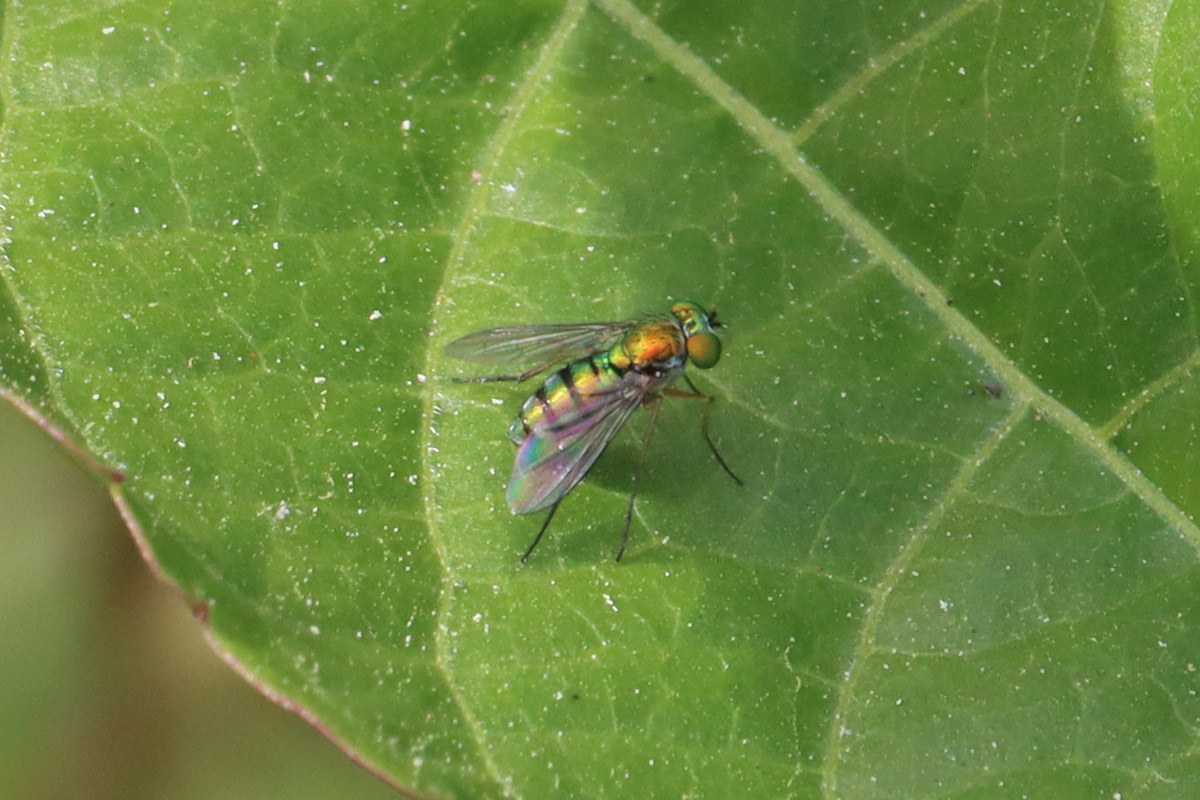
Here’s another killer. Long-legged flies hunt small insects, including aphids.
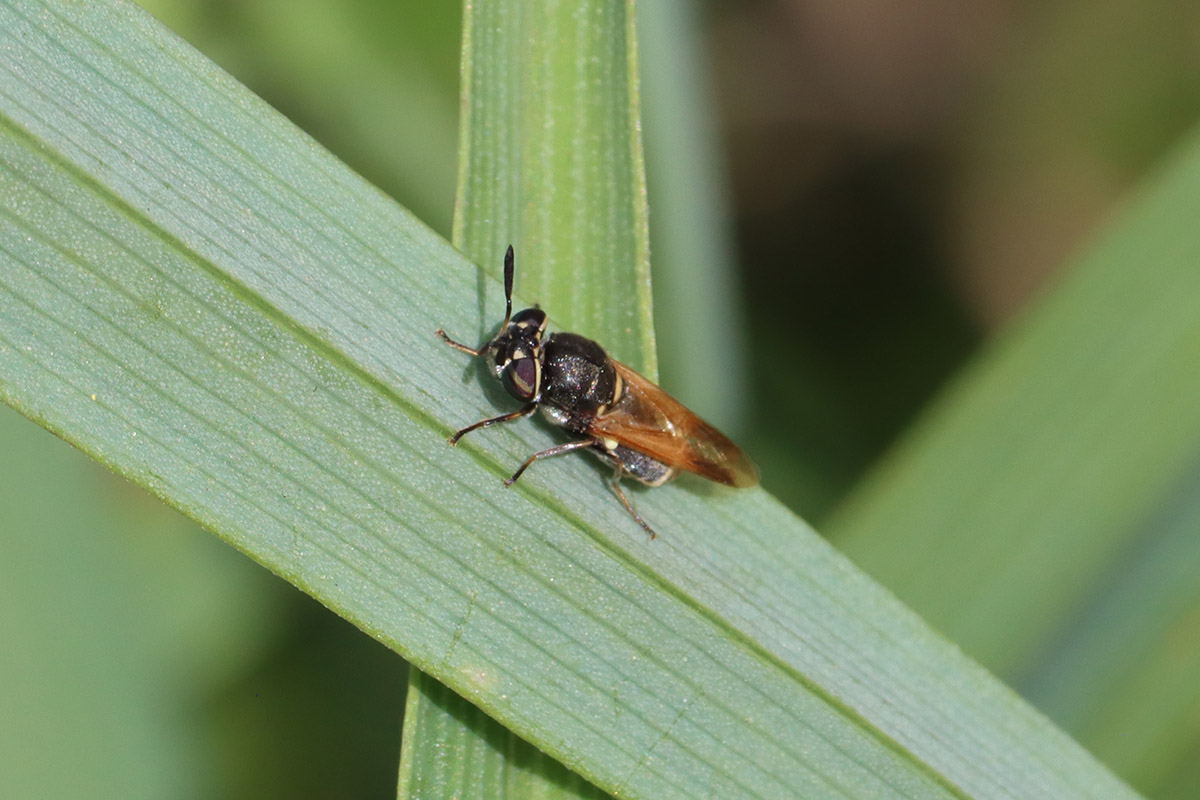
This is a species of fly I first saw in our yard in late November. Many of the species I saw at the end of last year, before most insects went dormant, have been appearing now in spring. Here in this yard or somewhere nearby, they’re finding suitable habitat to overwinter. This may be in the leaf litter I let sit over the winter.
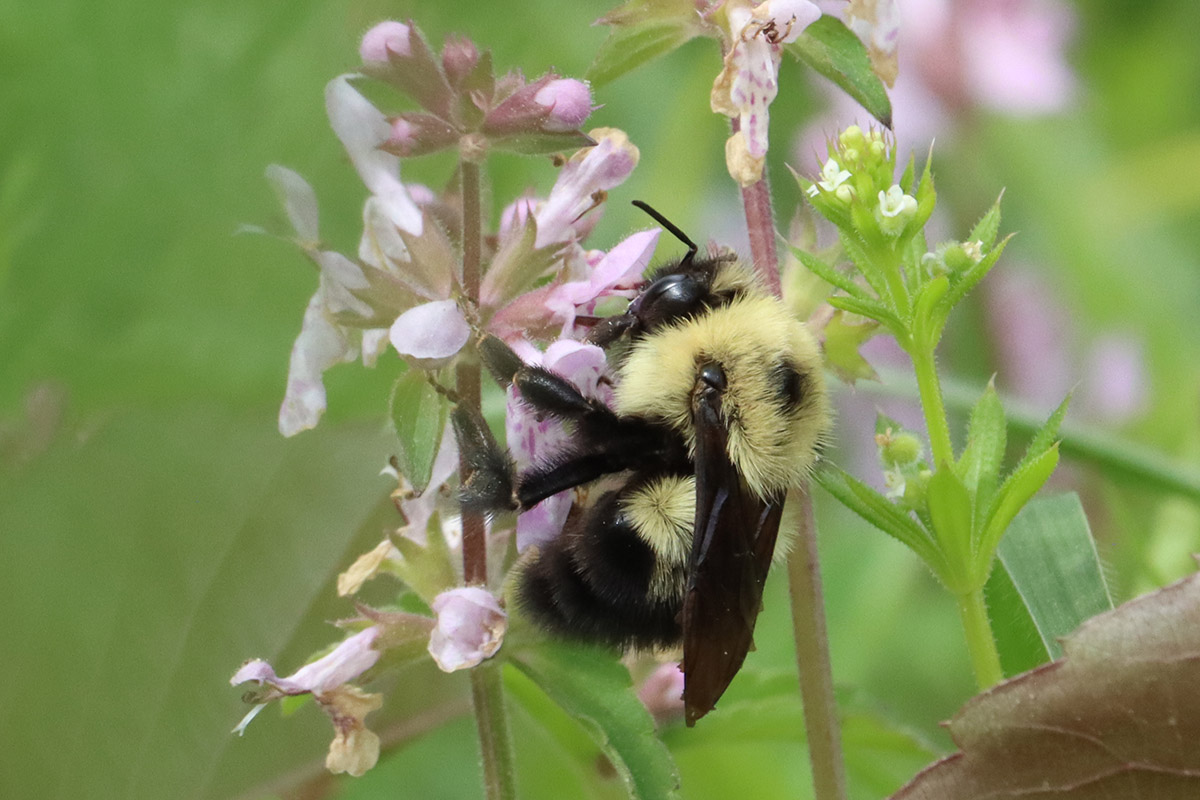
I like this bumblebee photo better than yesterday’s.
March 23, 2023
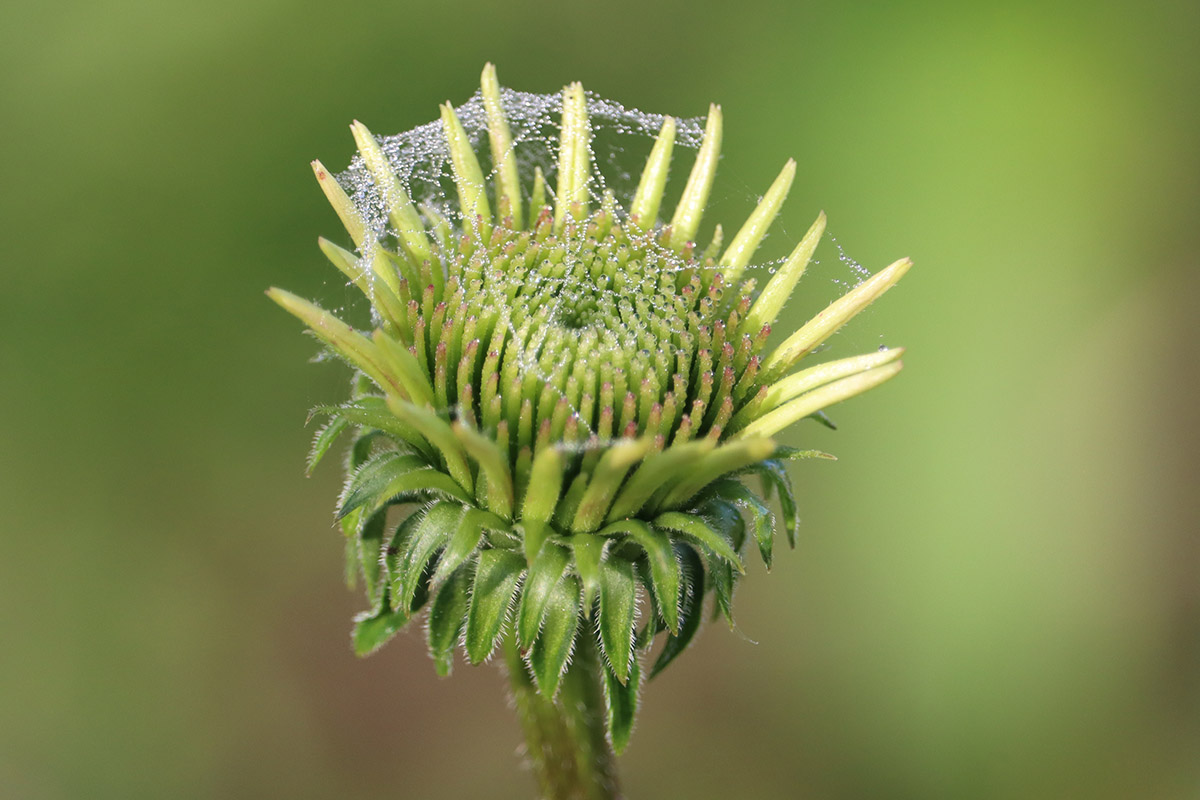
Our purple coneflowers are almost ready, and a predator is already thinking about those pollinators flying in.

I watched this beetle run from our driveway into the front flower bed, where it dove under some fallen leaves.
March 27, 2023

On of my all time favorite caterpillars. They skipped out on our Meyer lemon tree last year, but we have now have a tree of all new leaves- soft and easy to eat. The tree had made quite a few a flowers, but they’ve all since fallen off. I’m just happy it’s alive and letting me watch bird poop caterpillars turn into large, ornate butterflies.
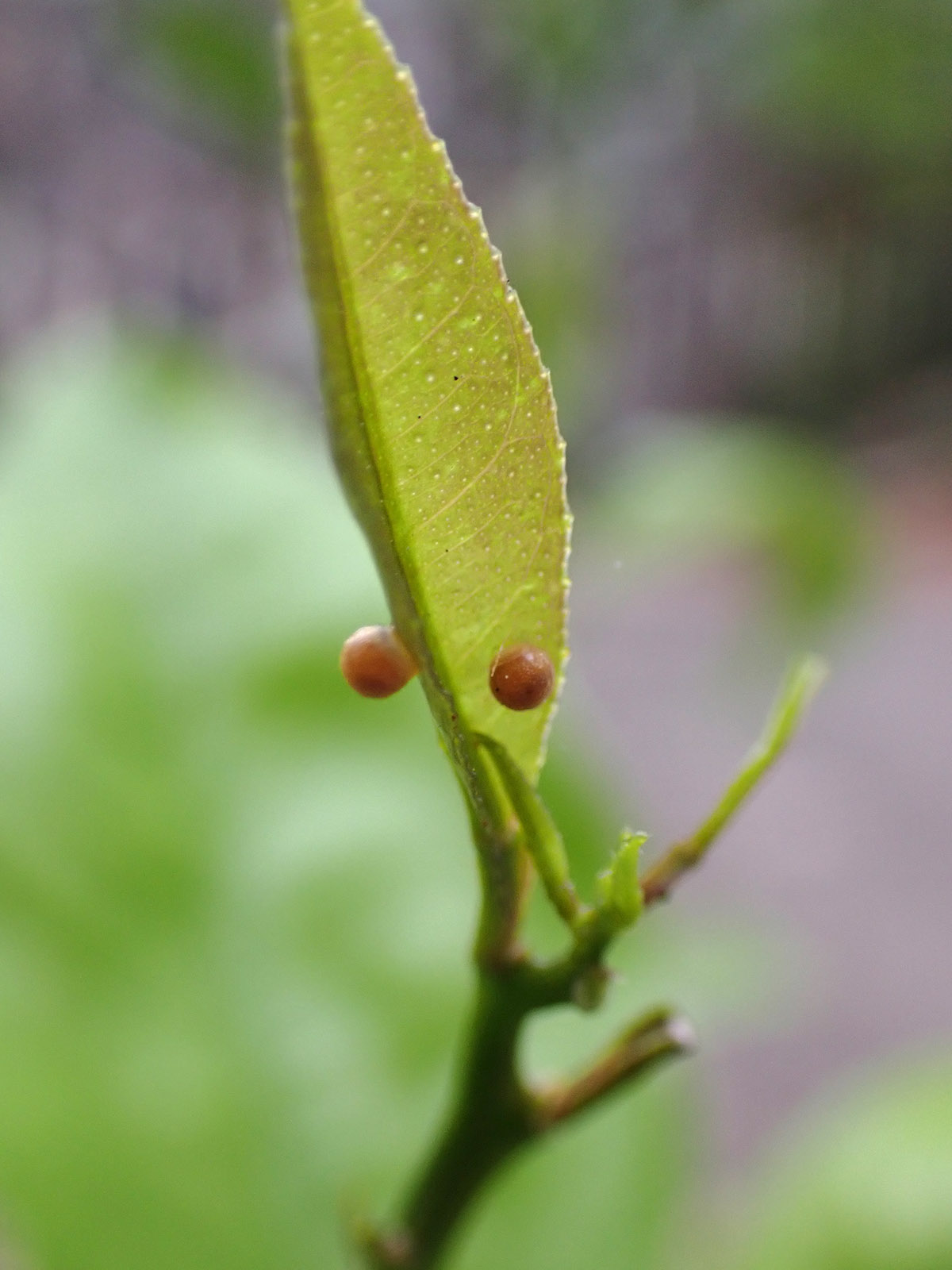
I saw these two giant swallowtail eggs on a leaf in the morning…
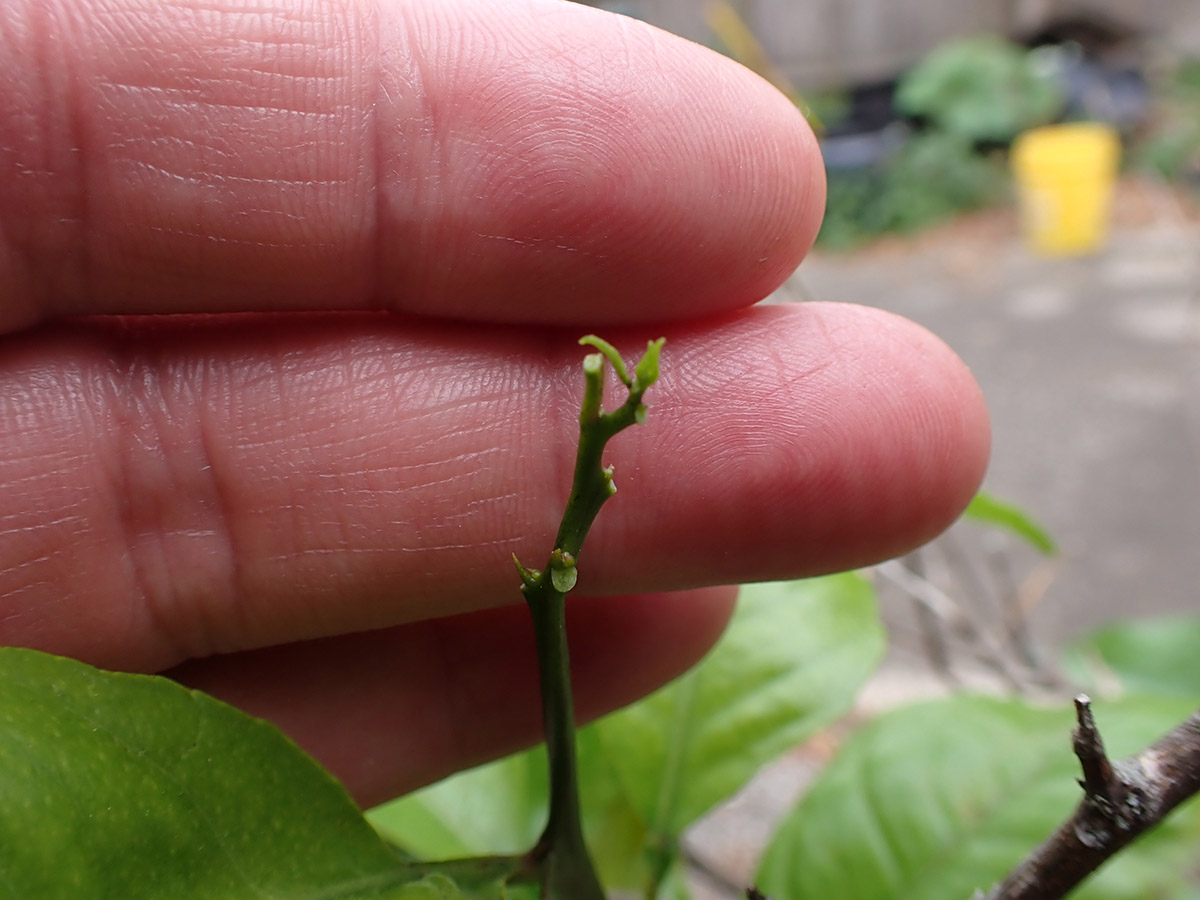
And by the afternoon, they’d been eaten. I couldn’t find the caterpillars, though.
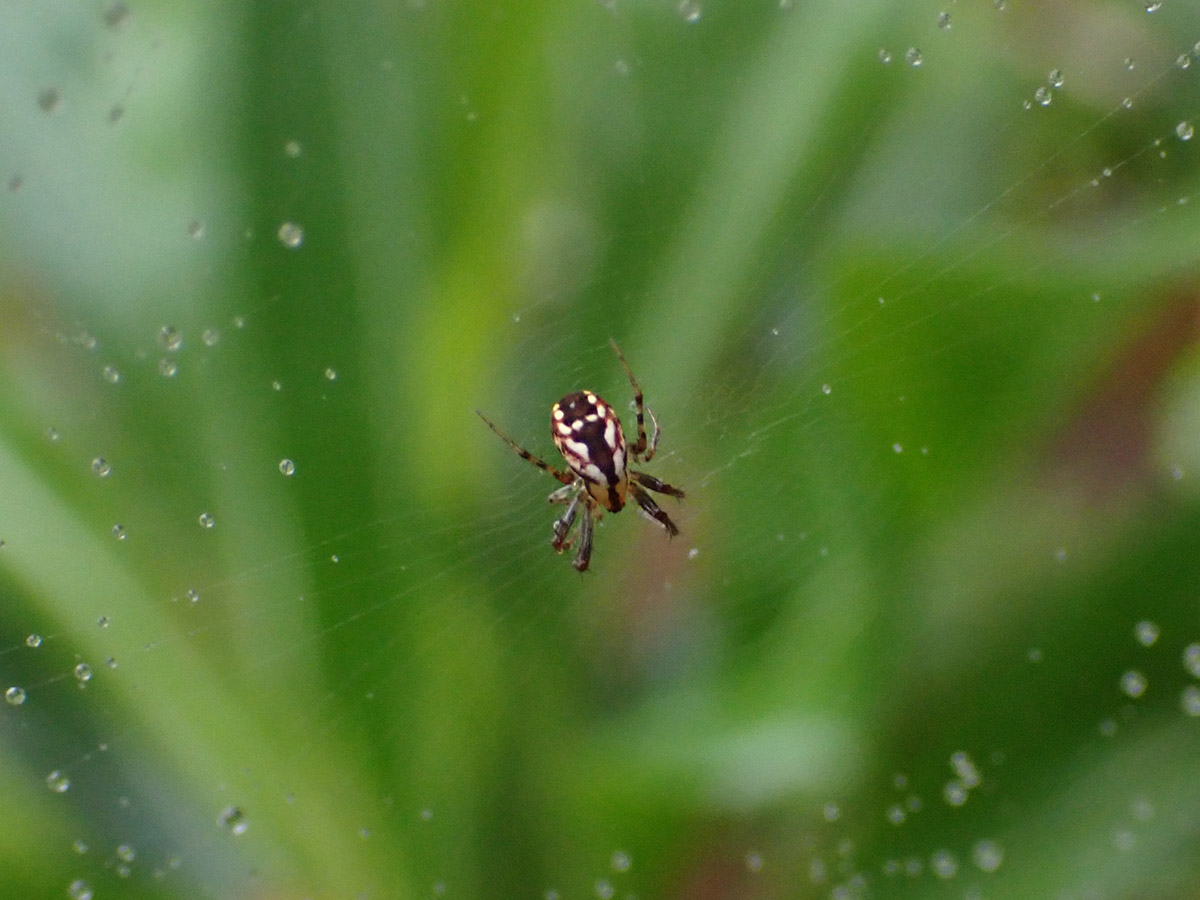
Here’s a spider I might never have noticed had I not watered plants around it.

I write this a lot about caterpillars- less than half become adults. The rest become part of the food web.
March 28, 2023
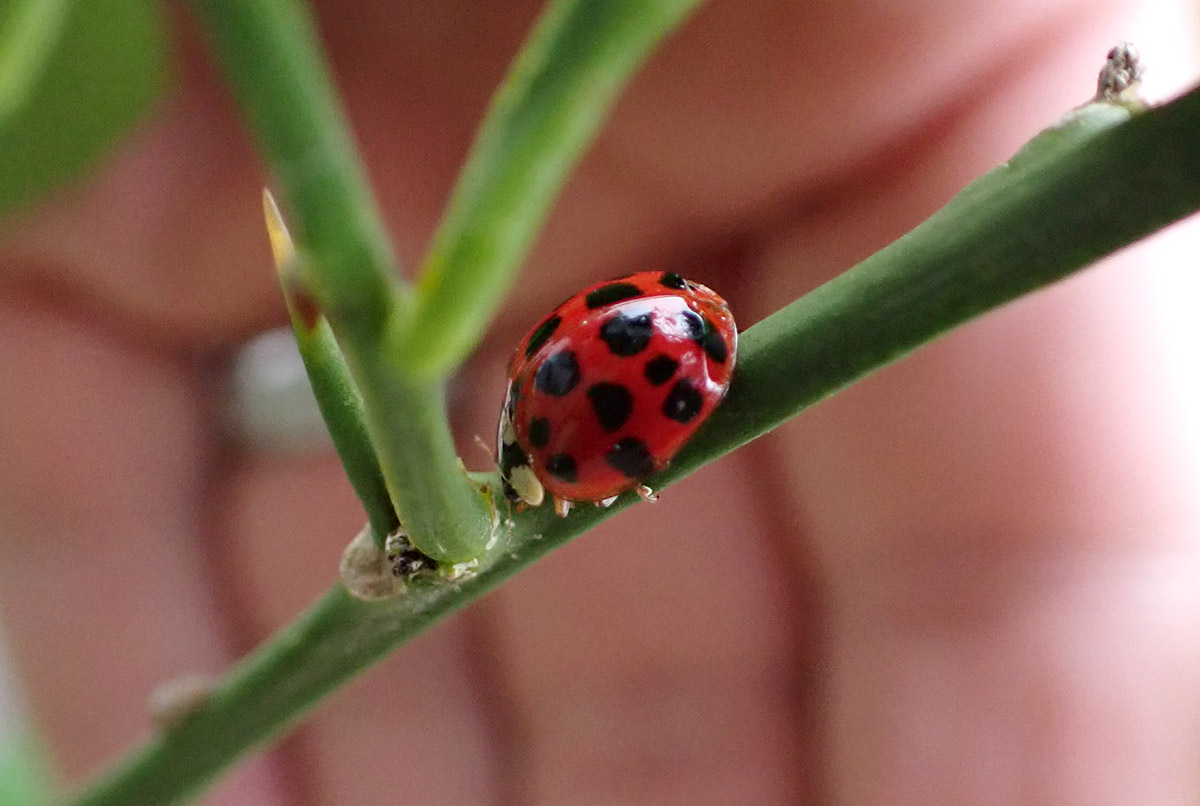
Yesterday, two giant swallowtails seemingly hatched ate the leaf on which their eggs sat. But I never saw them. I can’t think it’s a coincidence that the next day I see a caterpillar predator on the same plant.
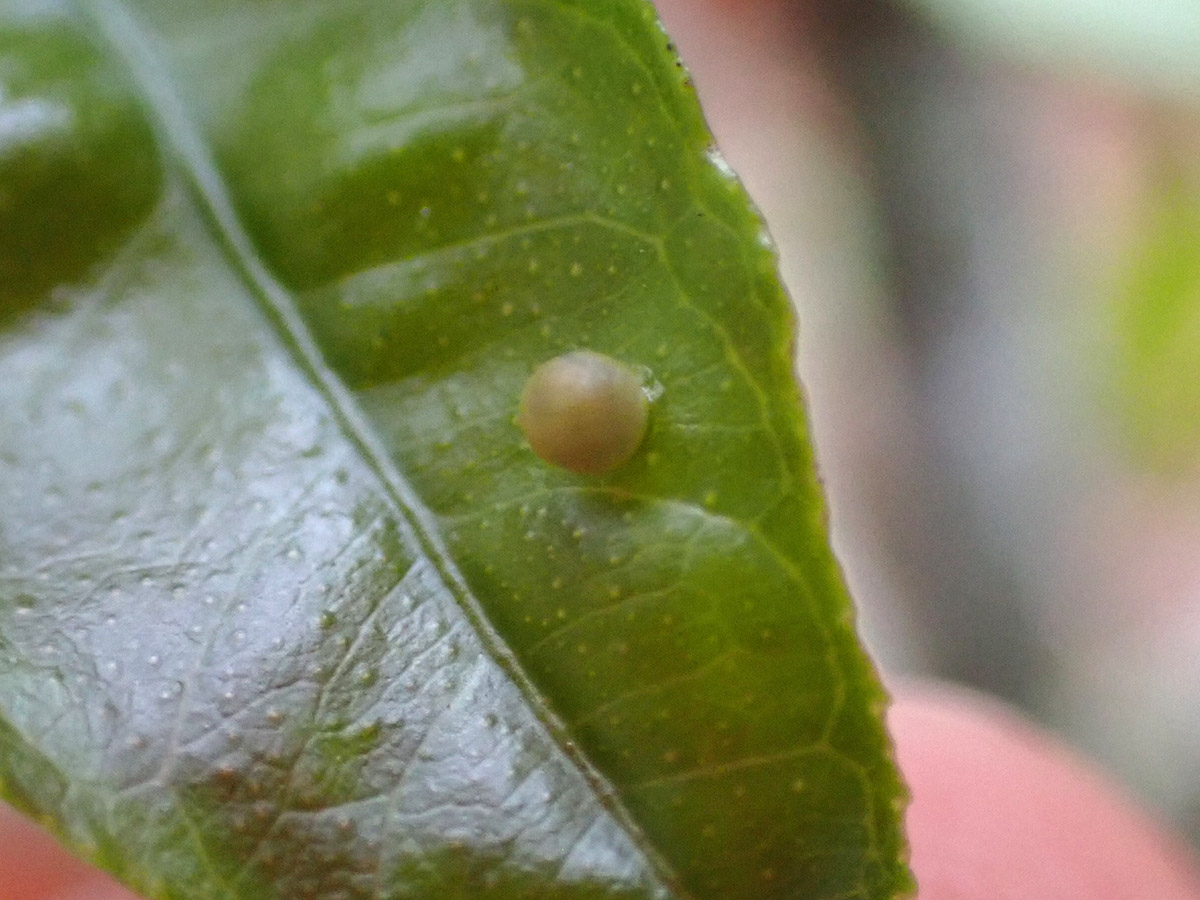
But here’s another egg. And the first caterpillar is still alive, and getting larger by the day.
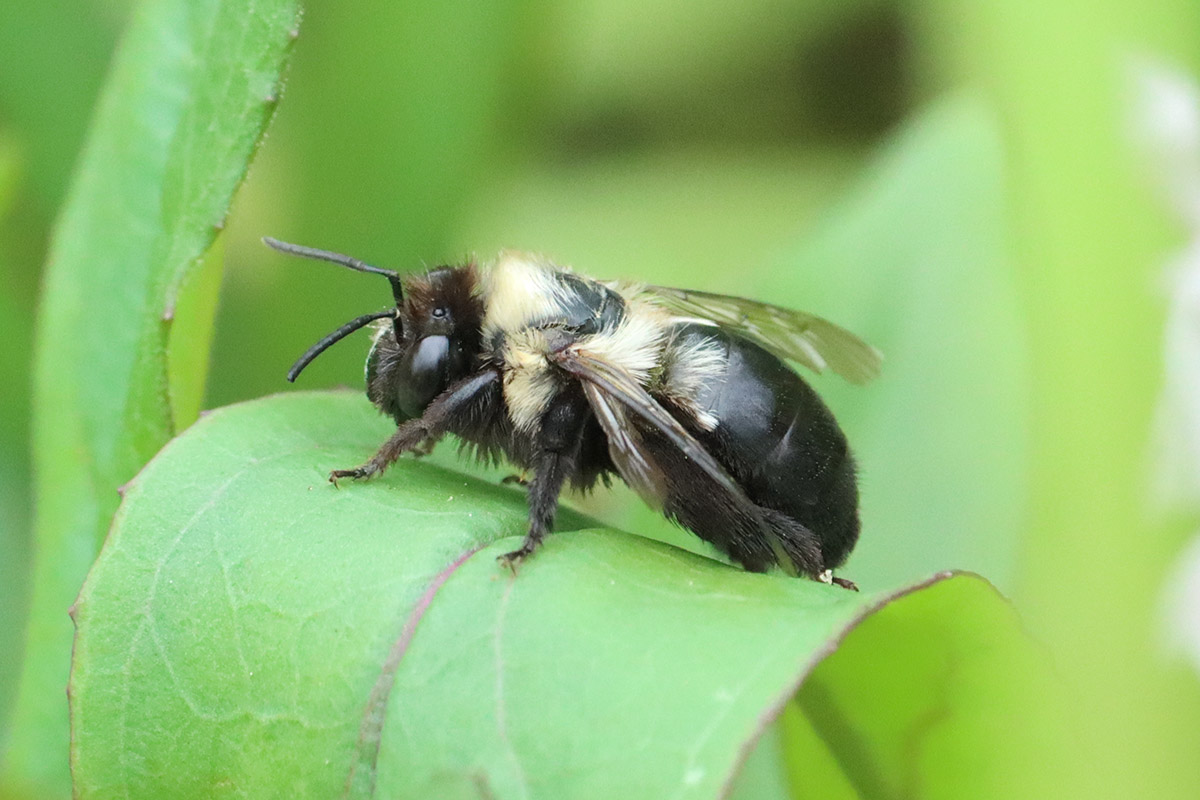
Every once in a while I catch a bee taking a rest from all its eating. This is my chance to photograph it and really get to see it. We still have at least four active in the yard at any time, on blueberry and Florida betony flowers.
March 29, 2023
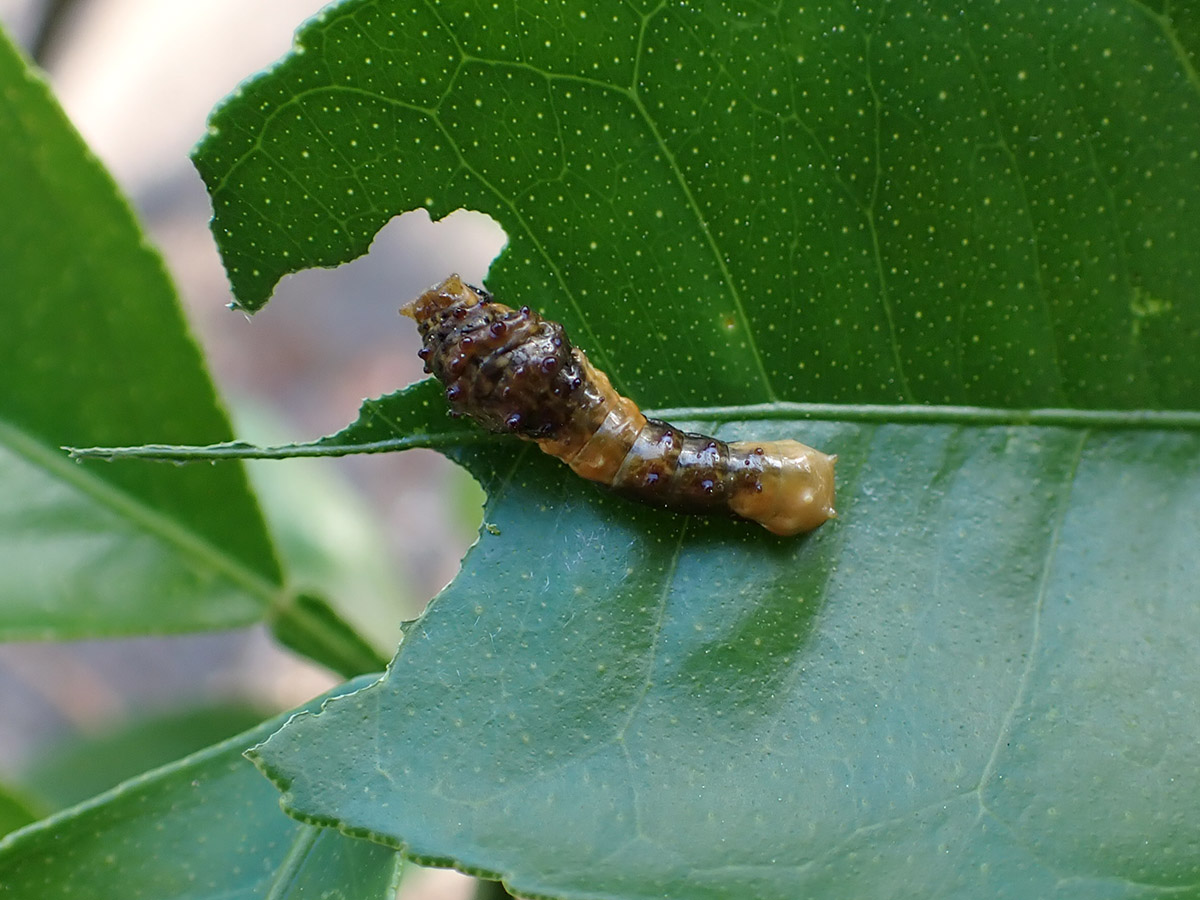
This caterpillar has grown, and it’s getting hungry.
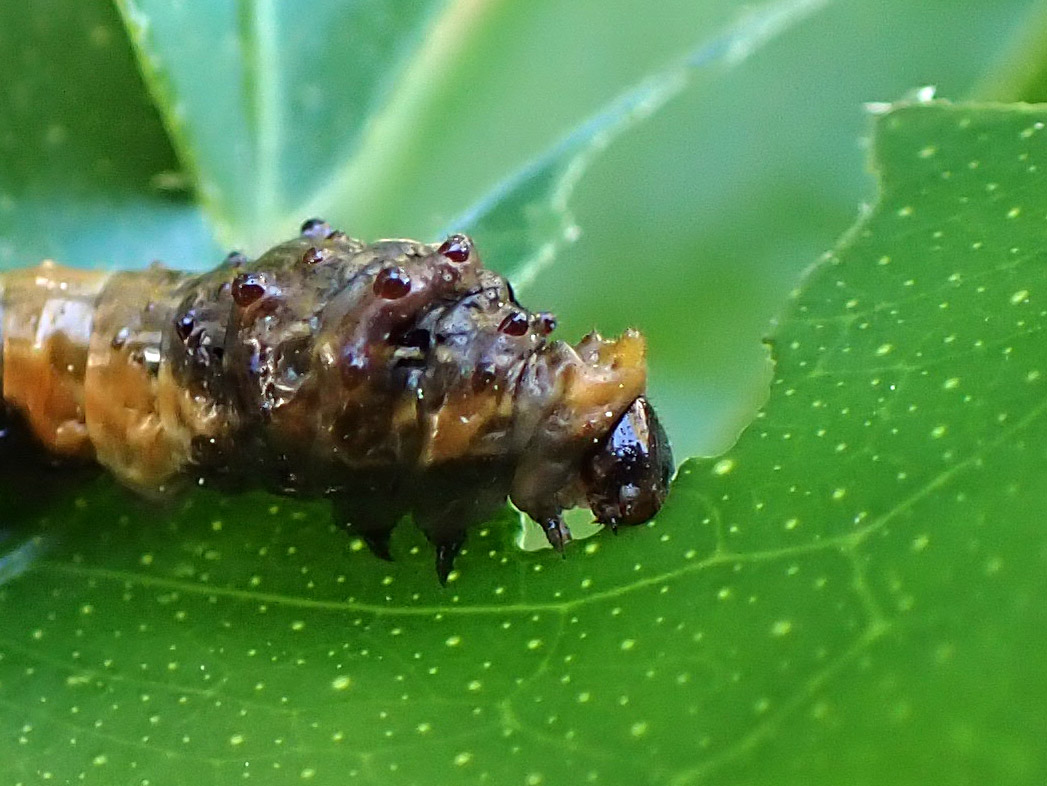
So cute.
March 31, 2023

The purple coneflowers are starting to bloom and are already receiving visitors. I mostly see four-toothed mason wasps hunting for caterpillars to feed their larvae, or on beebalm when it blooms in the late summer.

Our yard’s first Poey’s furrow bee of the year. These are a common yard bee, and we see them into the late fall.
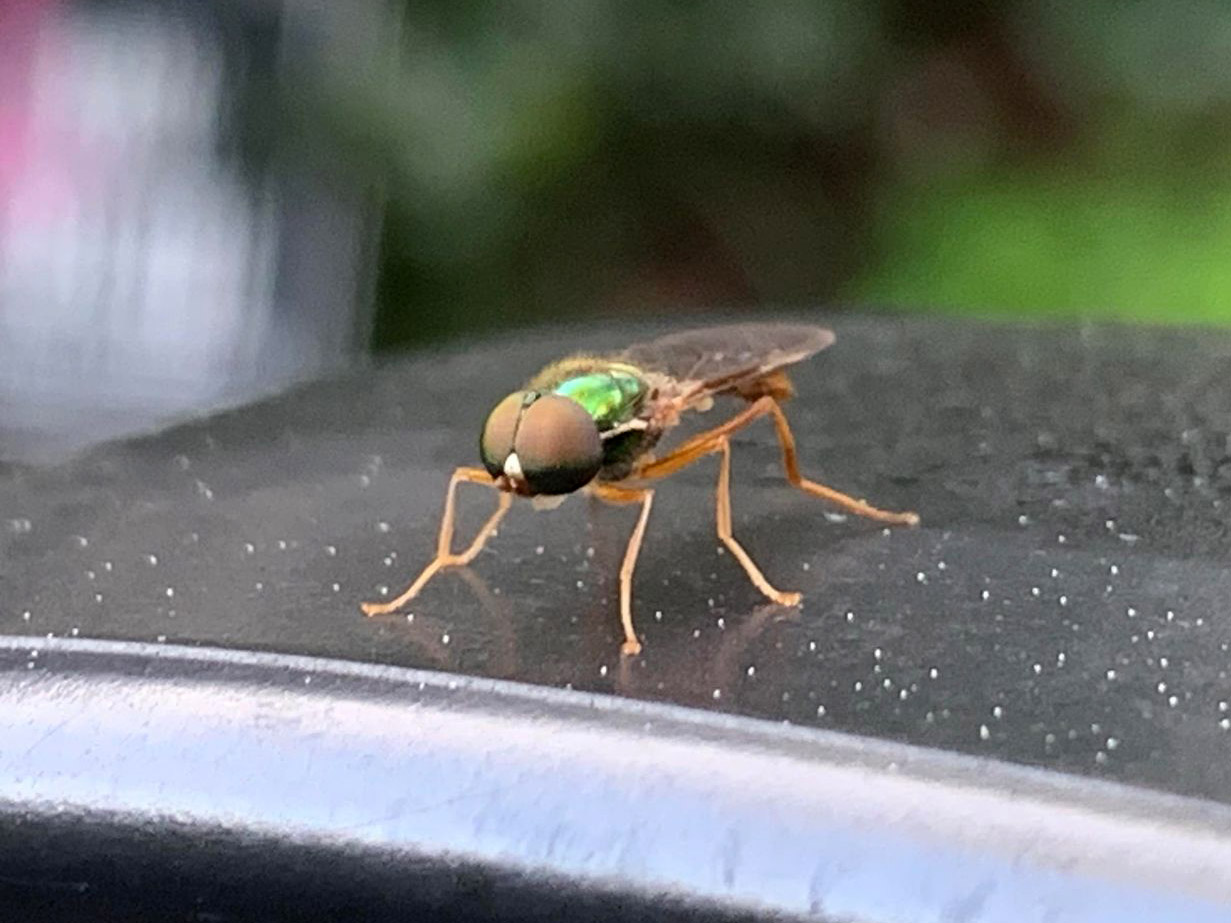
I apologize for the cell phone pic. This was on our side mirror as I was getting ready to pull out of the driveway in the morning.
April 2, 2023
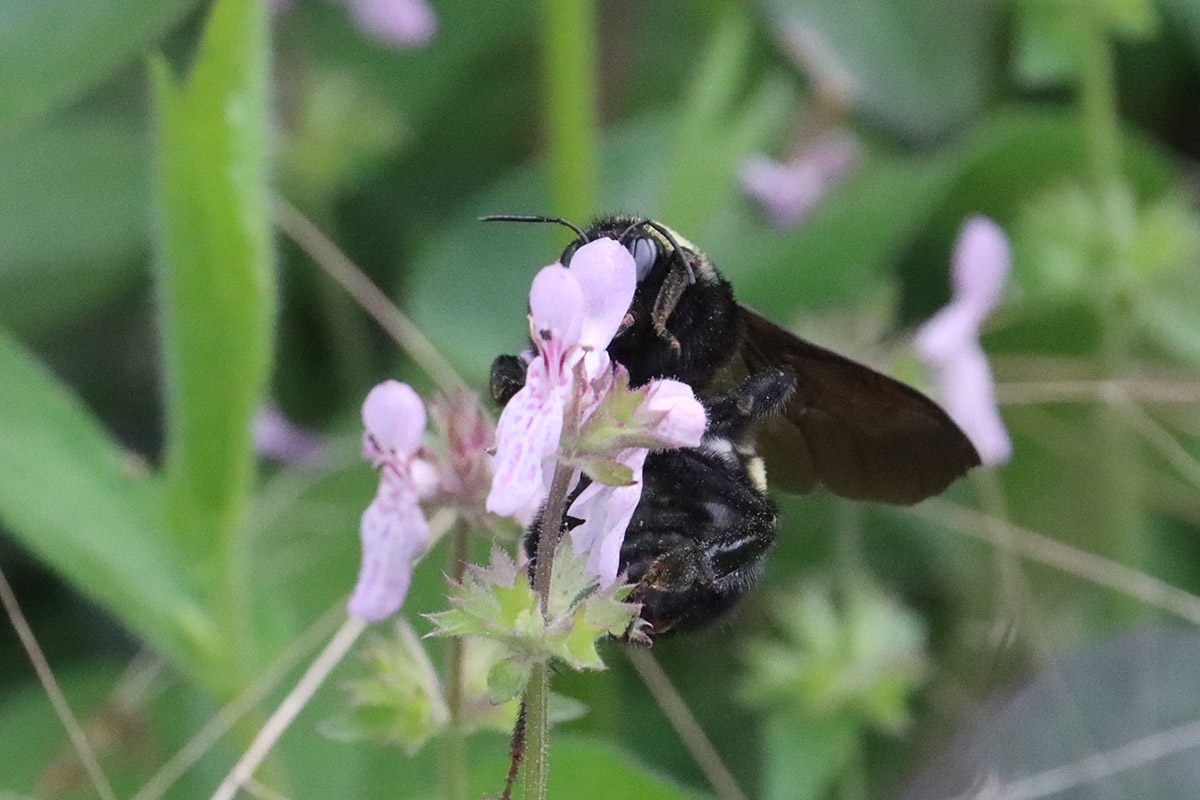
I hadn’t seen American bumblebees in the yard before last year, and so I’m happy to see it return. Bees are loving the betony this year. But they don’t spend a whole lot of time on these small, low lying flowers.
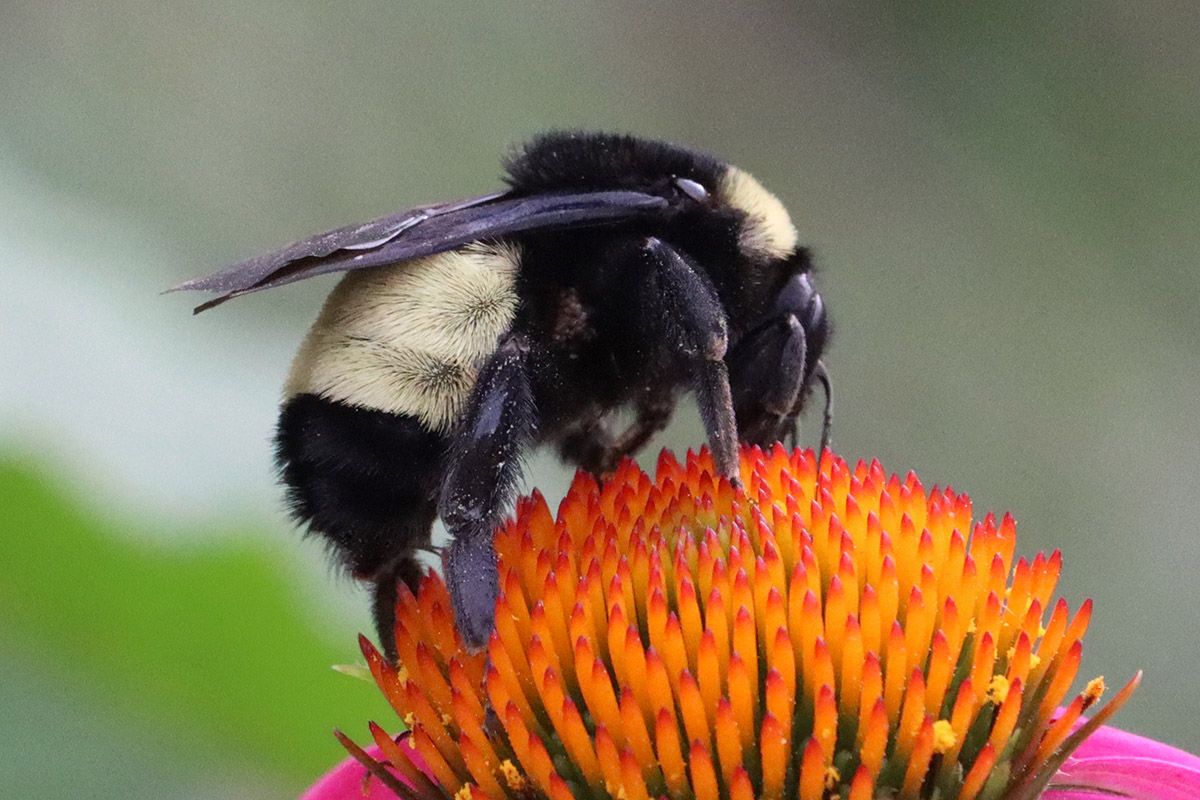
That’s more like it. Bees sit easily on purple coneflowers, and take their time feeding on them. Great for photos.
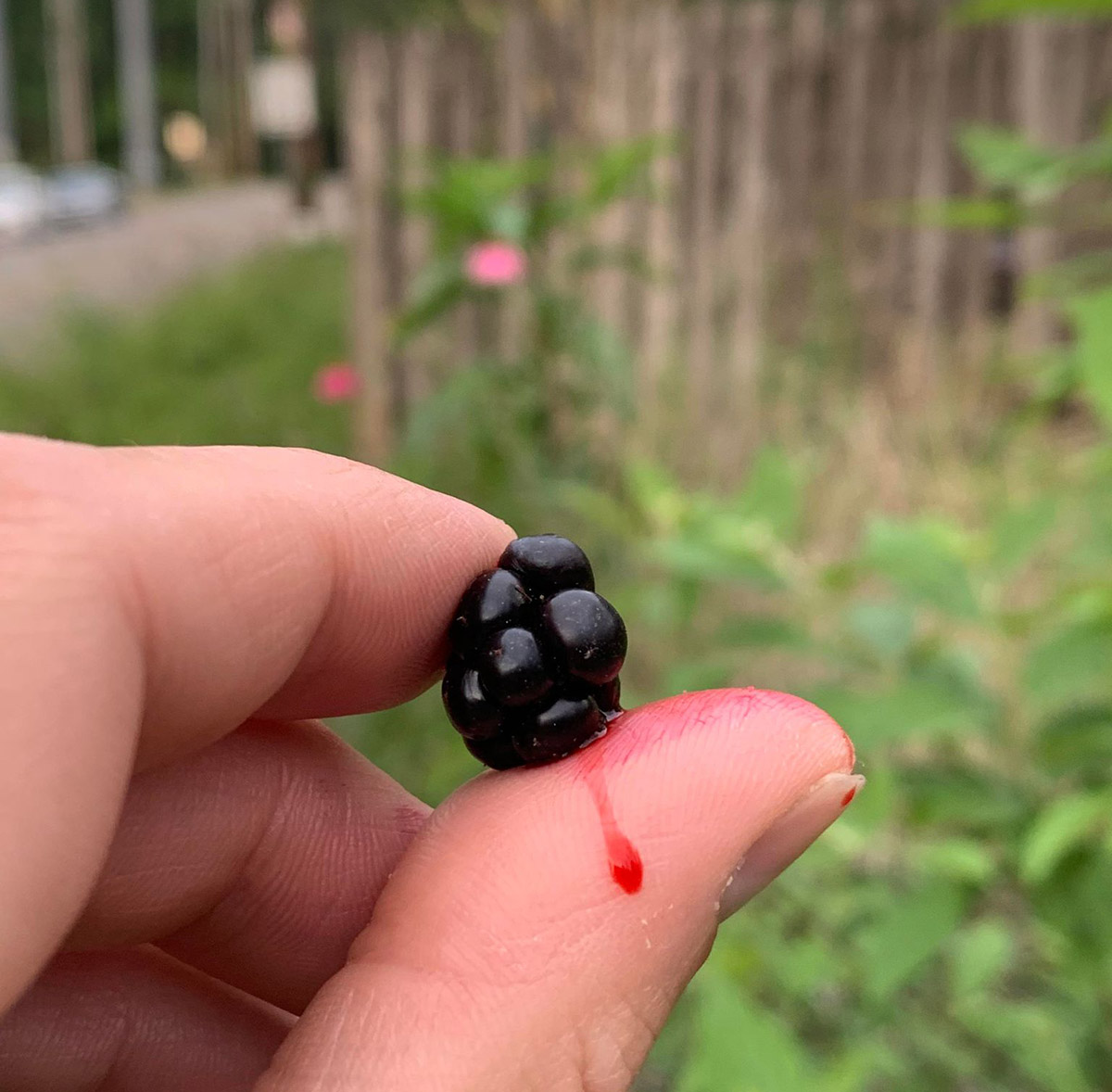
It was a prolific year for dewberry flowers, and today the boys and I picked a few ripe berries. I do need to cut the vines back before they take over the flower patch (note the coneflowers out of focus over my hand).
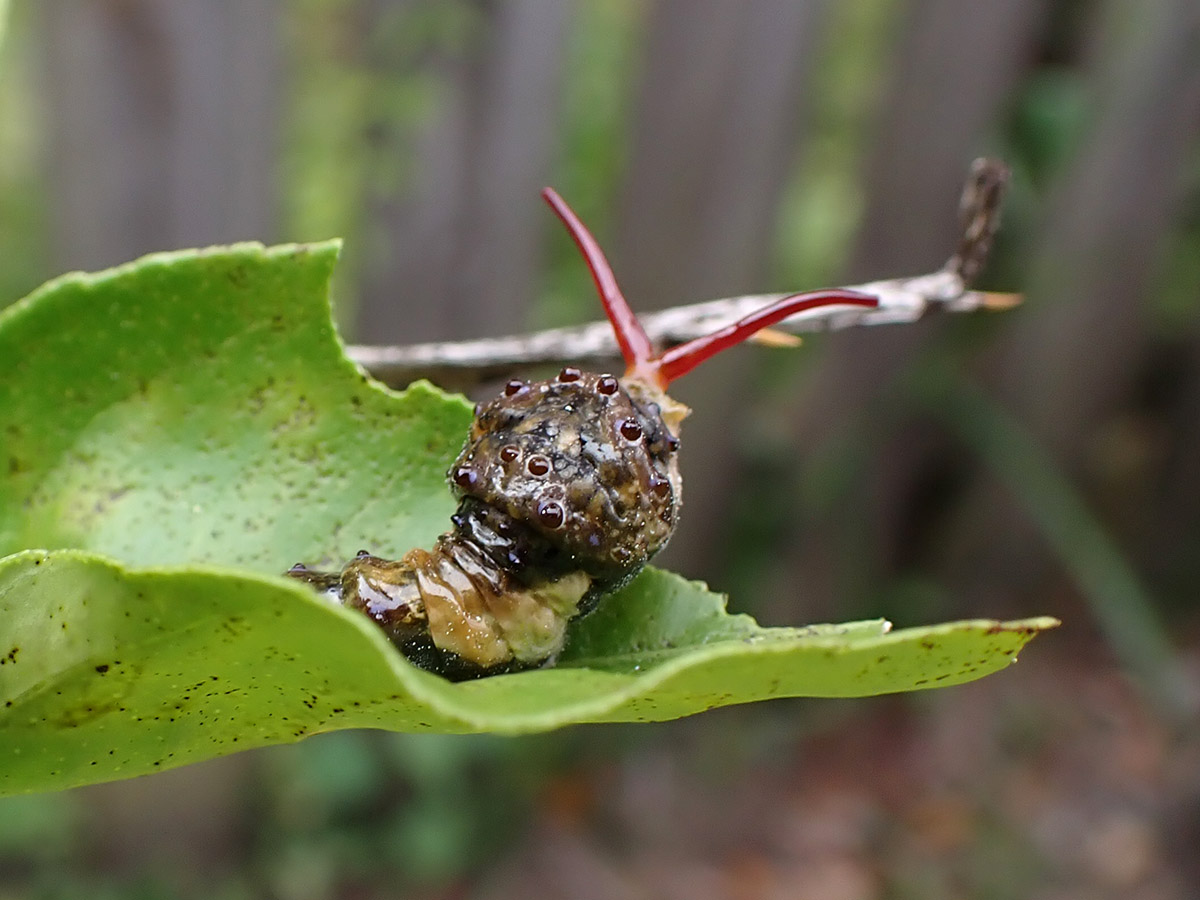
The bird poop caterpillar has gotten larger, and was eating voraciously. I leaned in to take a video, but knocked the branch above it, shaking the Meyer lemon tree. So instead of a video, I took a photo of it sticking its tongue out at me. This is a defense mechanism, mimicking a snake.
April 3, 2023
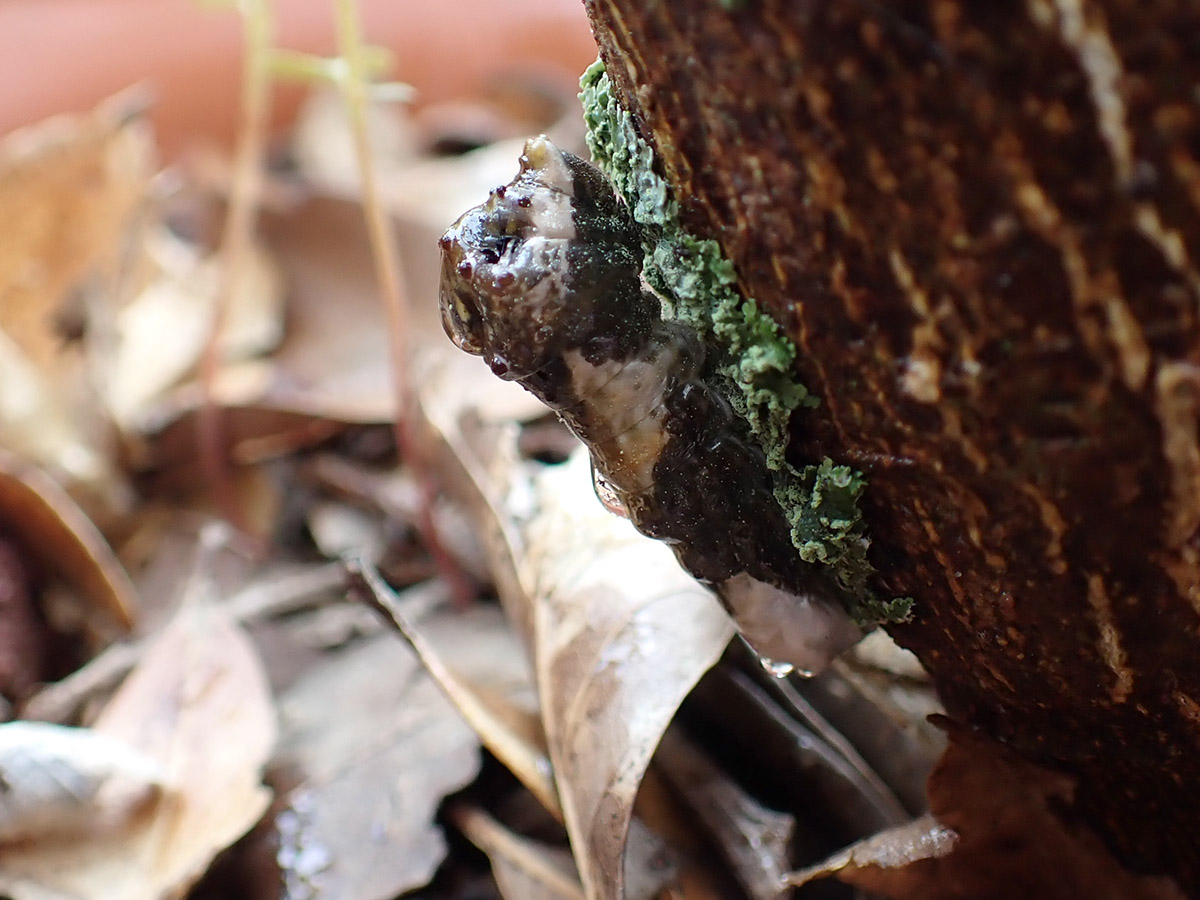
I couldn’t find the bird poop caterpillar this morning. Knowing that larger caterpillars sometimes leave their feeding area and rest, I looked at the lemon tree’s pot and in the immediate vicinity. Here it is resting at the base of the tree.
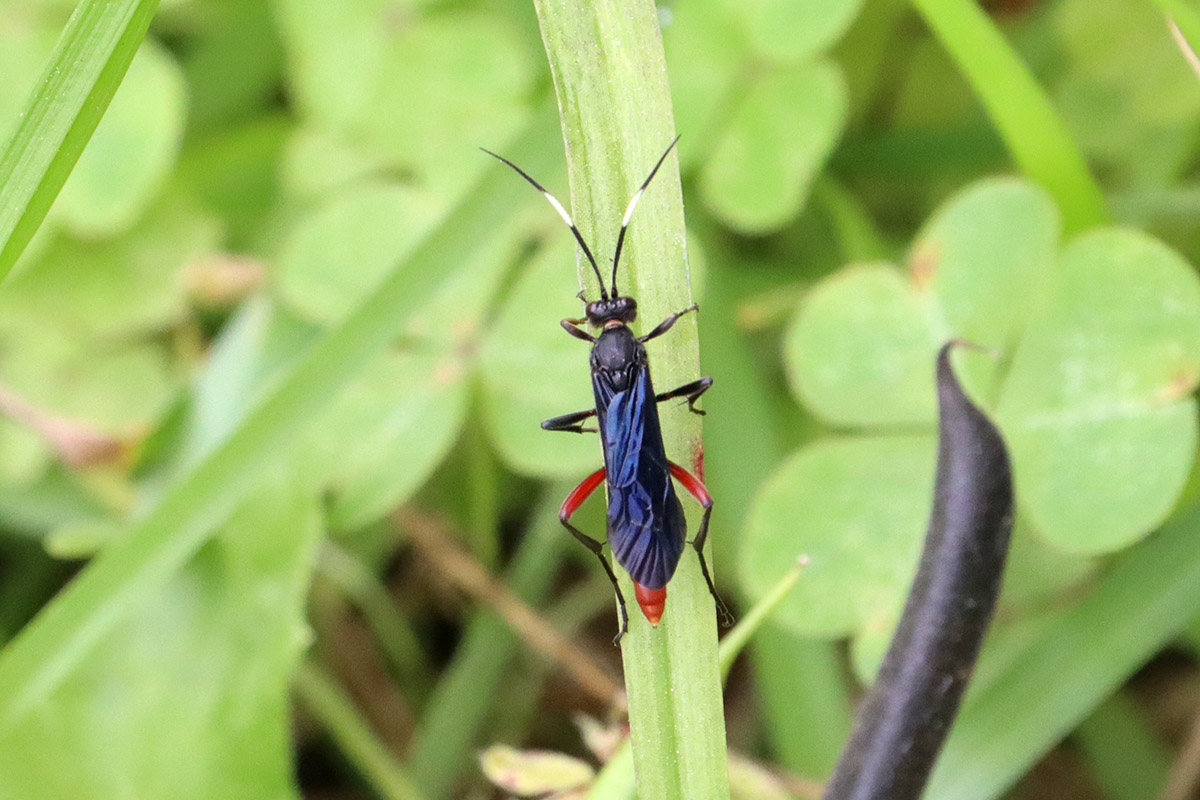
Here’s a wasp I’ve been seeing over the past few days. Ichneumon wasps are parasitoid breeders, laying their eggs into a host insect which their larvae then devour.

The blueberry bushes flowers have mostly become berries, and the Florida betony is past its peak. I’ve been seeing these bees for several weeks now, and I feel like they may soon be done for the year.
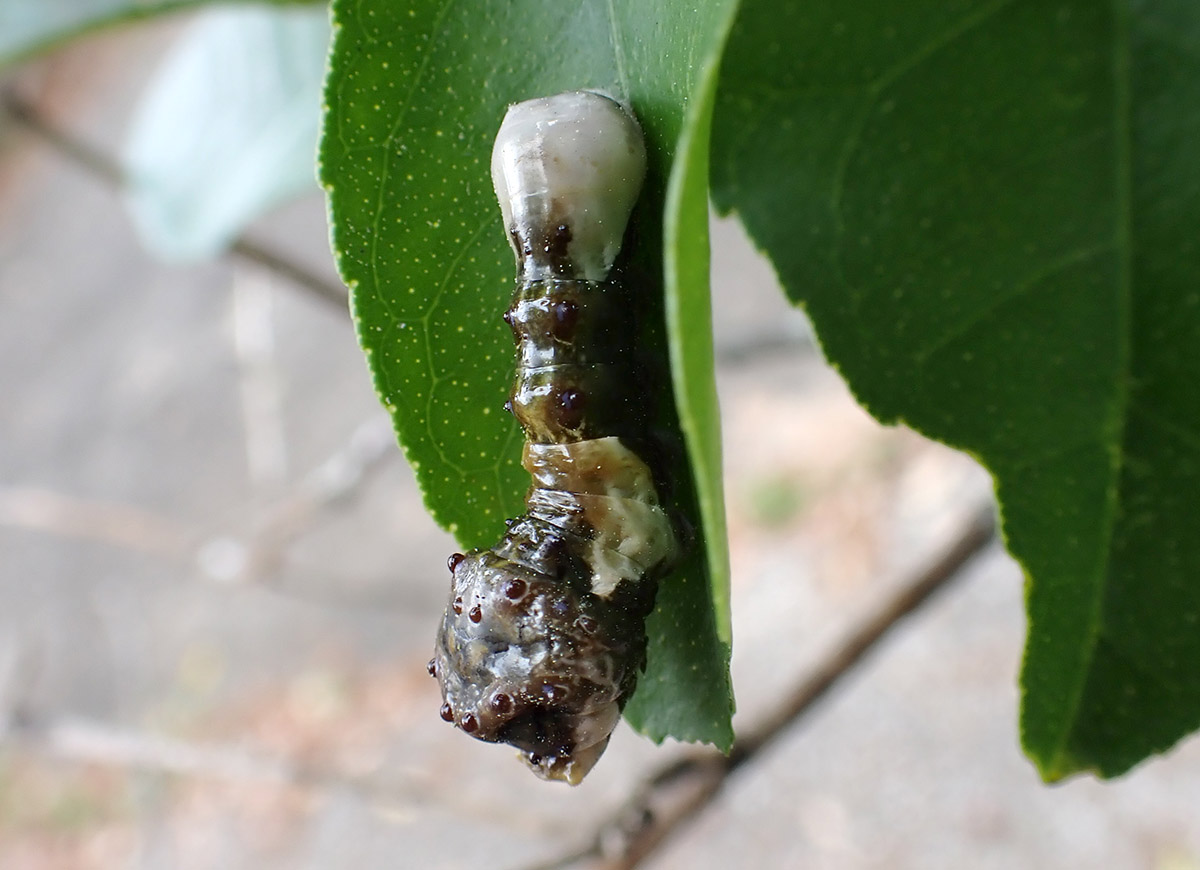
My wife came to tell me that the bird poop caterpillar was going to town on a leaf; its rest is now over. I snapped this just before the quick thunderstorms that swept through.
April 4, 2023

The larger caterpillar spent some time this morning with its upper half in what could be interpreted as an alert position.

Meanwhile, the other egg has hatched.
April 5, 2023

I spotted this predator on our Meyer lemon tree, not far from the larger giant swallowtail caterpillar. I typically let predator dramas play themselves out with caterpillars, but we only get 2-3 bird poop caterpillars a year, and I think they’re cool. So I keep an eye on this spider.

My split-second reaction to seeing this was that the spider had gotten the large caterpillar. But no, this caterpillar has molted. This is its final larval stage, and it will soon make its chrysalis.

Was this in response to my leaning in with a camera, or to the nearby spider? I’m guessing me. This caterpillar has been hanging out on low branches, and I usually bump the plant when I go to photograph it.

I’ve seen these in the yard over the years and finally took a pic of one of these tiny, tiny things. The first thing I notice in the photo is eight legs. This is not an insect, but an arachnid. Specifically, a whirligig mite. Apparently, these eat other mite species. Some members of the genus have actually been used as pest control in apple orchards.
April 6, 2023
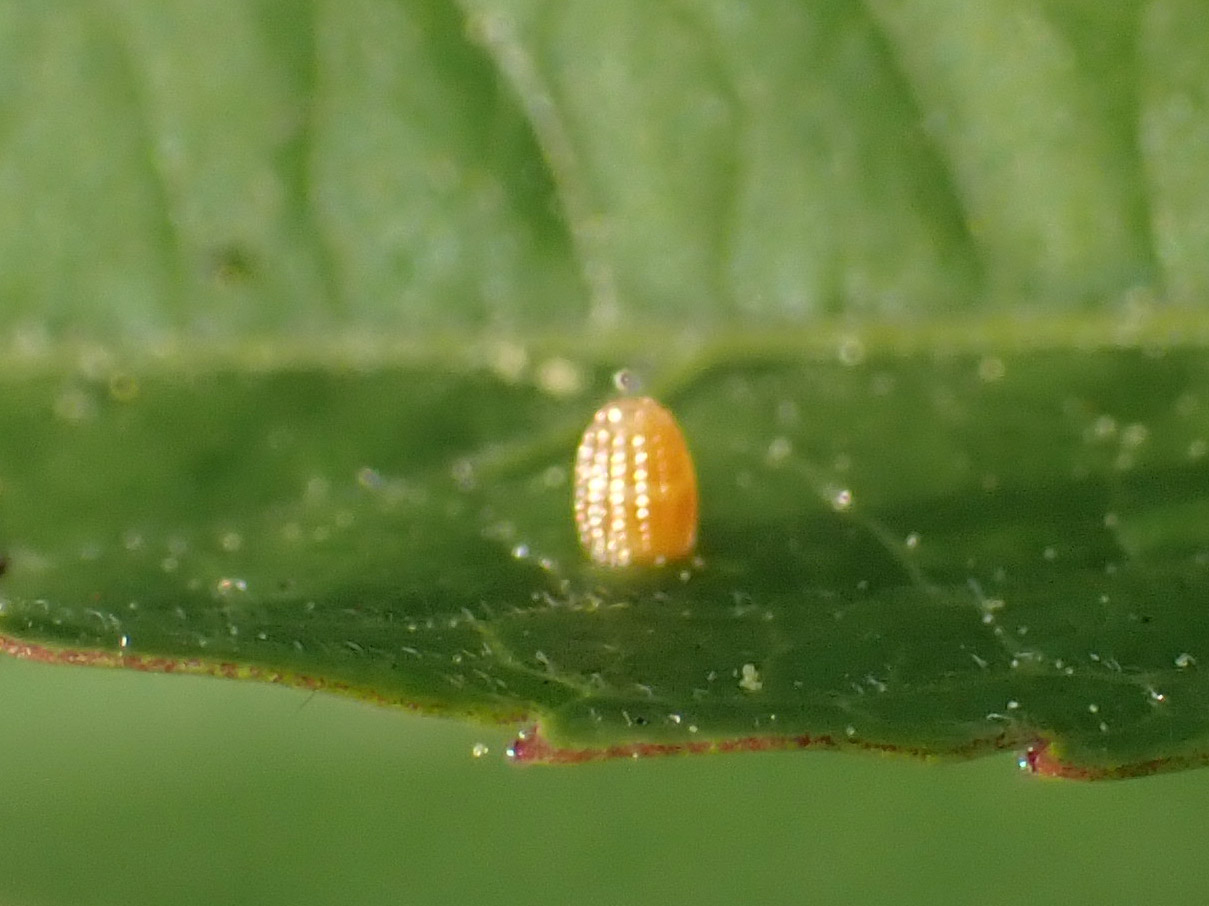
We have about twenty passionflower vines in the front pollinator area, all from the two I planted last year. And here is our first gulf fritillary egg.
April 7, 2023
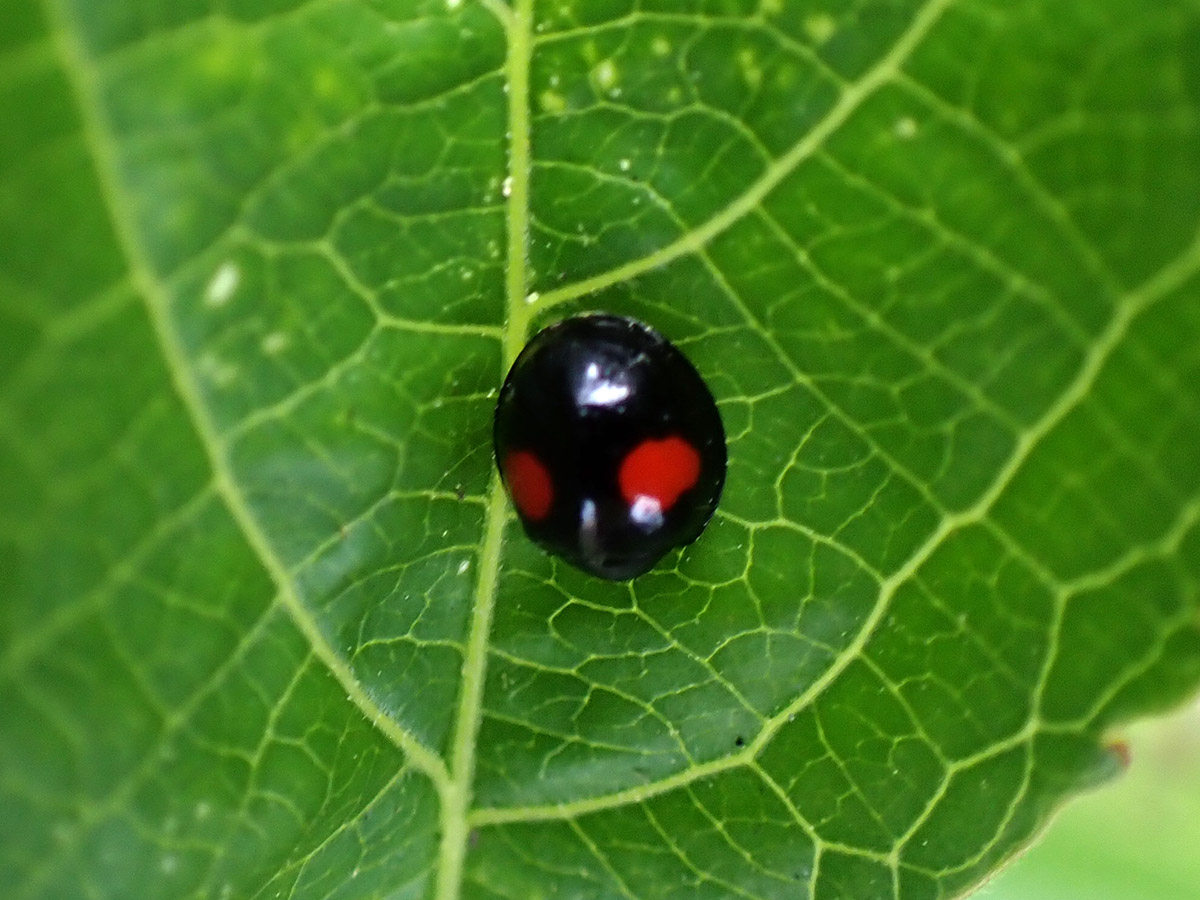
And just as we have our first eggs on the passionvine (up to two that I see on twenty or so vines), here’s a caterpillar predator on a vine. At least it’s a native ladybug species.
April 8, 2023
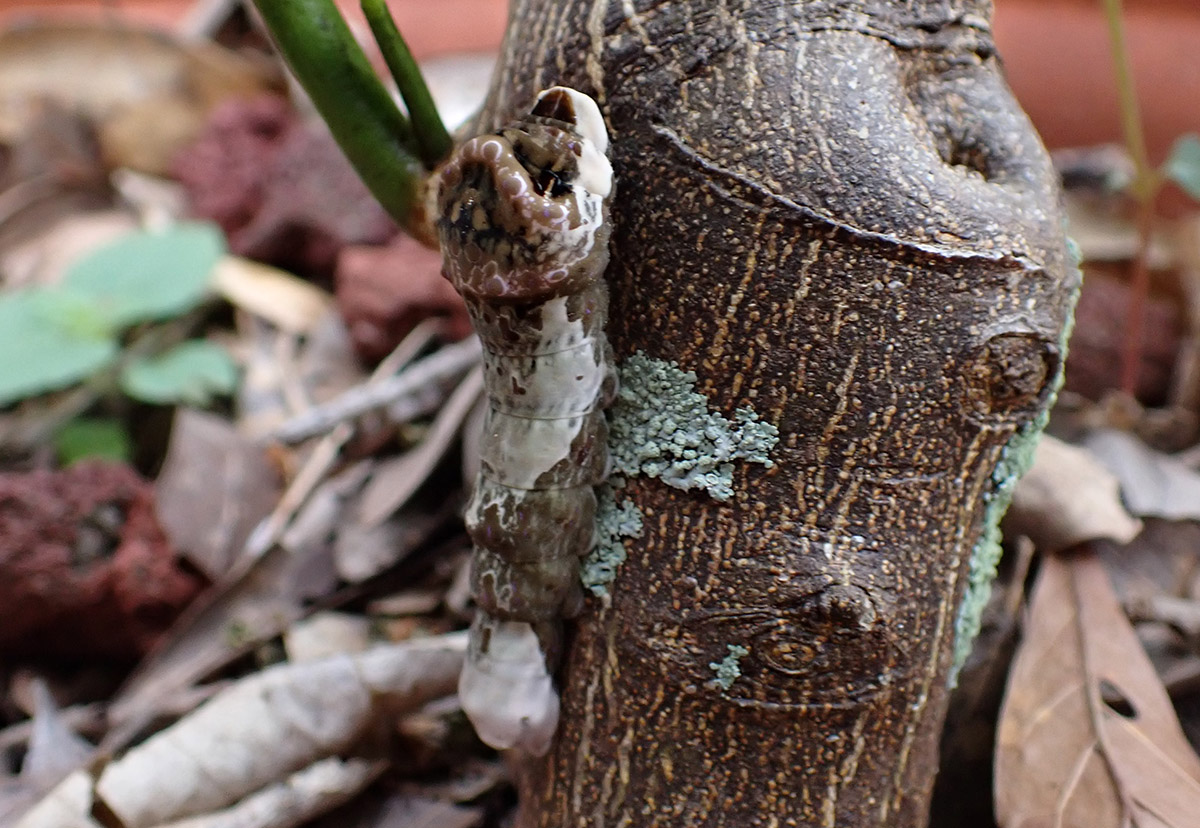
When caterpillars get to a certain size, they eat nonstop, and then disappear for a little while. Perhaps they start getting the lay of the land around their host plant, figuring out where they might go to make a chrysalis.
April 9, 2023
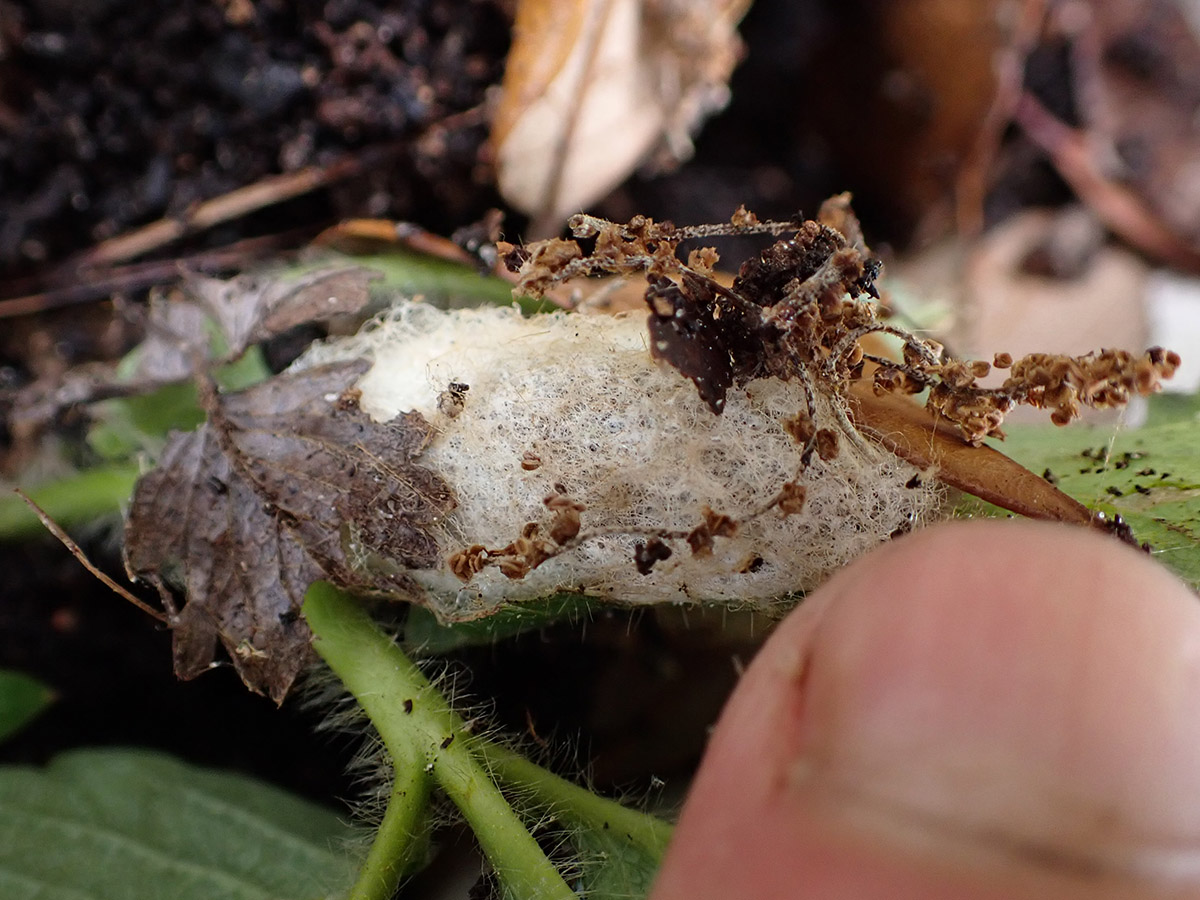
This year, Brickellia plants seeded themselves around the yard. I gave several seedlings away, and yet we still have more than we ever have. I noticed a few of them growing around a strawberry plant, so when they got to a certain size, I dug them up. If not for the Brickellia intermingling itself with the strawberry plant, I’d never have seen this. What else is hidden in plain sight in the garden?
April 10, 2023
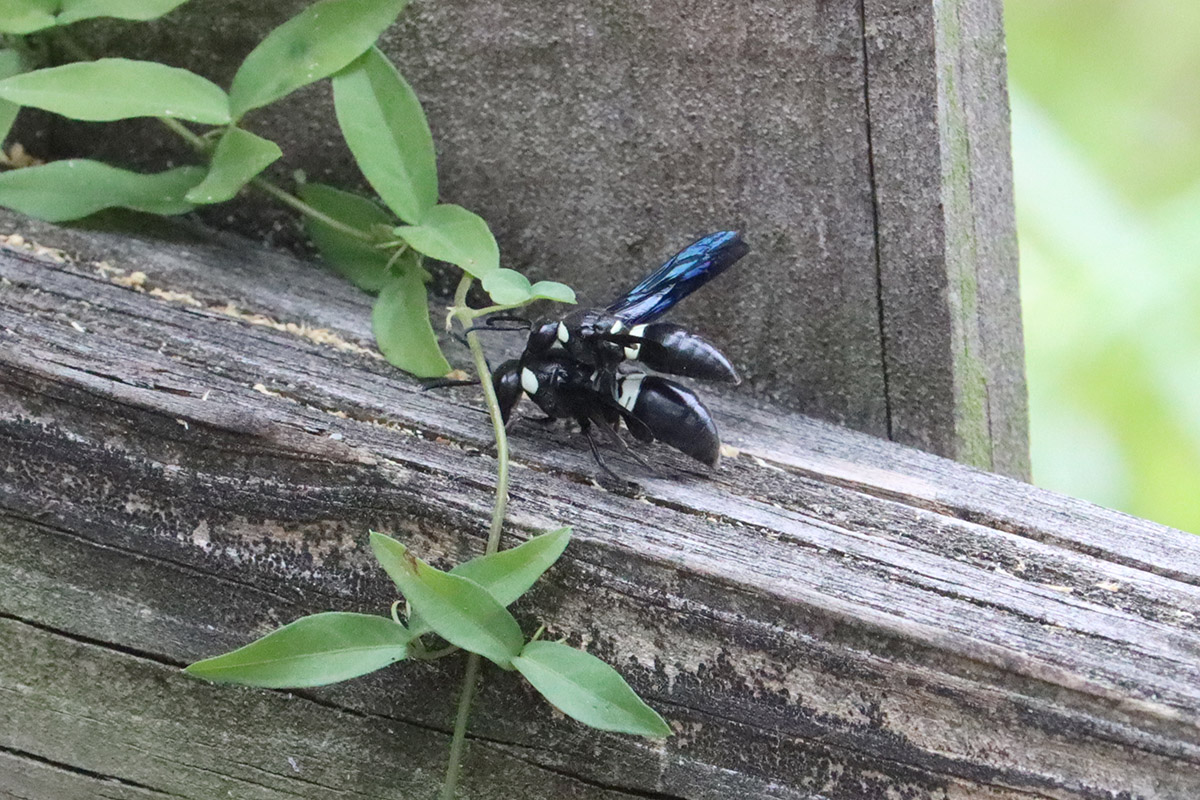
Here’s a long time resident species in our yard, and this is the first time I’ve seen them mating. I’ve been seeing four-toothed masons in the yard, both on flowers and also on other plants, where they hunt for caterpillars to bring to their larvae.
April 11, 2023
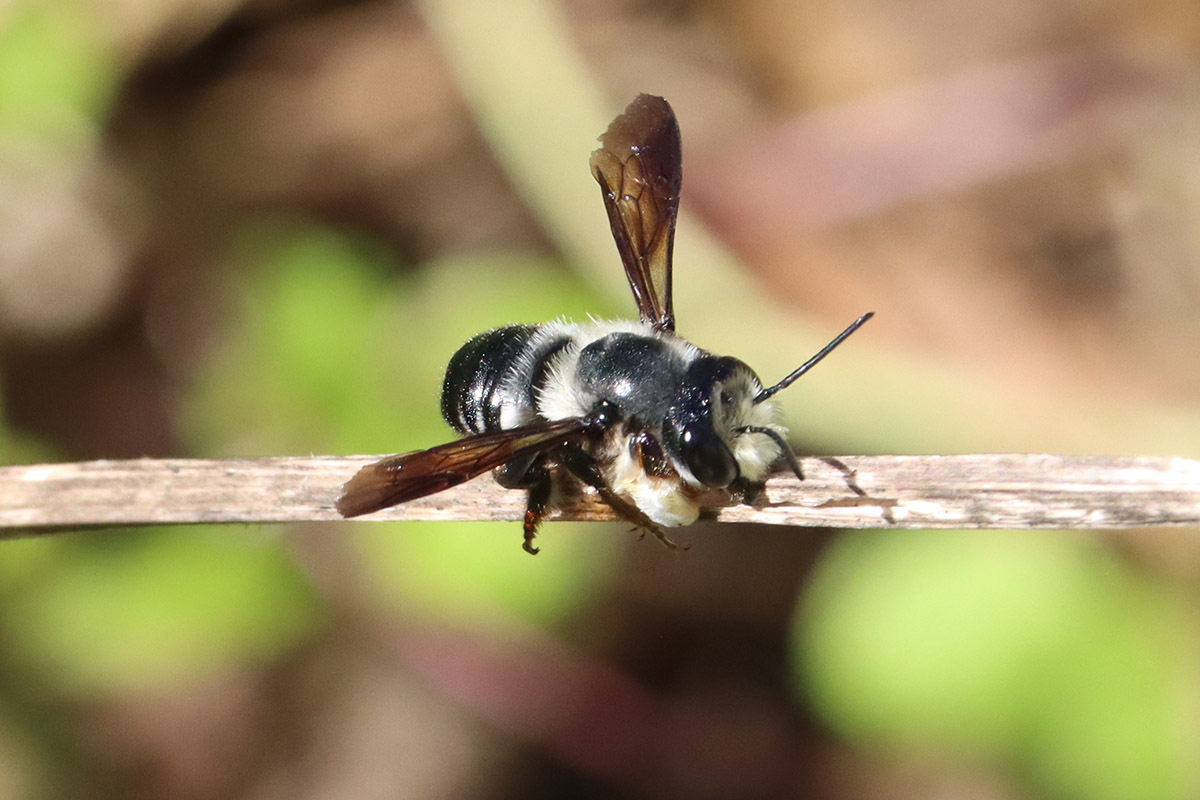
I saw this bee on the betony, thinking it might be a blueberry digger. It landed on this dead beebalm stem, and saw our first carpenter-mimic leafcutter of the year. Last year was the first year they stayed more than a couple of days, and this one appears to have overwintered.
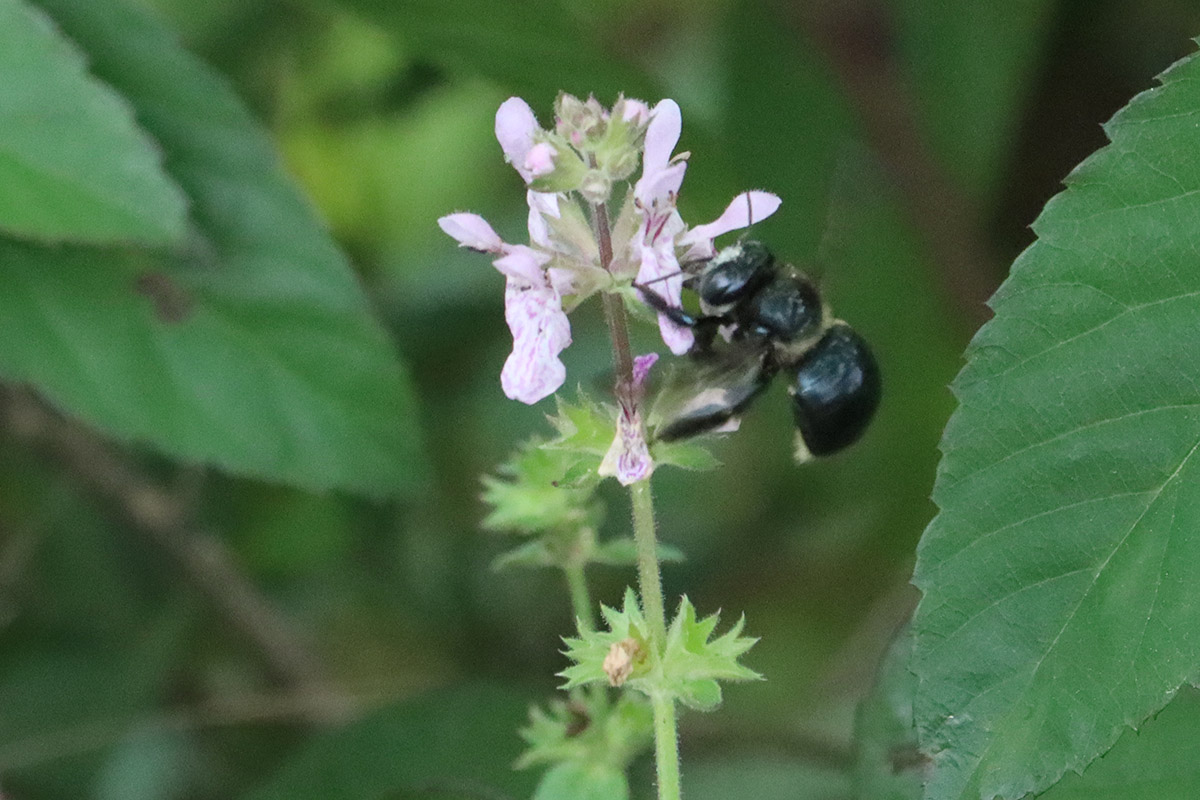
Despite having just seen the male carpenter-mimic, I really thought I had a female southern carpenter bee, which is what a female carpenter-mimic, well, mimics. The giveaway is in this photo- the hair beneath the abdomen, which leafcutter bees use to collect pollen. The male wasn’t resting, it was scoping out the female.
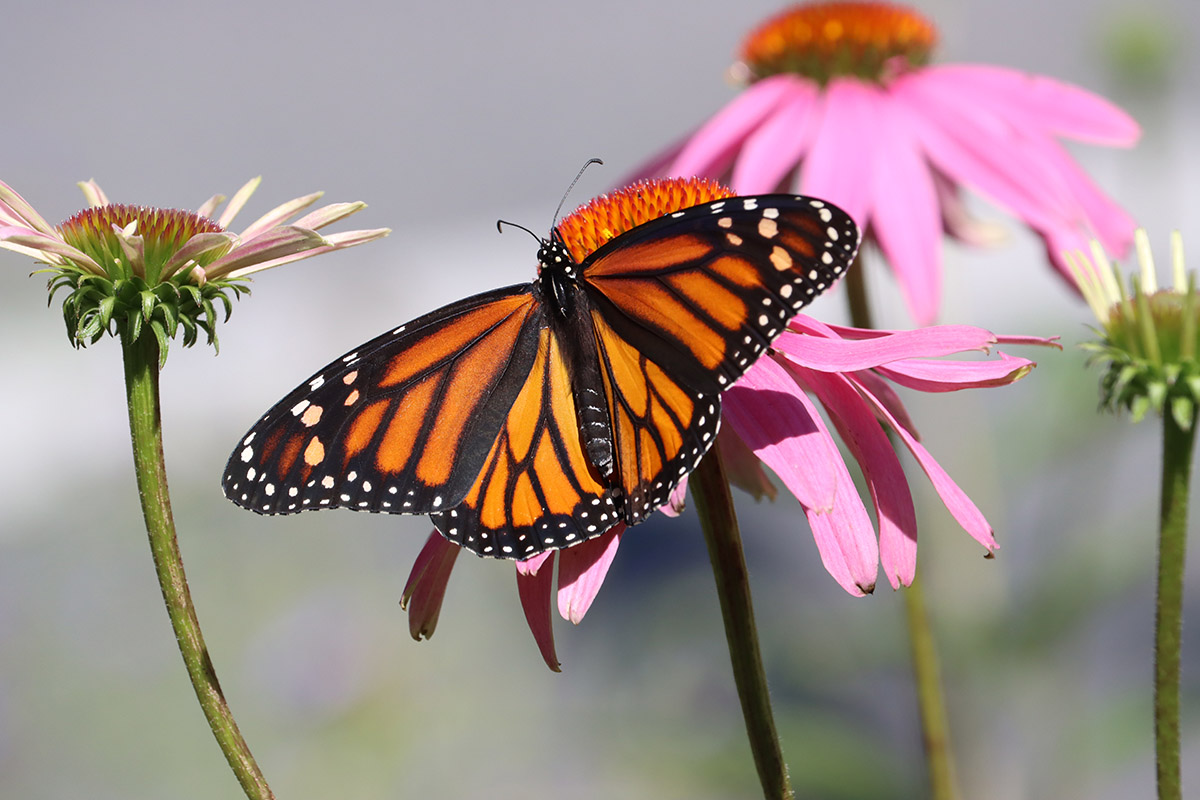
After a couple of slightly chilly days and not much pollinator action, it’s getting a little warmer today, although it’s windy. Pollinators seem to love it, including our first monarch of the year. Yes, I did go into the backyard and look over the milkweed, and no, no eggs yet.
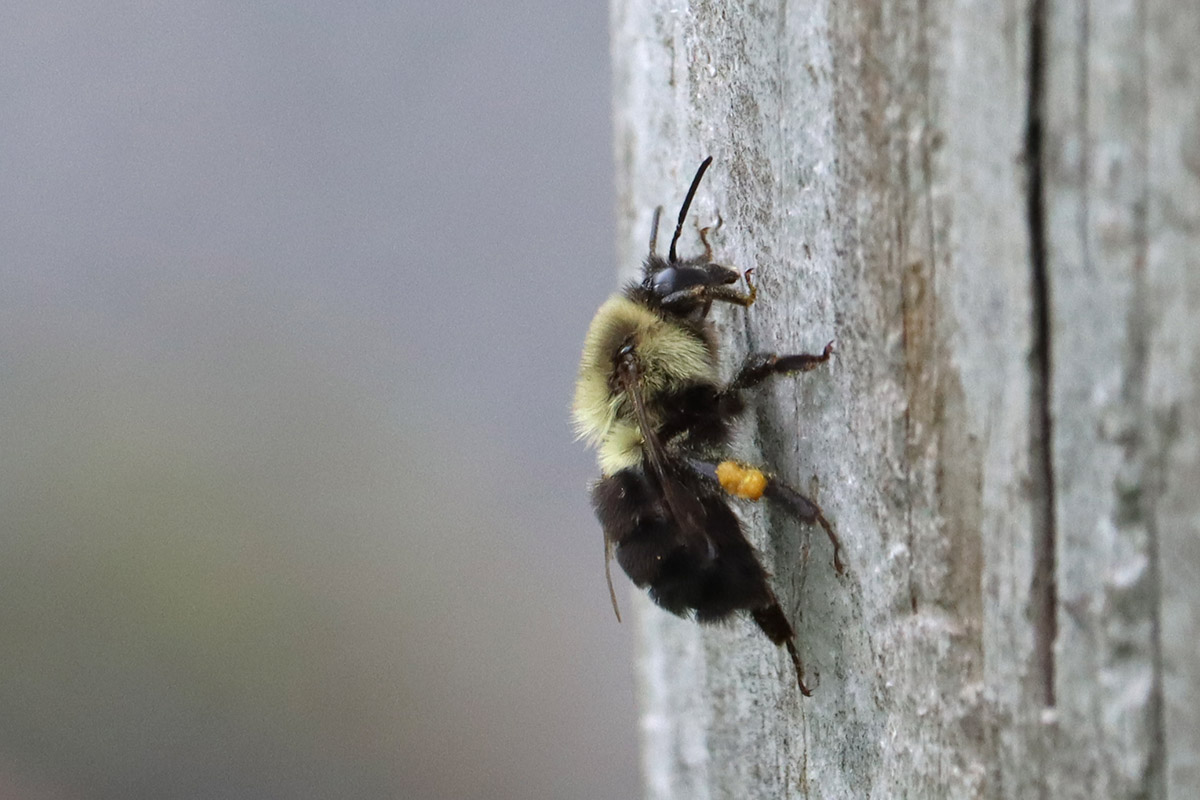
This bee was also on the betony, and I was zooming in with my camera to get a better look. So many bees are black and yellow, and this one looked more like a small eastern bumblebee than a blueberry digger. It landed on this utility post, and let me get a good look. The blueberry flowers are about done, and the betony is going. I think the blueberry digger bees are done for 2023.
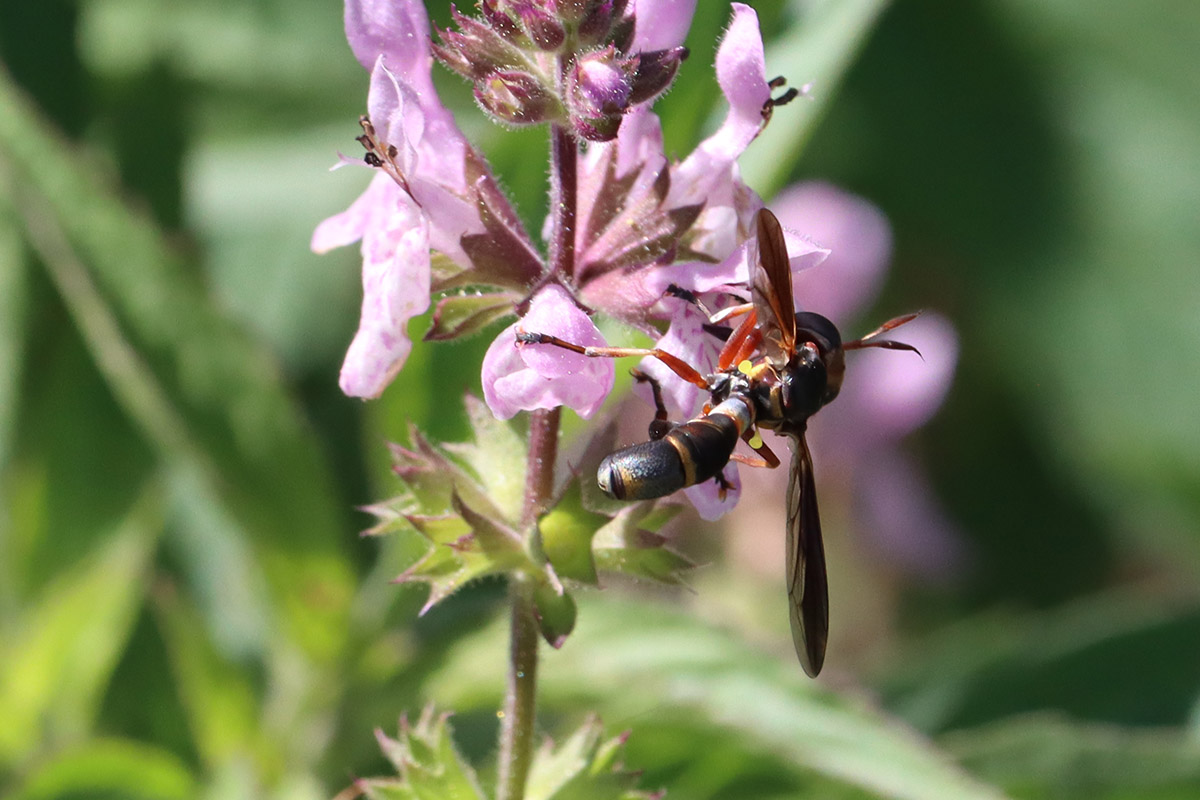
Here’s a fly I saw in September. These are parasitic breeders, known to jump on bumblebees. They inject their host with eggs, which then hatch and eat the host. I hate to see my pollinators injured in any way, but it’s so cool that many of the insects I saw in this flower patch in the fall seemed to have overwintered here and have returned in the spring. This feels like a good habitat.
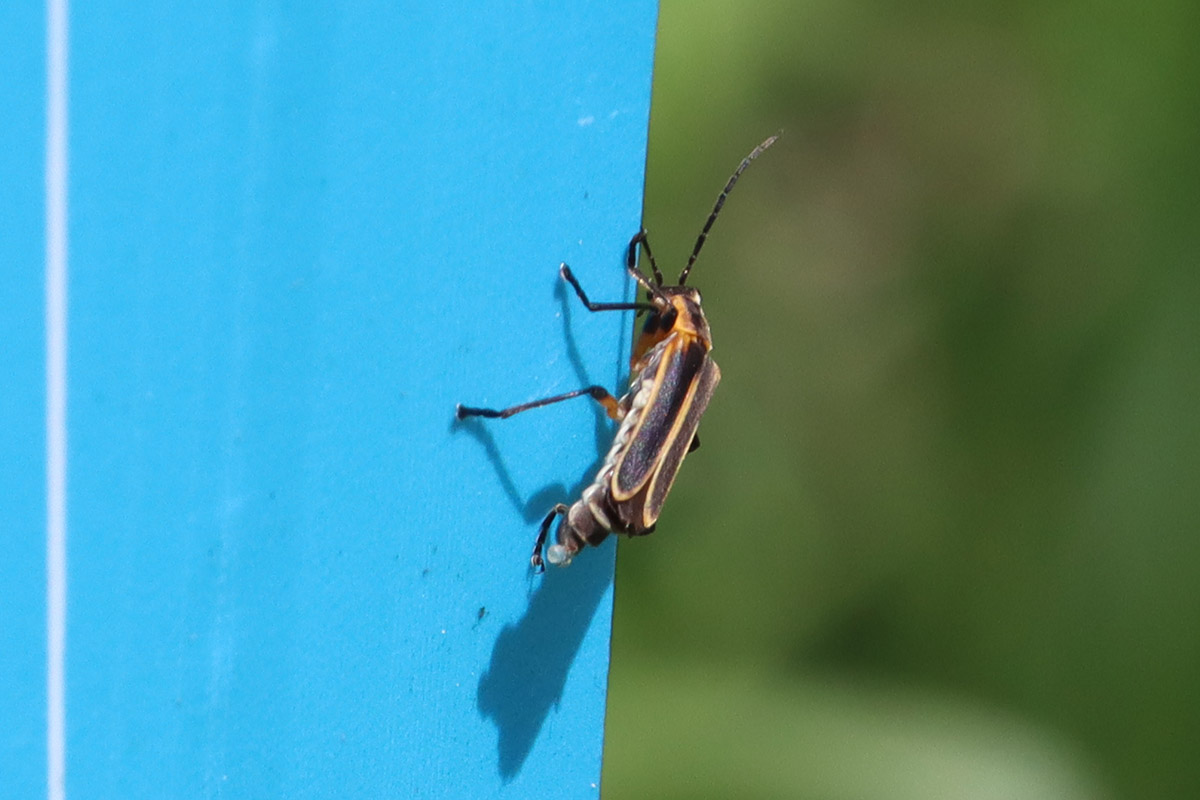
Soldier beetles eat pollen and nectar, but also east smaller insects. I was unable to find any information specific to this species. Does it look like it has an egg coming out of its ovipositor?
And in the backyard…
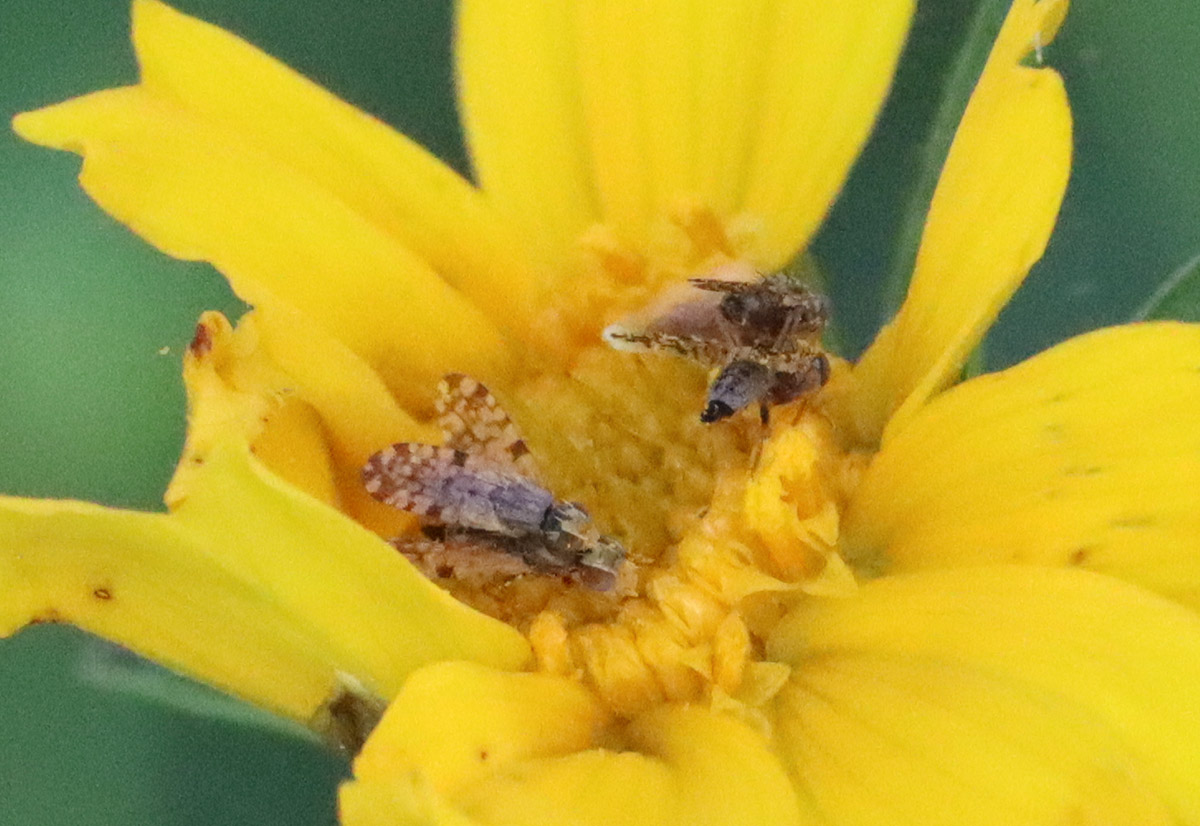
Sorry for this terrible photo- these are small insects. These fruit flies were on the lance-leaved Coreopsis last spring as well.
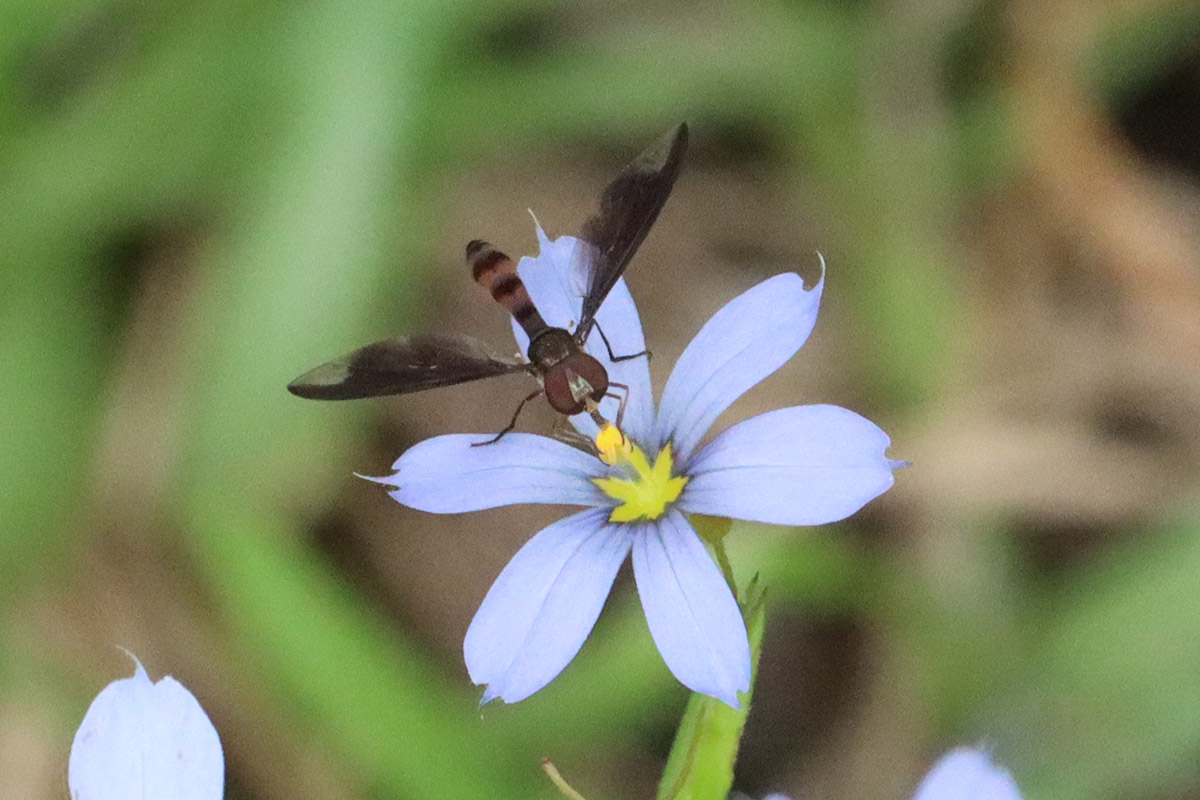
I’ve been seeing these guys for weeks, always hovering around plants, likely to lay eggs near the aphids their larvae eat. But they are pollinators as adults. Don’t like aphids? Plant lots of native flowers for hoverflies.
April 12, 2023

I saw this fly and land in the leaves above our side yard. This is a robber fly, likely a hanging thief. These are predators of flying insects, often going after bees in our yard.
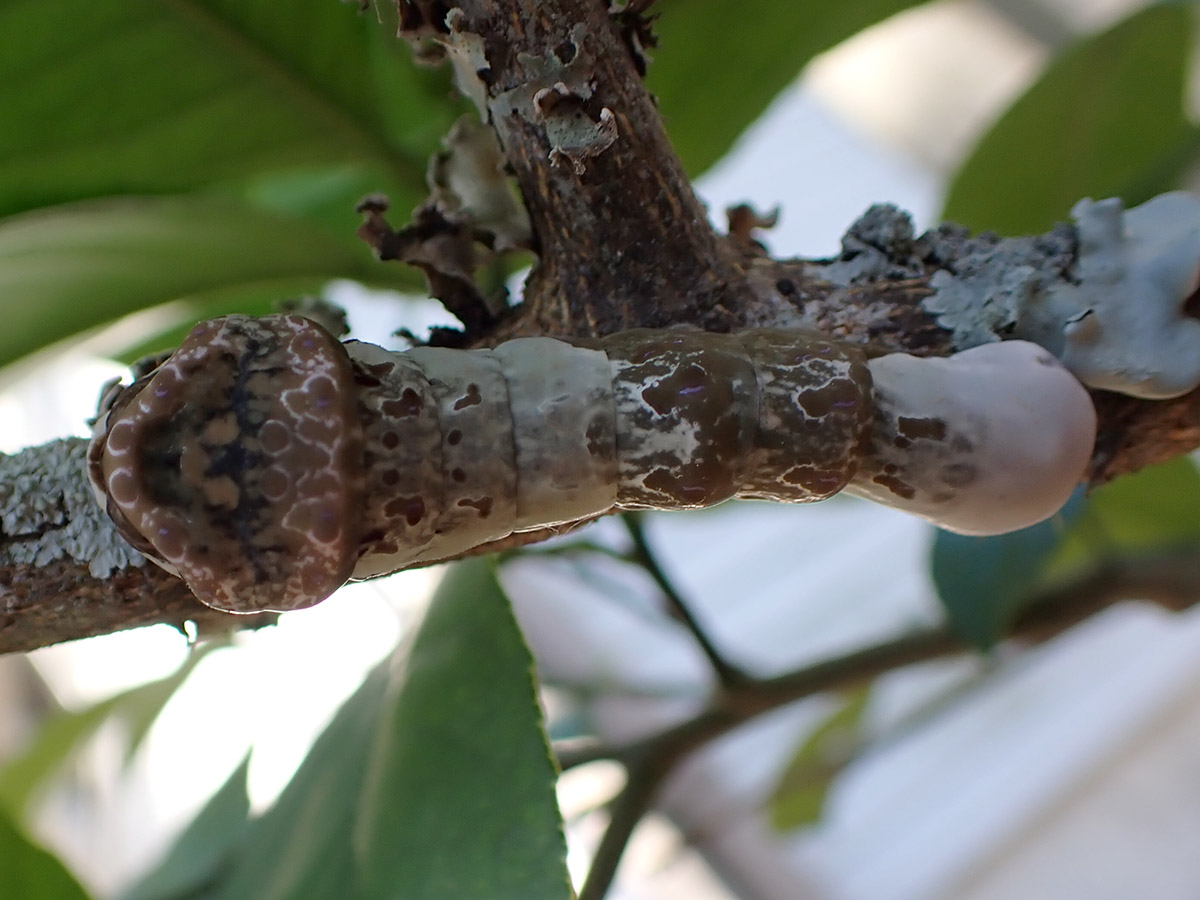
The rains over the weekend cooled temperatures, and maybe that explains why this caterpillar has been immobile. It moves location every once in a while, but I never see it eating. It’s in the final instar phase, ready to make that chrysalis. Instead, it waits.
April 13, 2023
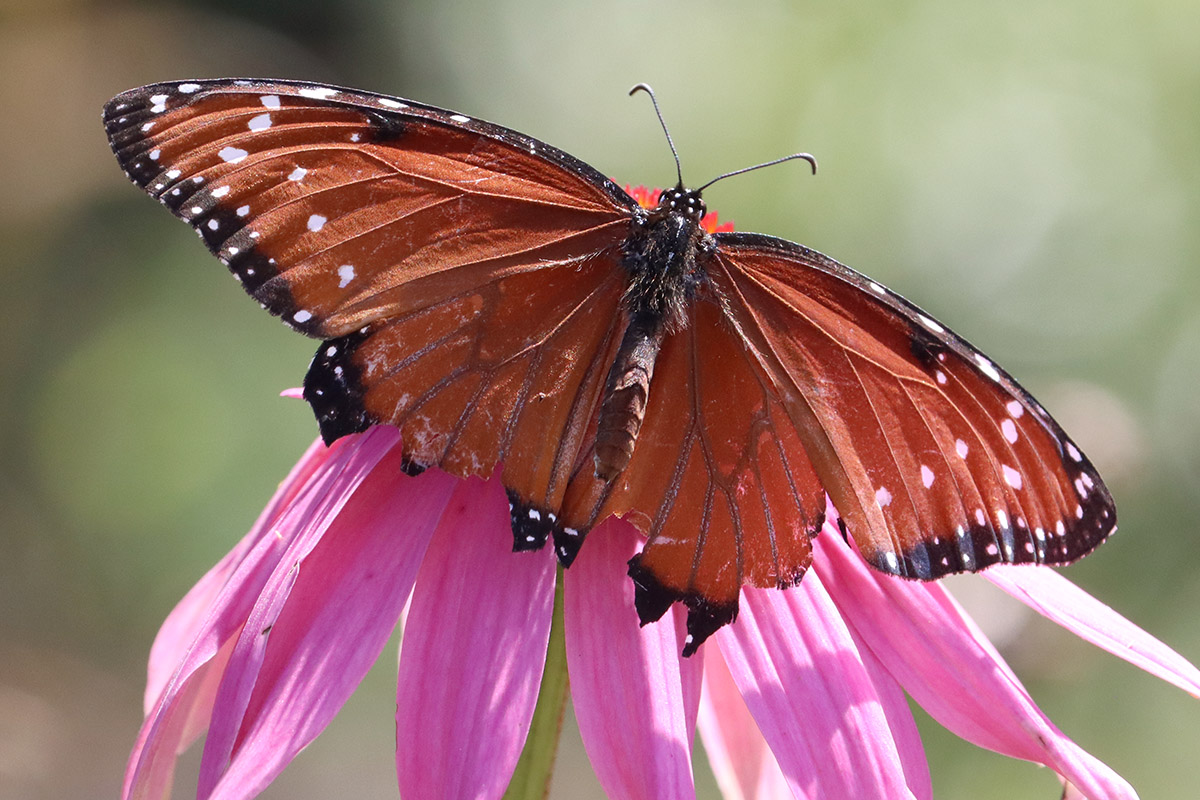
Another first for our yard, a queen butterfly. Its wings tell the story of a life lived. This butterfly is closely related to monarchs, and also hosts on milkweed. Yes, I did run and check the milkweed after it flew off. No, there were no eggs.
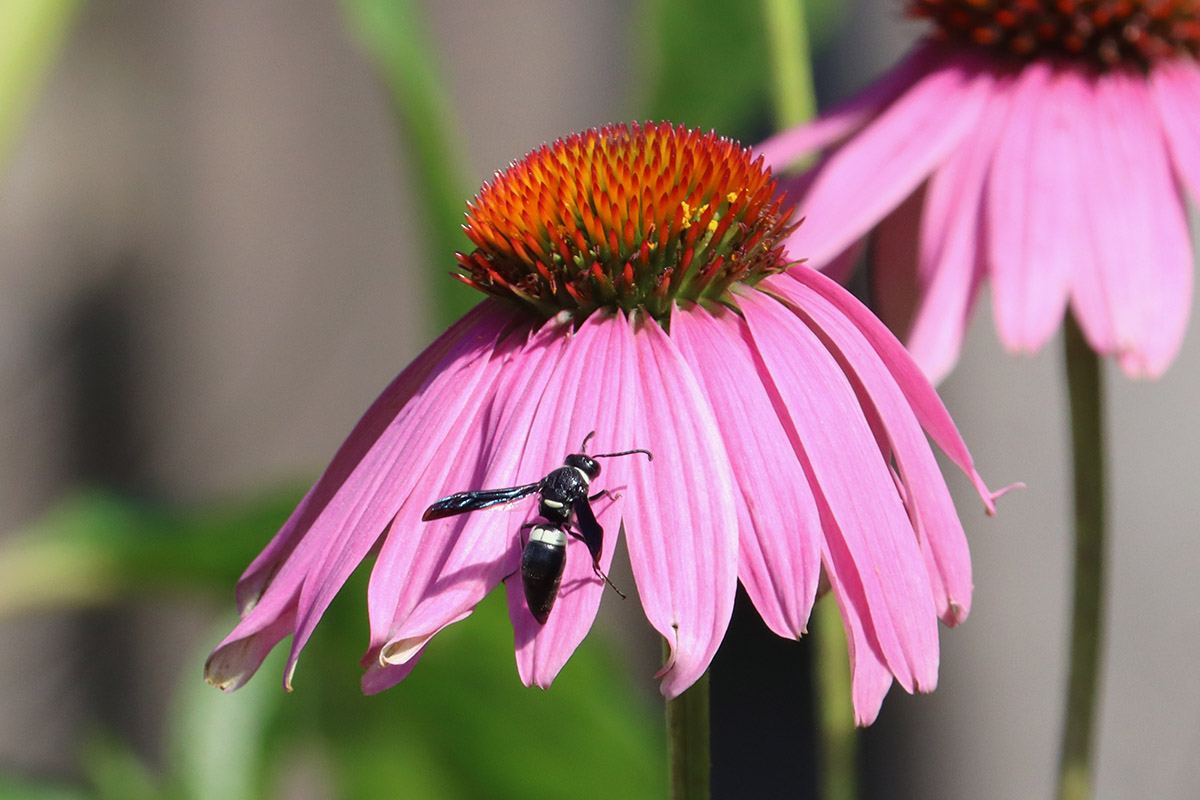
This mason wasp chased off the queen. The winds were harsh, and so once the butterfly was off the flower, it was blown halfway down the street, settling finally in one of our crepe myrtles.
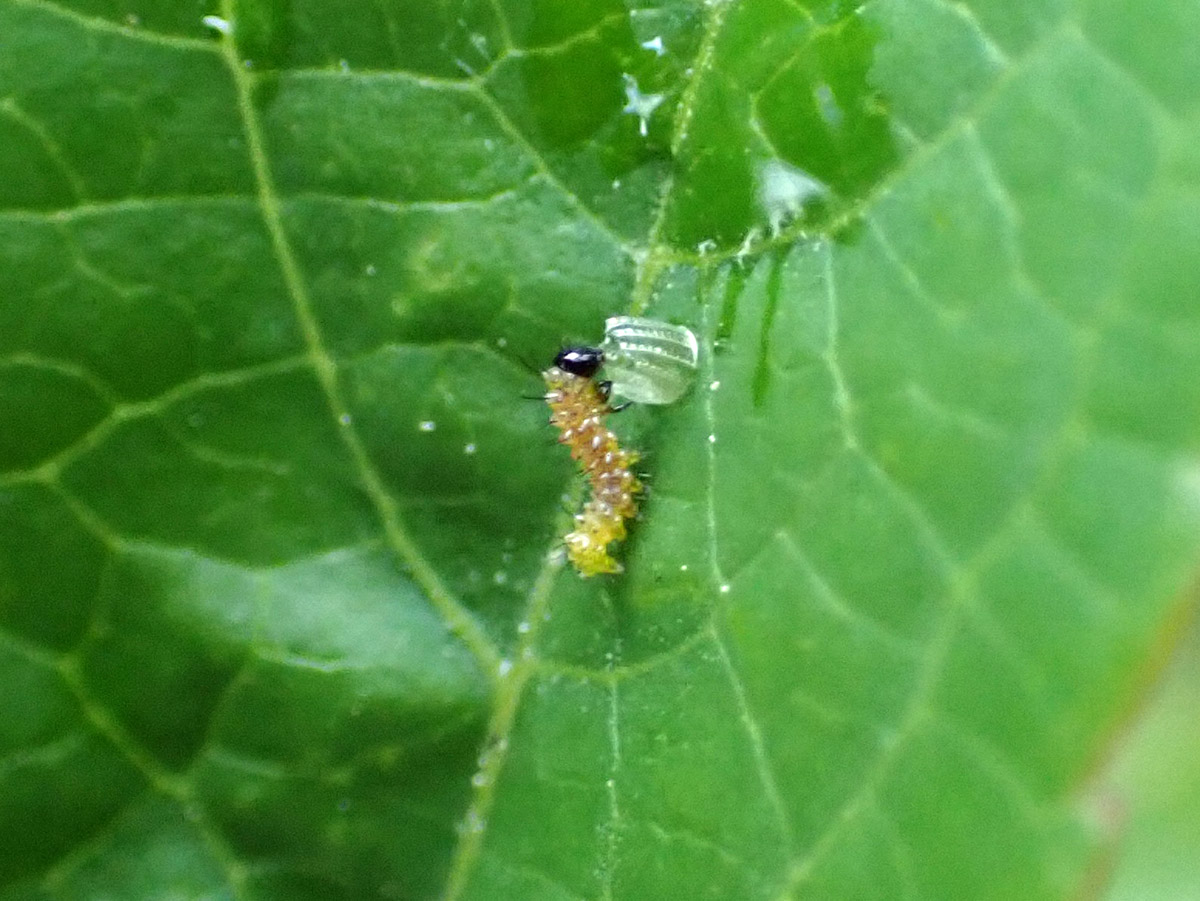
I saw this as I was herding the boys into the car to get them to school. The first thing any caterpillar does when it hatches is eat its egg. I only rarely get to see it.
April 14, 2023
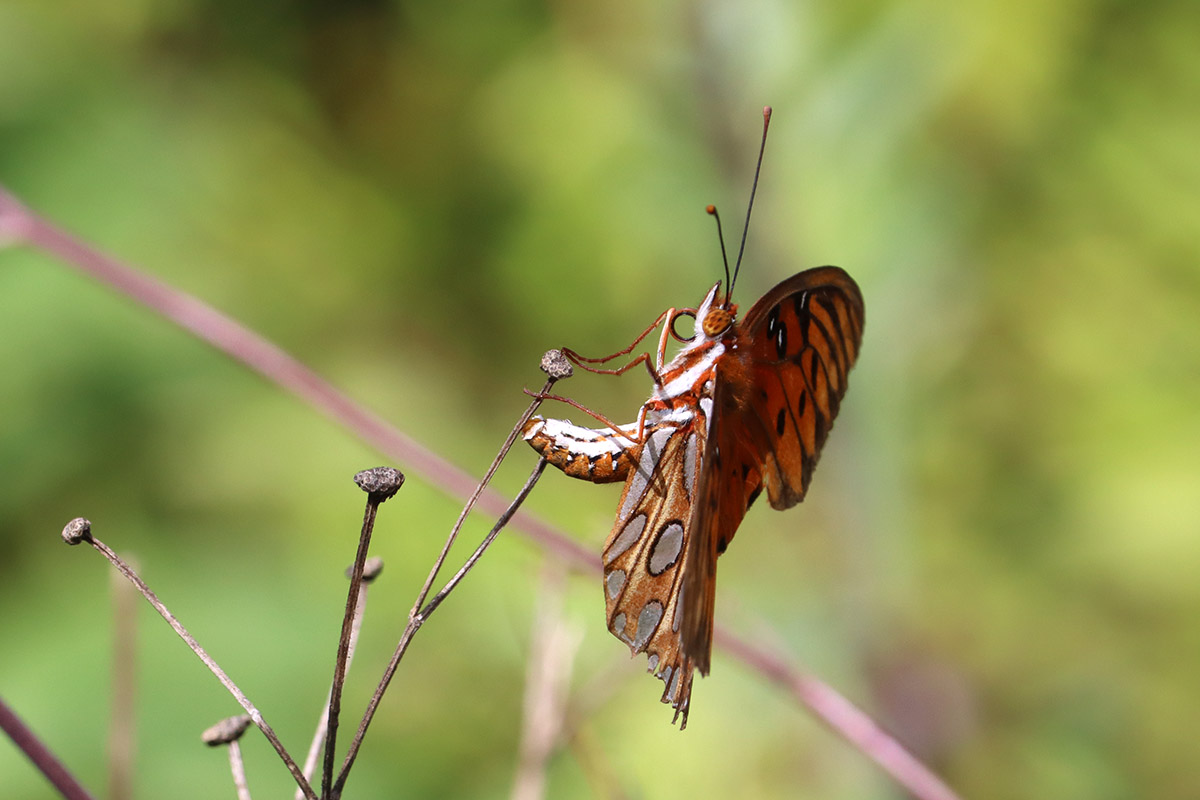
One day after I saw a couple of eggs hatch, this mother fritillary dropped a couple dozen more on our plants. There are so many passionvine sprouts this year, and so many in thickly vegetated parts of the yard, that I’ll never know exactly how many we have.
You may notice that this butterfly is not laying eggs on passionvine, the gulf fritillary’s host plant. When I was researching my post on fritillaries and passionvine last year, I learned that they sometimes lay eggs near the host plant.
Caterpillars, caterpillars, caterpillars

A day later, and our first caterpillar seems to have graduated to instar 2.
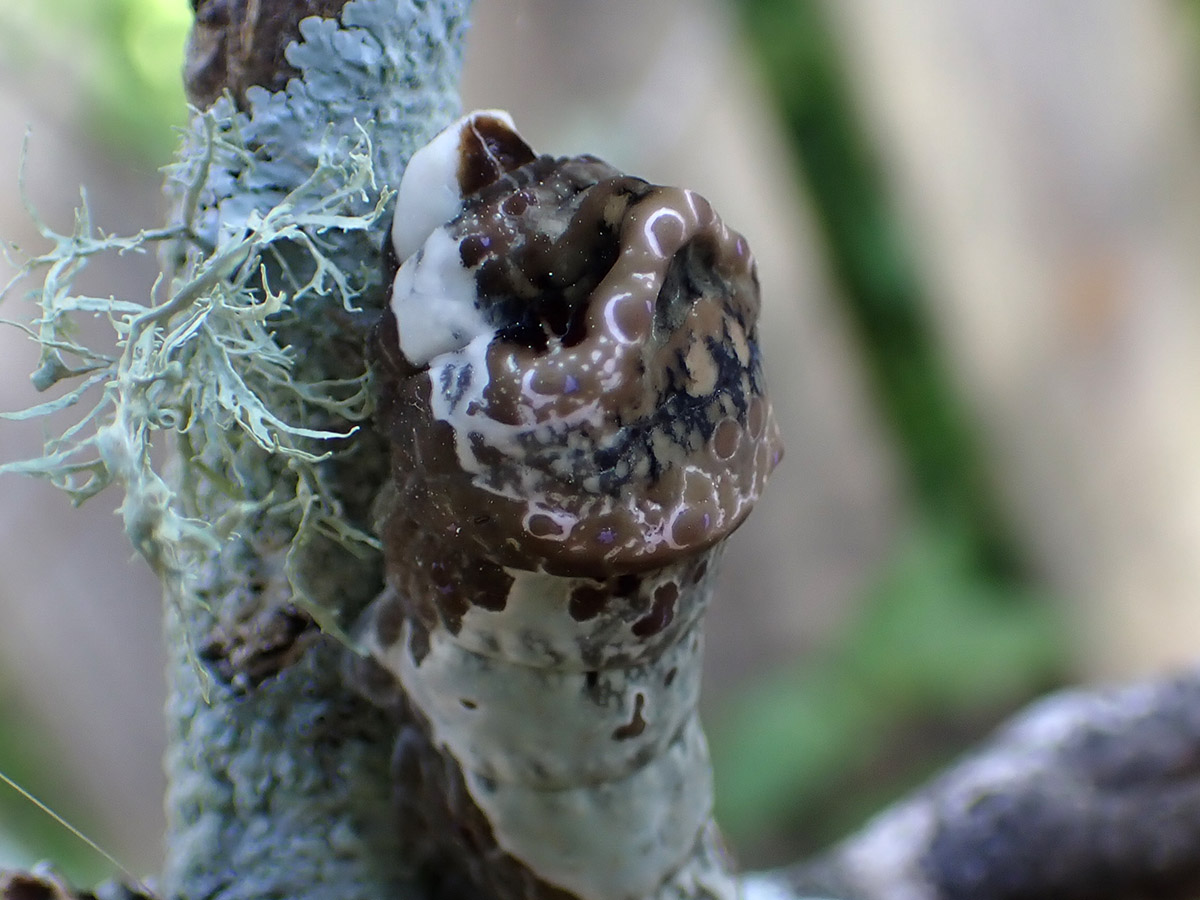
Plants and animals of any given species have a personality of sorts. Some are more aggressive while others are more conservative. Some take things slower while others go fast. These differing traits- leafing out earlier or later, laying clusters of eggs together or spreading them out, and so on- are different strategies for surviving and reproducing. It can be tempting to attribute human motivations to these non-human organisms.
But seriously giant swallowtail, it’s time to get off the couch and make that chrysalis already! I get it, adulthood is hard. Lying on a branch impersonating bird poop is easy. I don’t want to compare you to your younger sibling, but soon they’ll catch up and pass you. I know you can do this.
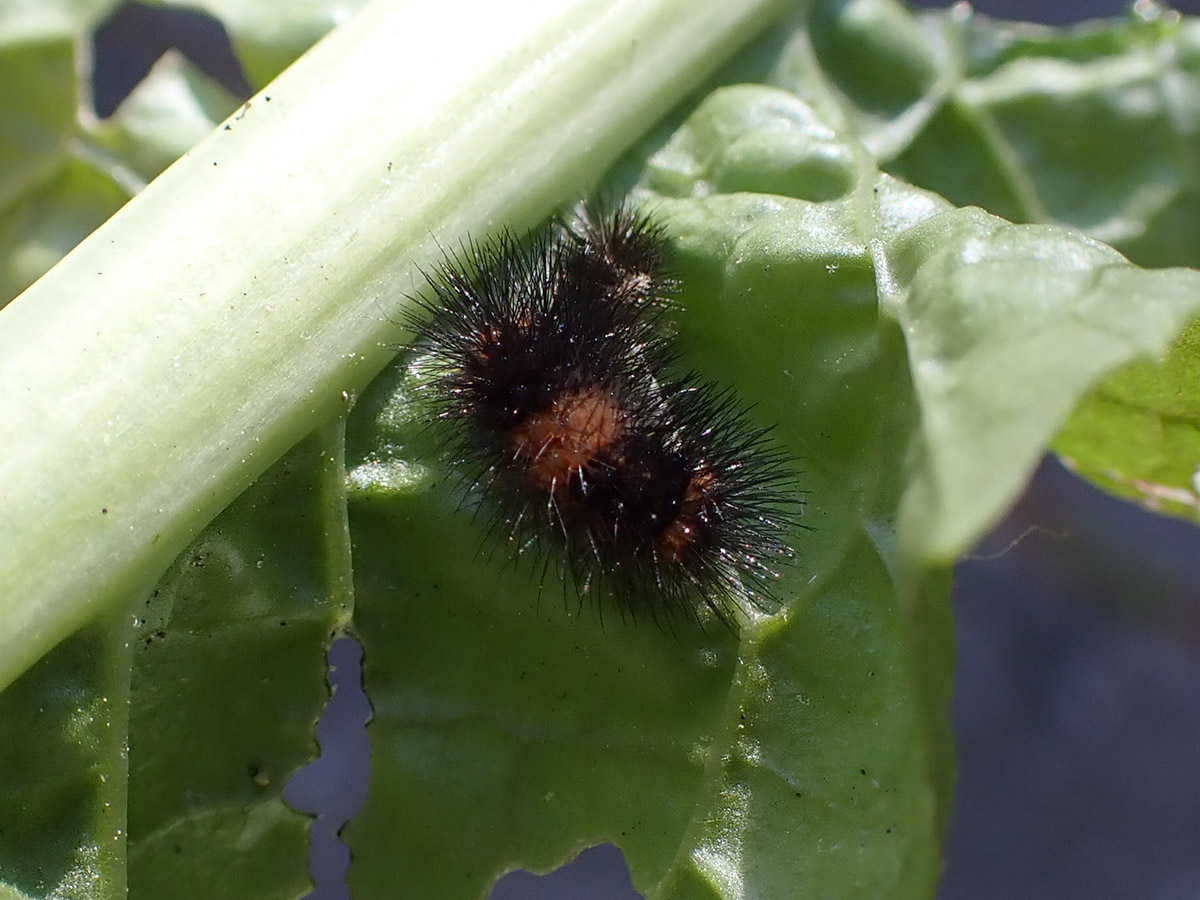
I found this little fellow when I harvested some mustard greens for a salad. Sorry, this is my food. I deposited it away from our food plants.
Any caterpillars on the milkweed yet?

No monarchs or queens yet. I hope queen butterflies become more common in the yard. Their caterpillars are like monarch’s, but with two extra sets of tentacles (what most people call antennae on caterpillars). I do, however, see one of my favorite predators.
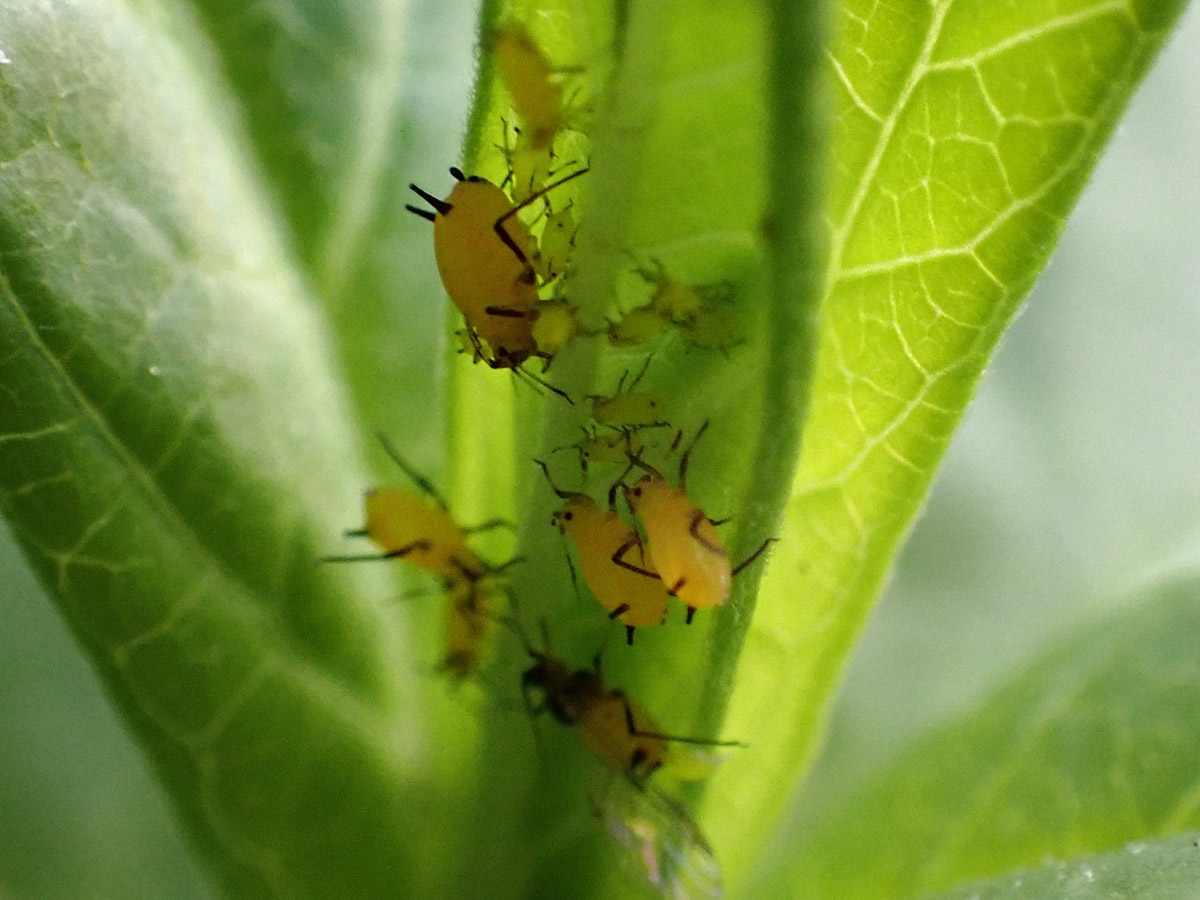
And here is the prey.
What else?

According to bugguide.net, adult zebra longhorns visit flowers while their larvae host in stumps and decaying wood. Perhaps this is a child of our brush pile, or the laurel oak sections I kept after our tree fell in 2021.
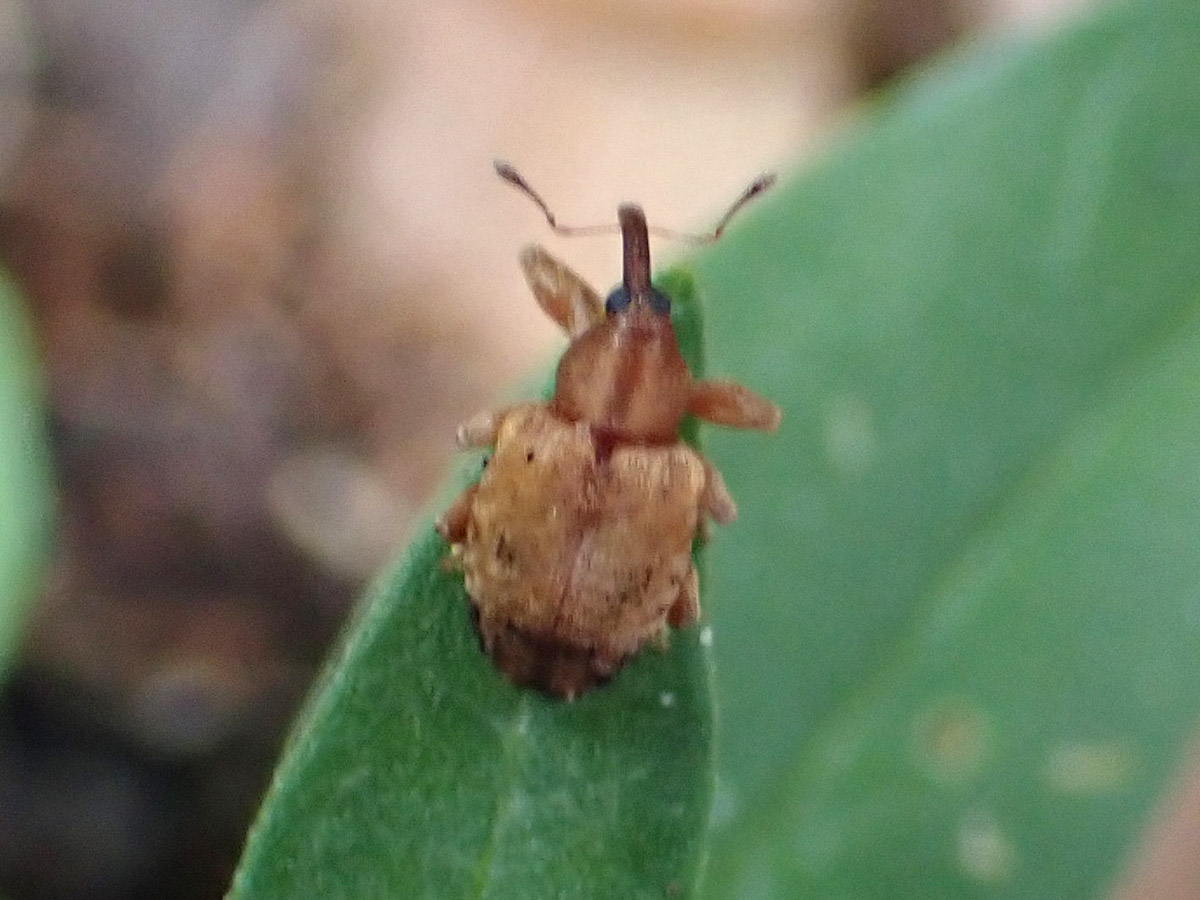
Ligustrum is privet, and there are privet trees next door. Like its host tree, this insect is not native.
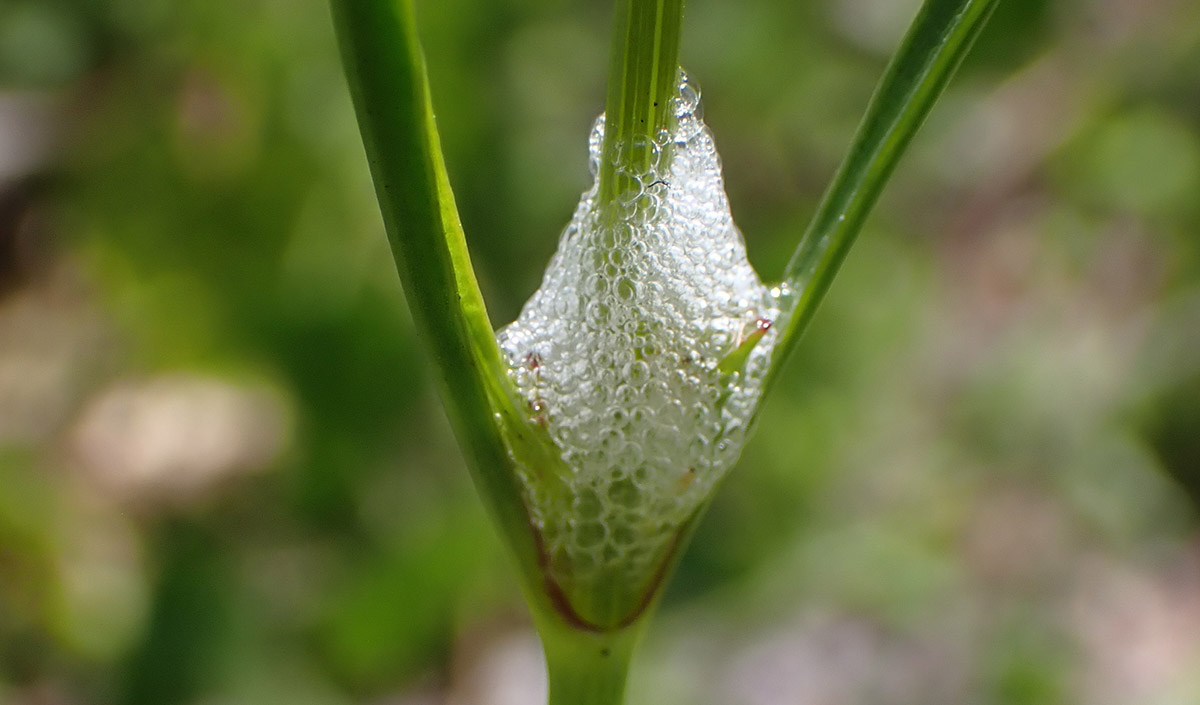
April 15, 2023
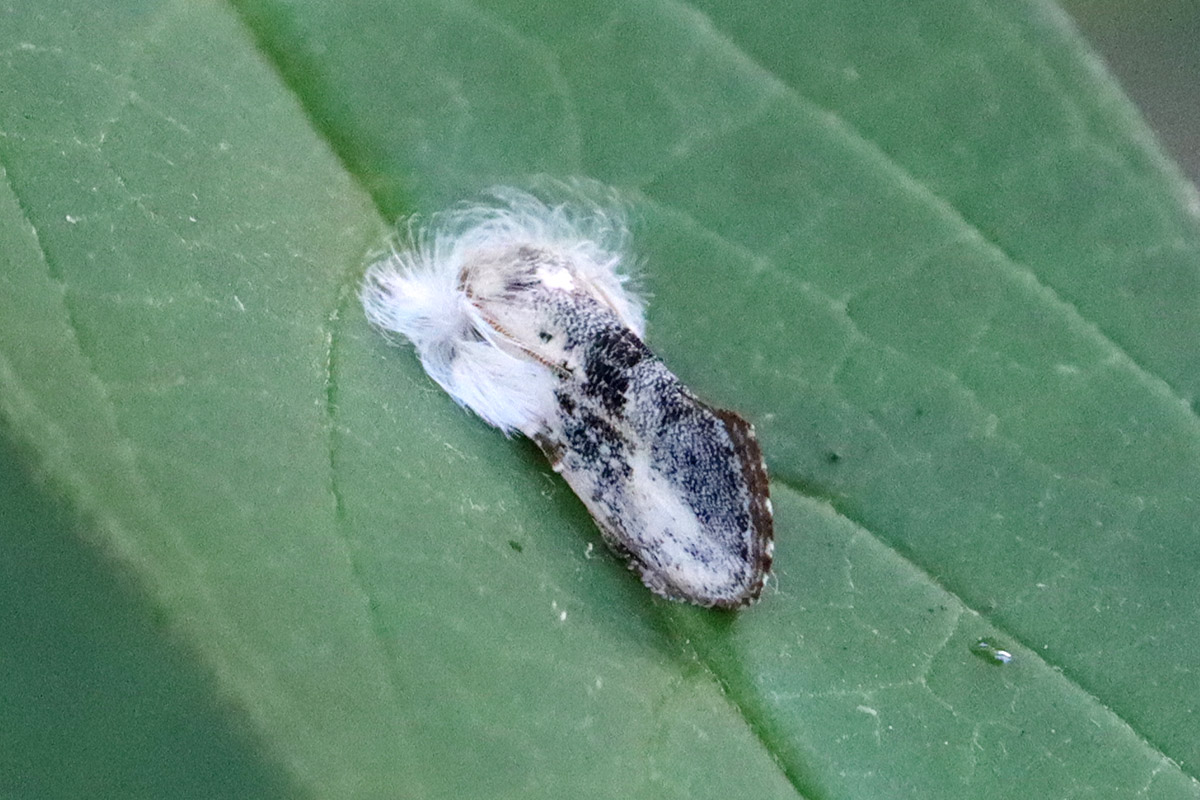
After having seen a monarch and a queen over the last couple of weeks, I’ve been checking the milkweed more. Still no eggs or caterpillars, but here’s one of my favorite moths. I see it once or twice a year, and I just learned that its caterpillars host on bracket fungi- mushrooms that grow on decomposing wood. We have plenty in the yard.
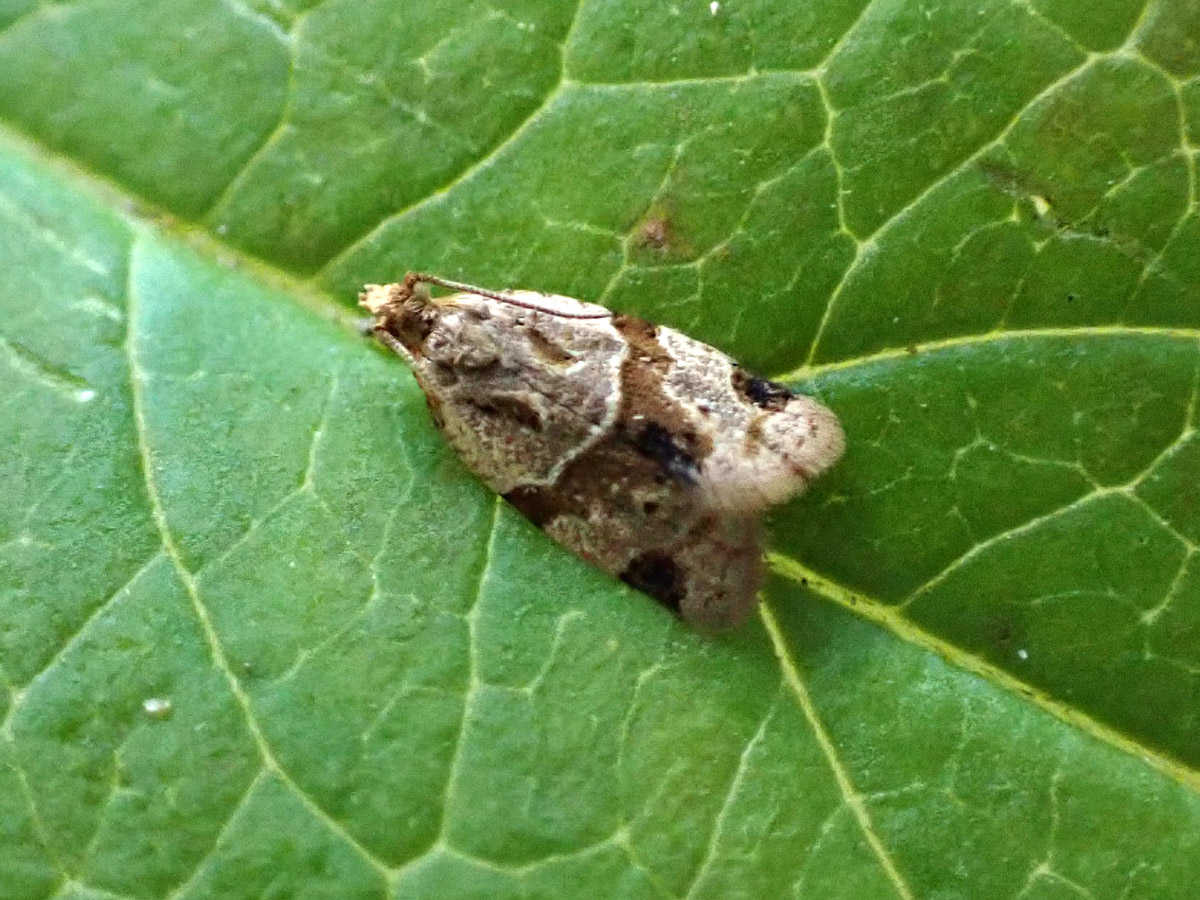
Is it weird that I feel bad about not looking up every little moth I find? I get so into finding out about bees and wasps and other insects, and less so about the less showy moths and also dragonflies for some reason. I only have so much time in a day, I guess.
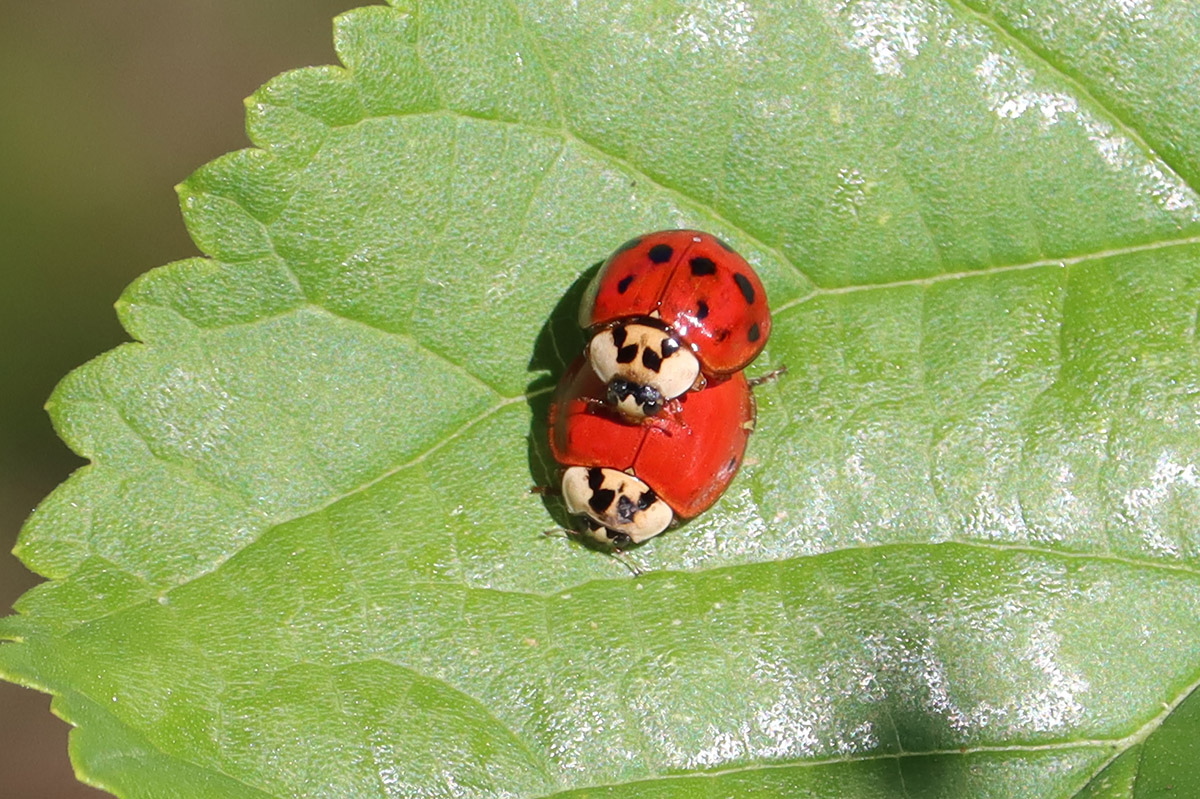
The invasive Asian lady beetles are everywhere this year, especially out front. And I’ve seen a lot of mating. This patch is where the gulf fritillary caterpillars are increasing in number, and lady bugs eat small caterpillars. The lady beetles don’t seem to have stymied the caterpillars, but I’ll keep my eyes on them.
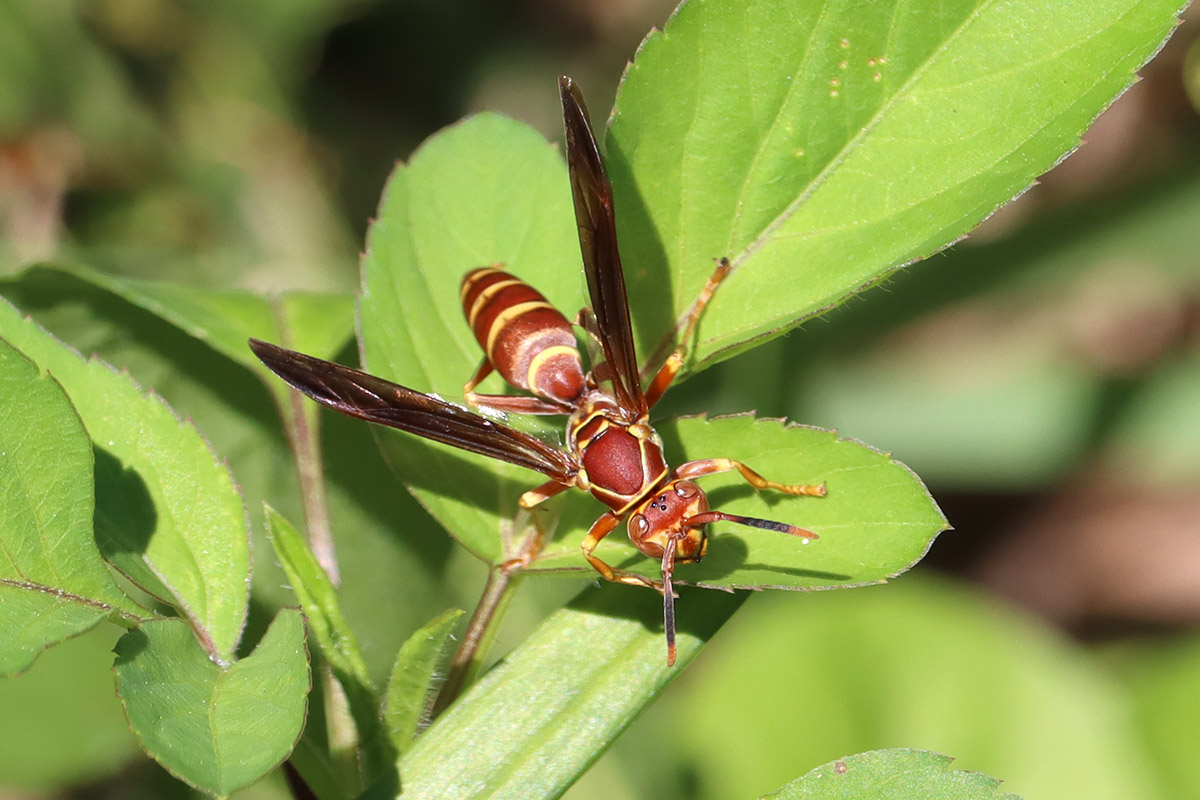
Another caterpillar killer. These have been active in the front flower bed as well. Spring brings an explosion of life- plants, and then insects. As a result it’s also when we start witnessing a lot of death.
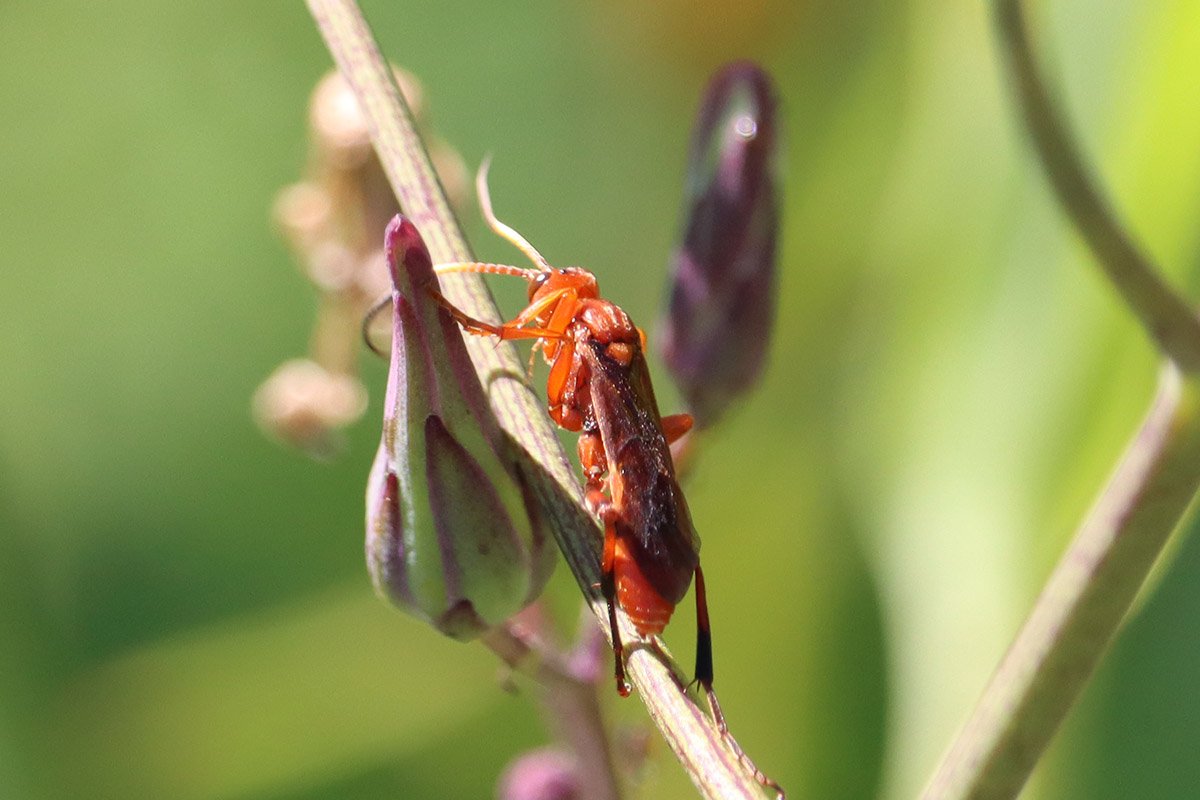
This is my first iNaturalist guess for this wasp; I’ll update if I learn anything new about it. Ichneumonid wasps are parasitoid breeders.
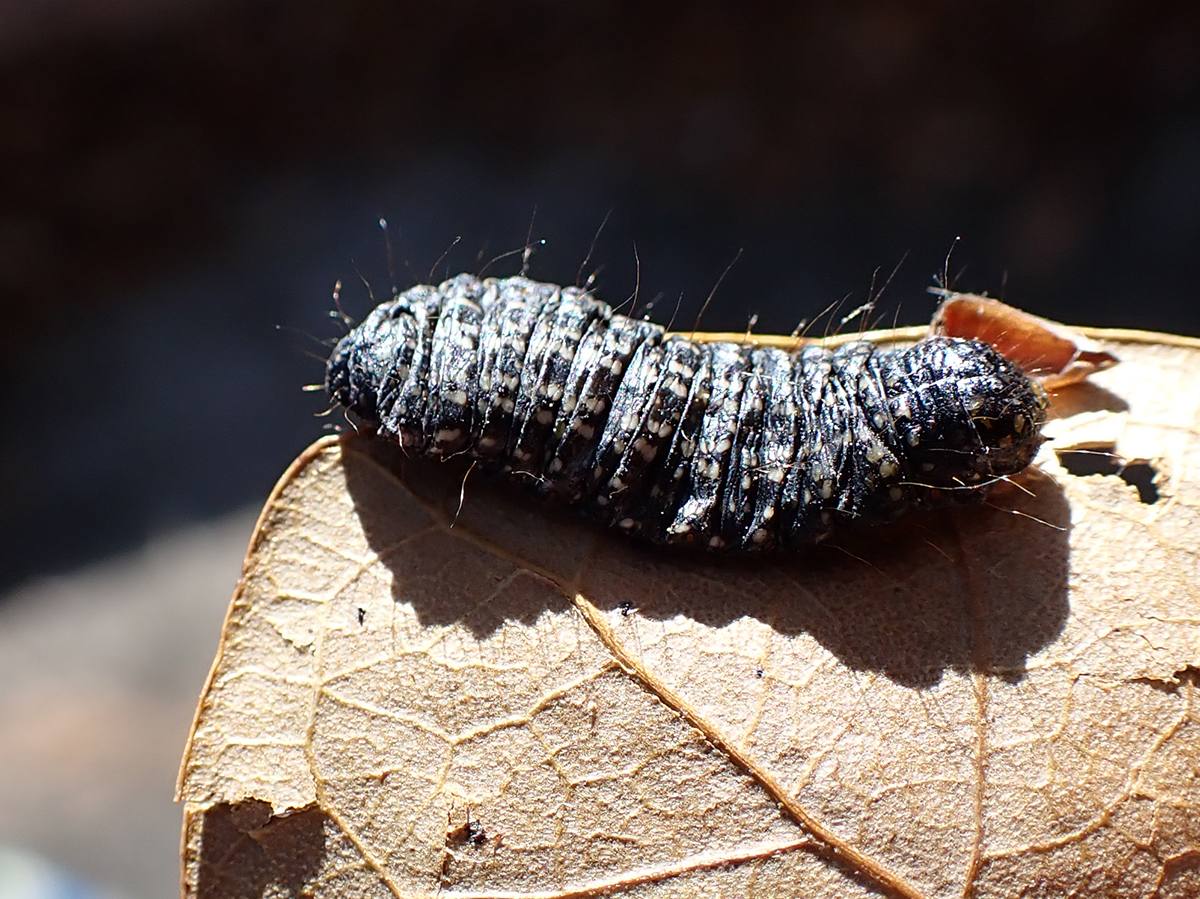
I think this might be dead. I found it on the back step, and it looks kind of flat. iNaturalist has no clue what it is.

This is a plant bug, a plant eater. Many plant bugs are considered agricultural pests. When I see only a single individual of these “pest” species, or a few on our native plants, it doesn’t worry me. They are native plant eaters, and we need a diversity of them to feed their diverse native predators. If there is an imbalance of these, then I become concerned. But part of native gardening is building that food web, and in that food web, anything might get eaten.
April 17, 2023
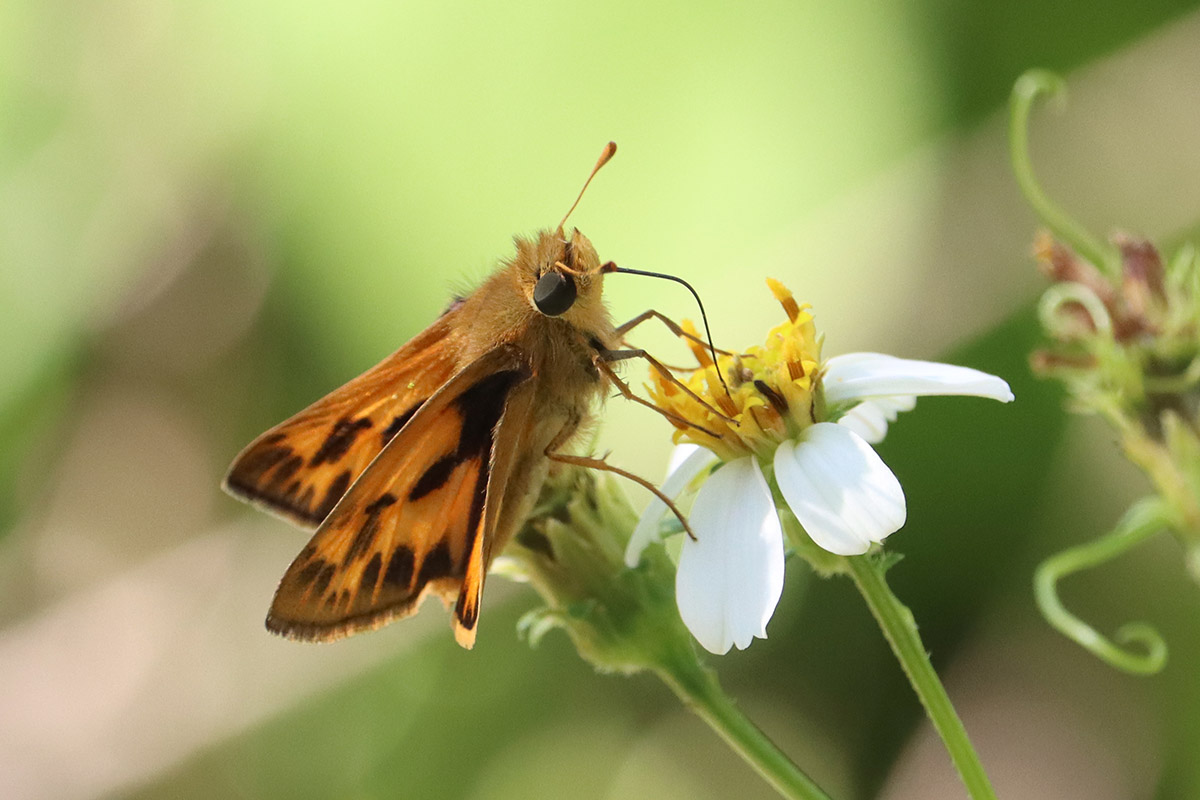
Bidens alba is blooming all over the yard. In the years since I started letting weeds establish themselves throughout the yard, this plant slowly introduced itself and more recently threatened to take over if unchecked. I pick and chose where I want it, but I have to stay on top of it. It is a valuable pollinator plant, but I can’t let it threaten the plant diversity in my backyard ecosystem.
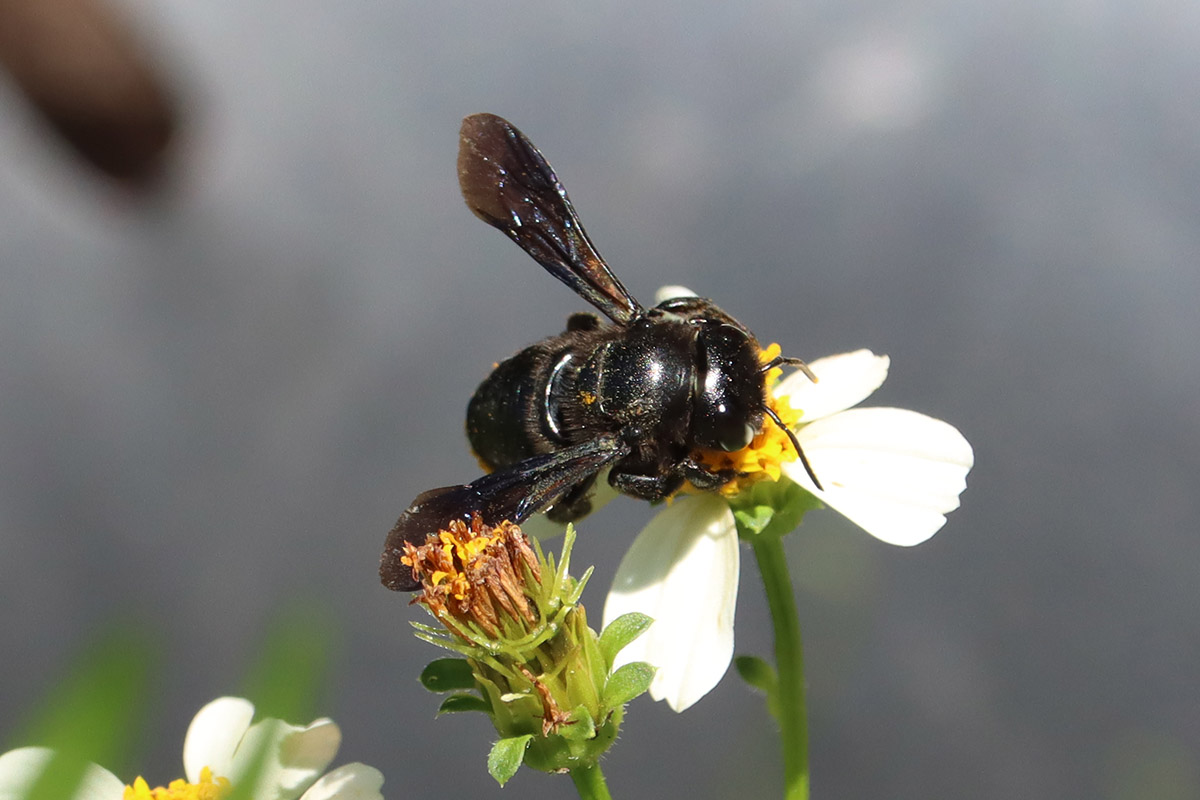
Our largest Bidens alba plants are growing out the sides of our compost bin. Here is where we often find this bee.
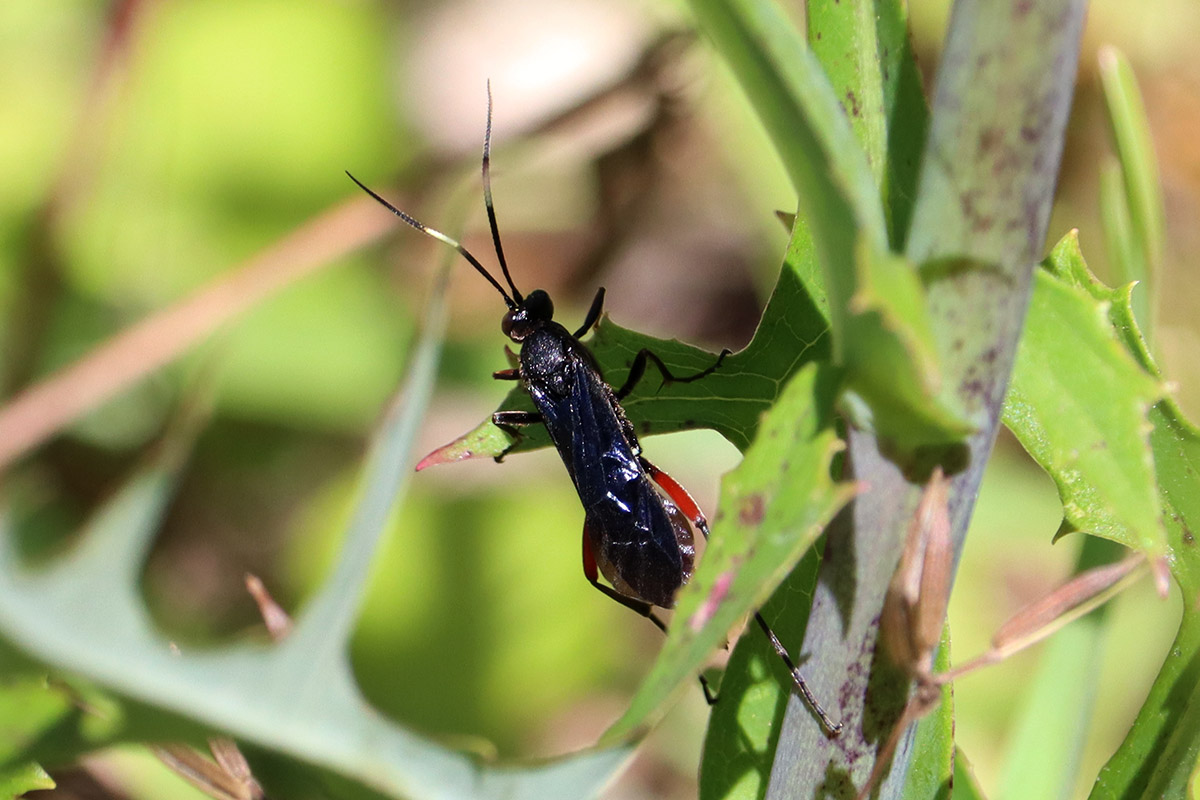
This wasp continues to hop between plants in our front flower patch.
April 18, 2023
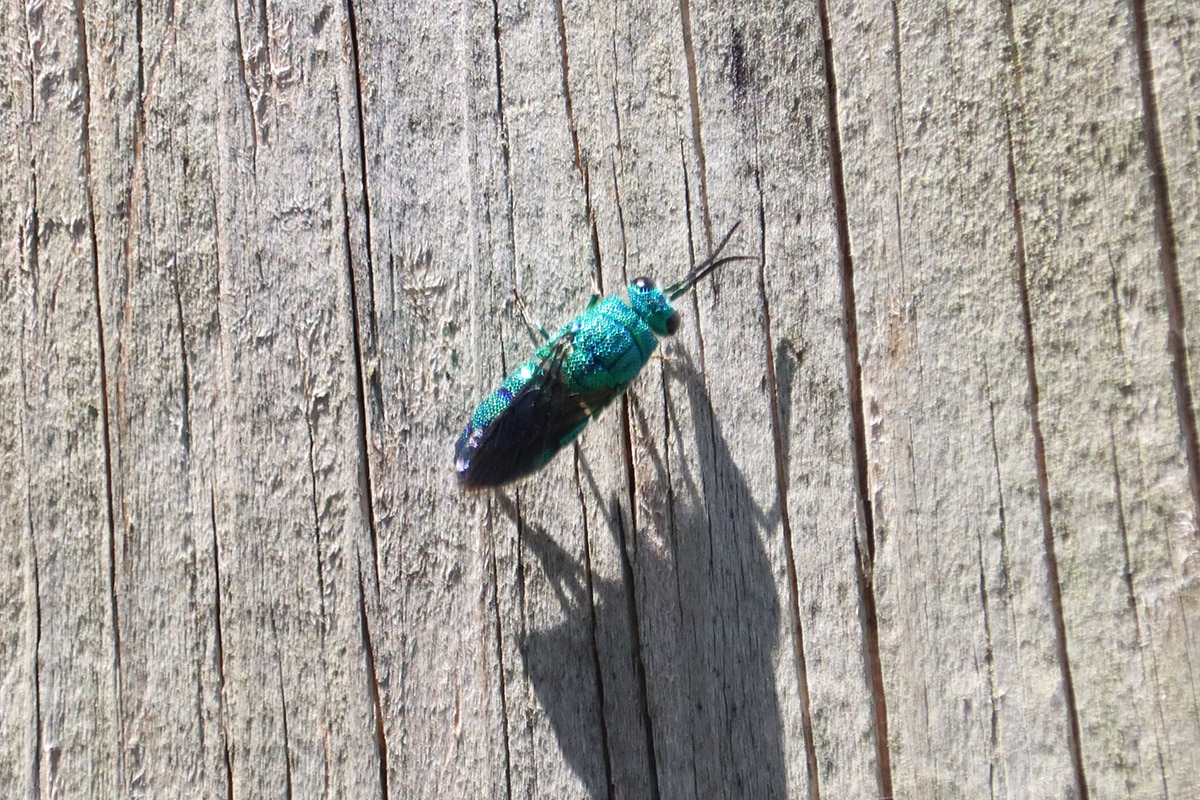
Four-toothed mason wasps have been active this spring, and so it’s no surprise to see this wasp. Here is a kleptoparasite; she lays her eggs with those of the four-toothed mason. I often see cuckoo wasps lingering near their nests, which are usually abandoned carpenter bee nests in fence posts. This one is just a few feet from one such site.
April 19, 2023
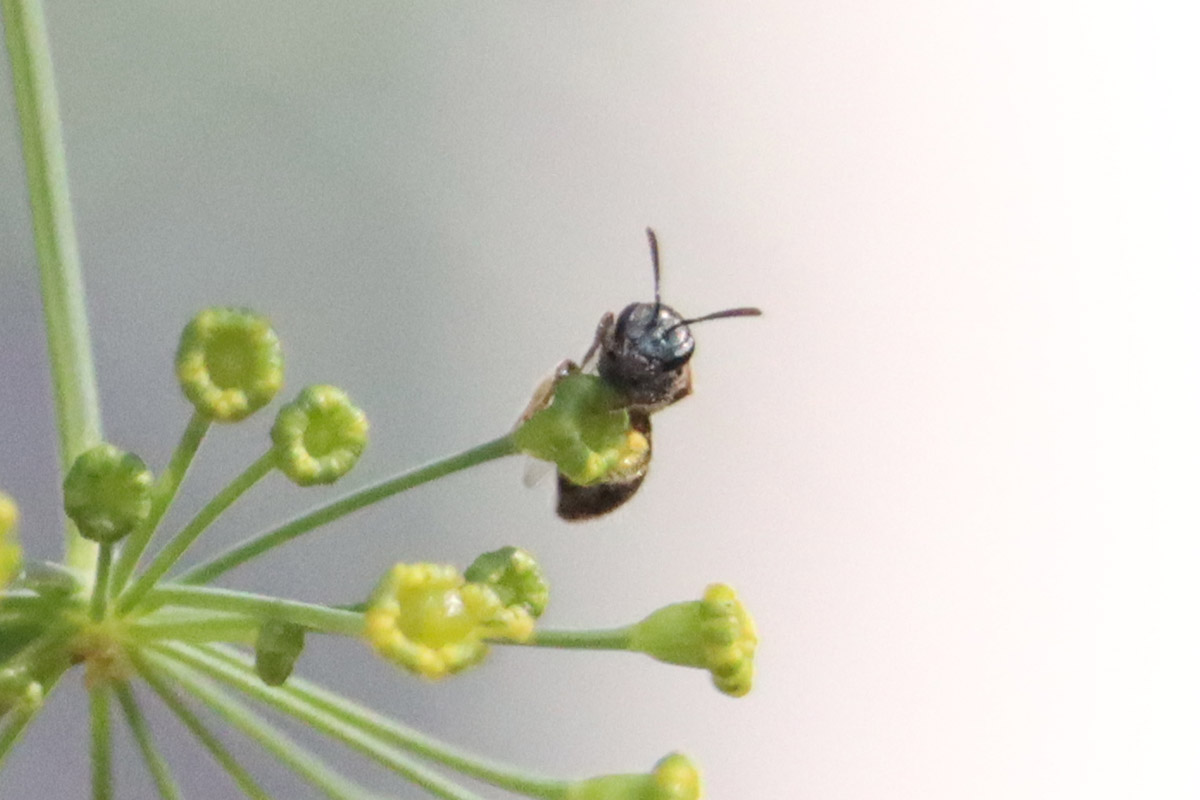
I’ve bought quite a few plants in the Apiaceae family in the hopes of hosting black swallowtail caterpillars— fennel, dill, and two native species— meadow parsnip and golden Alexander. The flowers of these plants are unlike any of the others in our yard, so they offer some variety for our small bees and wasps.
I’m writing this two weeks after the fact, and one iNaturalist observation made over a week later has me taking a closer look at all my small bee photos. I usually expect that small bees are Lasioglossum genus, subgenus Dialictus. They can vary somewhat in appearance, but are rarely identified at the species level on iNaturalist. They’re also very common.
I did finally have a species-specific ID for a Lasioglossum in March (scroll up to see), and I keep uploading photos because there are other small dark bees out there as well. About a week after I saw this bee, another yard bee was identified (though unconfirmed by other users as of yet) as a fairy bee. Others in the yard were ID’d as Lasioglossum. I’ll keep uploading and trying to learn more, and will update as I do.
I had a heck of a time trying to photograph this tiny bee on a tiny flower on a windy day.
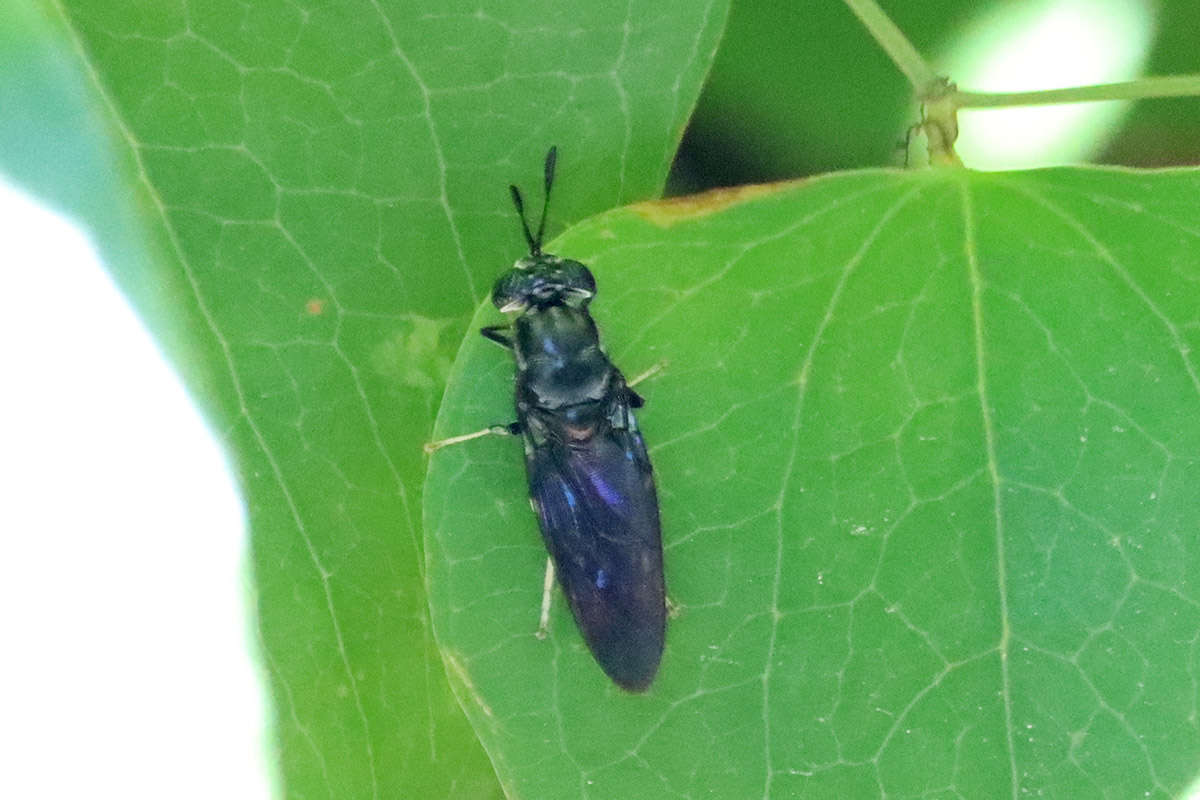
This is always a welcome sight near our compost bins. In fact, I caught this one flying away from one. Black soldier flies lay eggs in compost, and their larvae provide the valuable service of eating vegetative waste and excreting compost.
April 20, 2023
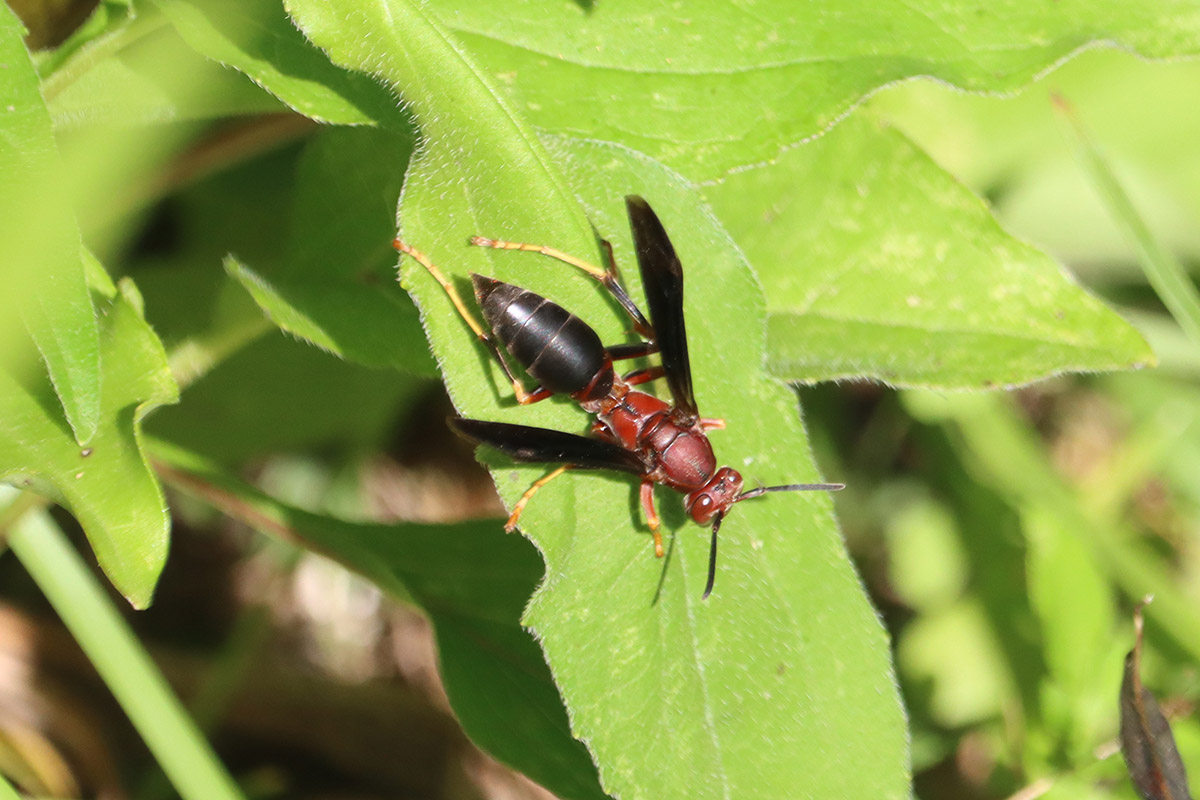
I’ve seen paper wasps of various species patrolling the front flower bed. I don’t know why it works out this way, but I always see the solitary wasp species carrying off the smaller, nondescript moth caterpillars for their larvae, while paper wasps go after butterfly caterpillars on the larval plants I bought for them.
Nature makes no distinction between “cool” and “uncool” caterpillars. Nor does nature care that I like seeing a four-tooth mason wasp taking a small green thing off my pepper plant, yet am horrified when a paper wasp carries off small a monarch caterpillar. Both wasp species are predators, both caterpillars are plant consumers. And yet I don’t like paper wasps.
April 22, 2023

The wild, native lettuce plants are flowering right now, as are the cultivated lettuce plants in our raised beds. Those flowers are identical to this one, but yellow. I should clear those cultivated plants out to make space for the okra I’ve started alongside them, but I like the extra flowers now.
iNaturalist sees this one as a Lasioglossum, suggesting Lasioglossum pilosum. The pilosum look brownish, like bees I’ll see later on. It doesn’t help that the bees are small and the winds whip small flowers around.
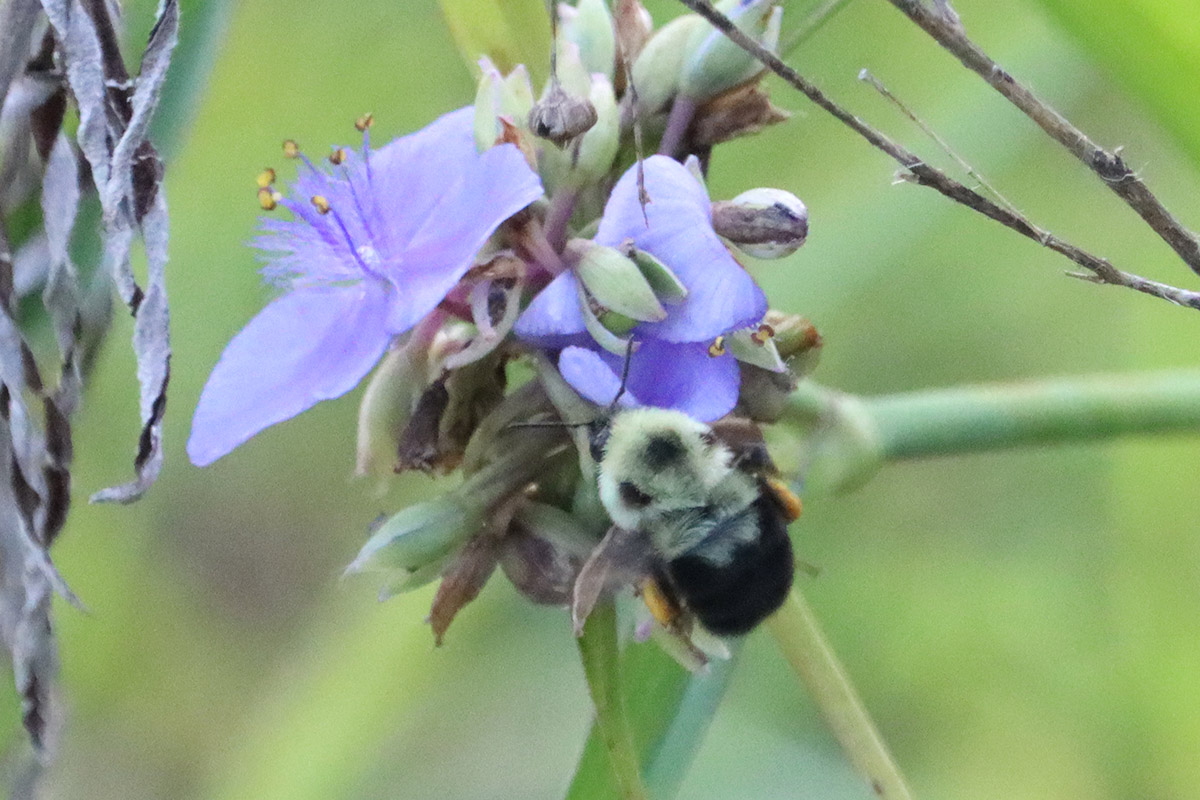
Here’s another bee I thought was different until a later iNaturalist observation told me different. City Nature Challenge was at the end of April, and I uploaded every bee species I saw in the yard. I thought this was a common eastern bumblebee, it is instead a two-spotted bumblebee. The common eastern can vary in size, and so I’ve uploaded a few to see if it was another of the smaller bumblebee species. I think this may be new to our yard. I will also likely have to change a couple of photo captions from earlier in this post (one is definitely a common eastern, but two others look like two-spotted). And I’ll have to add it to the bee species page.
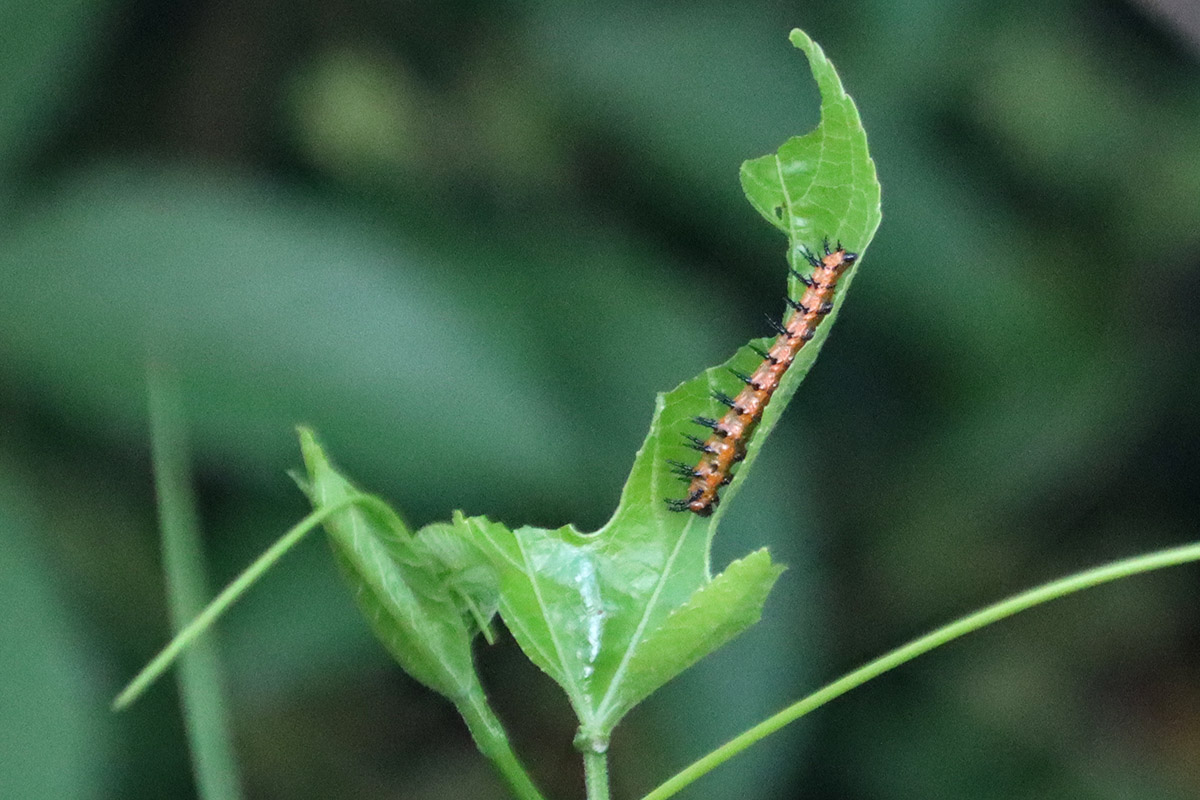
I keep seeing new gulf fritillary caterpillars on our various passionvine plants. They have become numerous, and some, like this one, are in the thick of the front flower patch.
These white masses were within a couple feet of each other, but are different organisms. The left one might be a woolly aphid of some sort, whereas the right image looks like eggs of some kind.
EDIT 5/5/23- An iNaturalist user left a comment on the observation I made for that clump of eggs in the second photo. The user had a similar photo for which someone recommended Ichneumonid wasp eggs. This is interesting— Ichneumonid wasps are parasitoid breeders. At least two Ichneumonid species have been spotted near this, but what organism is potentially being parasitized here?
April 23, 2023
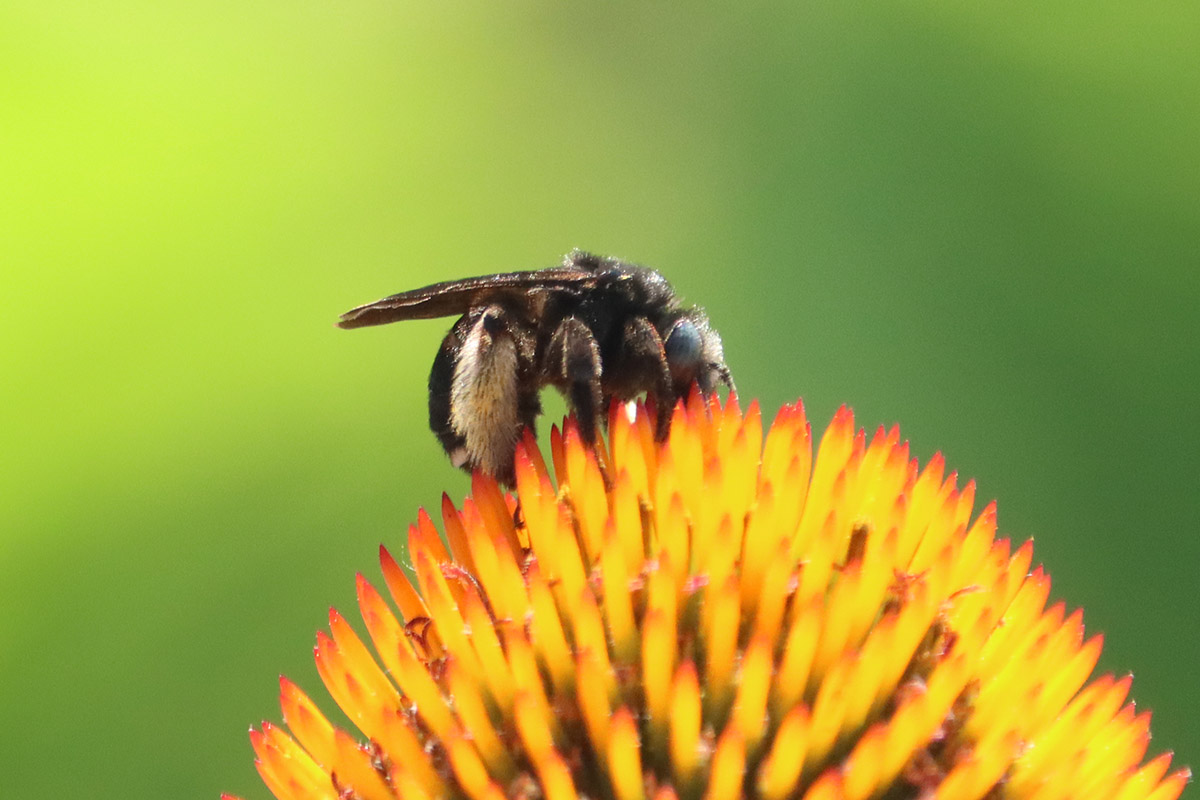
Today, our summer bees showed up for work a little earlier than usual.
The two-spotted longhorn bee is a regular visitor in the yard, usually from mid-May through early July. Filtering this species by location on iNaturalist, this bee has never been observed in April in Leon County. That’s not to say they haven’t been here, but iNaturalist users have not photographed them. And that’s consistent with what I’ve seen (I have gone back and uploaded this one to record this seasonal variation).
I’ll also note that this two-spotted longhorn looks a little more hairy than what I’ve seen, especially that yellow tuft on its forehead. There are bees of this species with photos that look like this on iNaturalist, but they’re all farther up north. Something to keep an eye on.
EDIT 5/5/23- This could be a male of the species, which I’ve not seen before in the yard.
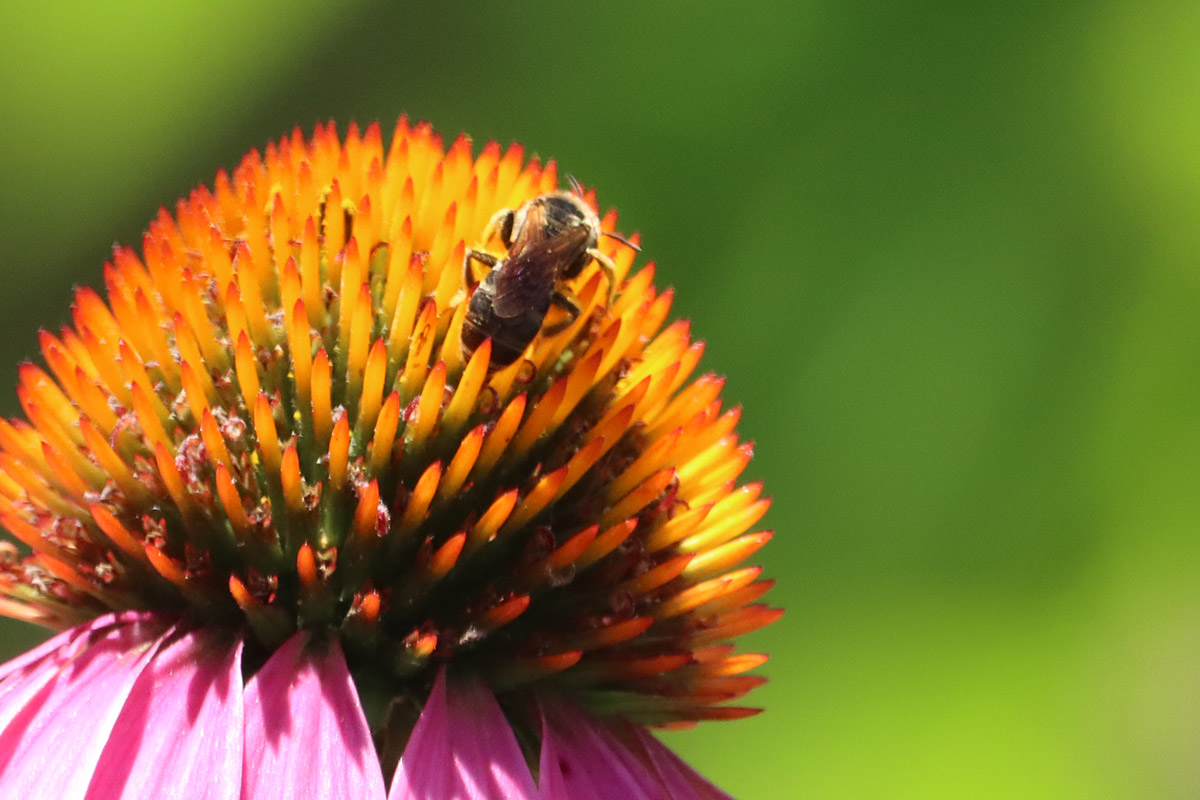
I saw a Poey’s earlier this year, but that was a one-off sighting. As of today, this bee starts its summer residence. Last year, for the first time, it stayed through Thanksgiving. Bees are showing up earlier and staying later. I’d like to think this is because I have more flowers for them, and more flowers for each different season except winter.
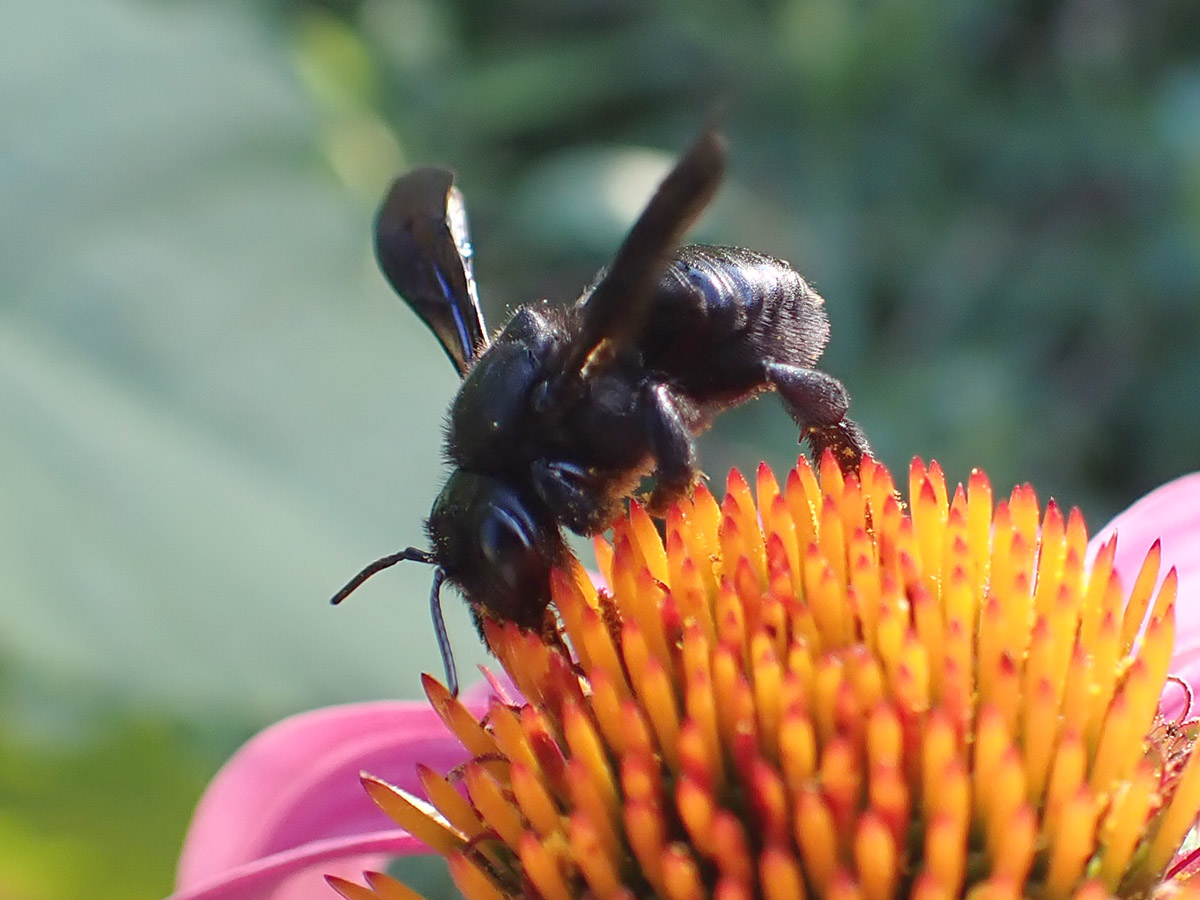
We’ve been seeing a female carpenter-mimic in the yard, but this is a different individual. Leafcutters carry pollen under their abdomens (their butts). This one lacks the signature yellow pollen coating. Maybe she’s newly hatched.
April 24, 2023
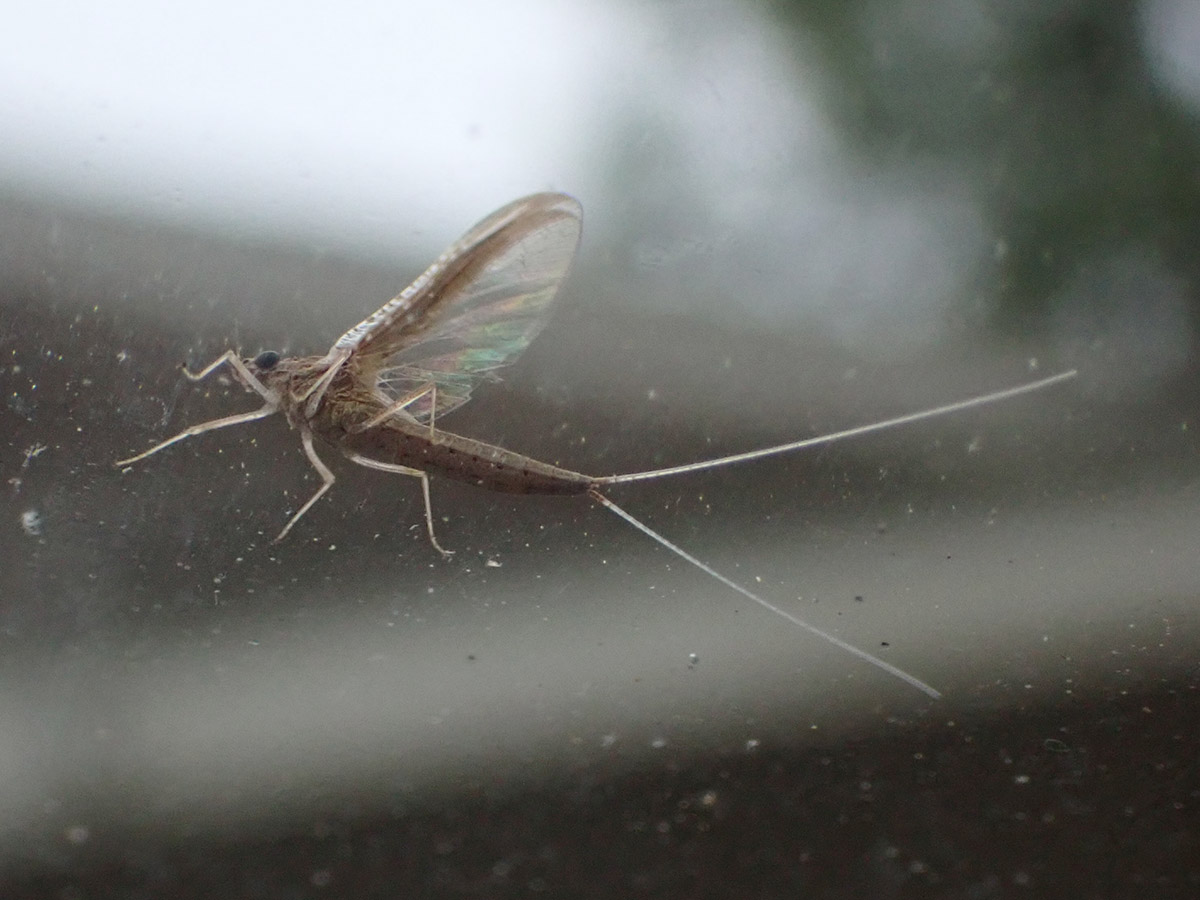
As I was starting the car to take the kids to school, I saw this on my windshield. It’s a type of mayfly, an organism that spends most of the year as eggs, and then nymphs, in a body of water. Mayflies emerge as adults all at once, and live as adults for a couple of days as they mate and then lay eggs on a water surface. Most of their lives are spent in the water, eating algae and detritus.
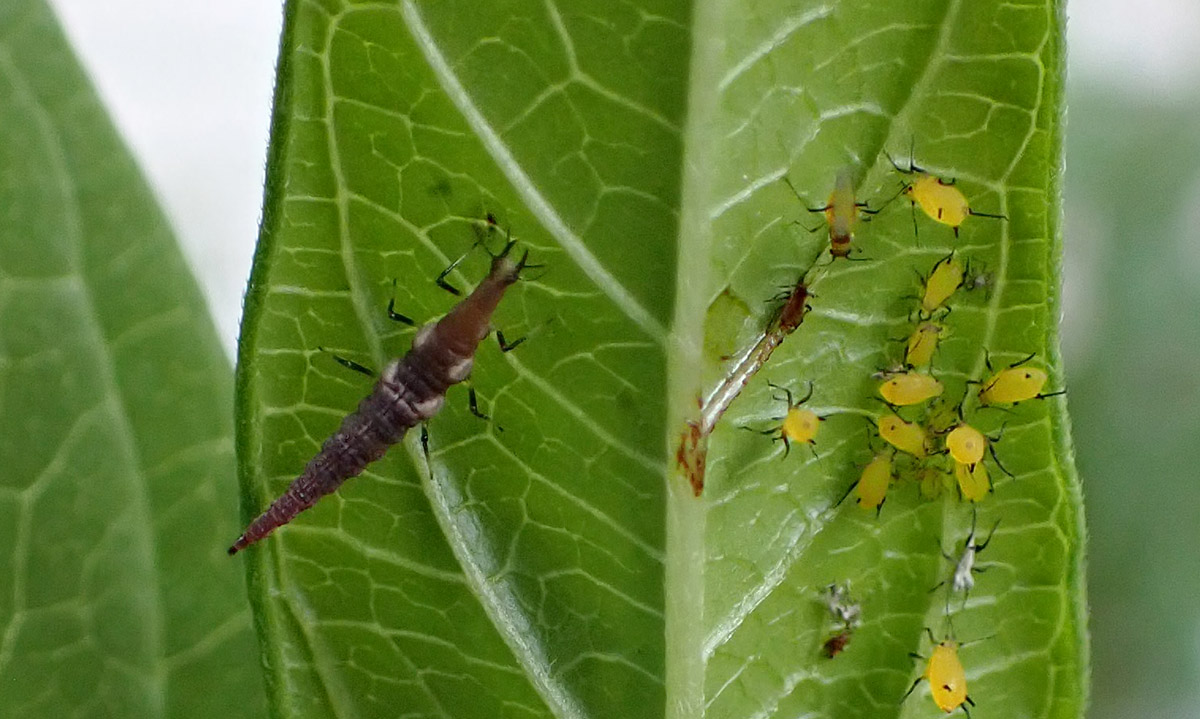
One of the aphids in this photo almost looks like it’s left a tail of blood behind it. To the left is an aphid predator, a lacewing larvae. These have been in the yard before, but I’ve not seen them on milkweed. I wonder if this predator would be a threat to monarch caterpillars.
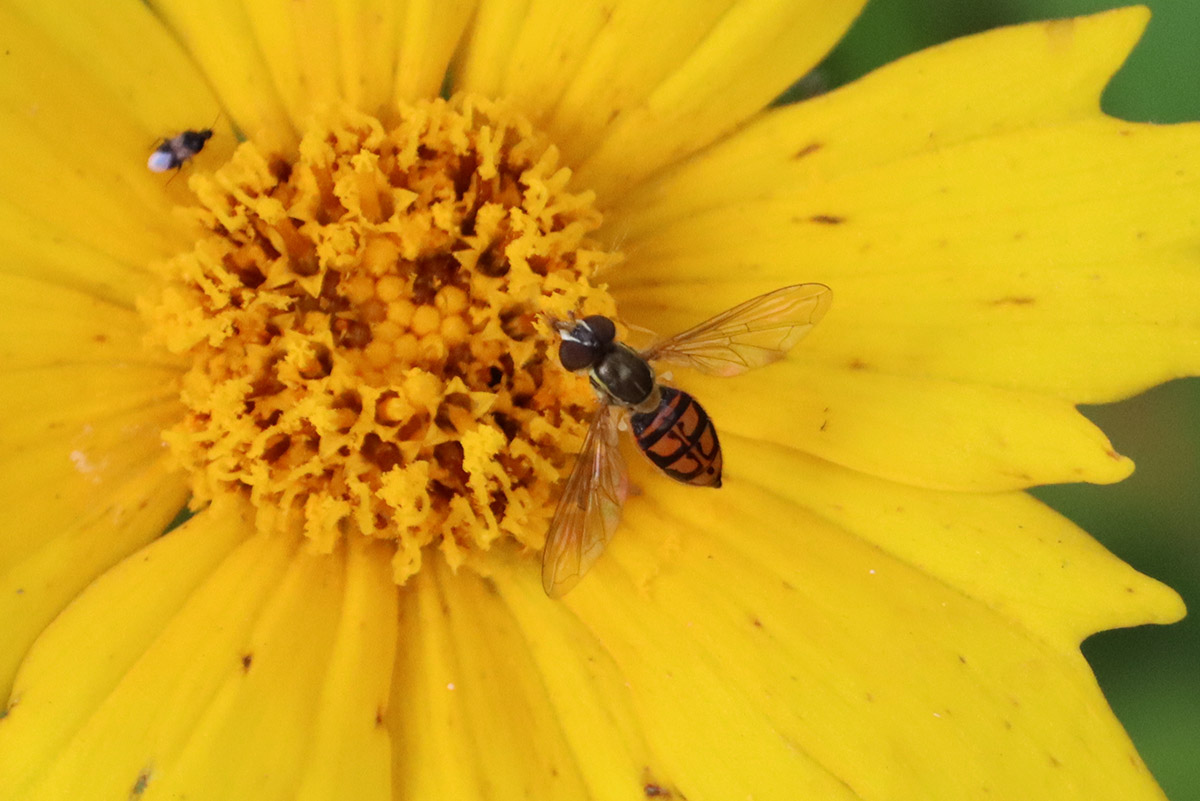
Speaking of aphid killers… Here’s another hoverfly species. I’m seeing a diversity of hoverflies, whose larvae eat aphids.
I won’t share every photo of of every caterpillar in the yard right now, but as we see here, we have gulf fritillaries in multiple stages of larval development.
April 25, 2023
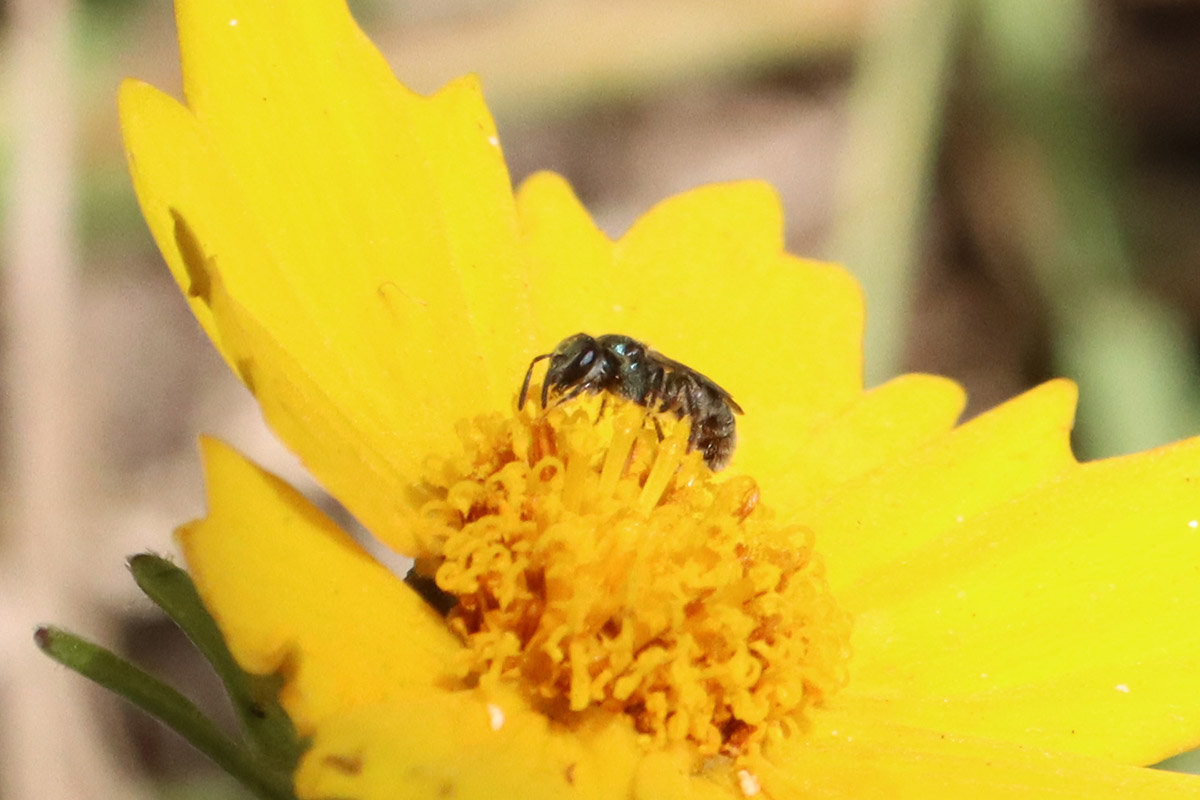
Here is a very small bee. When I see a very small bee, I usually suspect small sweat bees in the Lasioglossum genus. These are dark bees, and some are fully black while others are a little more brown or blue. I upload photos of a lot of these to iNaturalist and don’t usually get anything more specific than a genus-level identification. That doesn’t keep me from uploading pics, and with this bee, I received a surprise.
This is a fairy bee, which are in Andrenidae, the family of mining bees. At least that’s what iNaturalist first said. Its recognition software keep identifying most small bees as fairies, but a curator I trust has identified them as Lasioglossum.
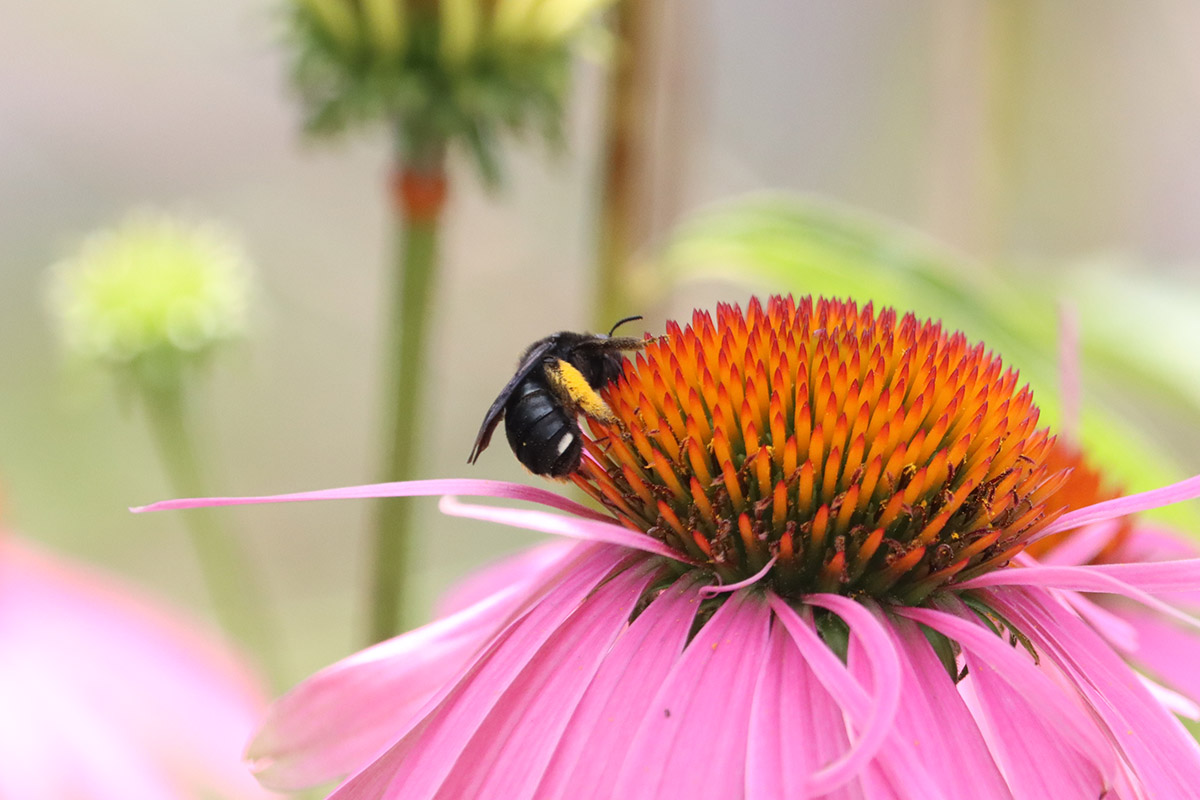
A couple of days ago I saw the male two-spotted longhorn, and here is a female. These last two years I’ve seen more male bees in the yard, which I hope means they’re mating and nesting here. I hope it’s a sign that we’re providing adequate nesting habitat.
April 26, 2023

When I only had two coneflower plants, they were not the most visited flowers in the yard. I took seeds from those two, though, and they reseeded themselves in a backyard flower patch. A handful of these plants have been flowering for weeks now, earlier than usual. It seems like anything looking for nectar in April is heading for these flowers.
I see American ladies every now and then in the spring, and wonder if these have been hosting on any of the many cudweeds I let grow in the yard.
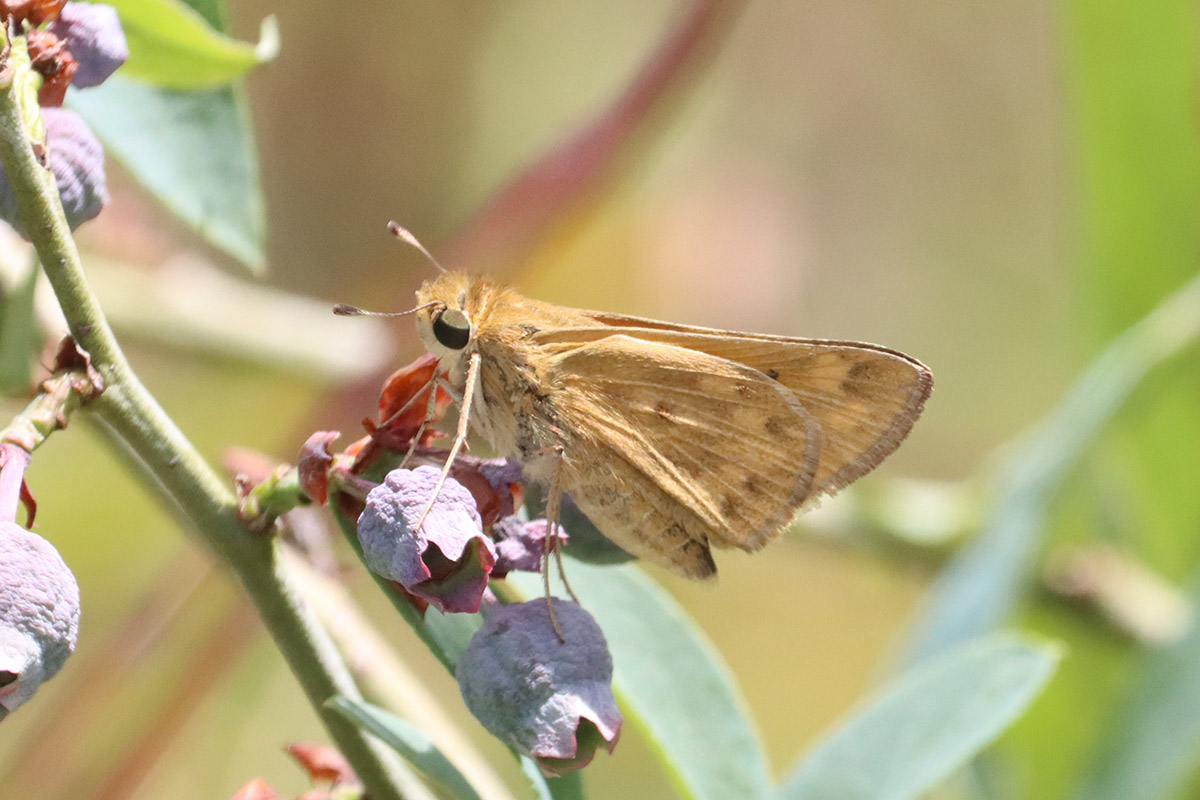
It has been a good fiery skipper year.
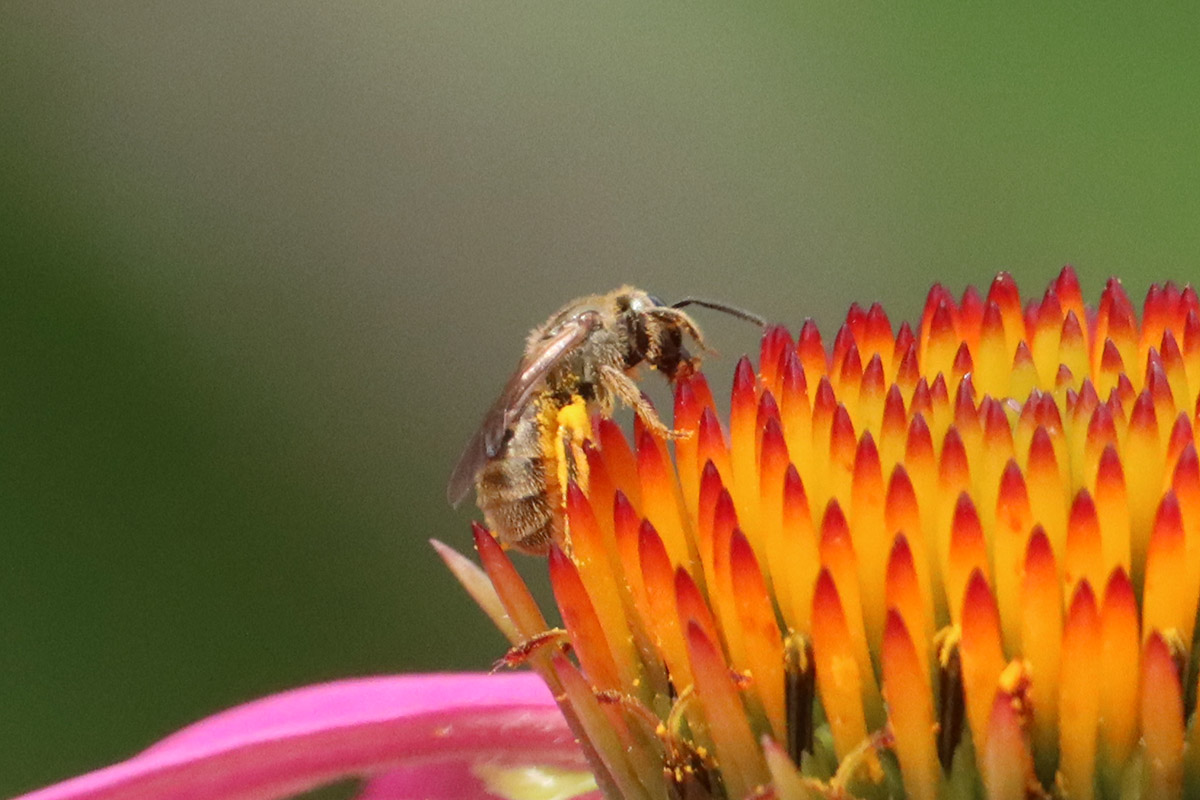
I’ve rarely gotten a species level ID for Lasioglossum bees, until late April of this year. The iNaturalist photos for Lasioglossum pilosum show a brownish version of the bees I’ve been seeing for years, and this is the first time I’ve noticed them looking a little brown. I’ll keep photographing these guys when I see them, and continue to try and learn about them. EDIT 5-16-23: John Ascher, a bee researcher active anywhere people upload photos of bees, disagrees that this is Lasioglossum pilosum. The most specific ID for this is Lasioglossum subgenus Dialictus.
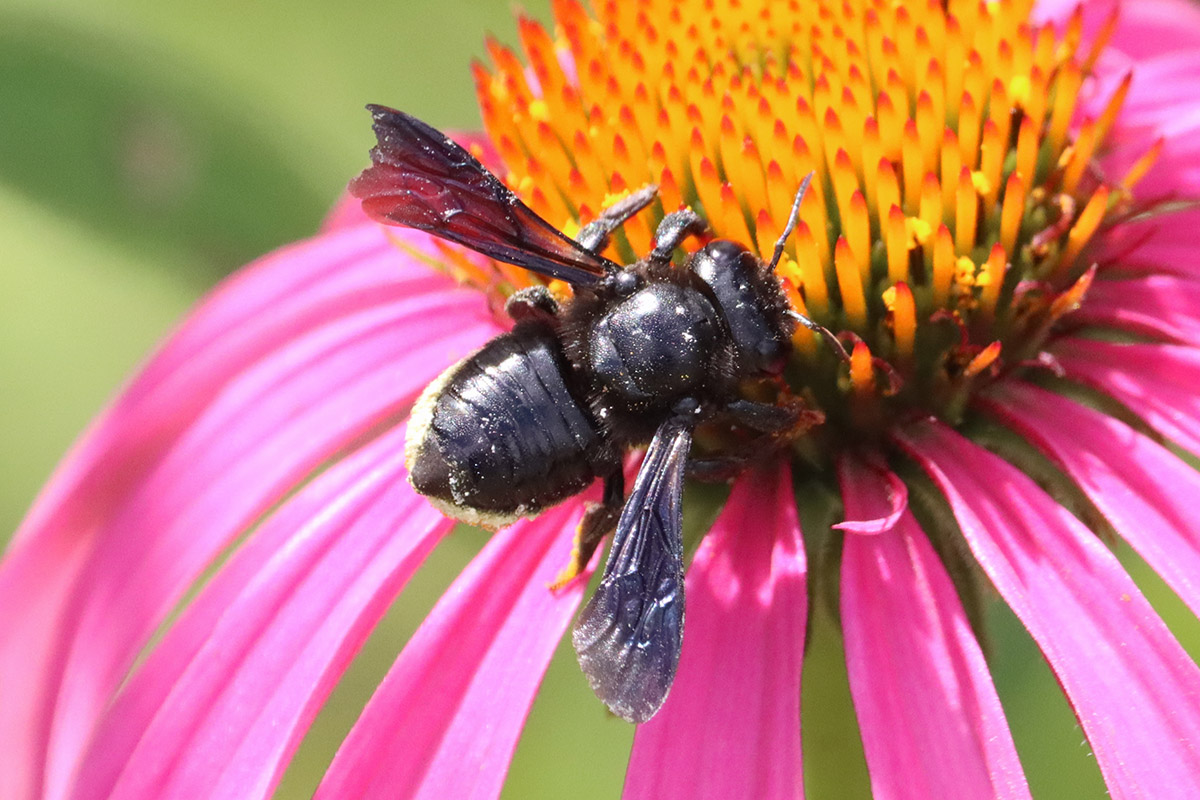
I like that these have become a fixture in our yard.
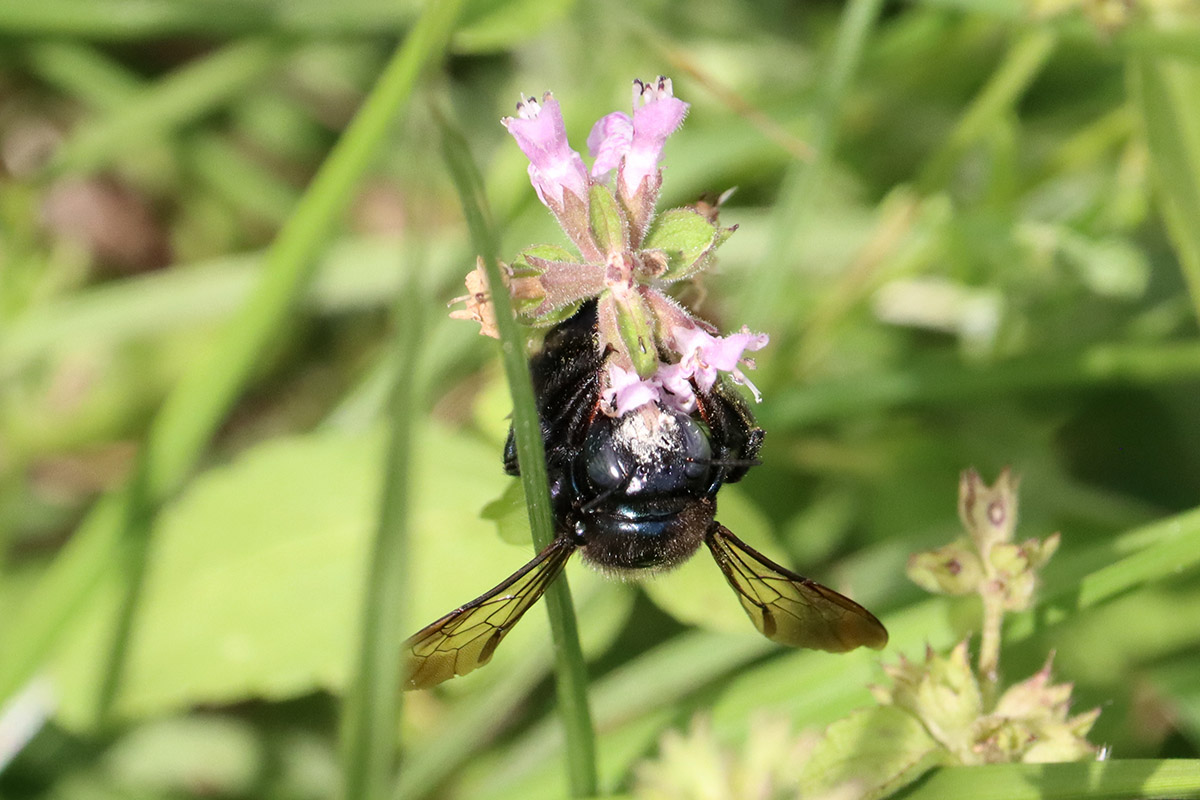
From this angle it really looks like a southern carpenter bee. The betony has really lasted this year, and bees continue to visit every remaining flower.
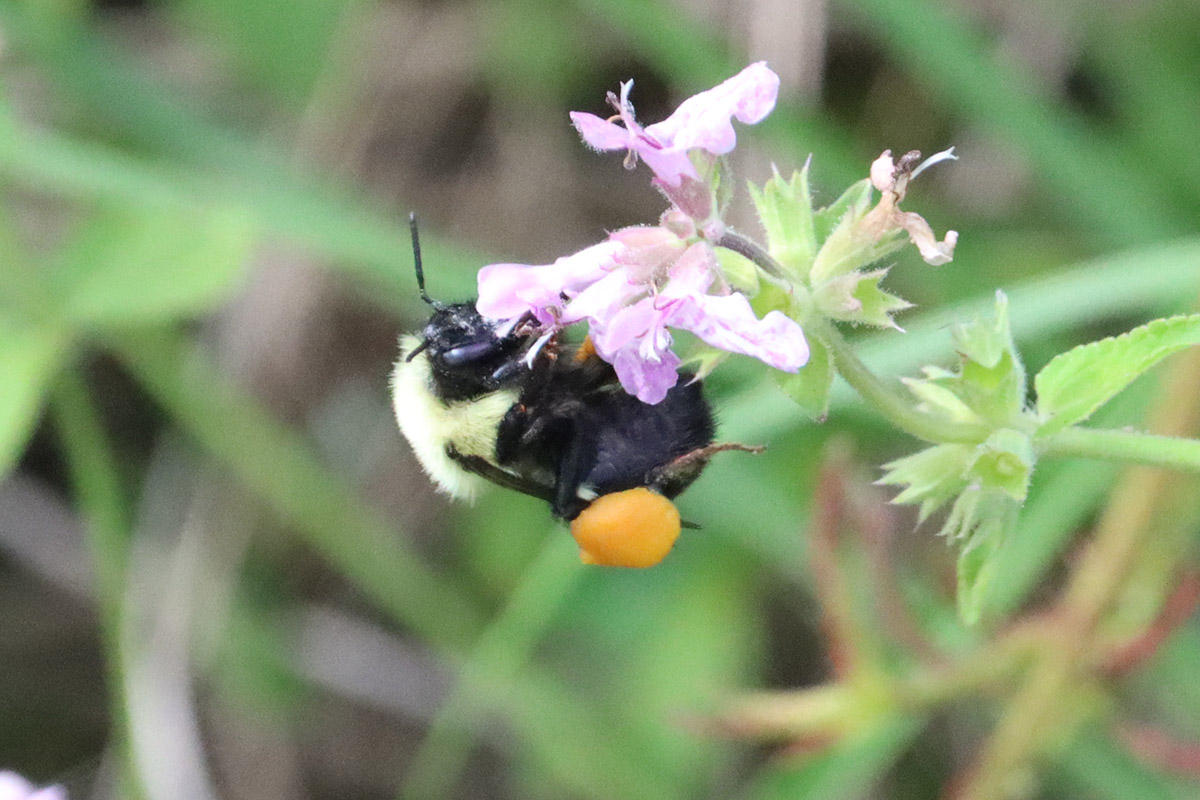
At least I think it’s a common eastern. Now that we have a second similar looking bumblebee in the yard, I’m having to take a closer look.
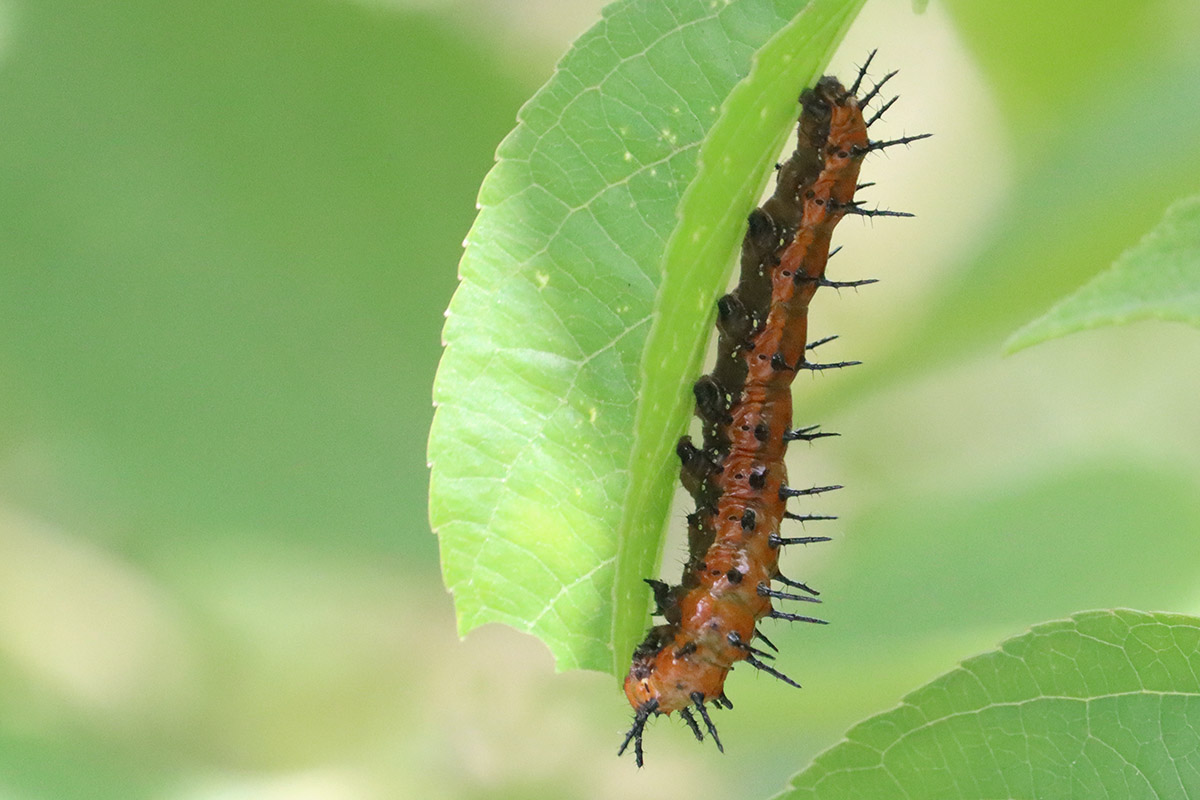
This caterpillar will soon crawl off to make a chrysalis.
April 28, 2023 | Day 1 of the 2023 City Nature Challenge
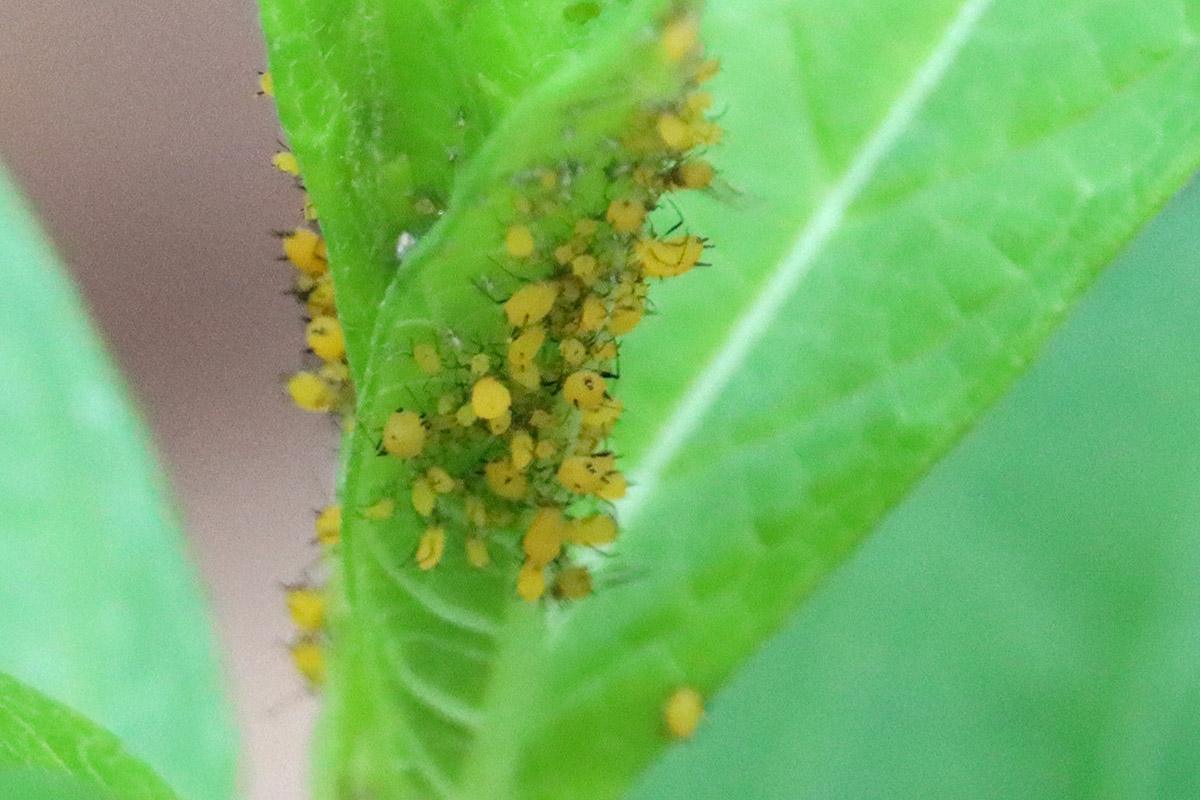
Today is the first day of City Nature Challenge 2023, so I’m uploading a lot of photos to iNaturalist. Many of them are commonplace insects like these. Today, however, I saw a few new visitors to the yard.
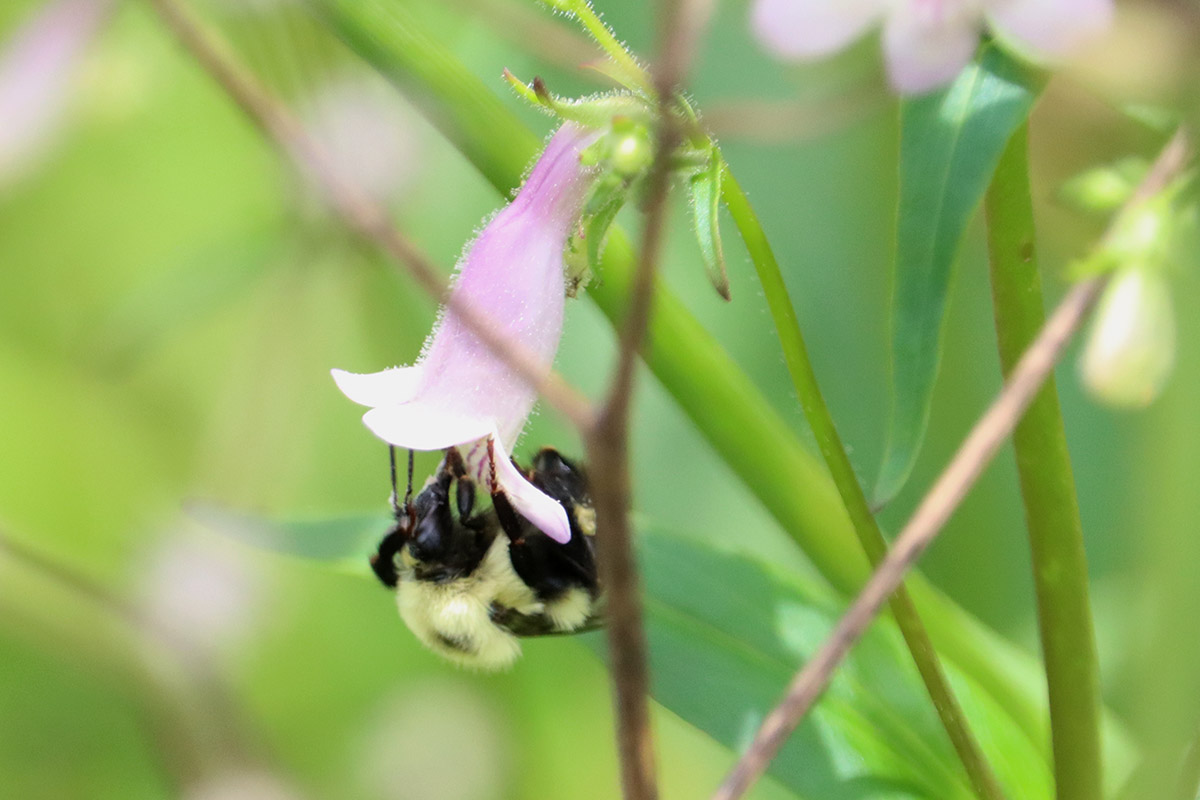
Not a great photo, but I would soon be taking many more of this bee. This is one of two bees I had earlier mistaken for other similar looking bees. I had thought this was a common eastern bumblebee, and over the years, I’ve iNaturalised a few of those if one was particularly large or small, or its pattern looked slightly different to me. And now here we have a different species. It’s the fourth bumblebee species we’ve seen in the last few months, after years of only seeing (as far as I knew) common easterns.
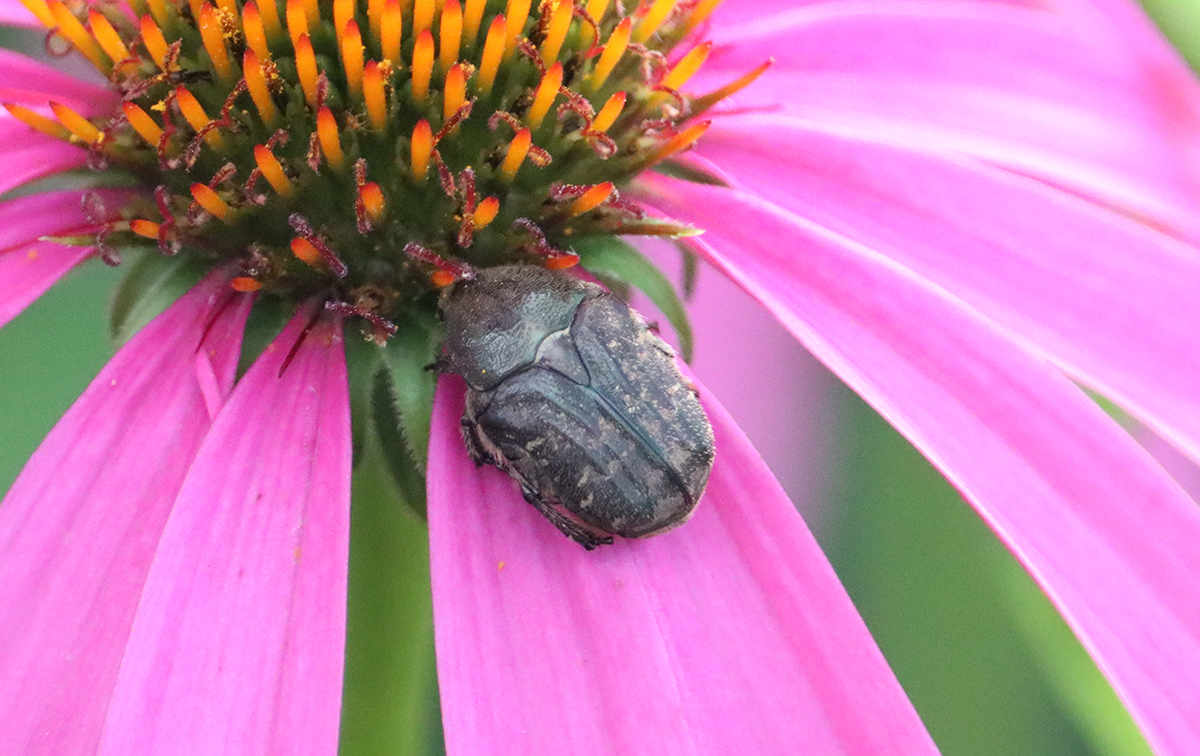
This is turning into a good year for pollinating beetles. Or is it a pollinator? It eats pollen, but also rotting fruit and tree sap. According to a University of Florida pdf I found, they can be considered pests because they damage fruit trees, roses, and corn.
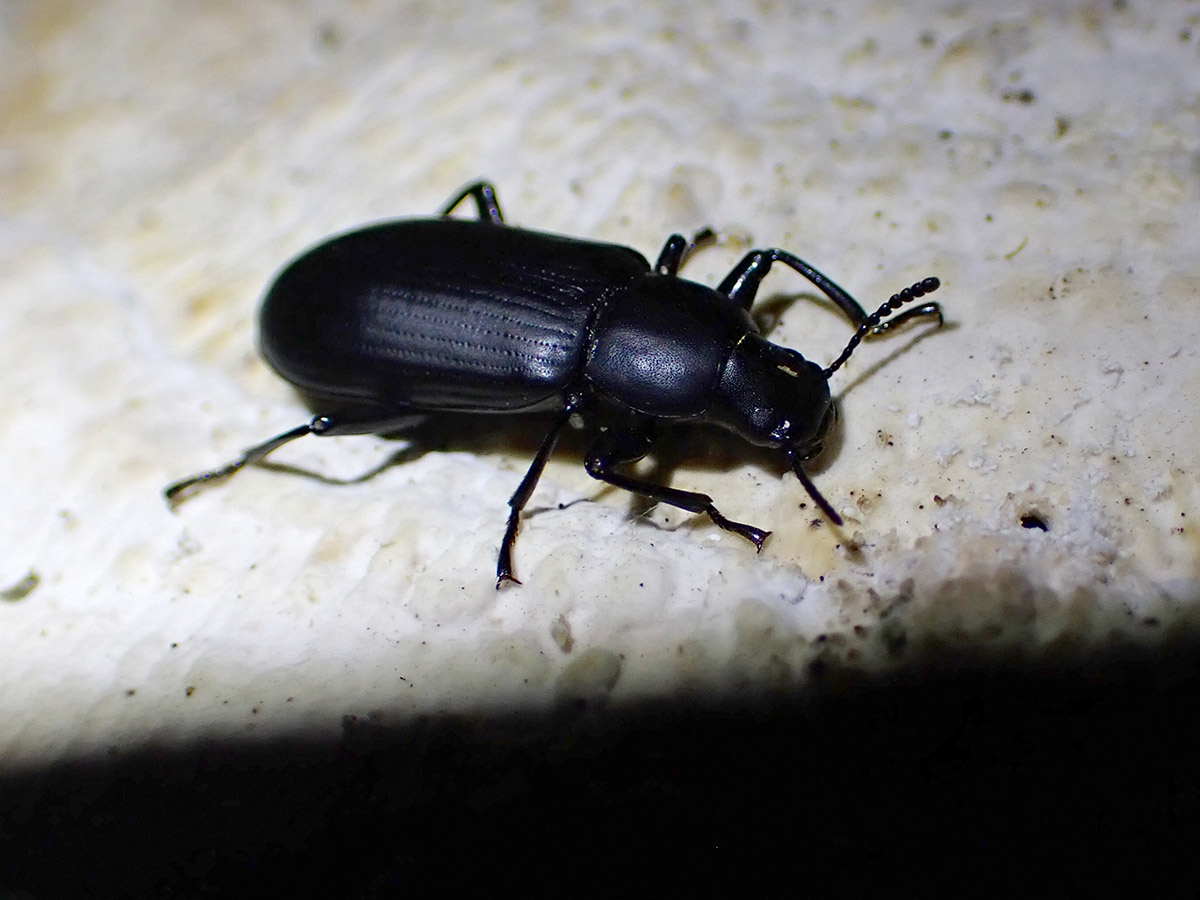
I found this one at night, and would find it on a few subsequent nights, right on that mushroom. From what I read on bugguide, its larvae live in decomposing wood, where they eat other beetle larvae. This mushroom is on a decomposing section of a laurel oak.
Adults eat beetle larvae as well, but it looks like this one repeatedly came out to eat this mushroom.
April 29, 2023 | Day 2 of the 2023 City Nature Challenge
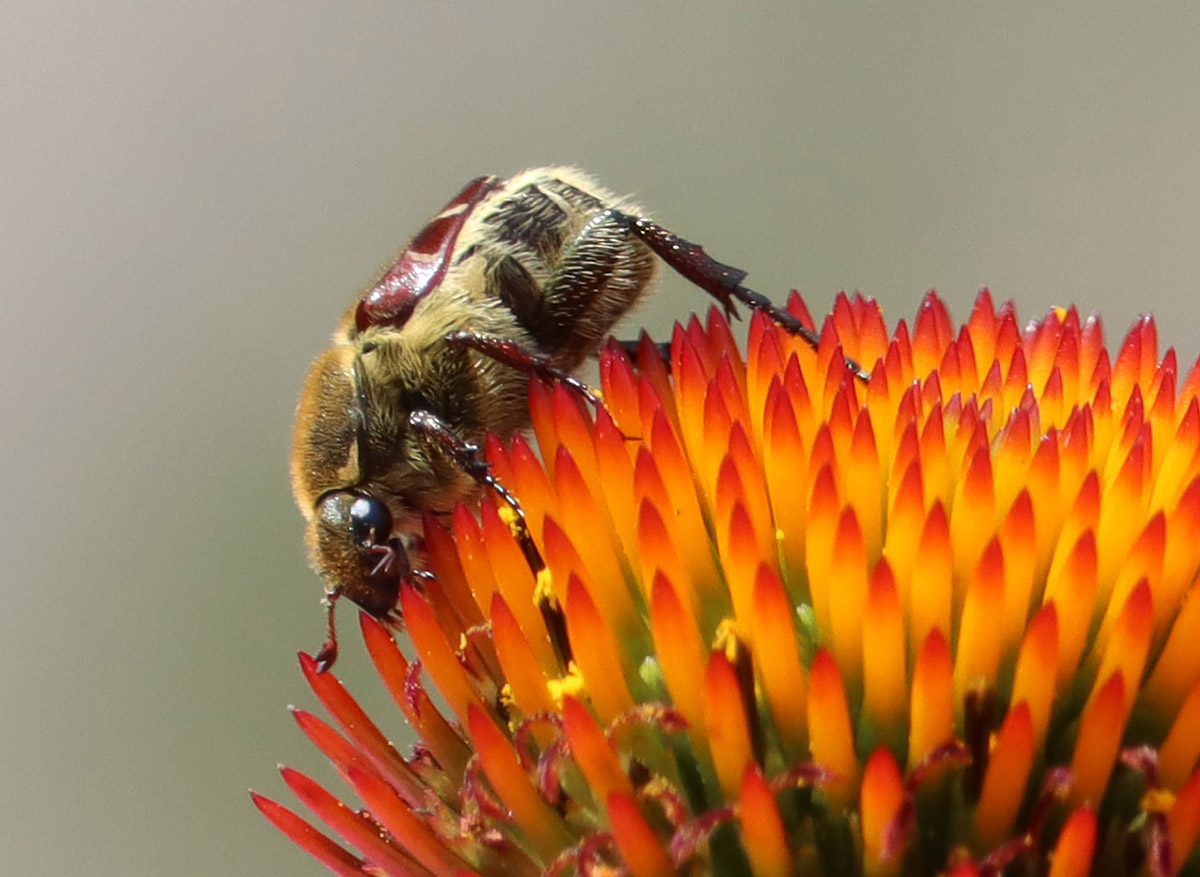
Another flower beetle on the purple coneflowers. The three of these that are blooming right now are the epicenter of pollination in our yard right now.

Not every insect on the coneflowers is a pollinator. I mostly saw leaf-footed bugs in this flower patch last year, where I like them— away from the food plants. We’ve had coneflowers for a month or so, and some are starting to wilt before most of our plants have even bloomed.
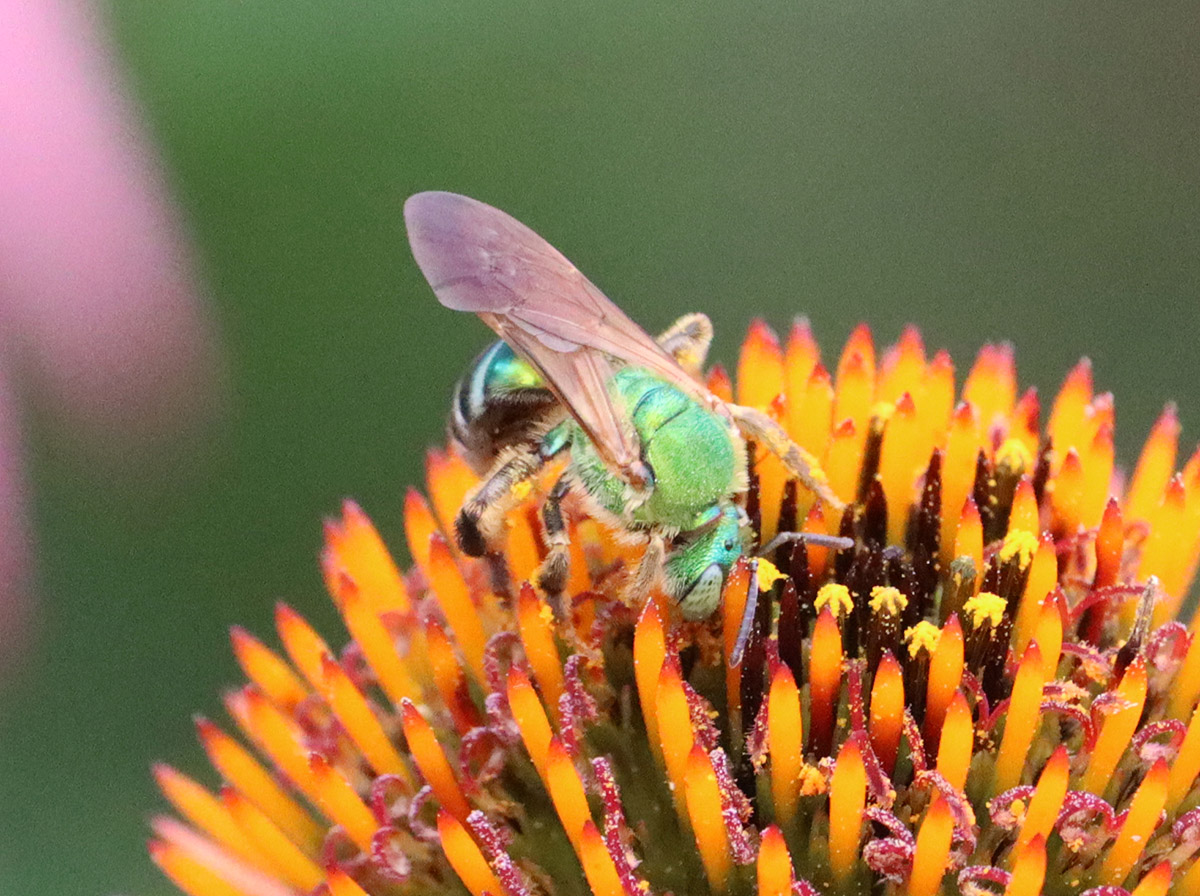
Another coneflower visitor.

Here’s a second native lady beetle species in our yard, in a year where Asian lady beetles have been prolific. I wonder if I squished the invasive lady beetles, would that open up space for the natives?
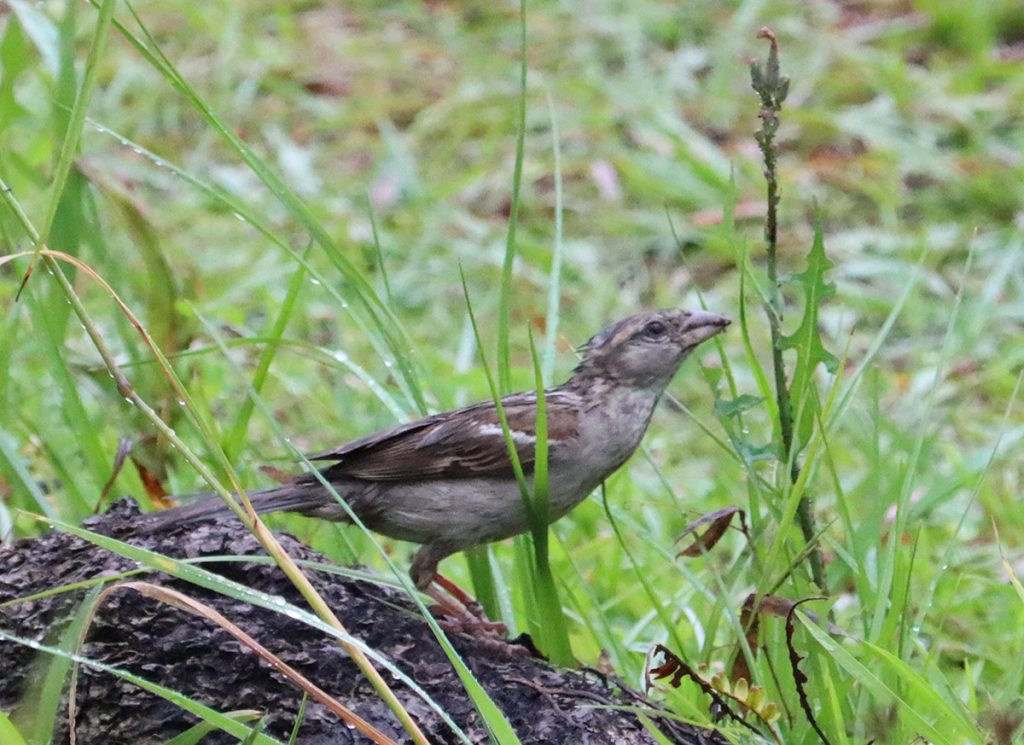
Here’s another nonnative, a house sparrow, but I like what it’s doing here. I was ready to pluck all the native lettuce plants out, as they’re large and in areas where other wildflowers are starting to grow larger. The lettuce has already gone to seed anyway. But then I kept seeing these sparrows come and eat aphids off of them. Even after it starts to decline and die away, this plant is offering an ecosystem service to birds.
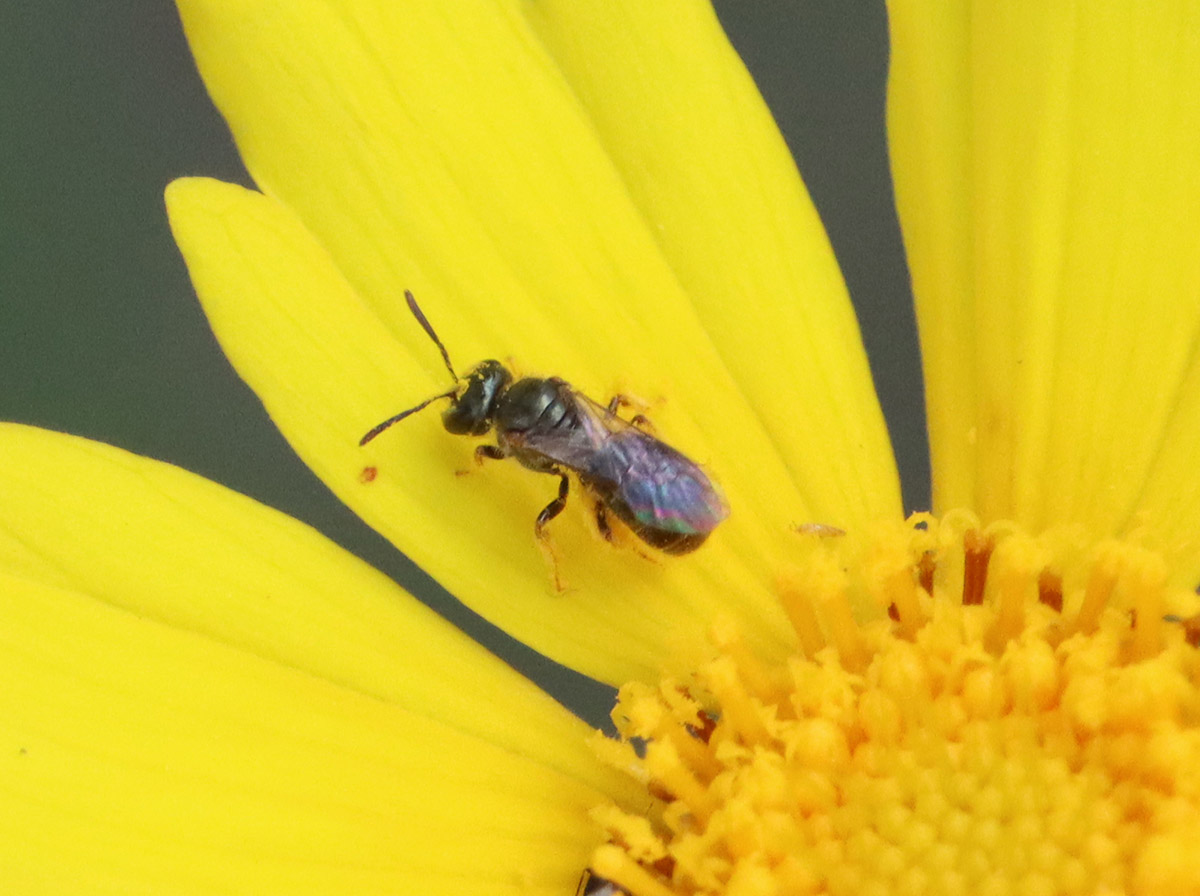
EDIT 9/21/23 – These are indeed Lasioglossum bees. It was a fun idea that we had another new bee in the yard, but I received a reliable ID that this is a sweat bee.
ORIGINAL POST – Here’s a good shot of a fairy bee. This observation had me re-examining my small bee photos, which I had thought were all Lasioglossum sweat bees. It’s a good lesson to keep taking a look at the smaller, harder to identify insects.
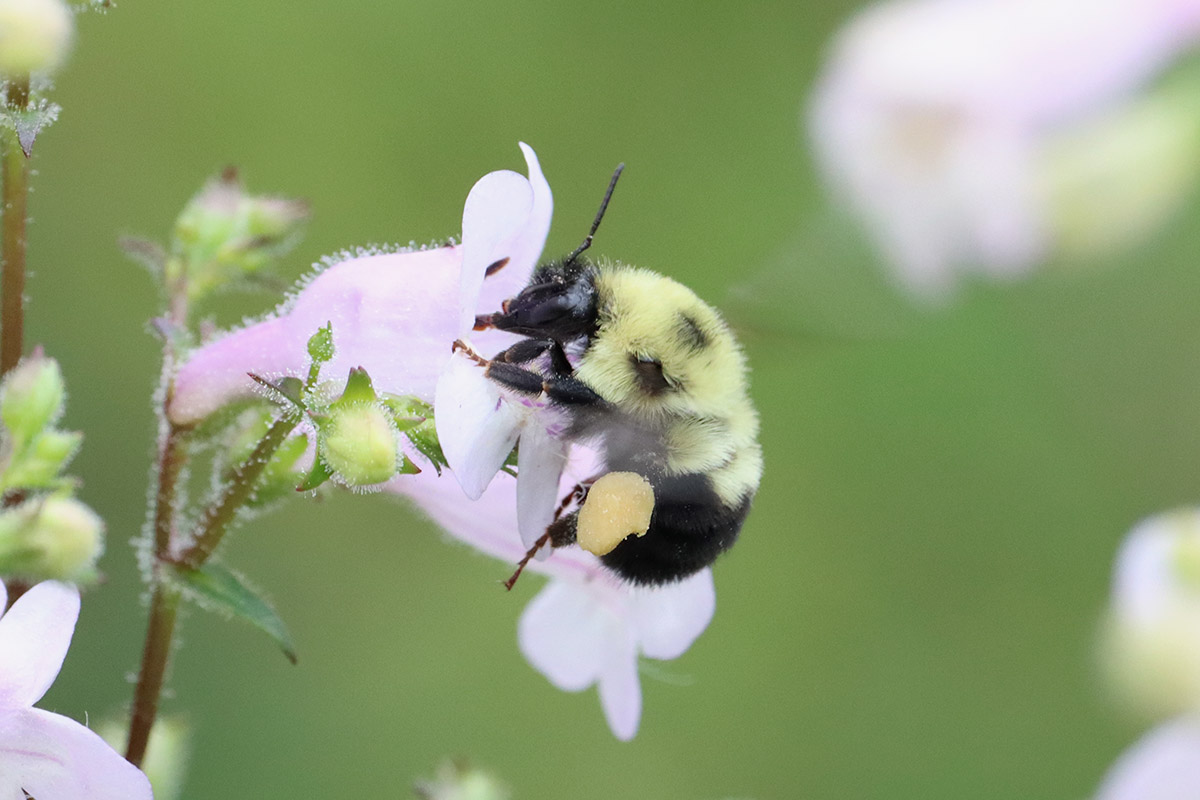
Here’s the two-spotted bumblebee again. In photographs, I’m starting to notice the two spots on its back, and the stripe on its abdomen thats yellow in the middle. In flight, I can’t always differentiate it from a common eastern bumblebee.
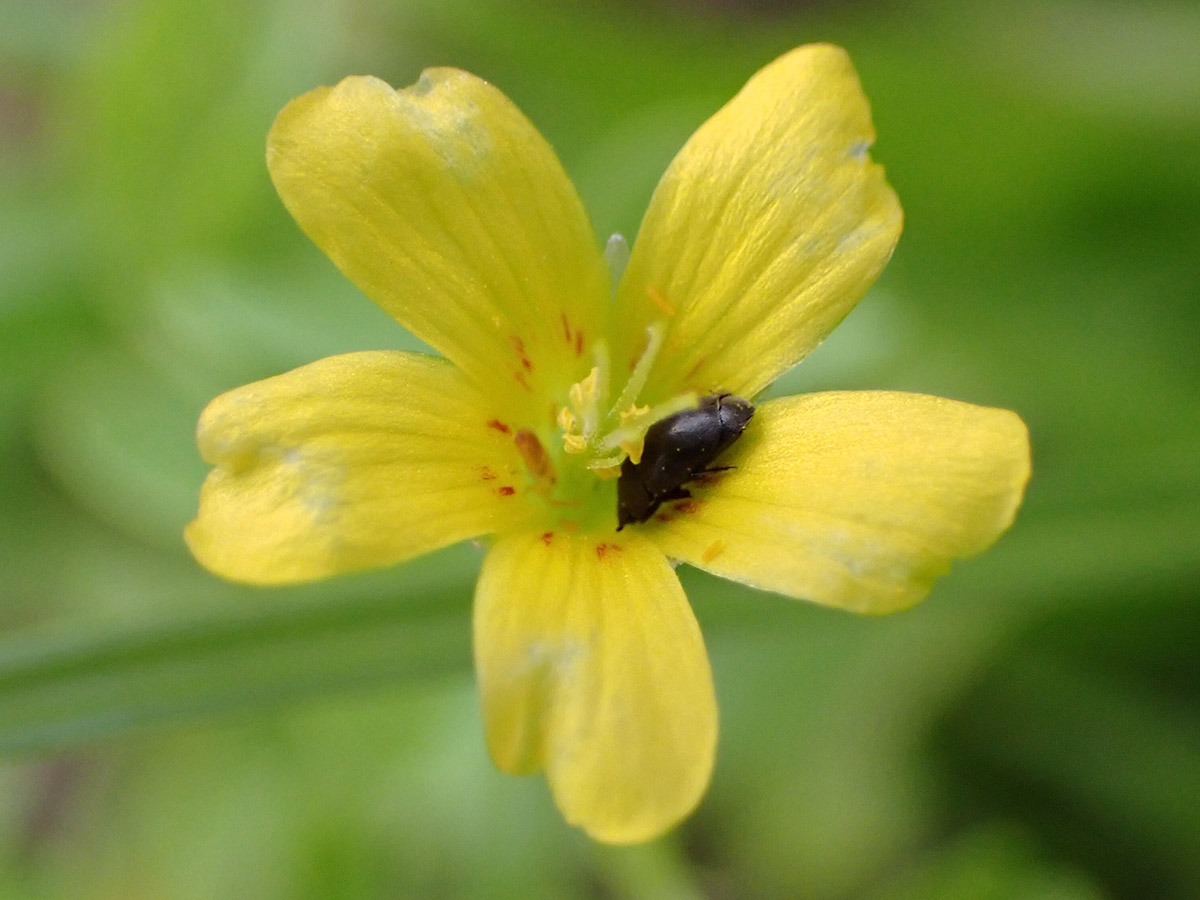
This is as specific an ID as I could get for this little beetle.

The tubeworm moth makes another appearance. Am I seeing them more this year? It would make sense, as our brush piles are growing the mushrooms on which their caterpillars feed.
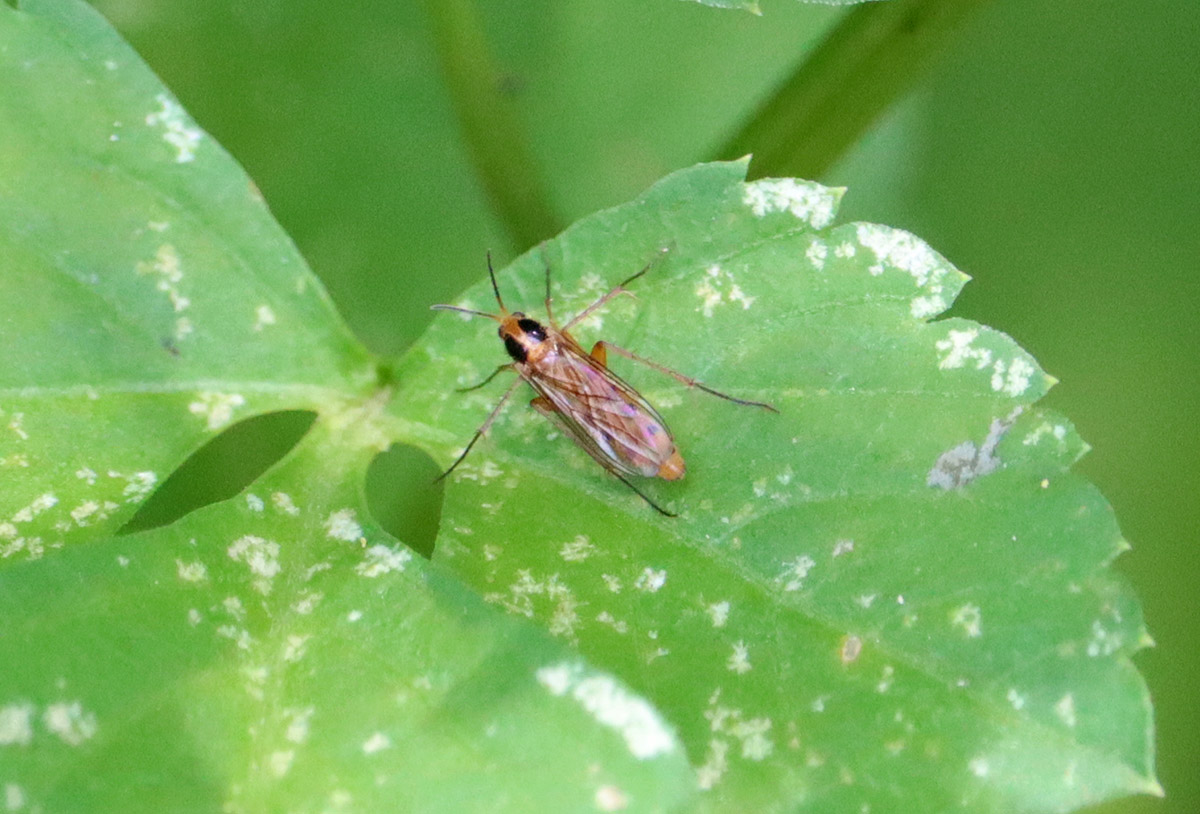
And another insect whose larvae eat fungus.
April 30, 2023 | Day 3 of the 2023 City Nature Challenge
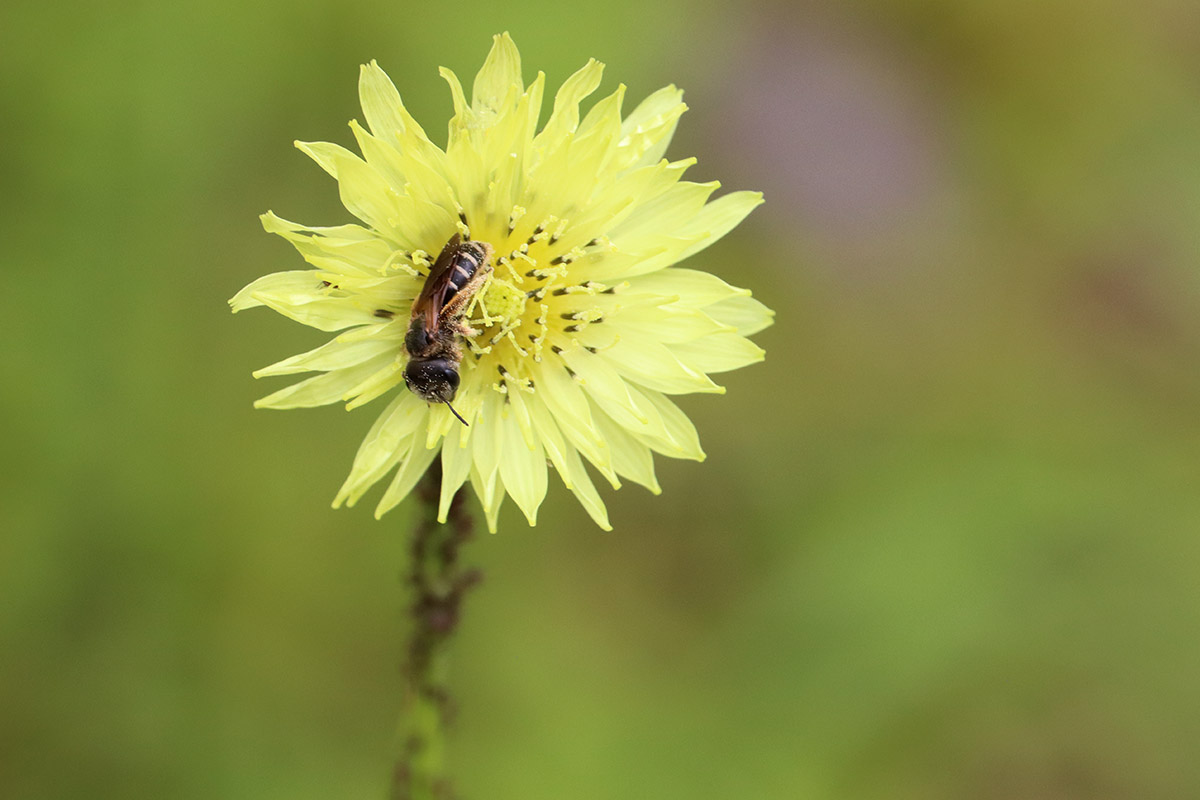
It was a slow day on the home front as I took my cameras and my sons out into the Apalachicola National Forest to rack up CNC observations. Here’s a pretty native weed visited by one of our most plentiful native bees.
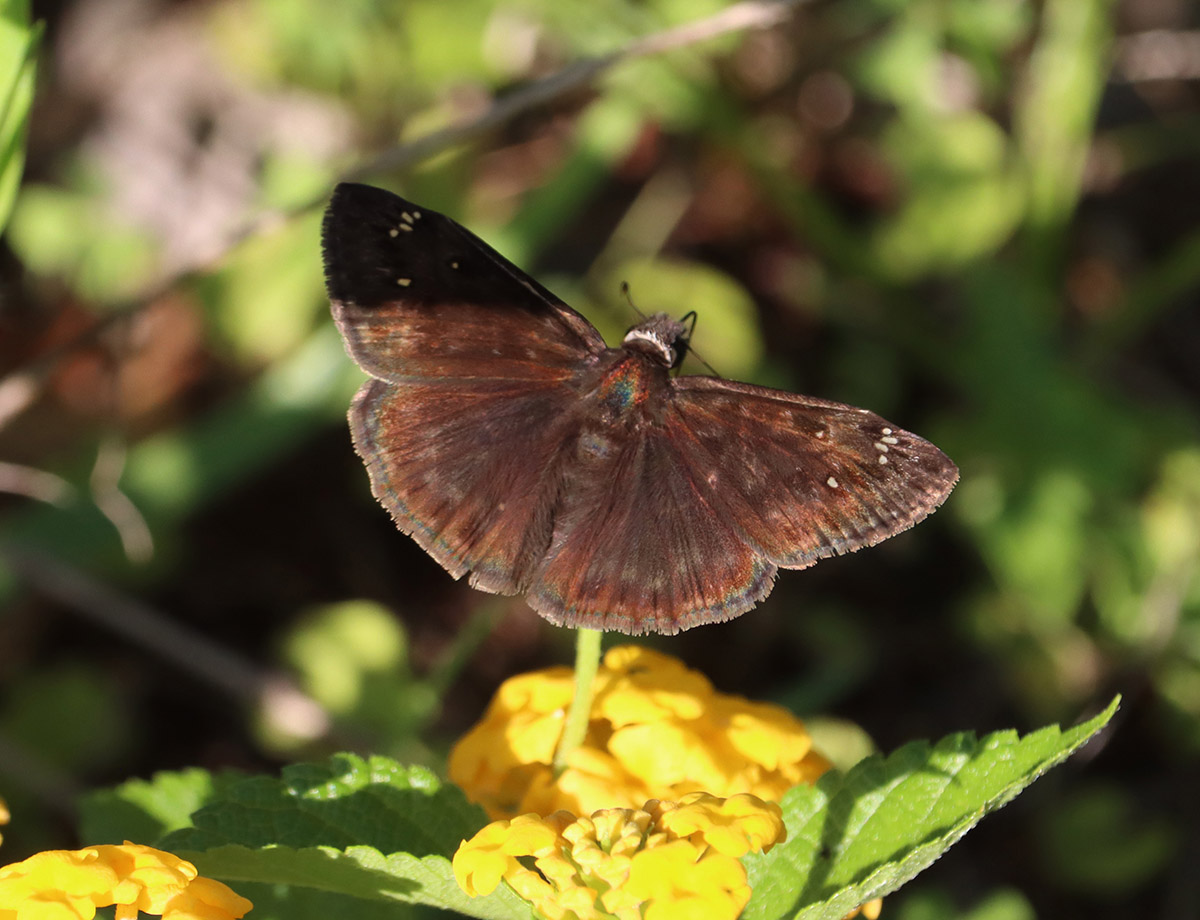
The lantana bed has been outside our fence since before we bought the house. It’s not native, but it’s a sterile cultivar. More than half of it died over the winter, and I’m trying to establish more native wildflowers here. The lantana has always been popular with butterflies.
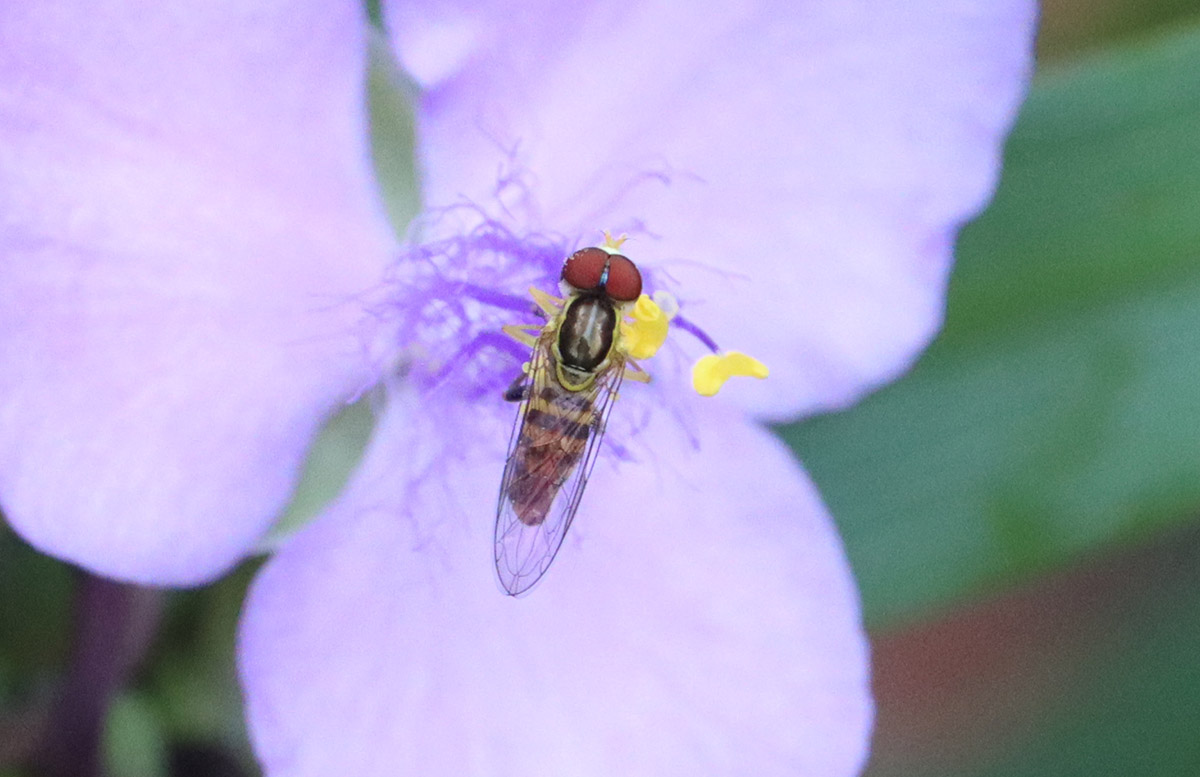
This is the third species of calligrapher, and fourth hoverfly overall, we’ve had in the yard this year. That I’ve ID’d, anyway.
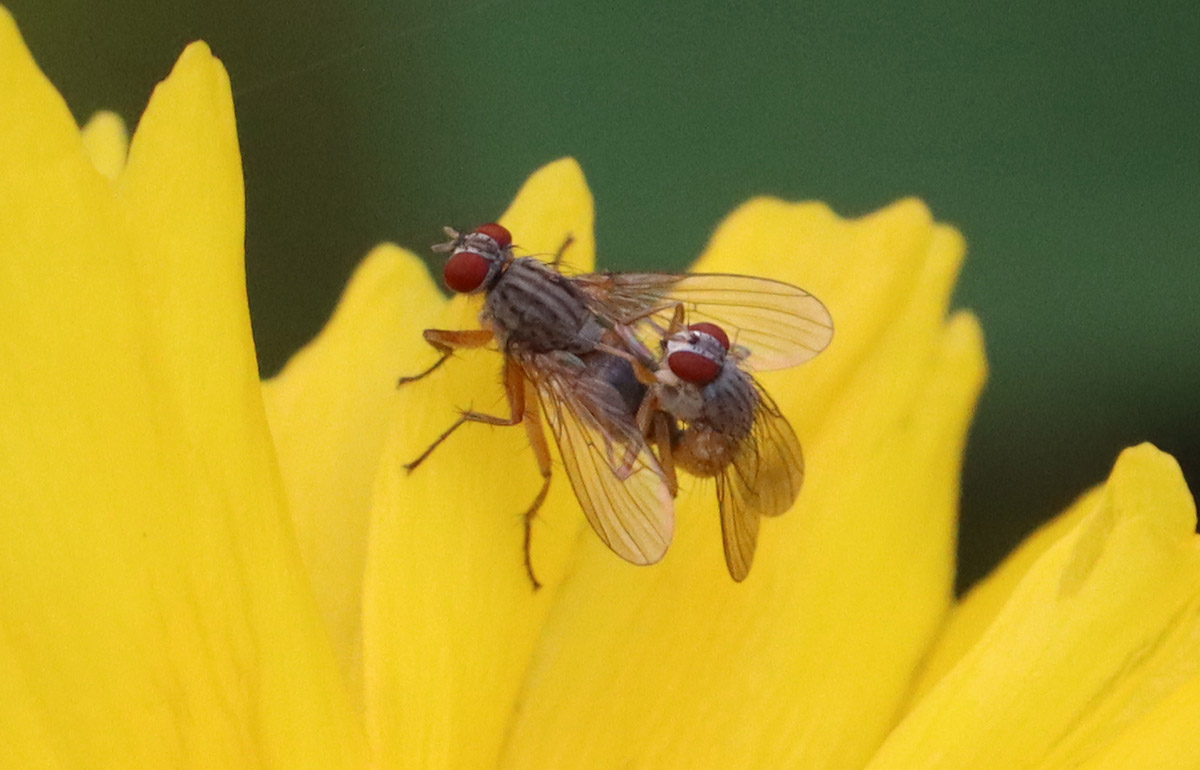
Muscoids are a superfamily of flies, and sometimes we don’t get a more specific ID than that from iNaturalist. Using the compare feature, it looks most like a common housefly. Common houseflies are all over the world, having spread with humans from their native habitat (perhaps in the Middle East?). For every bee, butterfly, hoverfly, flower scarab, assassin bug, etc., we have the insects that feed on us (mosquitoes, fleas) and our trash (cockroaches, fruit flies). I rarely highlight the latter, but I can’t discount that they’re part of the home ecosystem.
May 1, 2023 | Final day of the 2023 City Nature Challenge
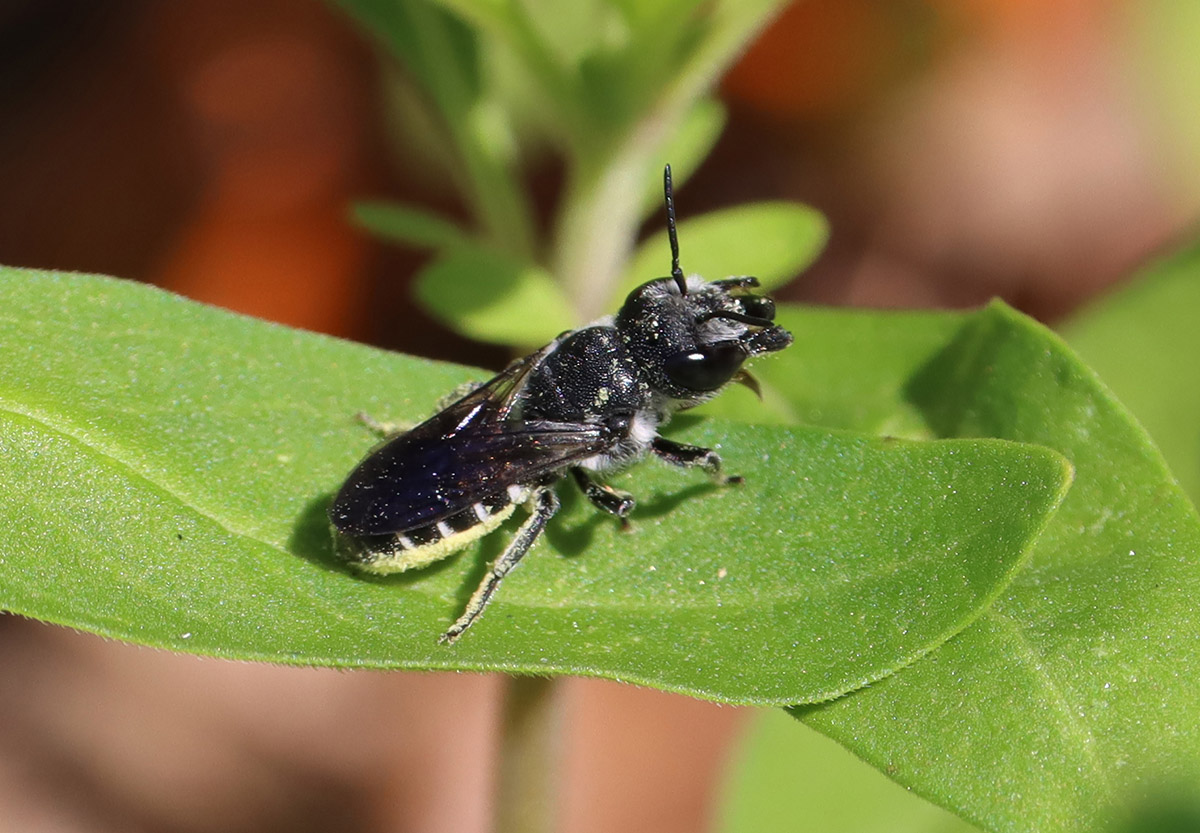
Here’s a bee I’ve seen once or twice over the years, mostly at Klapp-Phipps park. I just happened to walk out my back door and see it resting on a leaf. On iNaturalist, this subgenus has been only very rarely observed in Florida. It’s in the leafcutter family, but does not cut leaves— it’s a resin bee.
I saw it briefly this one day, but never on our flowers. This spot is next to a bee nesting box, which has been used by mason wasps for years. In the following weeks, I’ll quickly see a leafcutter fly into a tube. I think it’s this bee.
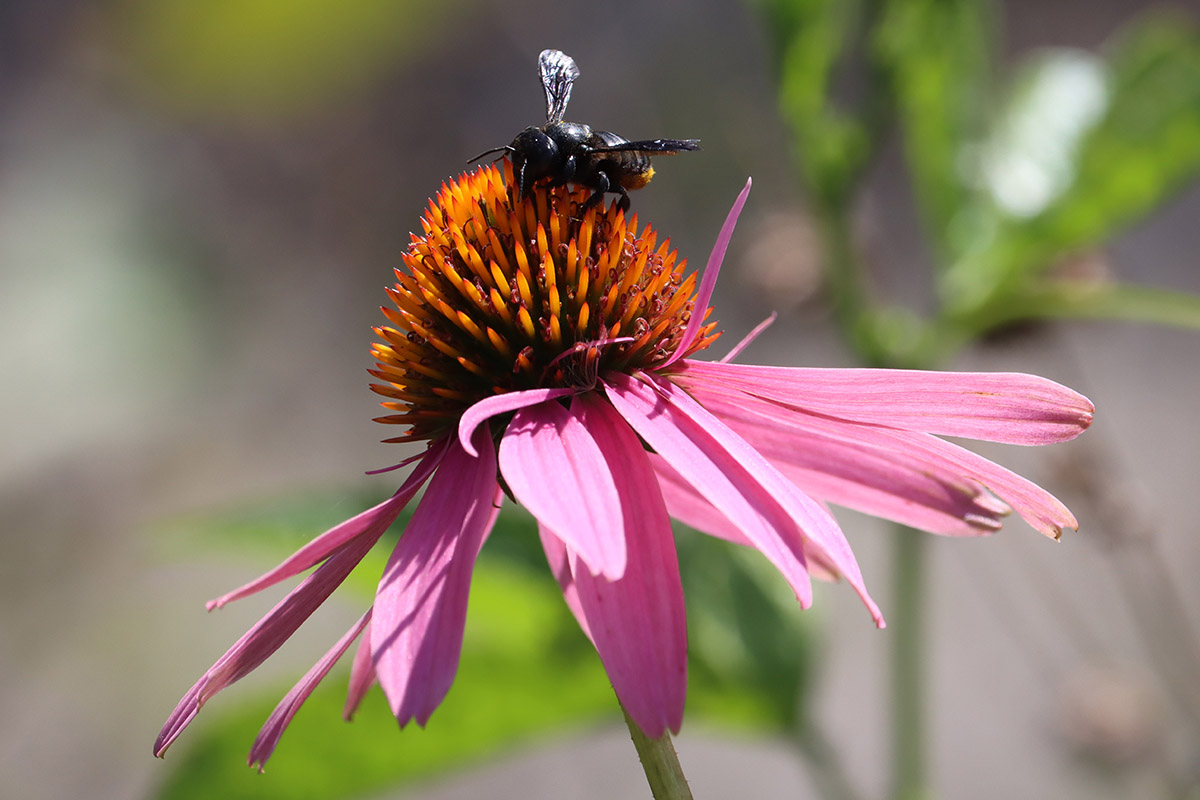
And here’s another Megachile bee. Carpenter-mimic leafcutters have become regular visitors in our yard for the second consecutive year, and we occasionally see other leafcutters as well. This has only happened within the last couple of years, during which our bee diversity has happily increased.

We’ve seen a lot of the two-spotted bumblebee during the City Nature Challenge. Here’s the bumblebee we most regularly see, the common eastern bumblebee.

There are so many similar looking duskywings, it can be easy to assume you’re always seeing the same one. Horace’s duskywings are our usual little brown butterfly, but thanks to my uploading this for CNC, I know this is its close relative.

I walked to a nearby park to make more CNC observations, and was greeted by this hawk upon my return. I feel like many of the critters that showed up over the last four days did so to help show off our yard diversity for the challenge. Not that hawks are an uncommon sight, but its prominent position in the tree as I walked up felt like it wanted to be a cool final observation.
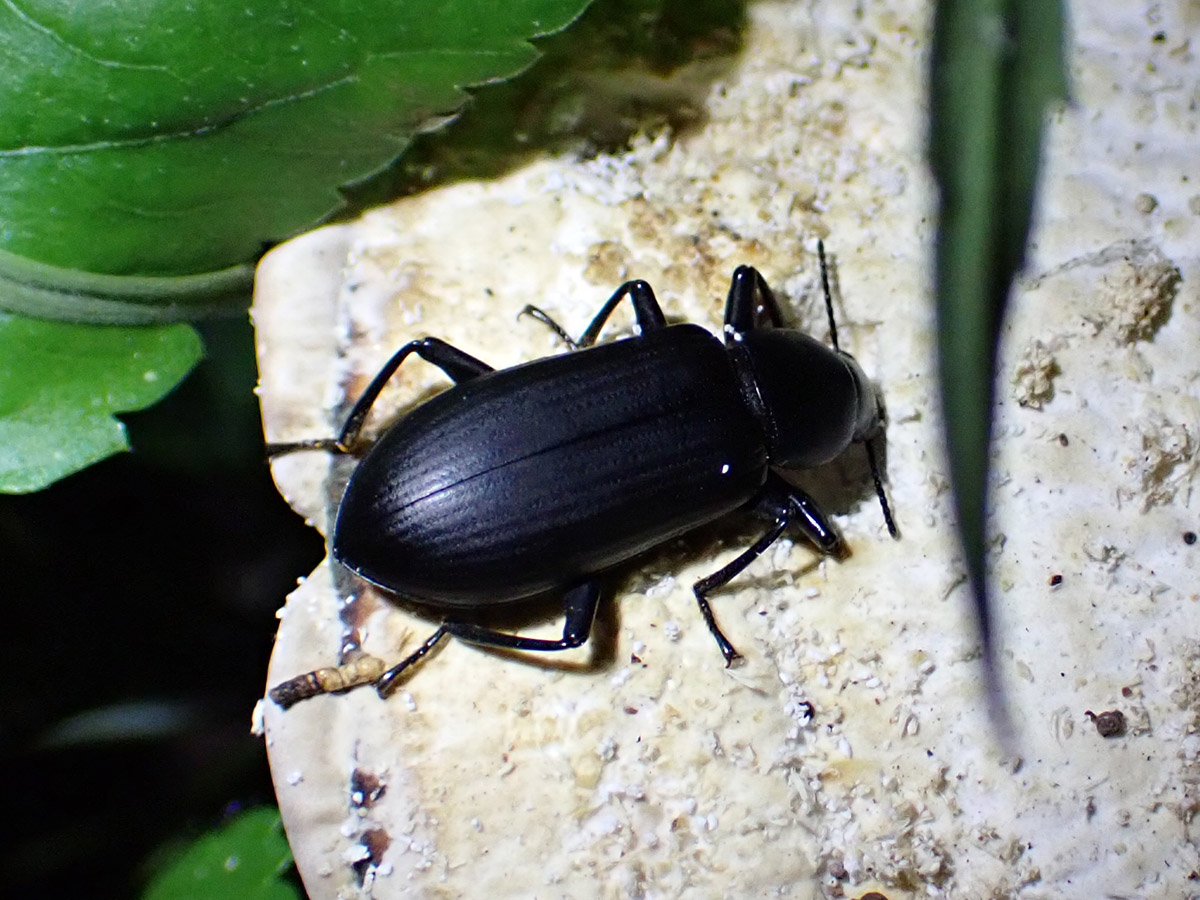
And finally— for the third night in a row, this beetle has come out to munch on this mushroom. Perhaps its rooting out insect larvae in the mushroom, after all, I had recently found a couple moths of a species that hosts on bracket fungi. This is the kind of diversity you have when you let stumps and other large pieces of wood decompose in your yard.
May 2, 2023
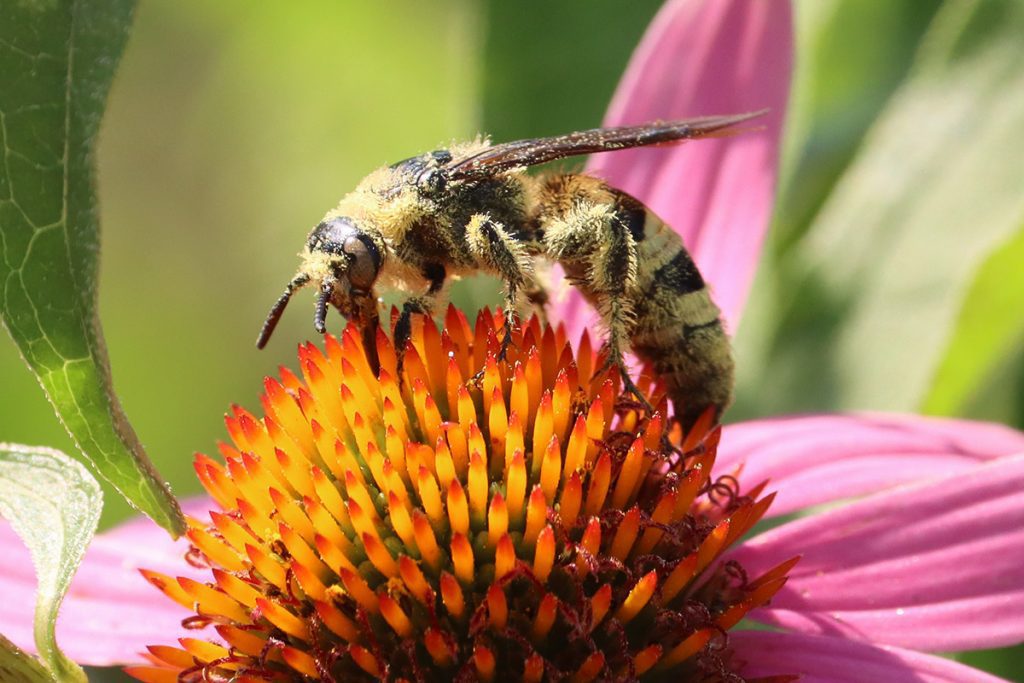
Now there’s a happy, pollen covered wasp. Feather-legged scoliids are hairy for wasps, and the way pollen sticks to it looks like they might be collecting it, as bees do. But no, wasps don’t bring pollen home for their larvae. Scoliids are parasitic breeders, digging into the soil to lay eggs in the larvae of scarab beetles, whom their larvae devour. They are well built to take pollen between different flowers, though.
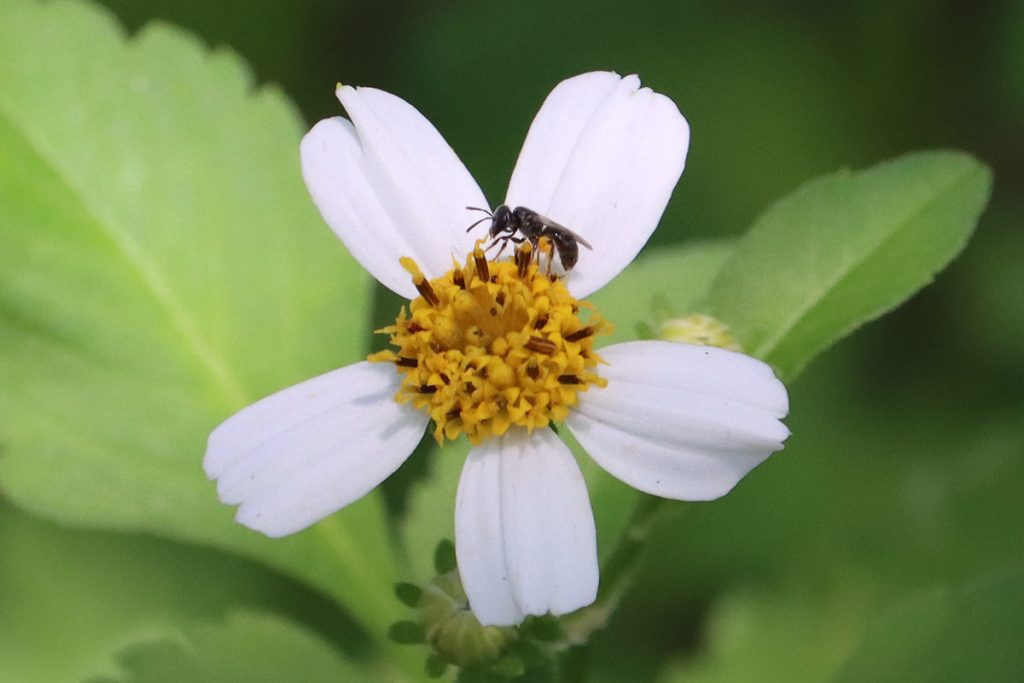
iNaturalist has been pushing these small, black bees as fairy bees. I did finally get confirmation from a good source; these are the same Lasioglossum, subgenus Dialictus bees we see every year.
May 3, 2023
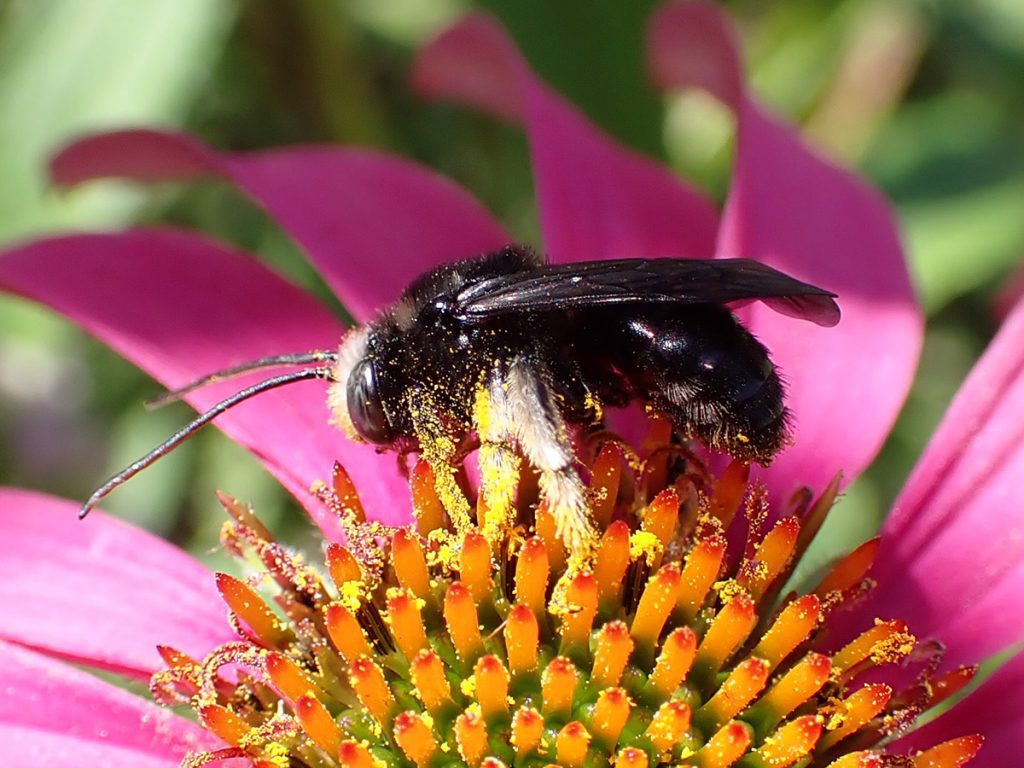
Here’s another look at a male two-spotted longhorn bee. When it comes to bees in the yard, I recognize a few milestones. One is the appearance of a new bee species to the yard. The next is when it becomes common, and more numerous. And finally, I see the males. We have enough bees that this is where males look for mates. It’s the place to be.
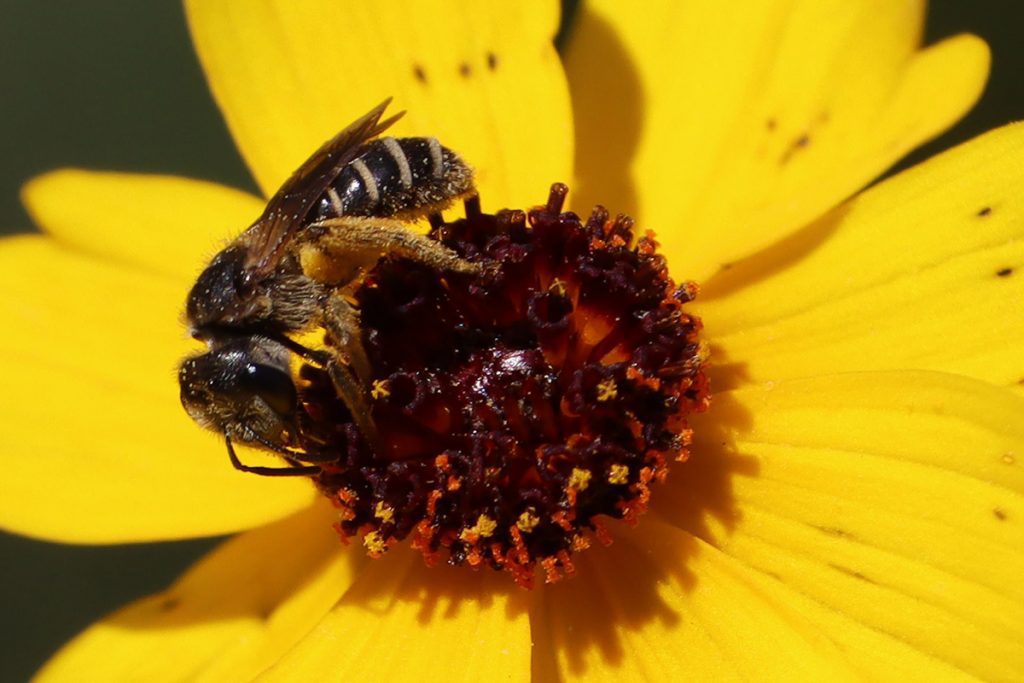
The Leavenworth’s coreopsis is coming in, but not in the high volume of last year. It shifts from year to year. This year, so far, purple coneflowers are much more present than they ever have been, thanks to my cultivating them and their own self-seeding. Tropical sage used to be the dominant wildflower, spreading itself throughout the yard, and now it’s all but gone.
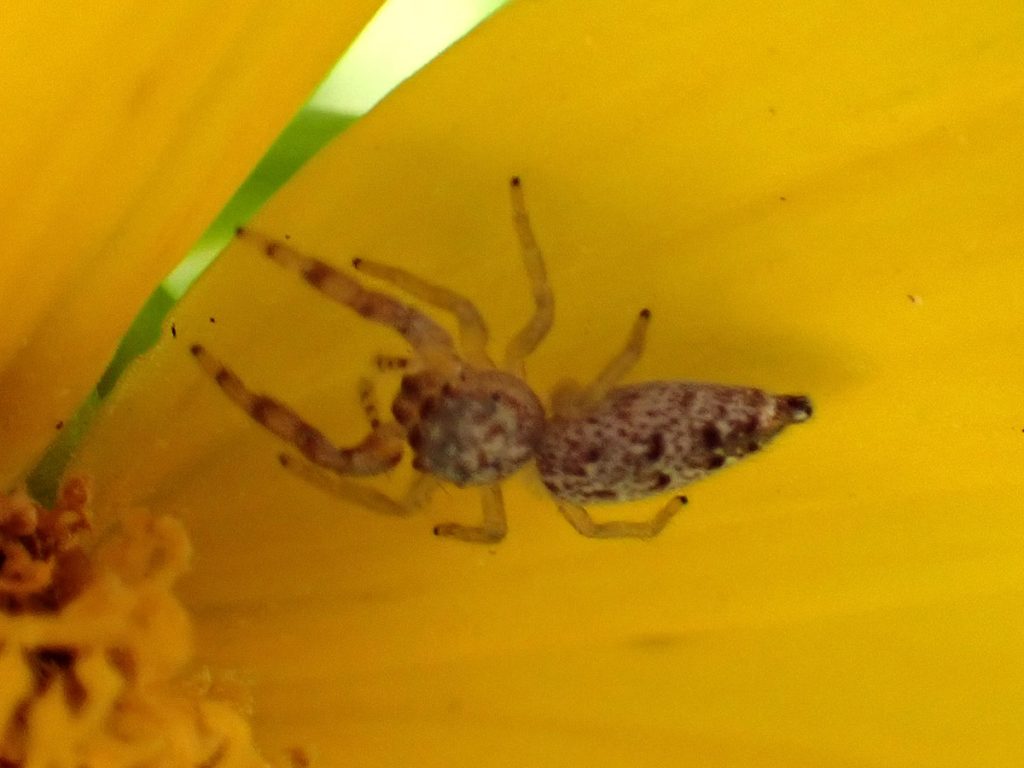
And where there are a lot of pollinators, there will be predators.
May 5, 2023
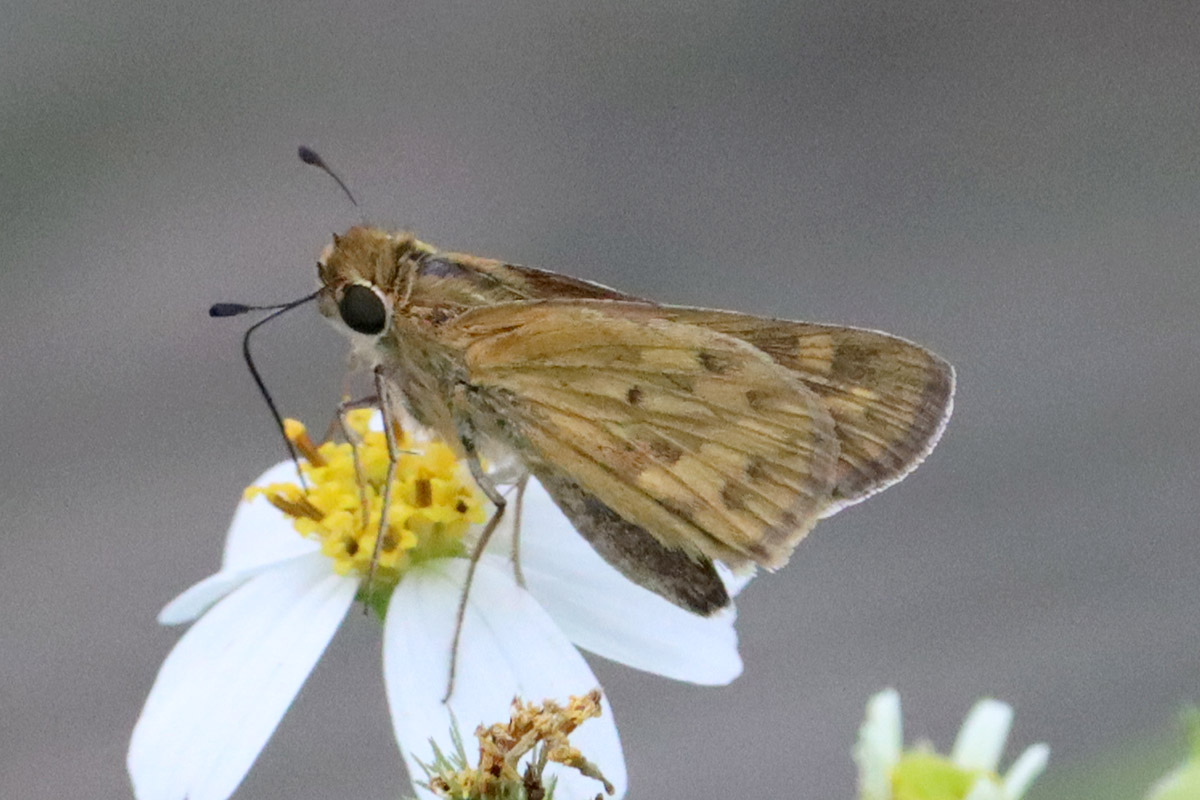
I’ve been seeing a lot of fiery skippers this year, and here is what I think is a closely related grass skipper. Another reason not to mow in the early spring months. When we think of attracting butterflies, we think monarchs and swallowtails and fritillaries – the large, colorful butterflies. Skippers look like moths to a lot of people, but we have quite a few species pollinating our flowers. And I’m not saying we don’t want moths as well.
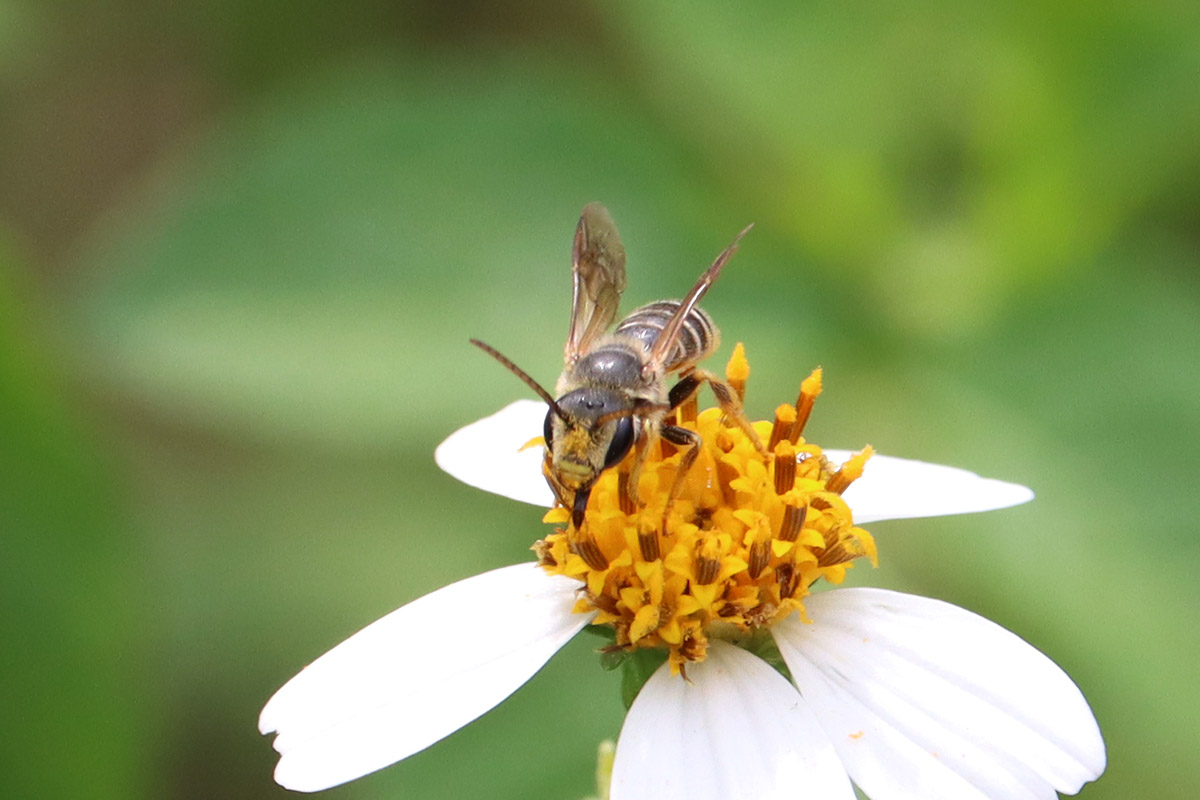
I don’t see pollen sacks, and it has the narrower head with that tuft of fur on it. I believe we have a male Poey’s furrow bee.

Another first butterfly sighting for the year. I don’t see them often in the yard despite the fact that we have their larval food growing in the yard.
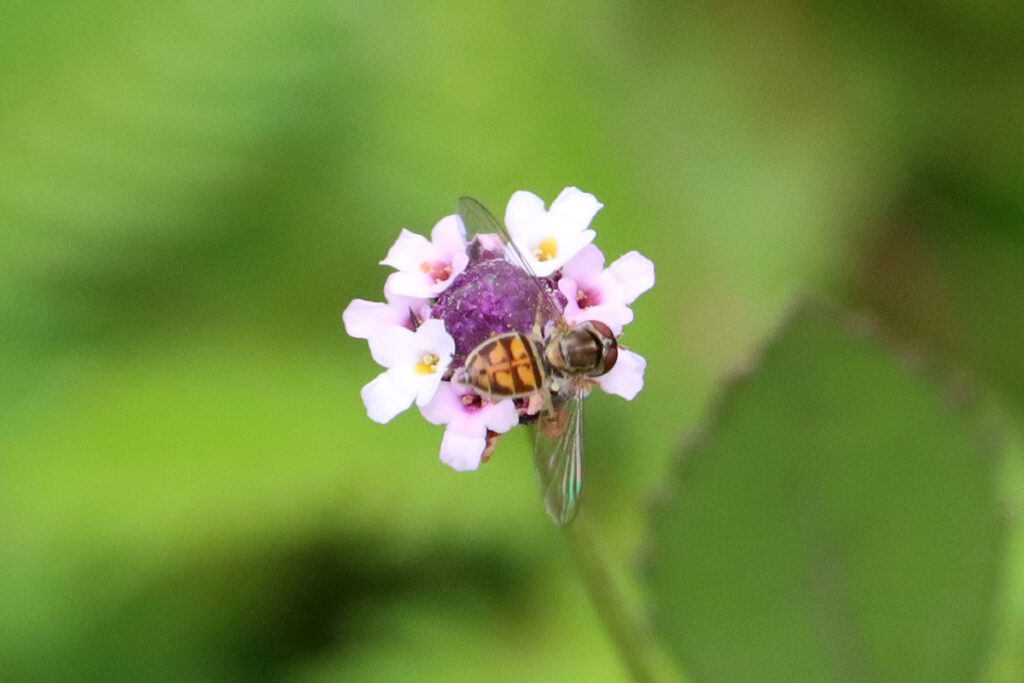
The fogfruit has spread throughout the yard along with the sunshine mimosa. I take a closer look at it today, in part hoping to see buckeye caterpillars, which I don’t. But I realize that with all of the other pollinator activity in the yard, I don’t always pay attention to these little flowers. I don’t always see hoverflies on the same flowers a bees and butterflies, but they face less competition for fogfruit flowers that seem made for an insect their size.
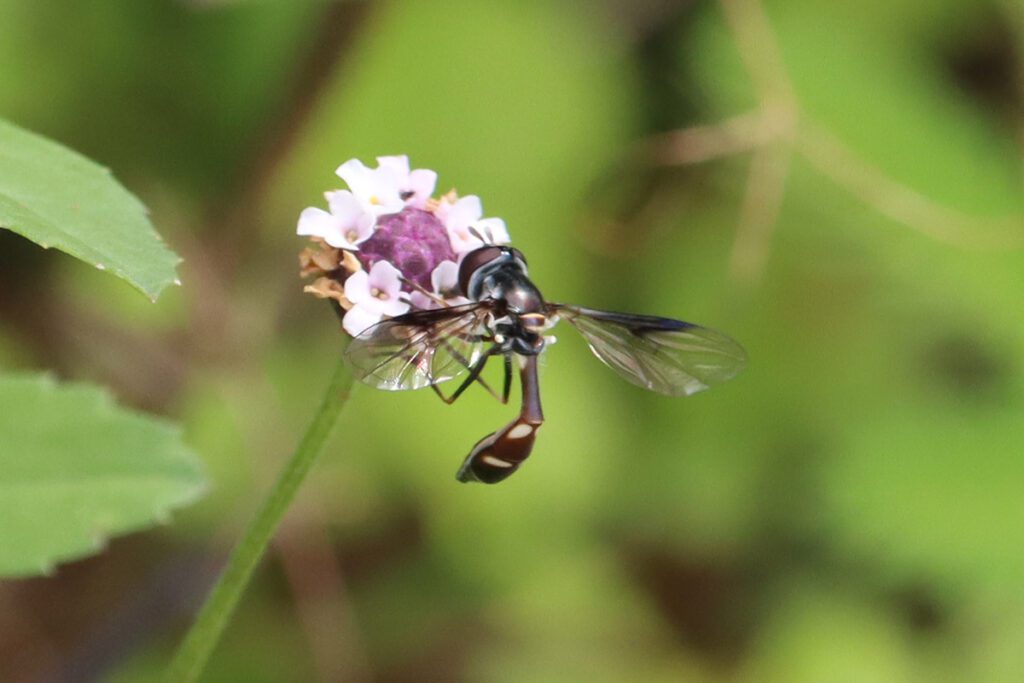
Here’s a first sighting of the year for this hoverfly species.

When the pollinators get going, it’s easy to miss the other insects not buzzing around from flower to flower, especially the small ones. Here’s a small leafhopper.
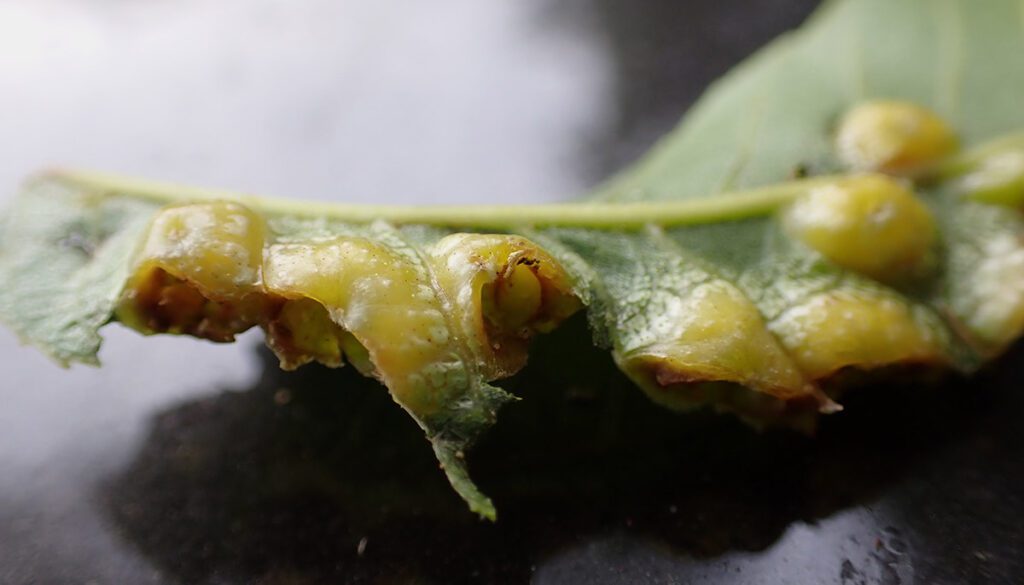
Lastly, a leaf I found on my car. The structures in the leaf were created by a gall wasp. A mother wasp injects her eggs into the leaf along with a chemical that restructures the plant cells to make a nursery for her offspring. It looks like something may have nibbled on the galls.
May 6, 2023
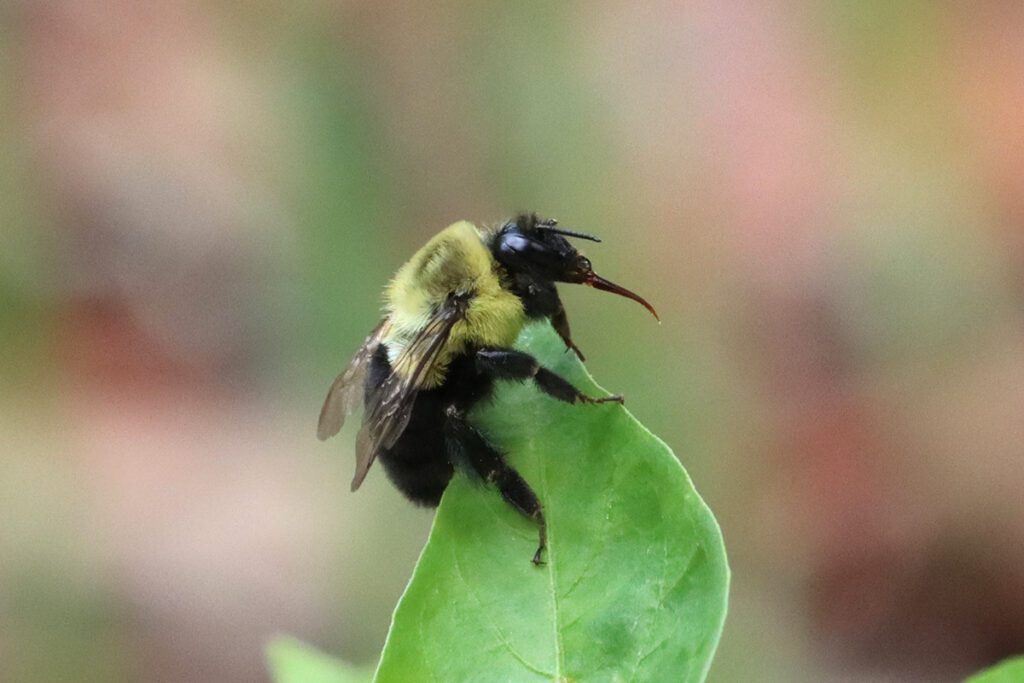
Every once in a while I go out into the yard and see a bumblebee sticking its tongue out at me. Apparently pollen builds up on their probosces, and so they clean them off periodically.

I watched this furrow bee wade through a single Stoke’s aster for a little while.
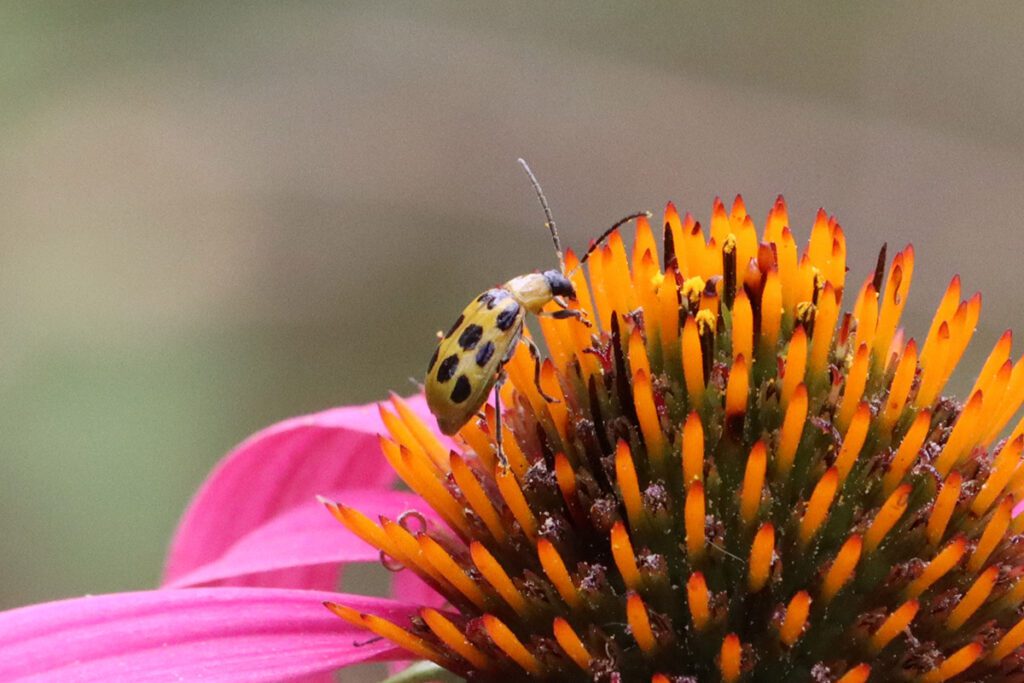
Here’s an insect that’s considered an agricultural pest. Their larvae eat plant roots, causing damage. It’s so much of a pest as a larva, that the literature focuses on that. Sweet nectar attracts many adult insects that we don’t classify as pollinators.
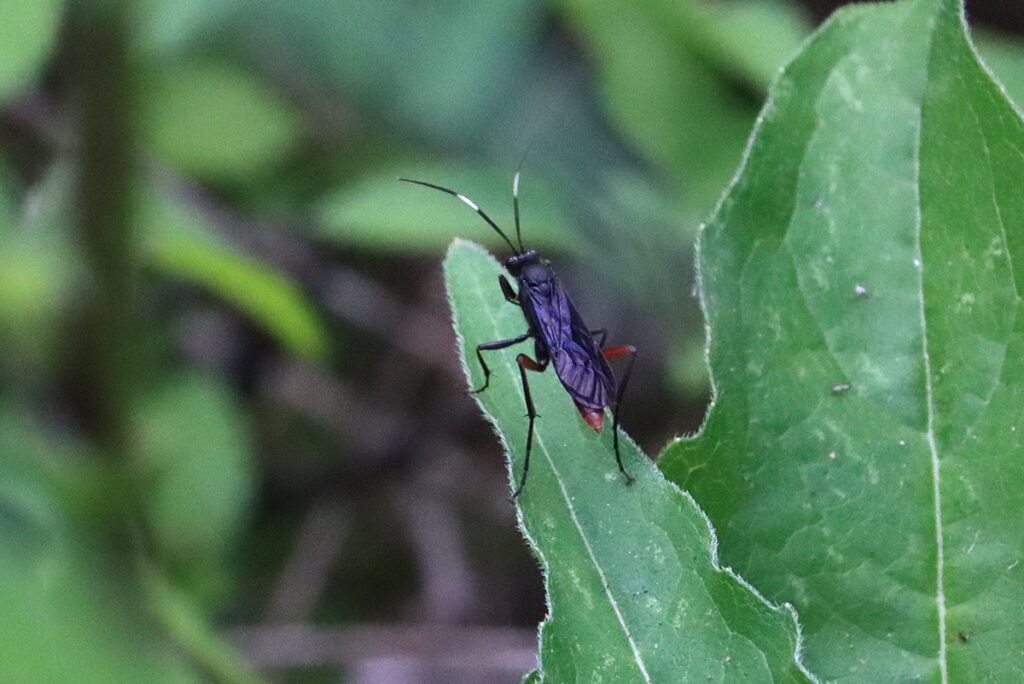
Here’s a wasp I see once or twice a year. No common name or much specific information about it as a species. Ichneumon wasps as parasitoid breeders, like many other wasp families. I wish I knew if it had a specific species of genus it used as a host.
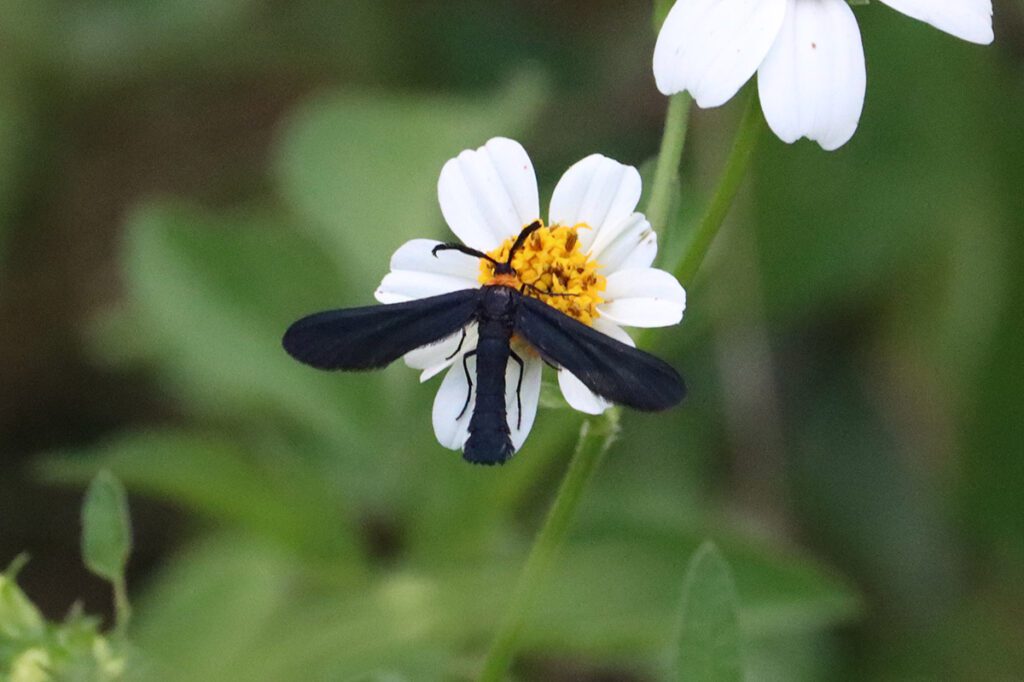
Not my favorite photo, but here’s a moth whose caterpillars host on grapevine leaves and Virginia creeper, which is related to grapes.
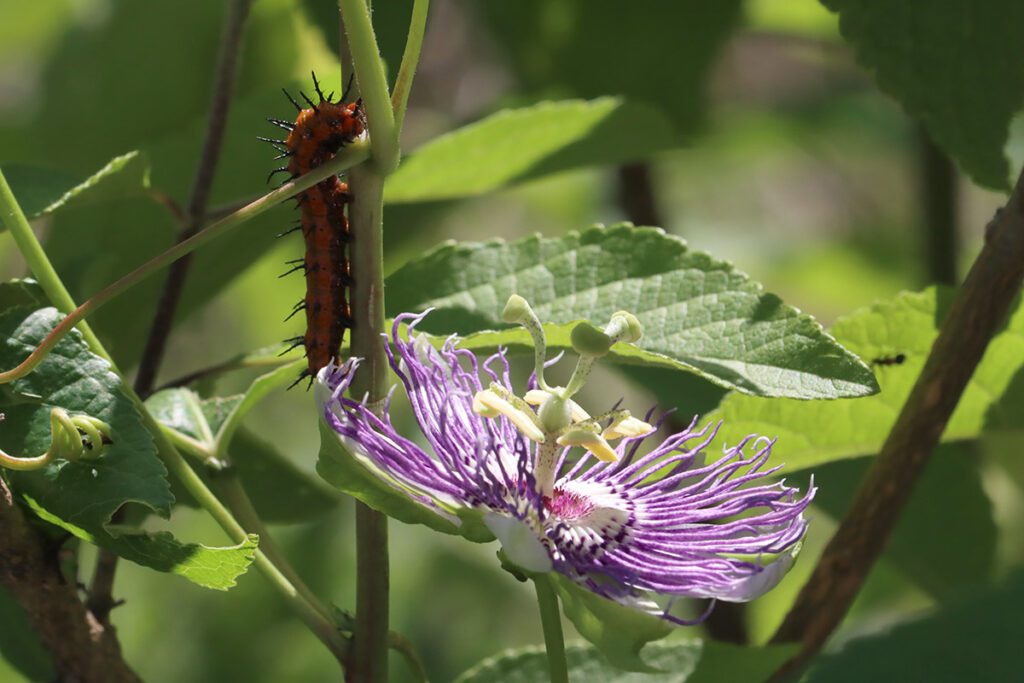
Here’s our first passionflower of the year, with a caterpillar nearby on the vine.
May 7, 2023
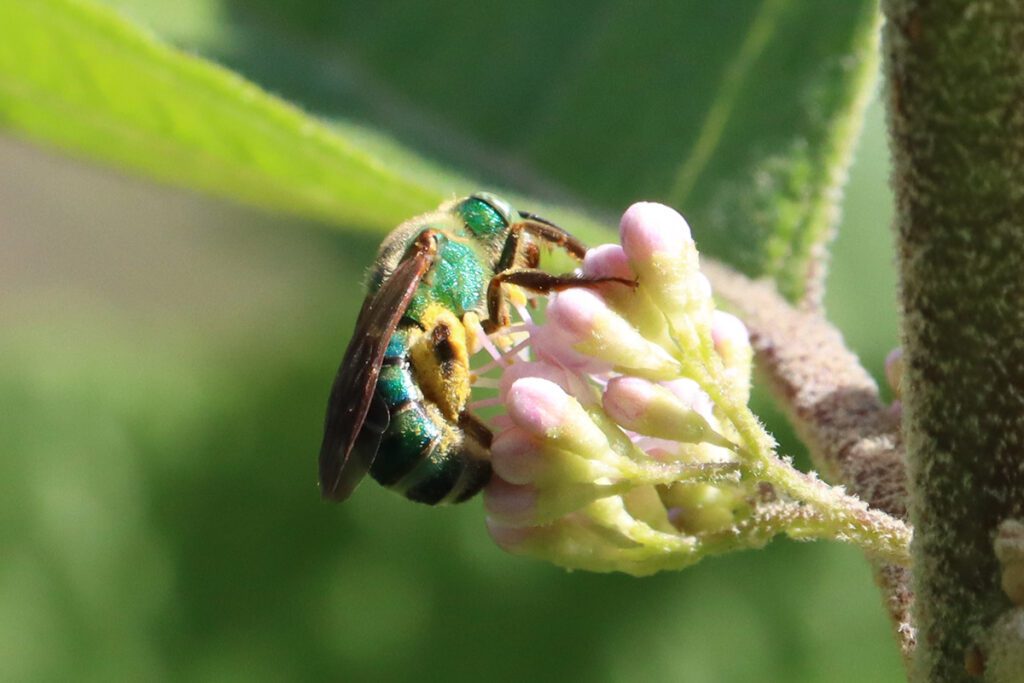
Here’s another one of my key seasonal markers throughout the year, the blooming of beautyberry bushes. I associate this with the two-spotted longhorn bees, which usually show up around the same time and which have a fondness for these flowers. Of course, those bees appeared a few weeks earlier this year.
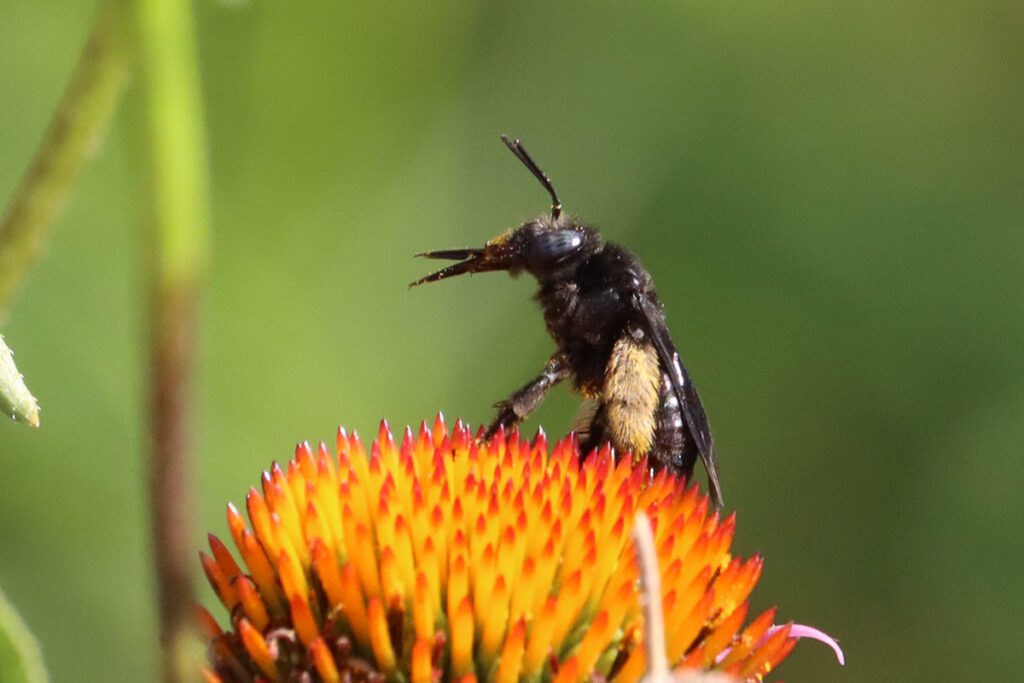
Just a day after I photograph a bumblebee doing it, a two-spotted longhorn bee stops its feeding to clean some pollen off of its proboscis. You can see the pollen grains on it.
May 8, 2023
As we start to see more bees and other ground nesting insects, it’s no surprise to see burrows open on the bare earth. This is why we keep bare earth in the garden, so that we might have insects to enjoy to populate it.
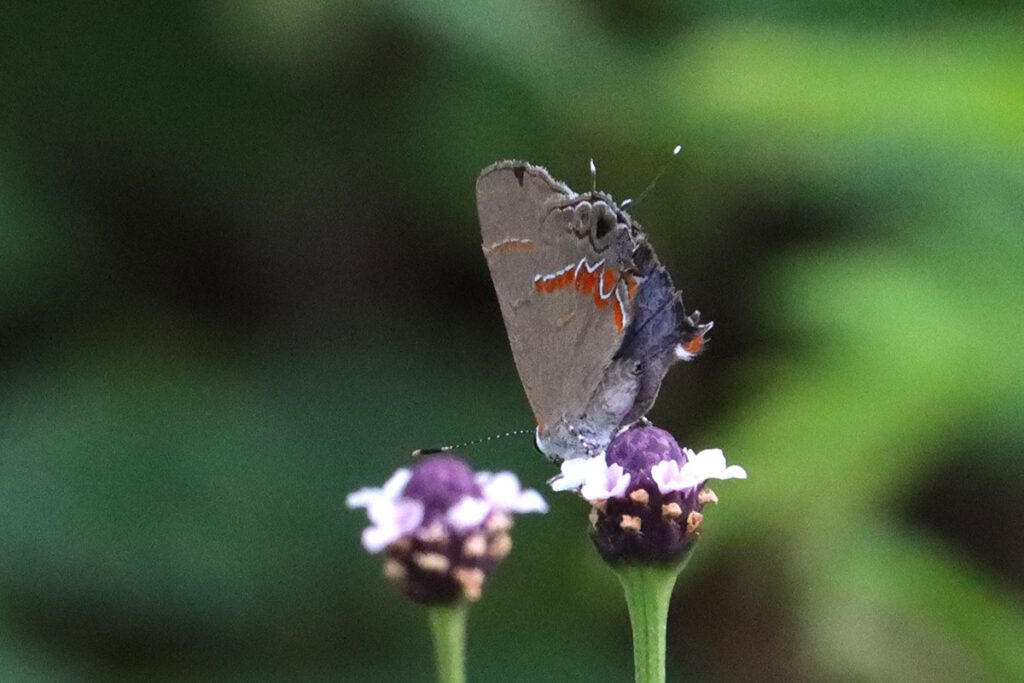
Another small pollinator on a small flower.

If I made a plush doll f tis animal, would you buy it? This is a parasitoid breeding pollinator, a tachinid fly.
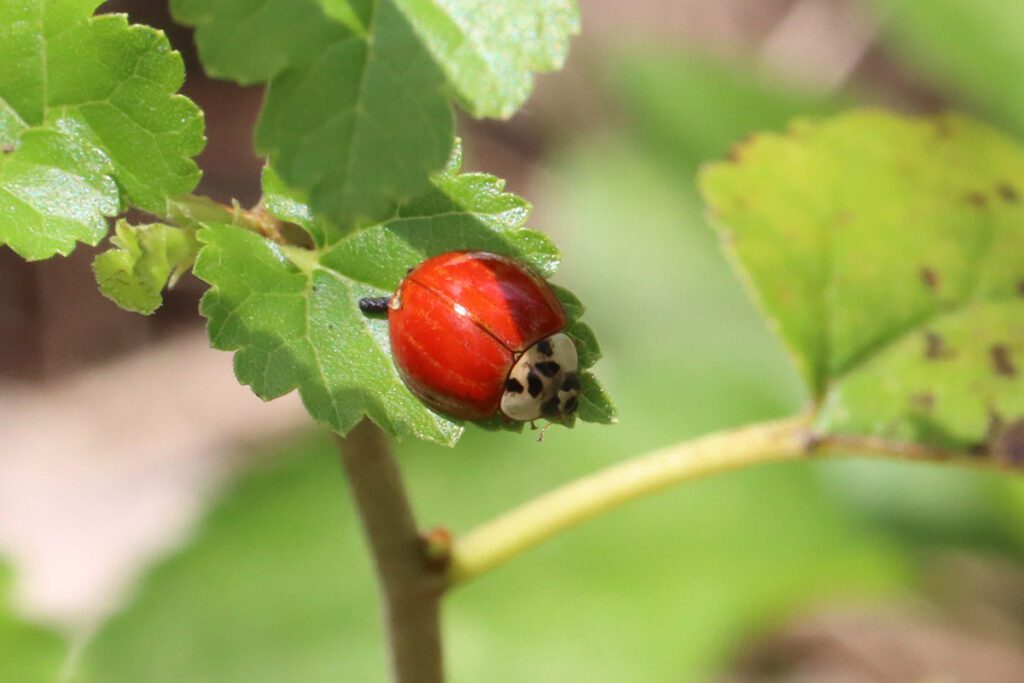
I saw a native spotless lady beetle a couple months back, but the head of this beetle gives it away. Asian lady beetles have varied spot patterns on their wings, and are sometimes spotless. The white M at the back of its head is a little fuzzy, but it is distinctly different than the head of the spotless lady beetle I saw earlier.
May 9, 2023
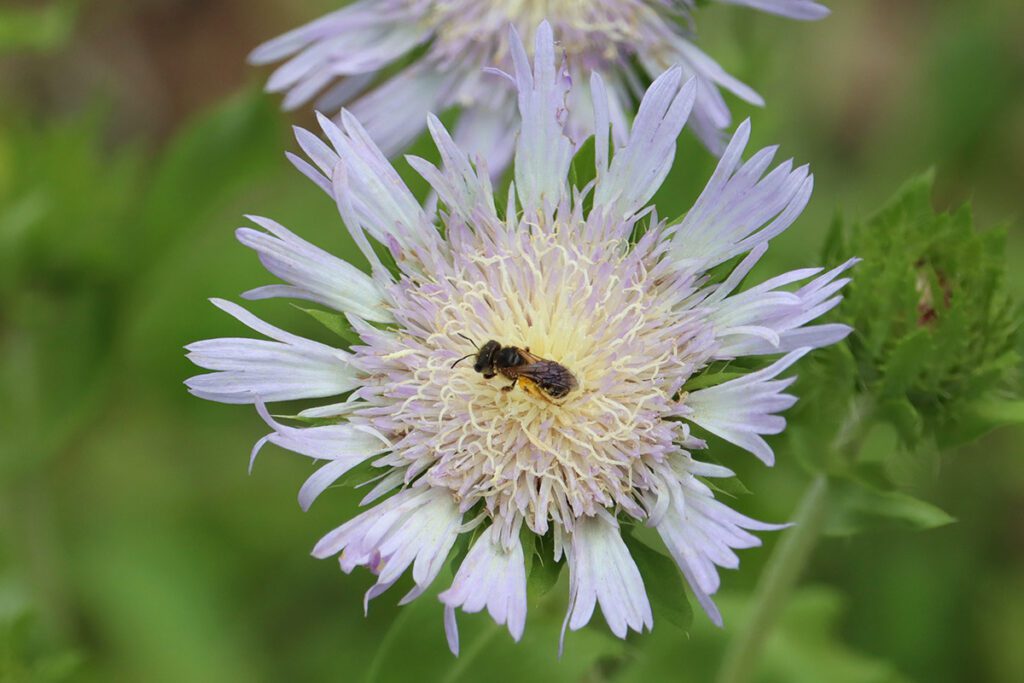
Here’s another photo of a Poey’s furrow bee on a Stoke’s aster flower, because I like small bees on large flowers.
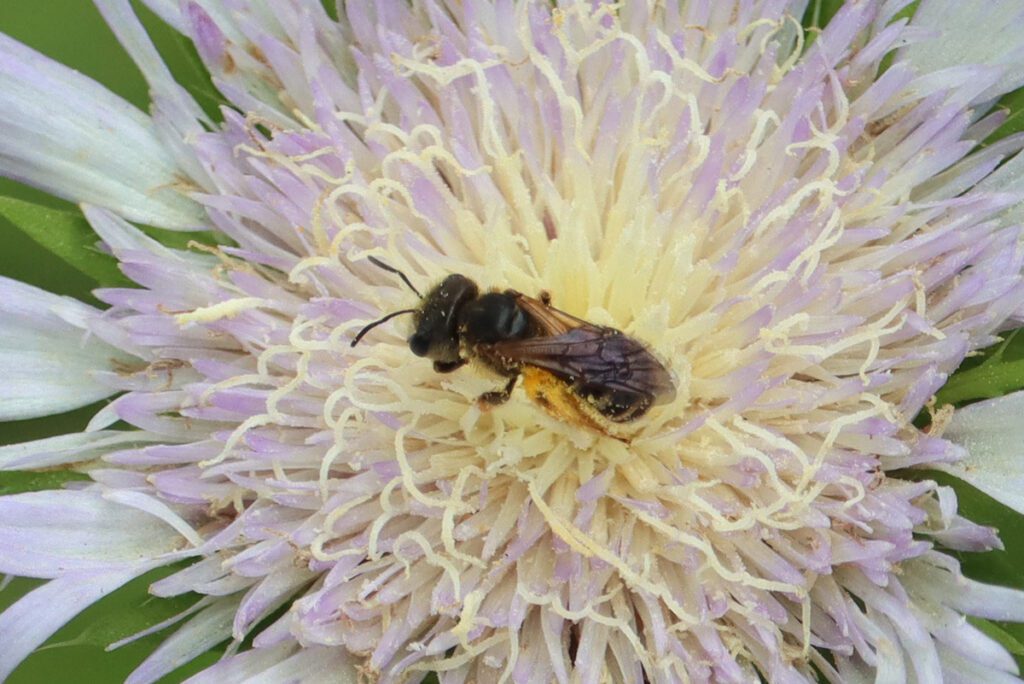
A flower like this saves a bee a lot of time. Rather than fly between several smaller flowers, it can walk back and forth and load up. This saves energy.
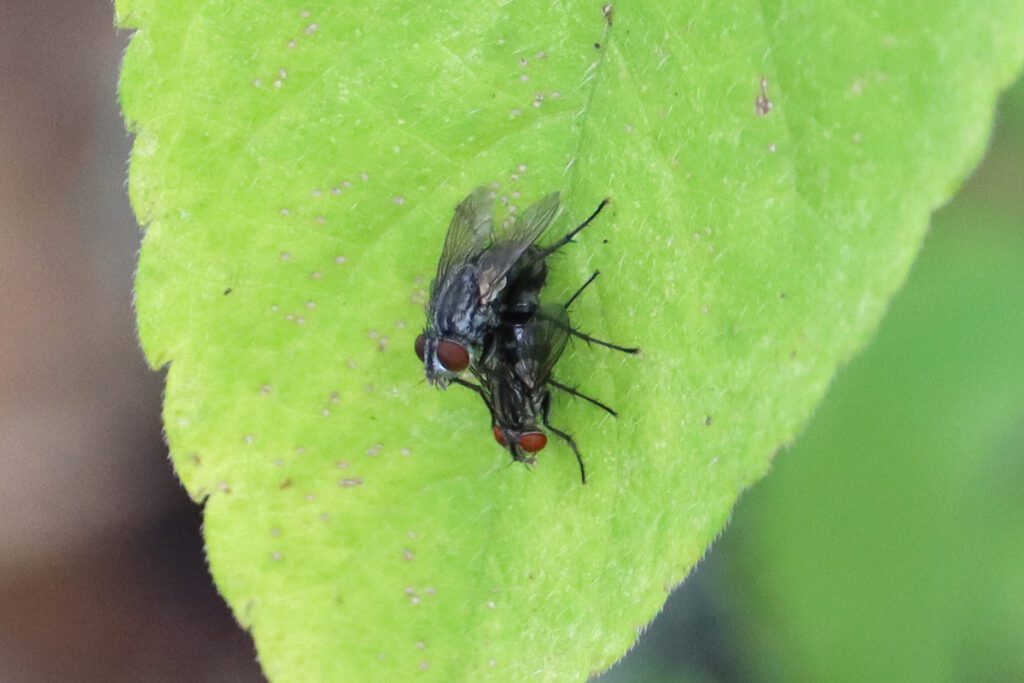
May 10, 2023
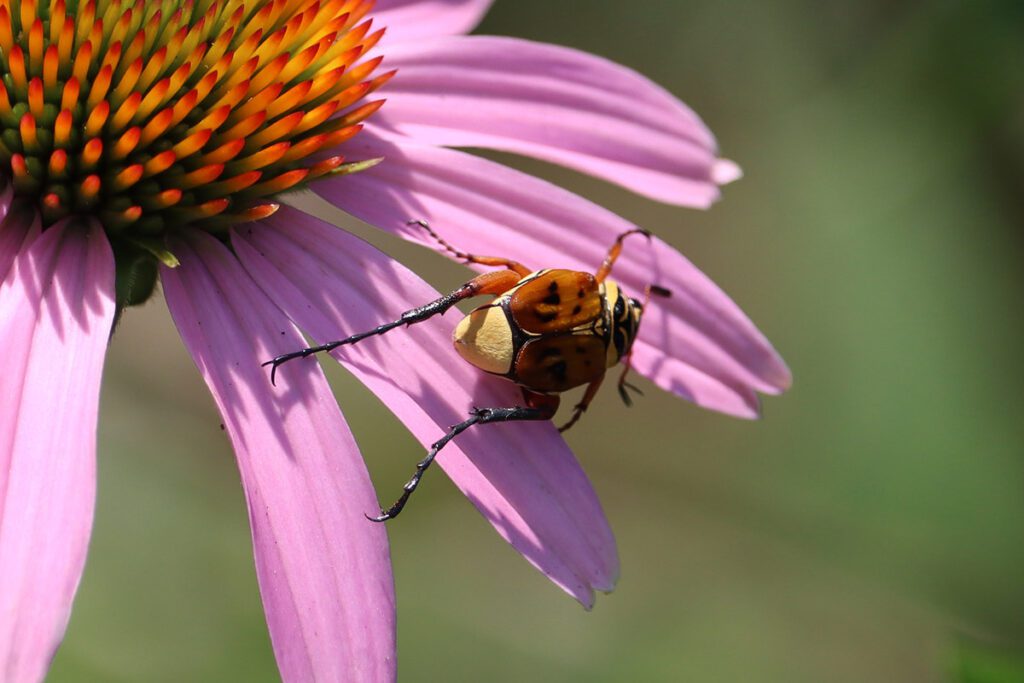
And yet another pollinating beetle on our coneflowers. Many of these nest in decaying wood, and so the diversity we’ve seen this year has to be due to some degree to the brush pile. This beetle nests in soil.
Its awkward pose is due to it starting to climb under the flower when I walked up.
May 11, 2023

A few weeks after halloween, our pumpkin began to rot and I crushed it into the compost. Vines soon issued forth from its seeds and covered a corner of the yard until they were killed by the December frosts. And yet, there were still very many seeds not breaking down in the compost as they’re supposed to. I’m not great at composting, but some amazing things result from that.
Squash vine borer claims every kind of squash we try to grow, but I decided last year that I would always let them grow because I like the way the vines cover our paved yard and because, of course, bees love their flowers. And this is a freebee anyhow. I check the flowers for bees in every morning. And now, finally, we have the bee that specializes in squash flowers.
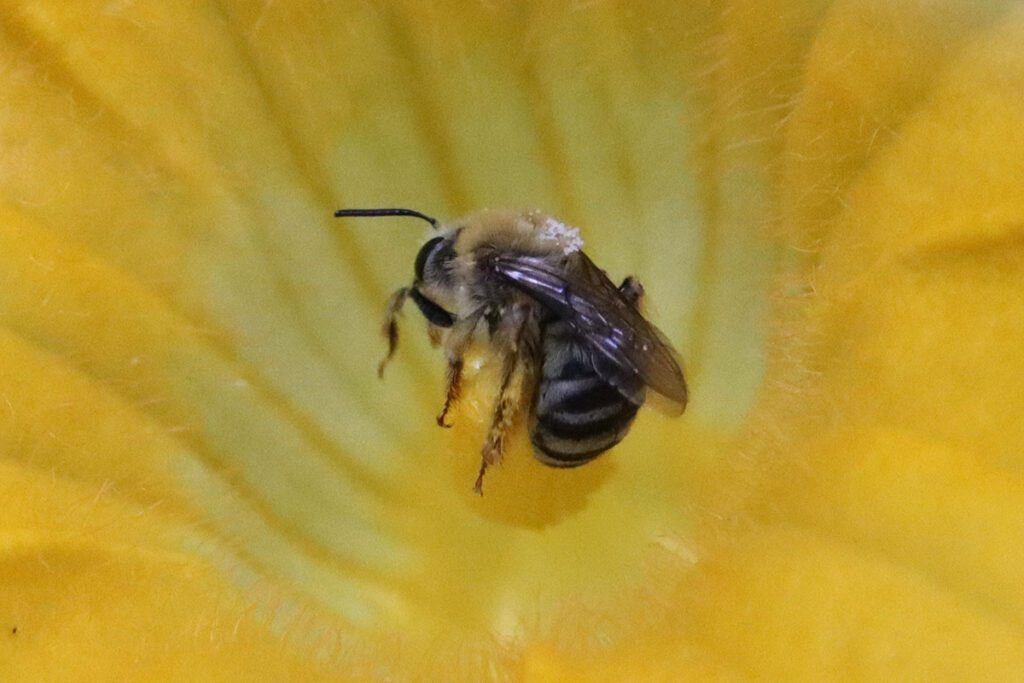
Like all bees we call specialists, we might se this bee on other flowers. However, the pruinose squash bee will only use pollen from squash flowers to stock their nests. This is the fifth new bee species identified in our yard this year.
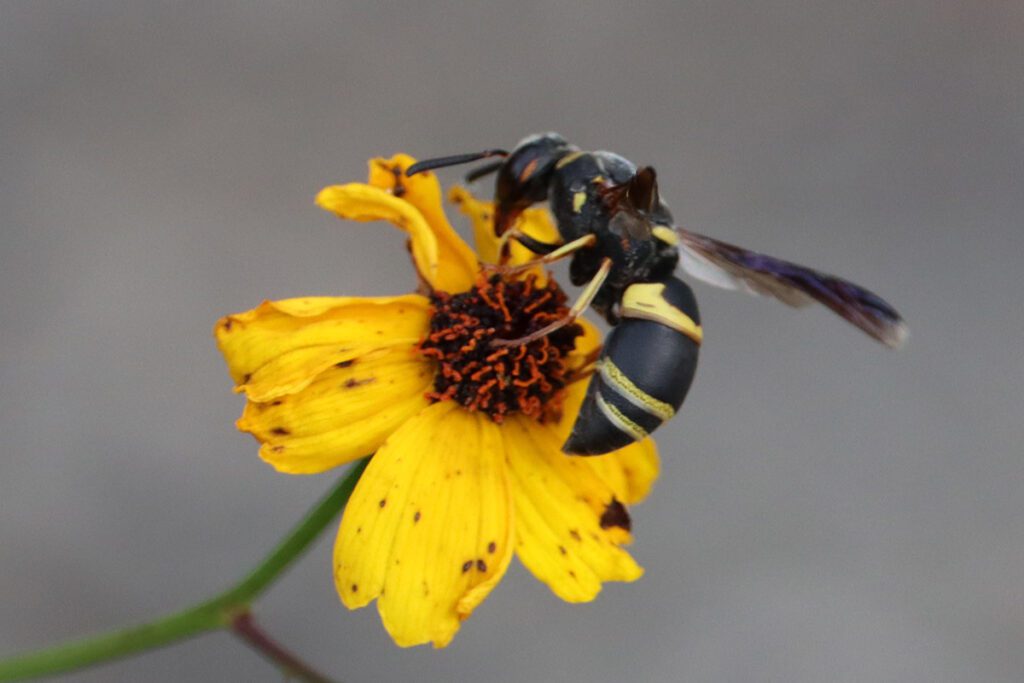
In order to present as full an account of the insects that visit our yard, I have include a few that for some reason or other I couldn’t get a decent photograph. This mason wasp was a brief visitor to our coreopsis flowers.
May 16, 2023
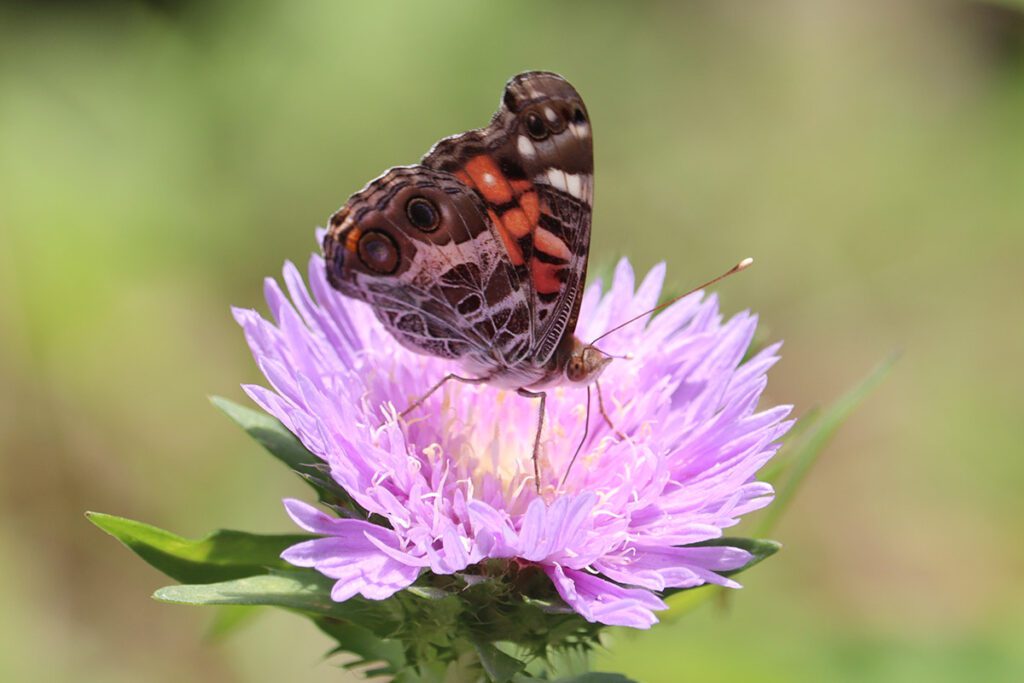
A showy butterfly on a showy flower. This is the kind of image we use to promote pollinator gardening.
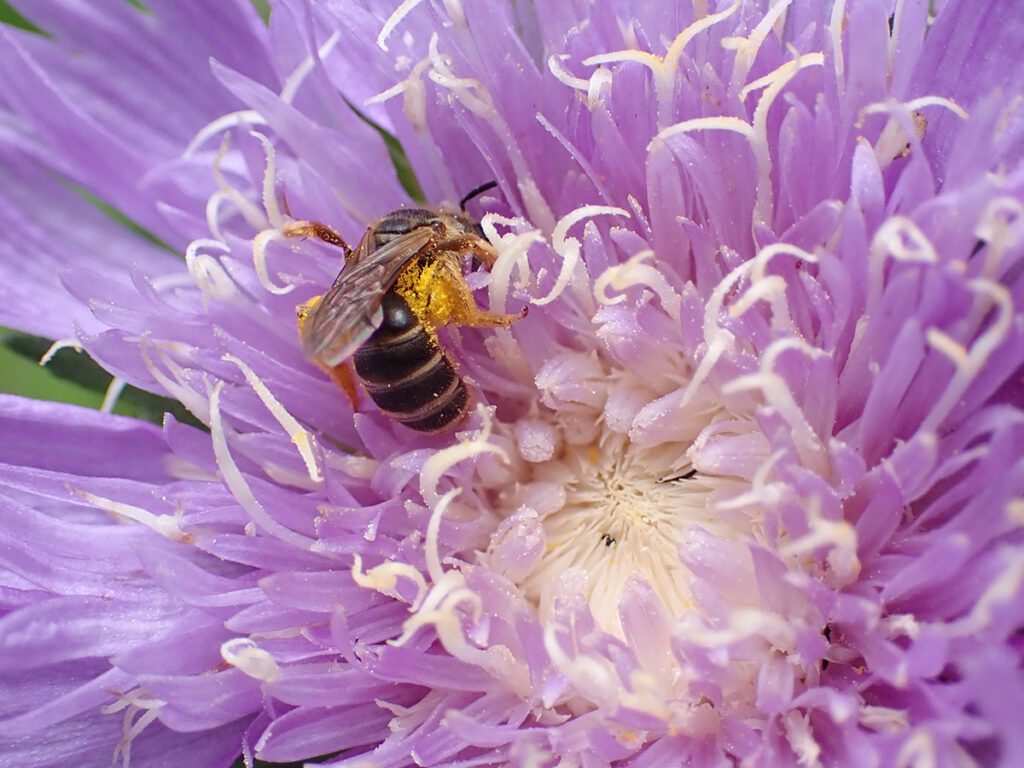
I can’t get enough of Poey’s furrow bees on these large, purple flowers.

Color isn’t everything when identifying a bee, and certain bees might reflect different colors in different light. These small sweat bees are in a genus with 500 bees across North America. Most of them can’t be distinguished from one another without a microscope. Earlier this year, I received a species-level identification for a Lasioglossum bee, one with some distinguishing characteristics such as red legs. I keep snapping away and sometimes uploading them to iNaturalist to see what IDs might pop up.
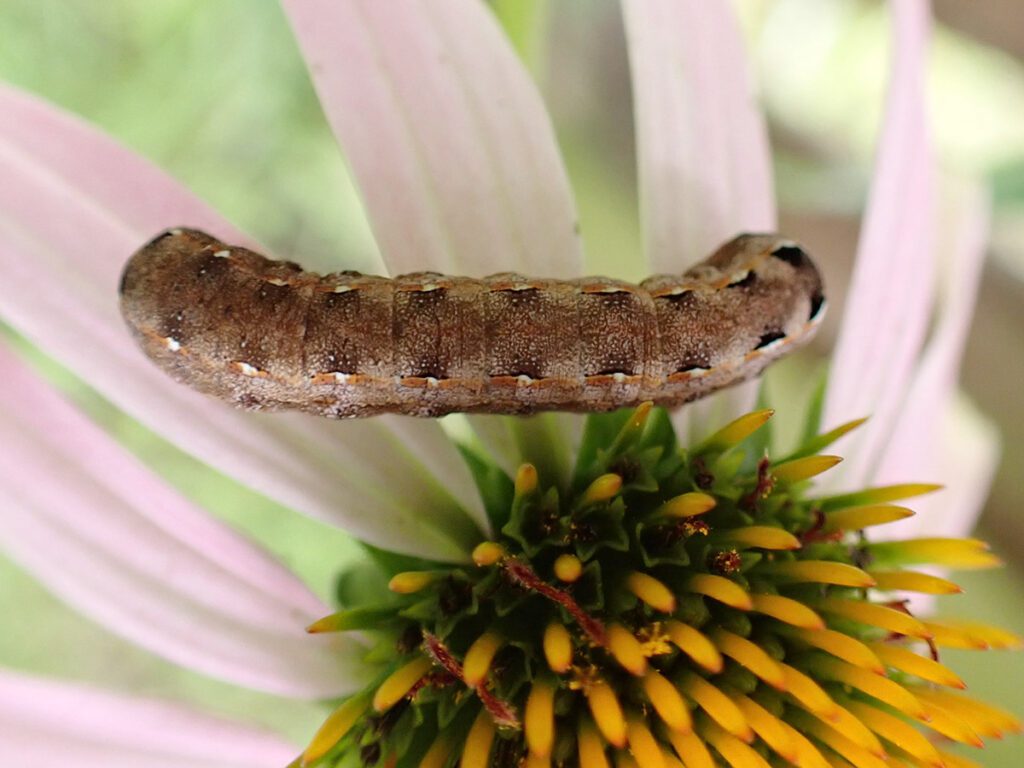
I don’t often see cutworms, so I don’t freak out at seeing them in the garden. We seem to have a good balance of predators and plant consumers, so these guys aren’t eviscerating our plants. I let this one be.
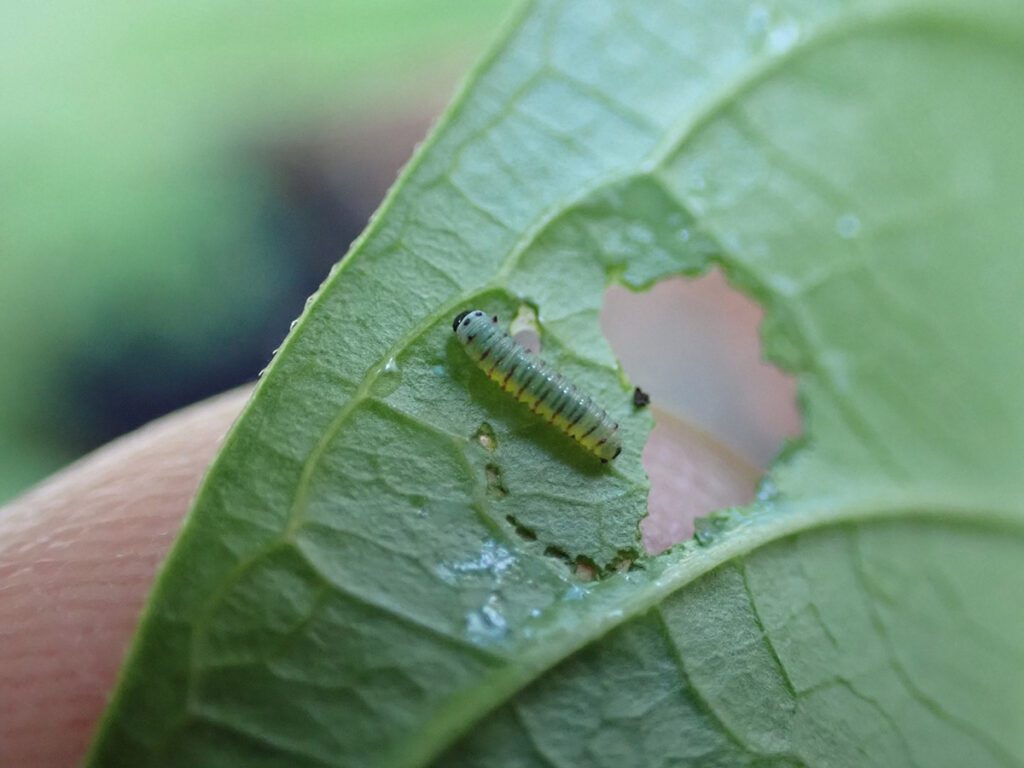
Speaking of plant consumers in the garden, here’s another caterpillar. The first monarch of the year. As usual, I first spotted the hole in the leaf, and found the caterpillar by turning the leaf over.
May 17, 2023

Something caught my eye as I passed under the Pecan tree: insect eggs on a strand of Spanish moss. These look like lady beetle eggs, and I wonder whether they are native or nonnative.
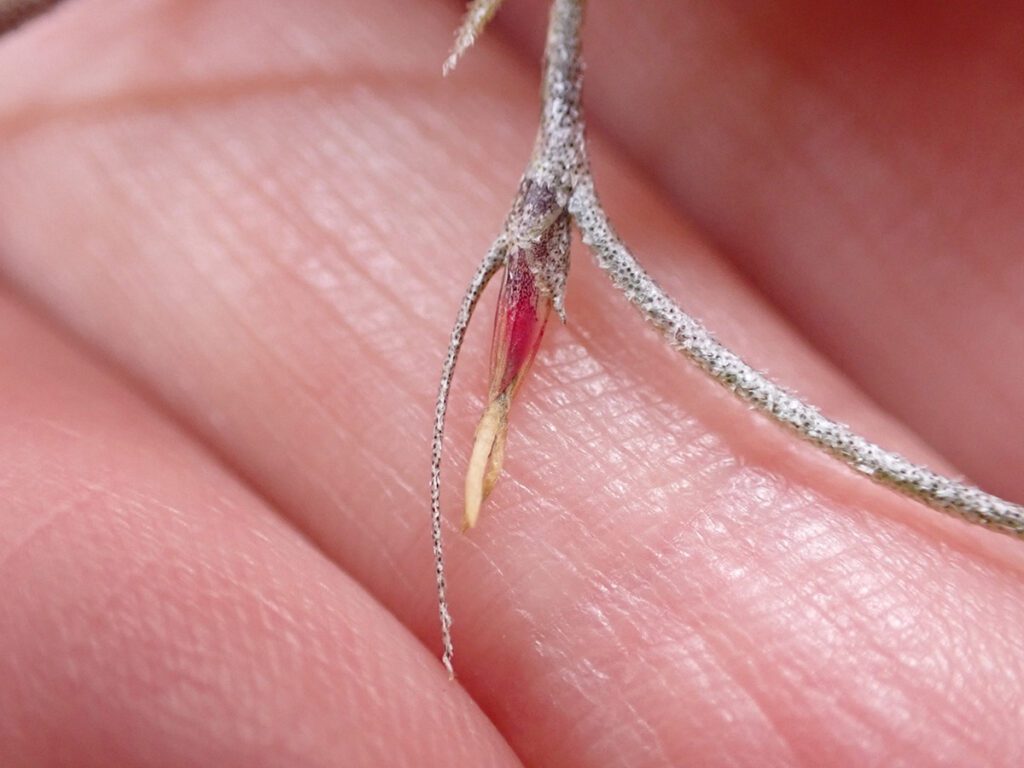
Once my attention was in the overhanging moss, I noticed something else. The Spanish moss was in bloom.
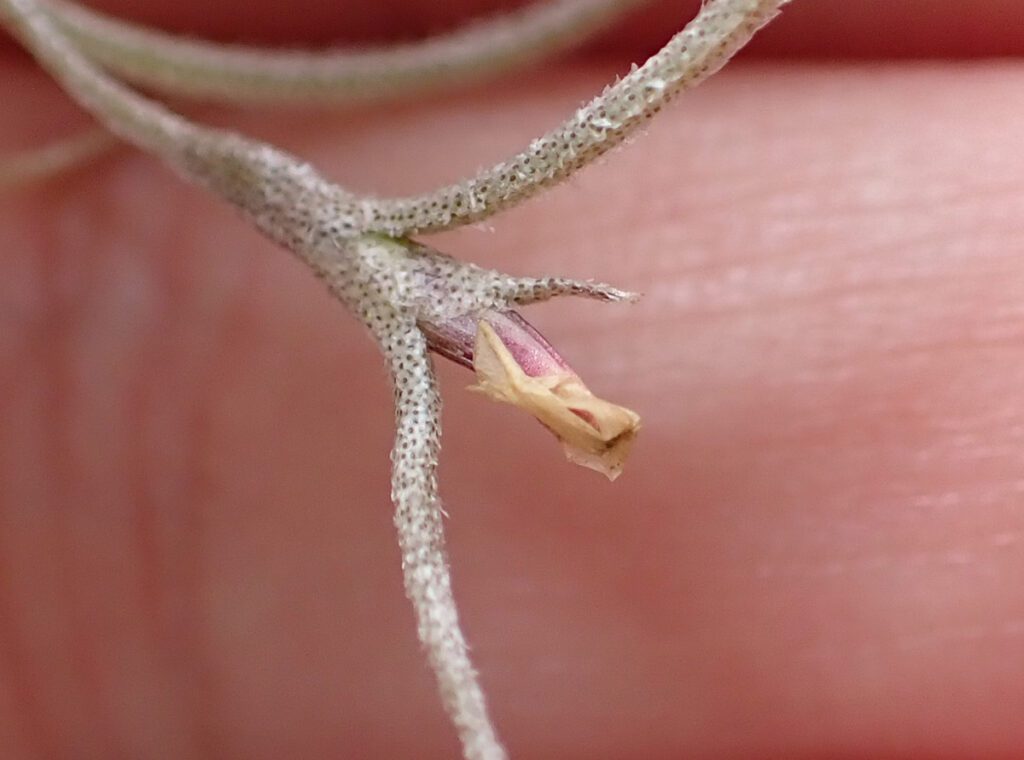
Don’t discount any plant in your backyard ecosystem. Even Spanish moss hanging in a tree provides nectar and a place to lay eggs.
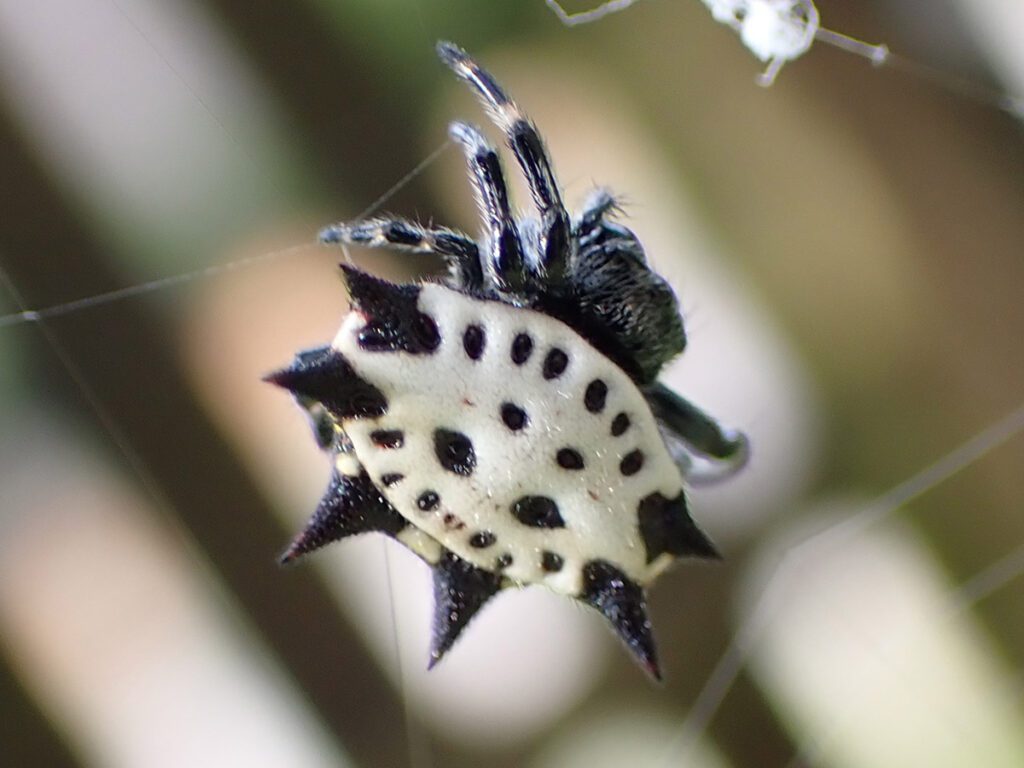
Here’s a spider we see just about everywhere, but have you ever looked up close? Looks kind of like a hockey mask.
May 19, 2023
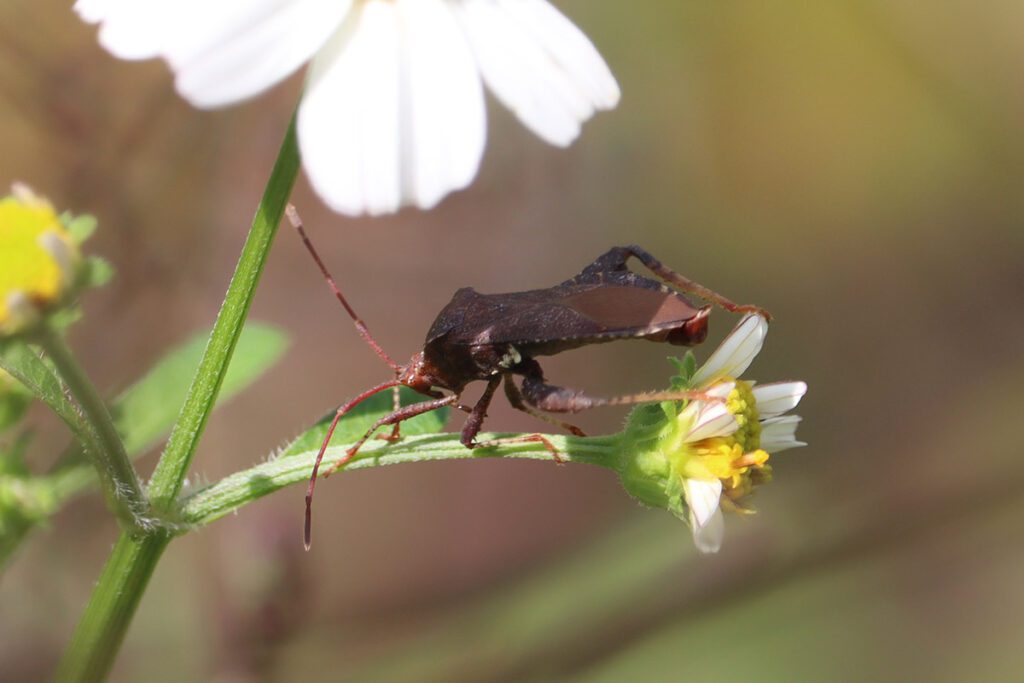
I didn’t get many photos of it before it got away, so I’m not confident of the ID.
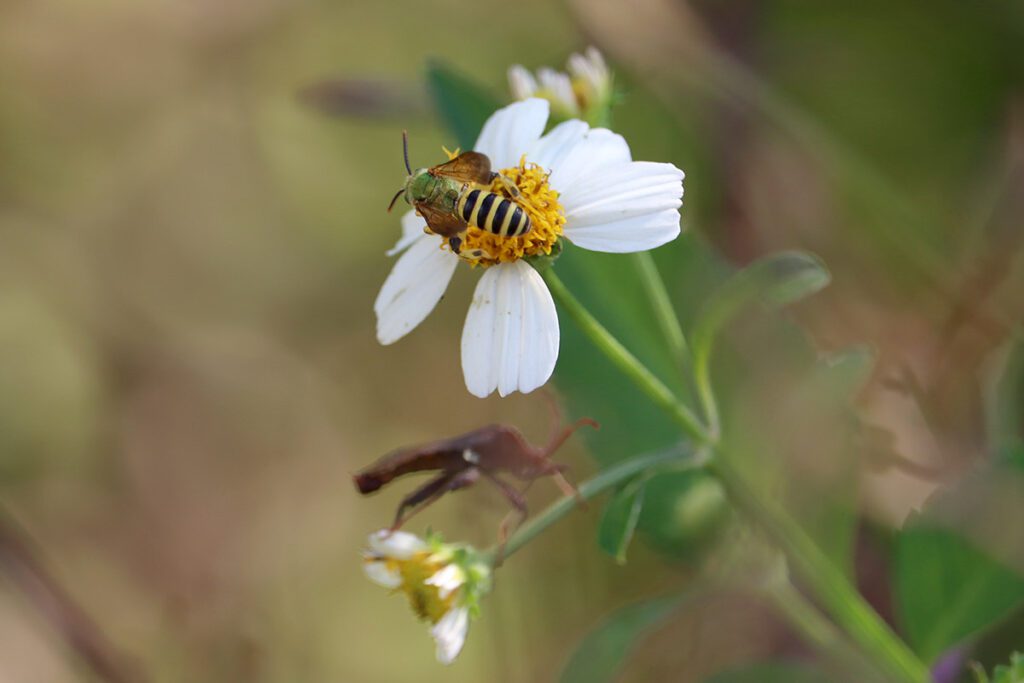
Here’s something I don’t see before August – a male brown-winged striped sweat bee. I see females almost all year round, but at the end of summer, a giant brood erupts in the yard of both males and females. But many bee species have two broods, and the first is typically smaller. Maybe this is part of a smaller first brood.

Here’s a plant-eating beetle on a beautyberry bush.
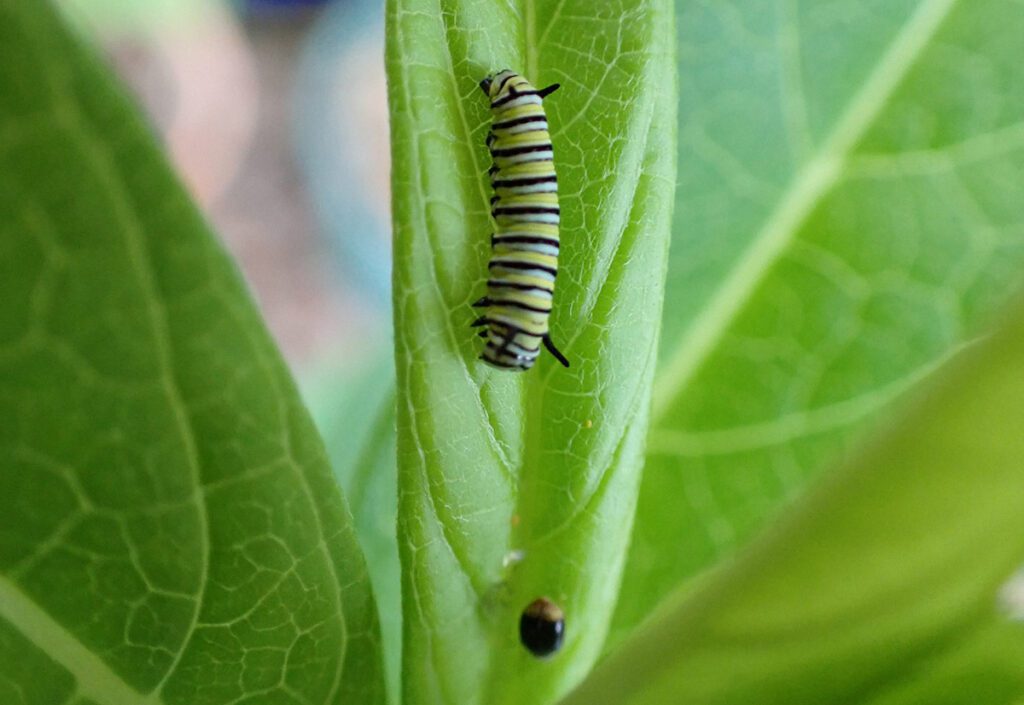
Our monarch babies are growing. But what is that dark spot on the leaf? I didn’t notice that when I took the photo.
May 20, 2023
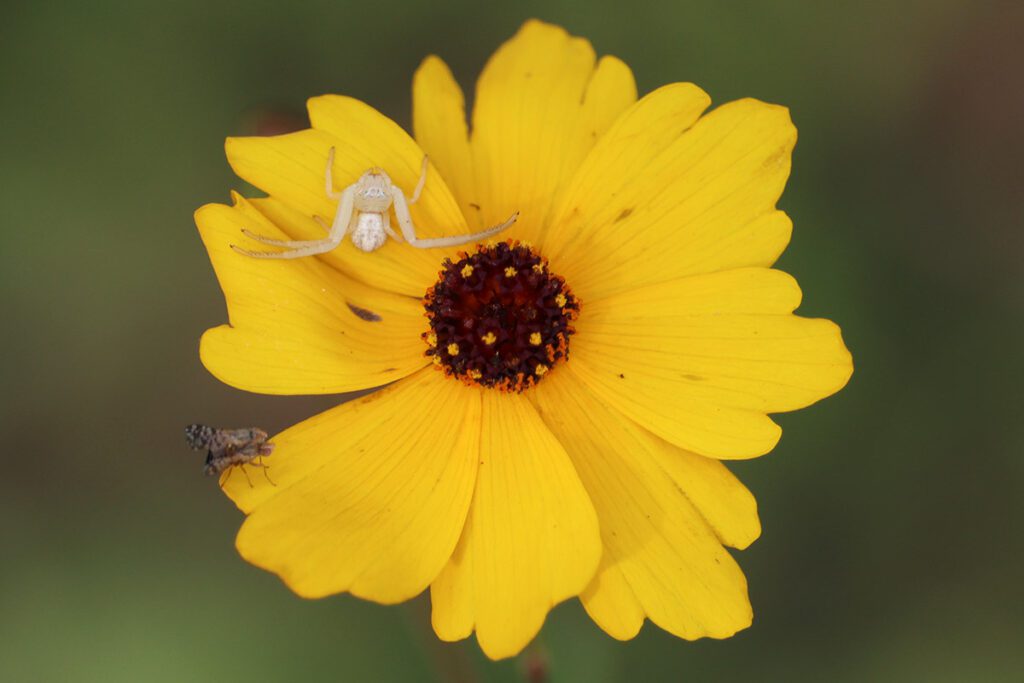
This pale crab spider is barely noticeable on a small flower. It’s just the right size to grab a Poey’s furrow bee or small sweat bee.
Meanwhile, the beautyberry flowers are tarting to ope and more bees are visiting them.

Another of our diverse mason wasps rests on a beautyberry leaf. This was a common sight in our yard but was scarce last year. I’m happy that I’m seeing them more this year.
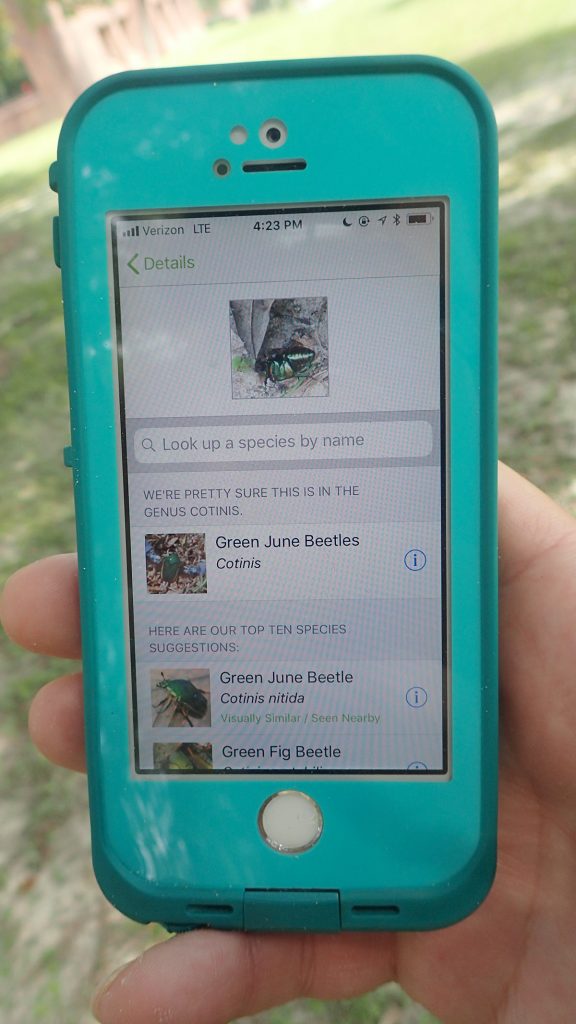
Apps and Citizen Science mentioned in the Backyard Blog
iNaturalist
Identify plants, animals, lichens, and fungi in your yard. Other users correct your identifications if you’re wrong, and even if they don’t, it can be a good springboard to further research.
Seek by iNaturalist
Instant identification, and it doesn’t record your location. This is a good option for kids with phones.
Monarch Larva Monitoring Project
Enter information about monarch caterpillars in your yard, and help researchers get a sense of the health of the monarch population that year, and how and when they’re migrating.
Great Sunflower Project
Record the number of pollinators visiting your flowers, and help researchers map pollinator activity across the country.
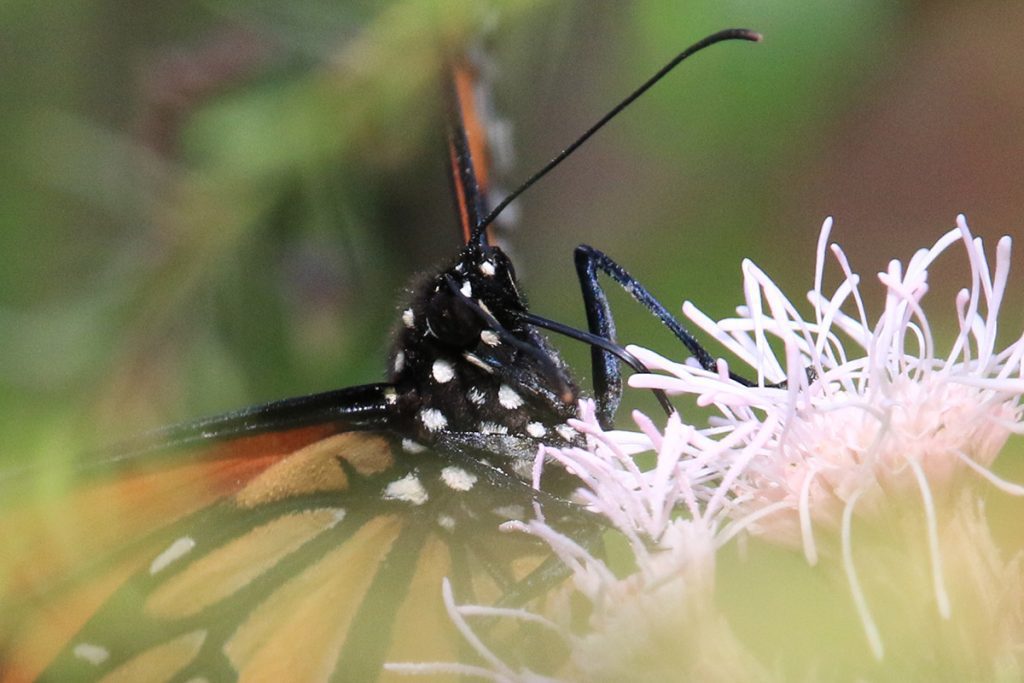
Dig Deeper into Backyard Ecology
What can we do to invite butterflies, birds, and other wildlife into our yards? And what about the flora and fauna that makes its way into our yards; the weeds, insects, and other critters that create the home ecosystem? WFSU Ecology Blog takes a closer look.


